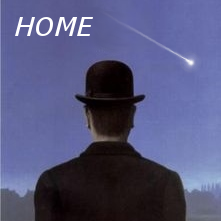All Arps so far
In this topic I am leaving the traditional “eyepiece view” and provide a crop of the original Arp sketches. Therefore, more attention to detail can be achieved. Additionally, there is an inverted and enhanced inset with remarks about the Arp details seen (or missed). Next to each “Challenge” there’s a “Y” if all features could be seen or a “N” if none of them were observed. “P” indicates that the mentioned features were only partially visible. In the text you will often find the abbreviations AV (averted vision) and DV (direct vision).
All sketches have been corrected to show North ↑ up and West → right.
I will try to sketch every Arp peculiar galaxy with my 16″ scopes from the darkest location possible, preferably from a site with a minimum SQM reading of 21.3. But on occasion I’ll settle for as low as 21.1 (near my home) or go as high as 21.8 (La Palma).
A 16 inch telescope may seem quite large for general amateur astronomy. However, for observing the peculiar features of the Arp galaxies it is rather small and it is for that reason that many of the features will not be seen. But that’s OK… with this portfolio of sketches I will still try to provide a guide of what can be achieved with a “mere” 16 inch mirror.
More info about Halton Arp can be found on Wikipedia. Additionally, more info about observing the Arp galaxies can be found on Astroleague and Steve Gottlieb’s website. The complete Arp catalog can be reviewed and downloaded to Excel or Skysafari from Deepskylog, the tool that I use to prepare and log my observations.
Last but not least I have to mention one book that I used extensively in my research and analysis of all the Arps; it’s “The Arp Atlas Of Peculiar Galaxies” by Jeff Knipe and Dennis Webb, which contains a wealth of information and which I used as the main data source for my sketches below. It’s a great read and I can recommend it to anyone who is planning to observe the full catalog of 338 objects.
Good luck and above all: Have Fun!
Spiral Galaxies
Low surface brightness (Arps 1-6)
Arp 1 – NGC 2857
mag 12.2, size 2.2′ x 2.2′
Challenge: Locate and trace both arms and disturbance in arm to SW of nucleus (N)
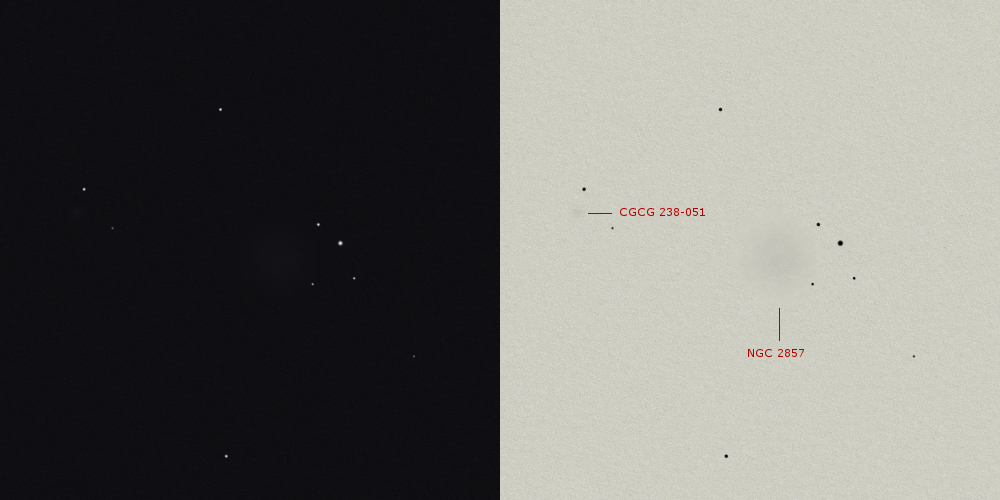
With AV a perfectly round stain is seen with no central brightening and very evenly illumination. No core or spiral structure is visible. A trapezoid of stars is nearby and in the same field a tiny galaxy (CGCG 238-051) is picked up.
Arp 2 – UGC 10310
mag 13.2, size 2.8′ x 2.2′
Challenge: Faint knotty arms starting about 1′ from core (N)
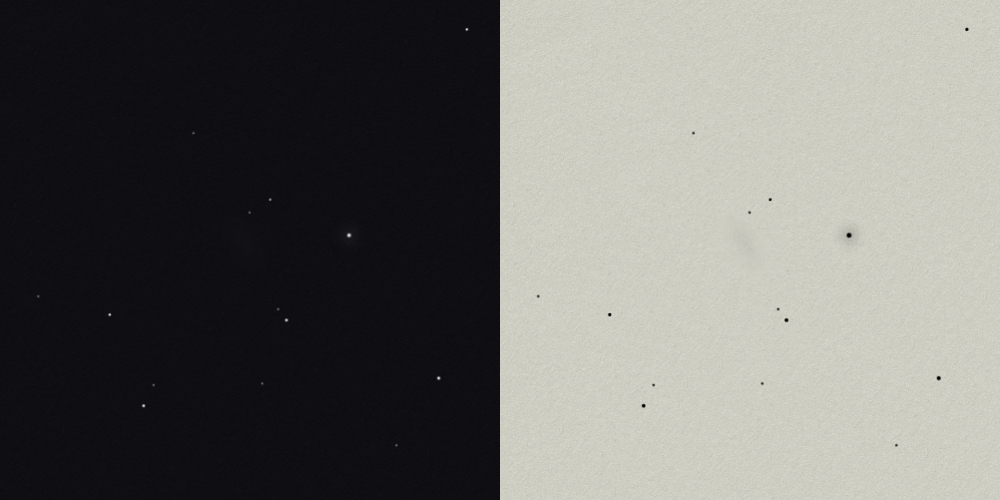
I did not succeed seeing this galaxy in my home country at SQM 21.6, but fortunately here on La Palma (with much better transparancy) I do see a very dim smear of light and I can see the elongated shape. No central brightening was observed and there are quite many very dim stars floating around.
Arp 3 – MCG-1-57-16
mag 13.4, size 2.5′ x 2.1′
Challenge: Full extent of the faint galaxy (P)
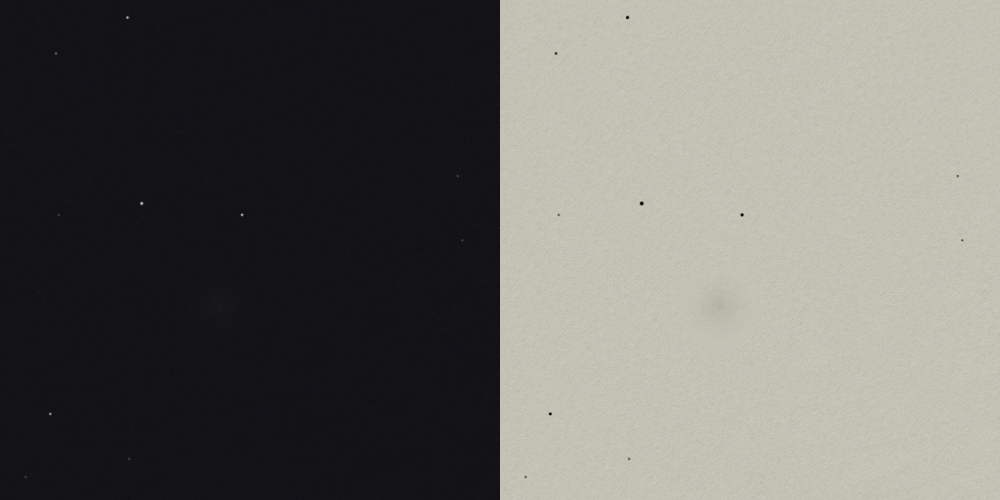
This is a large galaxy, round and very dim. The 10mm provides the best view; with a higher magnification the view deteriorates fast. This galaxy can only be seen with AV and without any detail. Only slightly brighter towards the core.
Arp 4 – MCG-2-5-50 and companion
MCG-2-5-50: mag 13.7, size 2.8′ x 2.4′
MCG-2-5-50A: mag 14.9, size 0.6′ x 0.4′
Challenge: Ring of knots surrounding MCG-2-5-50 (N)
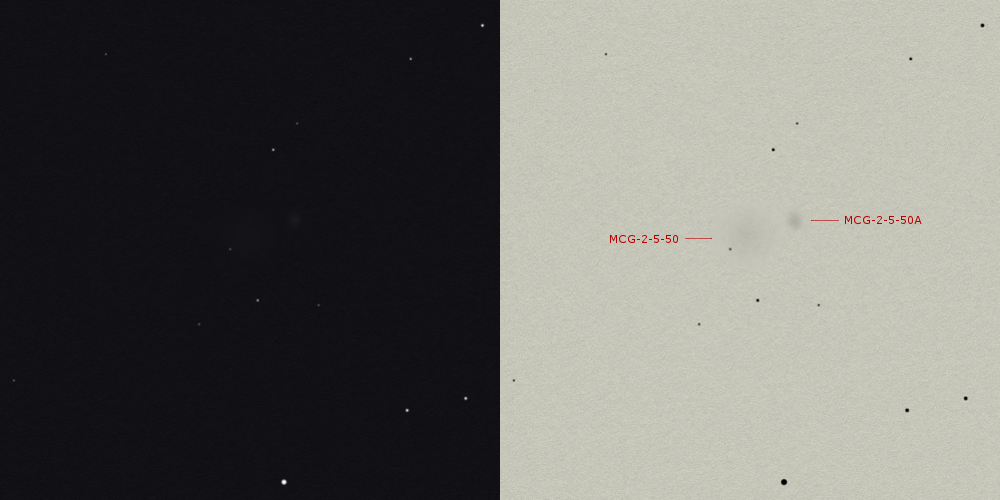
MCG-2-5-50A is seen immediately with AV, but MCG-2-5-50 could only just be suspected closely against its neighbour. MCG-2-5-50A is small and round, while MCG-2-5-50 is larger, also round and much softer, without a core.
Arp 5 – NGC 3664
NGC 3664: mag 13.2, size 2.0′ x 1.9′
NGC 3664A: mag 14.9, size 0.8′
Challenge: outer ring with knots and off-center bar (N)
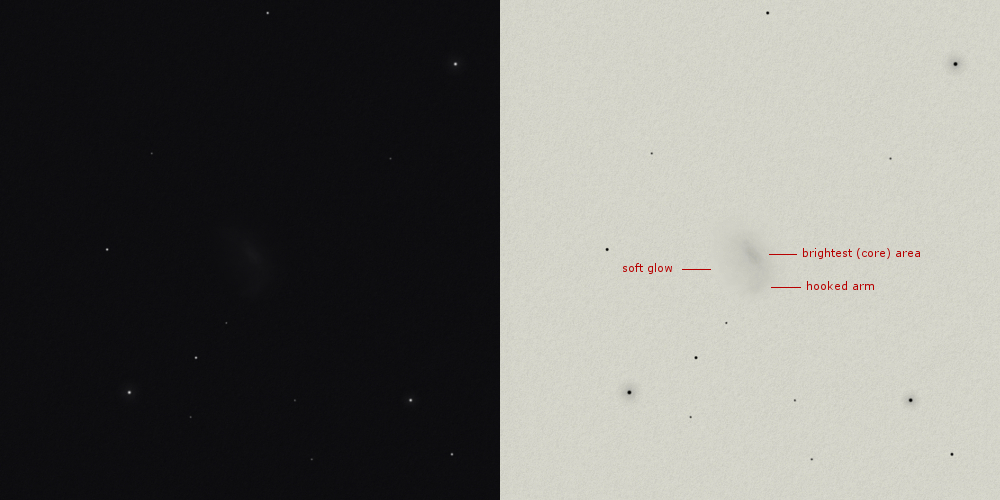
A bit of a deception because it’s not really bright (but can just be seen with DV). NGC 3664 has a bit a of a bent shape and is a bit brighter towards the center. With a lot of effort a spiral arm can be seen at the SW side and the galaxy is surrounded by a soft glow.
Arp 6 – NGC 2537, The Bearpaw
mag 12.3, size 1.7′ x 1.5′
Challenge: Horseshoe-shaped ring with a knotty bar inside (Y)

The first impression gives a bright, slightly oval galaxy with a bright knot on the NW rim. Increasing the magnification is rewarding: the galaxy starts to “glow” and the mottling is very apparent now. The horseshoe shaped ring is seen, composed of several brighter areas within the galaxy and vaguely the middle toe of the paw can be discerned as well. On the N rim a m15 star is visible with AV. A fine galaxy this Bearpaw!
Split arm (Arps 7 – 12)
Arp 7 – MCG-3-23-9
mag 14.5, size 1.3′ x 1.0′
Challenge: Split arm to NW, VV 25b (N)
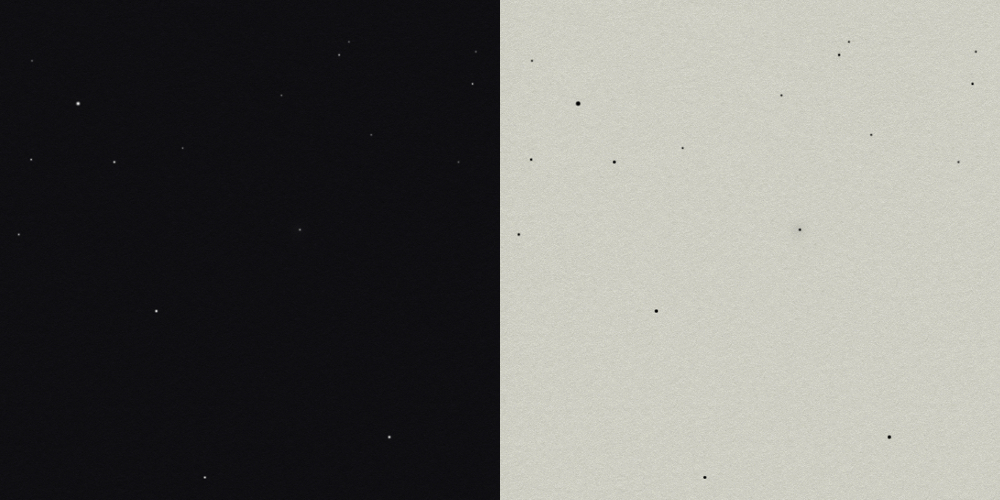
Small and round galaxy, right behind a m13 foreground star, which should not be mistaken for the core. The star makes the observation tricky, because the galaxy looks more like a planetary nebula because of it. No further details are seen.
Arp 8 – NGC 497
mag 13.0, size 2.1′ x 0.9′
Challenge: Split arm SE and bent arm NW (P)
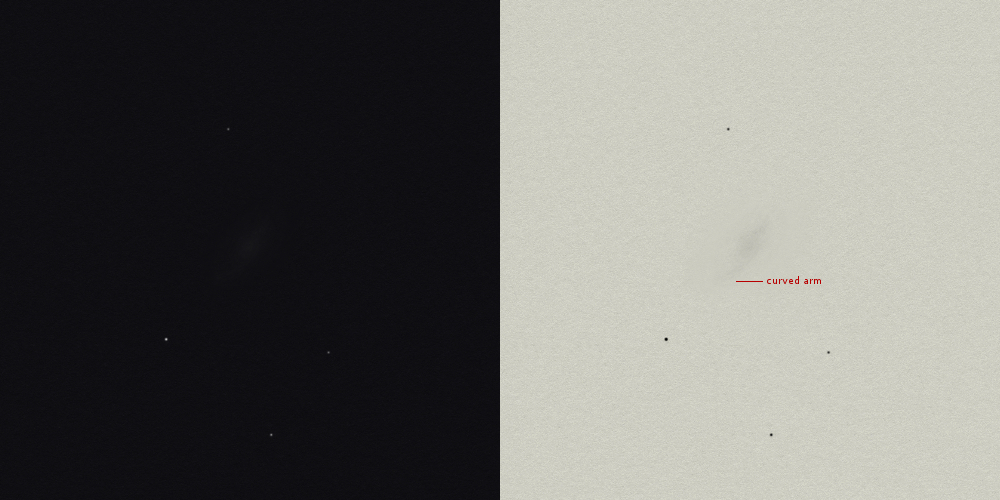
Can just be seen with DV. This is an elongated galaxy with a brighter core zone. The bent arm at NW can’t be seen, but the arm at SE is obviously slightly bent.
Arp 9 – NGC 2523
mag 11.9, size 3.0′ x 1.8′
Challenge: The split arm (N)
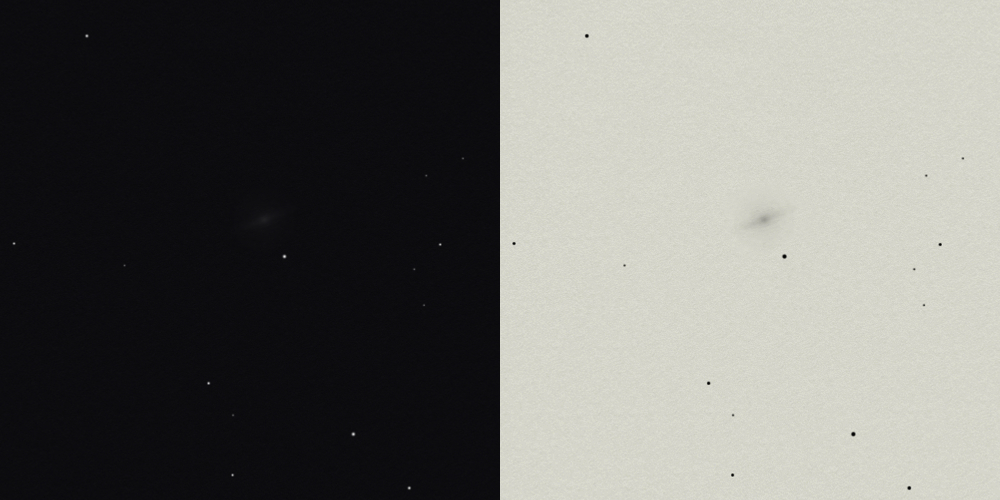
Pretty bright galaxy with a well defined bar and core area. Around it is a soft and round glow. At times I feel that I can see some of the spiral structure, but it’s too dim to draw any of it. Near a somewhat bright m11.7 star.
Arp 10 – UGC 1775
mag 13.8, size 1.5′ x 1.5′
Challenge: Ring and faint outer loops outside the ring (N)

Can be seen fairly easy with AV, but it’s too small and too dim to see the spiral arm. The galaxy is round, not brighter toward the center and without further details.
Arp 11 – UGC 717 and companions
UGC 717: mag 14.4, size 1.5′ x 1.0′
UGC 719: mag 14.9, size 0.9′ x 0.6′
MCG+2-4-4: mag 16.0, size 0.5′ x 0.3′
Challenge: Faint arms in UGC 717 (N)
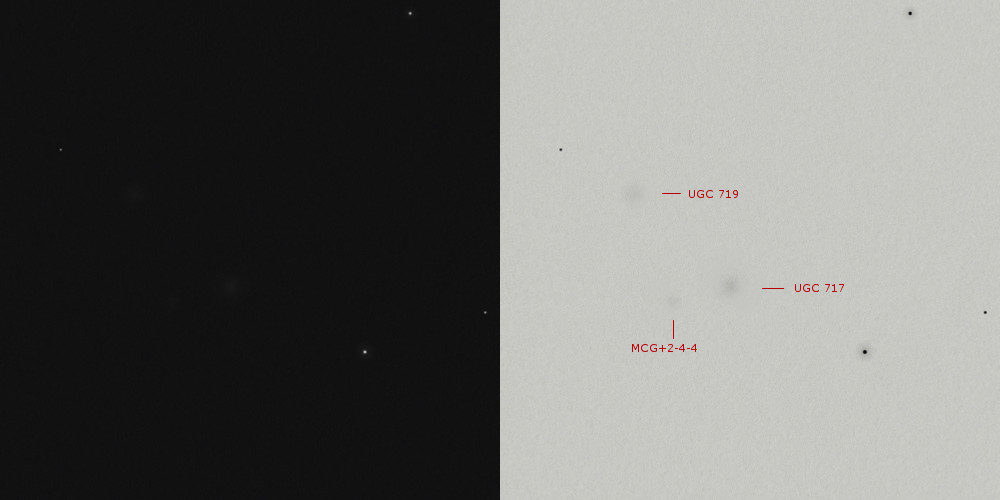
Nice, but dim group of 3 galaxies. UGC 717 is the easiest one and can be seen with AV with ease. UGC 719 is somewhat dimmer, but still doable. MCG +02-04-004 is the dimmest and smallest one of the group and is only suspected about 50% of the time.
Arp 12 – NGC 2608
mag 12.2, size 2.3′ x 1.4′
Challenge: Asymmertry of the two arms (N)
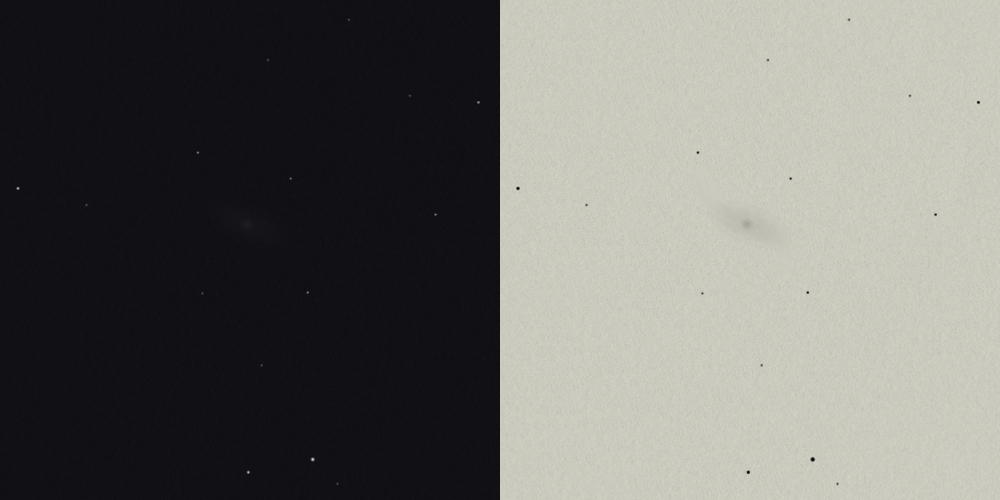
Pretty large and bright galaxy, seen with DV. Elongated and it appears with a stellar core, possibly because of a m15 foreground star right in the center. The two spiral arms are not seen as such, but the galaxy does have a flat “S” shape.
Detached segments (Arps 13 – 18)
Arp 13 – NGC 7448
mag 11.6, size 2.7′ x 1.2′
Challenge: Fading texture to the N and SE of nucleus (N)
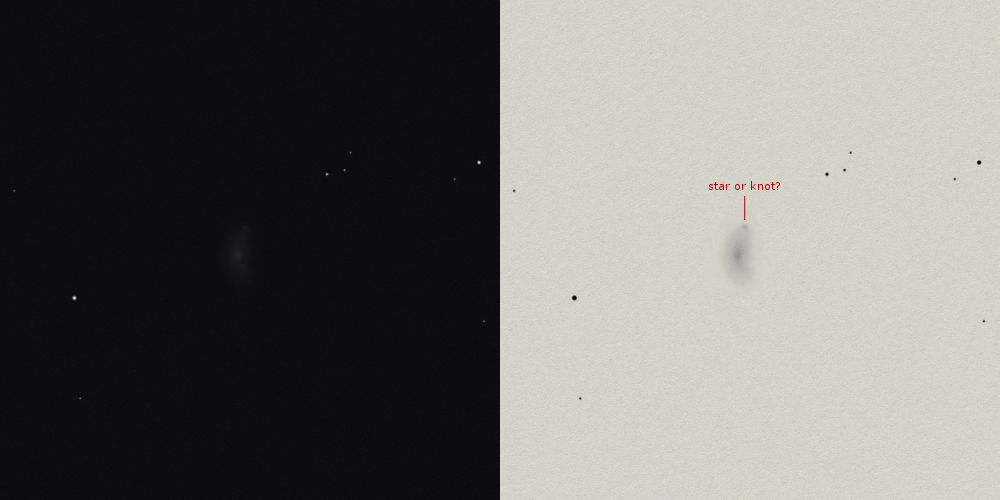
This is a clear, bean-shaped galaxy with an obvious brightening towards the core. On the S tip very feebly appears one of the detached segments. NW of the galaxy a tripple star can be seen.
Arp 14 – NGC 7314
mag 10.9, size 4.6′ x 2.1′
Challenge: Two odd segments to N, disorganized spiral structure (N)
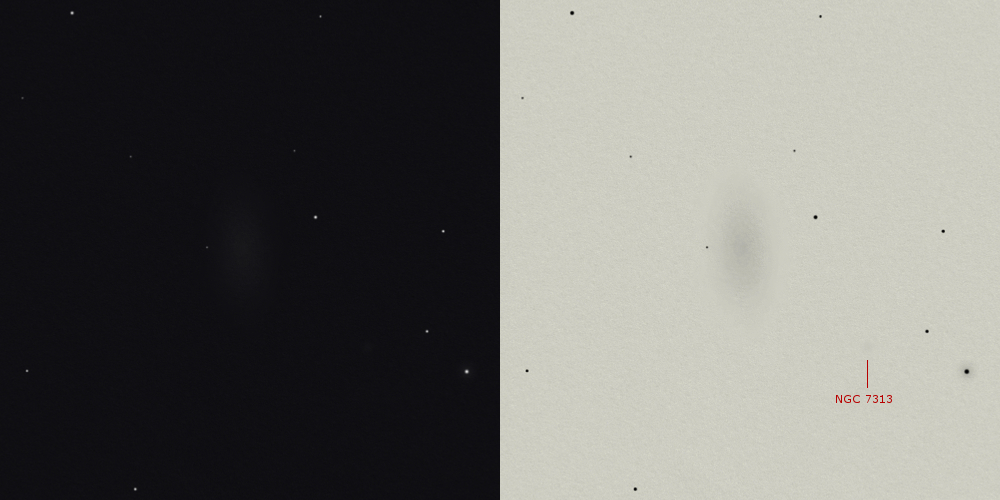
Large and smooth galaxy that is not noticeably brighter toward the core. Easily seen with DV as an oval glow. No additional details seen, apart from nearby galaxy NGC 7313, which is small (almost stellar) and only seen with AV.
Arp 15 – NGC 7393
mag 12.6, size 2.0′ x 0.9′
Challenge: Elliptical ring containing, but ofset from, core, and the detached segment (P)
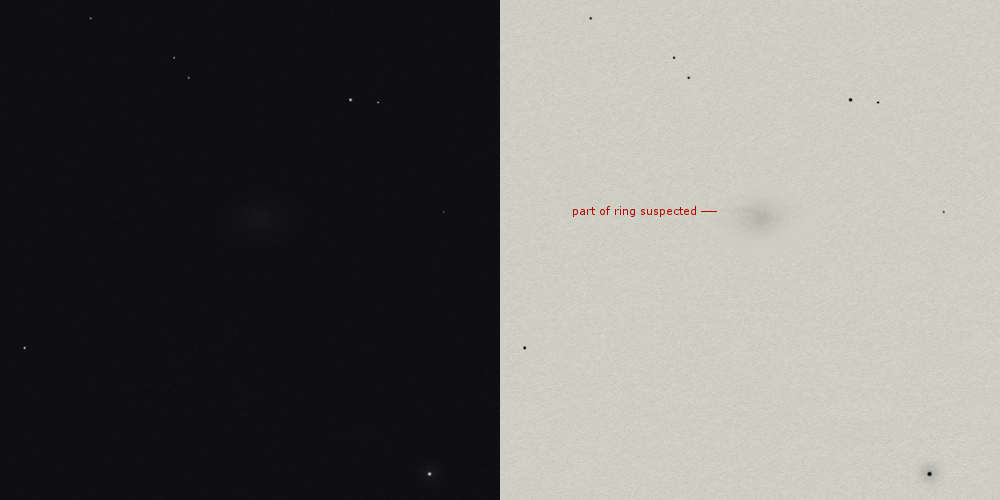
Immediately seen as quite large, bright and oval shaped. Somewhat brighter towards the core. A part of the elliptical ring is suspected on the N side, but the detached segment is definitely not seen.
Arp 16 – M66 (NGC 3627)
mag 9.7, size 9.1′ x 4.2′
Challenge: Asymmetry (Y)
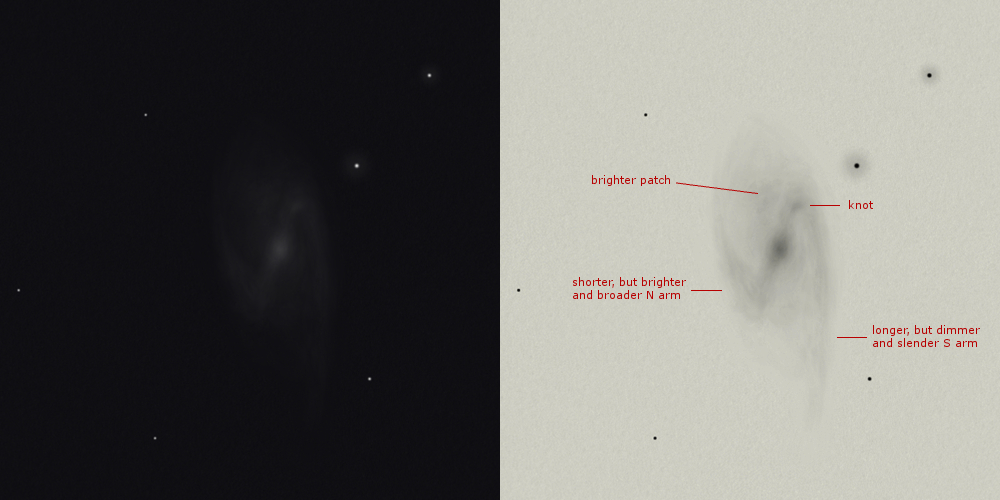
Of course bright and large too, even a bit brighter than M65 and with more details too. The core is small (not stellar) and much brighter than the outer parts. With AV the shape appears as that of a rugby ball, including the pointy ends. Two spiral arms are visible. The bottom one (N) is the brightest and “hooked”, easily seen against a dark intrusion and ending in a patch of nebulosity. The S-arm is dimmer, but reaches out beyond the boundary of the galaxy. Halfway, at the bend of the arm, a knot is seen.
Arp 17 – UGC 3972, PGC 21685 & PGC 21693
PGC 21693: mag 14.6, size 1.1′ x 0.6′
PGC 21685: mag 16.0, size 0.3′ x 0.1′
Challenge: The detached segment and asymmetry (N)
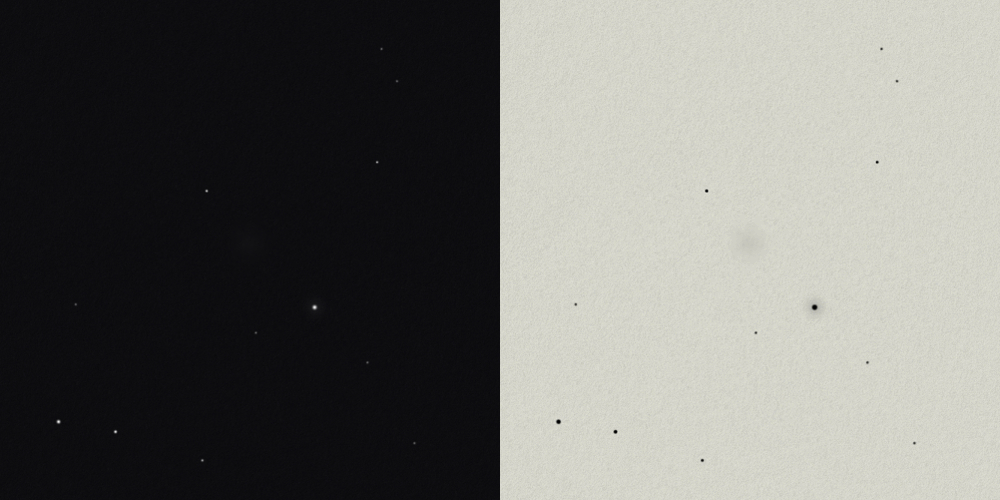
This object consists of two galaxies: PGC 21685 and PGC 21693, but only the latter is seen with effort as a dim, round haze in between two stars. No central brightening or additional details can be seen. The two galaxies together have designation UGC 3972.
Arp 18 – NGC 4088
mag 10.5, size 5.8′ x 2.3′
Challenge: Trace the fainter arm, discern rich mottling (P)
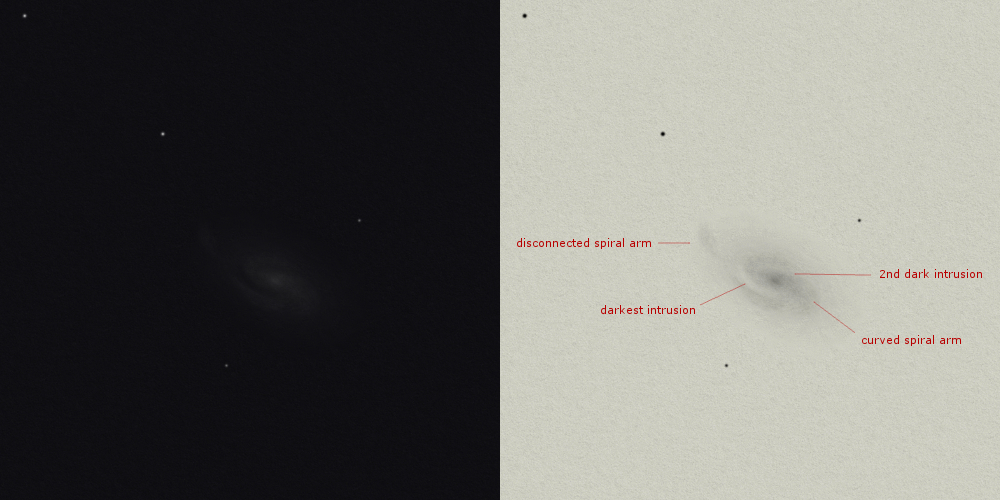
A fine sight. A distinct galaxy with spiral structure easily seen. To the SE of the core a dark wedge can be observed with under it a bright arm. on the NW side this is visible too, but dimmer and in the opposite direction. To the NE a loose fragment is seen on the extention; the disrupted spiral arm. Nice!
Three-armed (Arps 19 – 21)
Arp 19 – NGC 145
mag 13.2, size 1.8′ x 1.3′
Challenge: Trace long arm completely around to intersection with short arms (P)
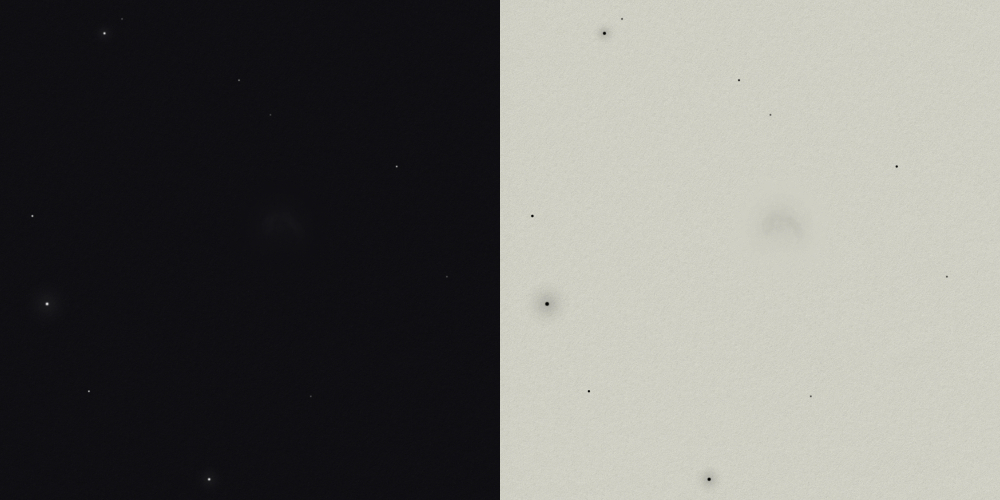
Pretty dim, just to be seen with DV. The galaxy is evenly brightened but with effort a long and a short spiral arm can be seen in a “V” shape. Pretty tough observation.
Arp 20 – UGC 3014
mag 14.4, size 1.2′ x 0.7′
Challenge: Three arms and knots in them (N)
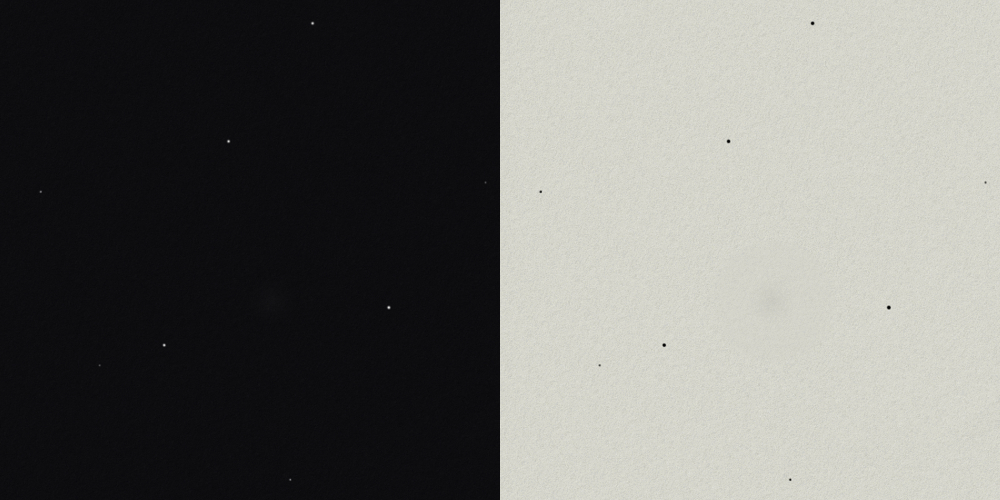
Seen with AV as a round smudge without any detail. Unfortunately, the transparancy was quite poor.
Arp 21 – MCG+5-26-47
mag 14.7, size 1.1′ x 0.7′
Challenge: FInd the three arms (N)
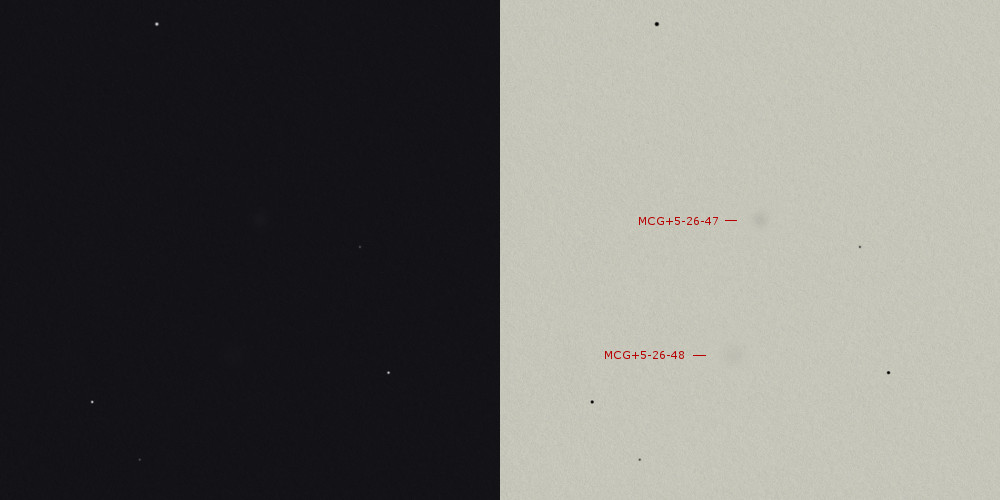
Appears round and slightly more bright towards the center. Seen with AV, just like the (non-related) galaxy to the S. No arms detected.
One-armed (Arps 22 – 24)
Arp 22 – NGC 4027 and companion
NGC 4027: mag 11.7, size 3.2′ x 2.4′
NGC 4027A: mag 14.9, size 0.9′ x 0.6′
Challenge: 4027 arm and mottled nucleus; 4027A linear core (P)
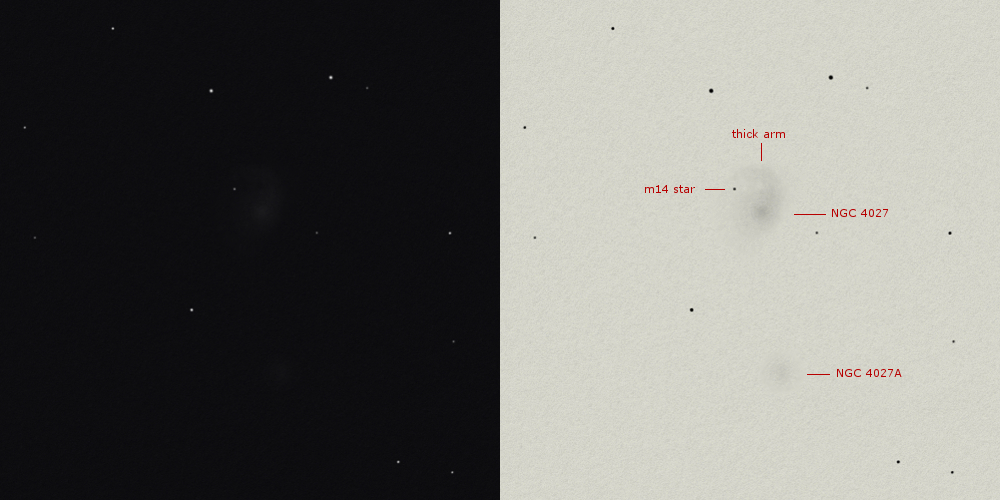
This is a nice one with a thick spiral arm at the N side. The arm ends at a dim star. The galaxy shows without a doubt central brightening and has a stellar core that is not much brighter than the surrounding glow. At the S side the galaxy is a bit flatter. A bit remote, but in the same field, NGC 4027A can be seen with AV with effort.
Arp 23 – NGC 4618 and NGC 4625
NGC 4618: mag 11.2, size 4.2′ x 3.4′
NGC 4625: mag 12.9, size 2.2′ x 1.9′
Challenge: Large arm in each galaxy, 4625’s faint outer arm and companion (P)
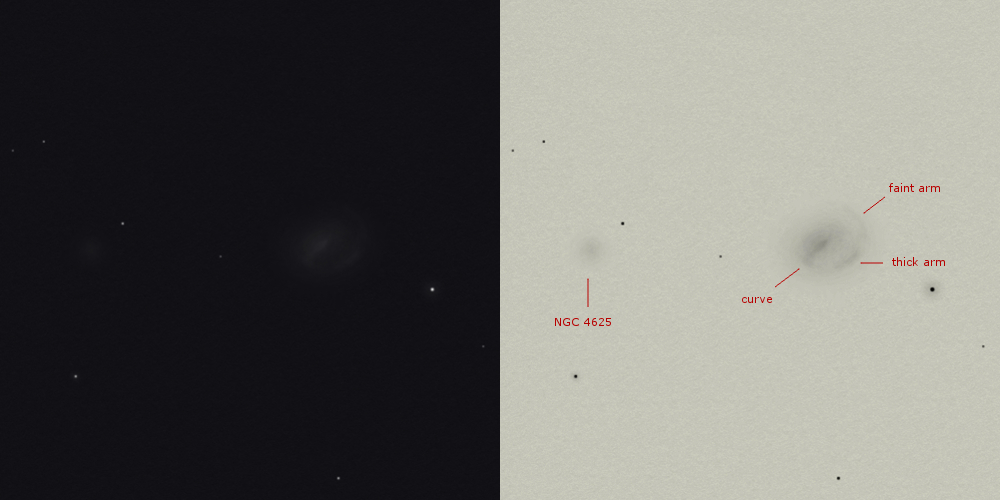
Very beautiful and with lots of structure visible. The thick arm is immediately noticed and the start of this arm from the SE of the oval shaped core too. The core and arm are separated by a large, dark void. With effort, the arm can be traced to the N, but not all the way. To the E NGC 4625 can’t be missed with DV.
Arp 24 – NGC 3445 and companions
NGC 3445: mag 12.6, size 1.6′ x 1.4′
companions: mar 15.0 and 17.2
Challenge: Both companions and the absorption band in main galaxy (N)
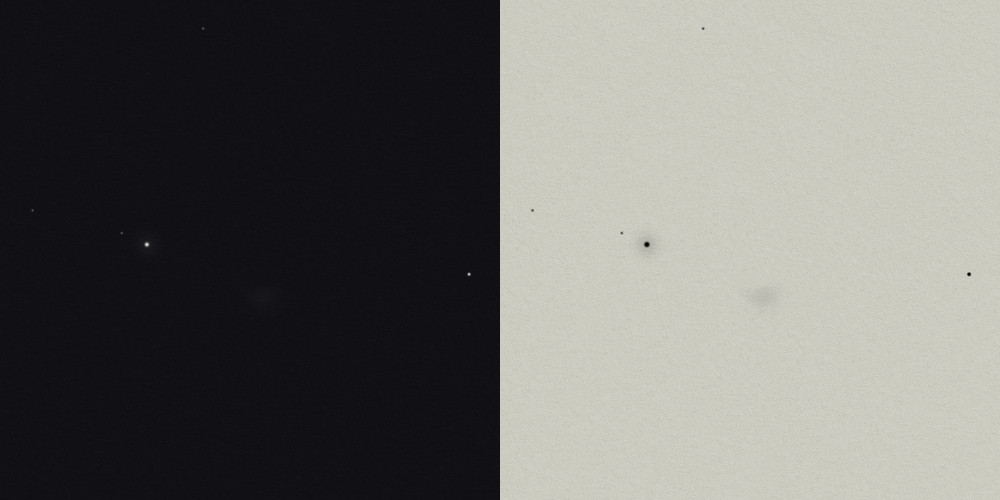
Pretty bright galaxy, flattened at N side and pointing towards a bright star. The companions were out of reach.
One heavy arm (Arps 25 – 30)
Arp 25 – NGC 2276
mag 11.4, size 2.8′ x 2.6′
Challenge: Mottling and tubular arm in NGC 2276 (P)
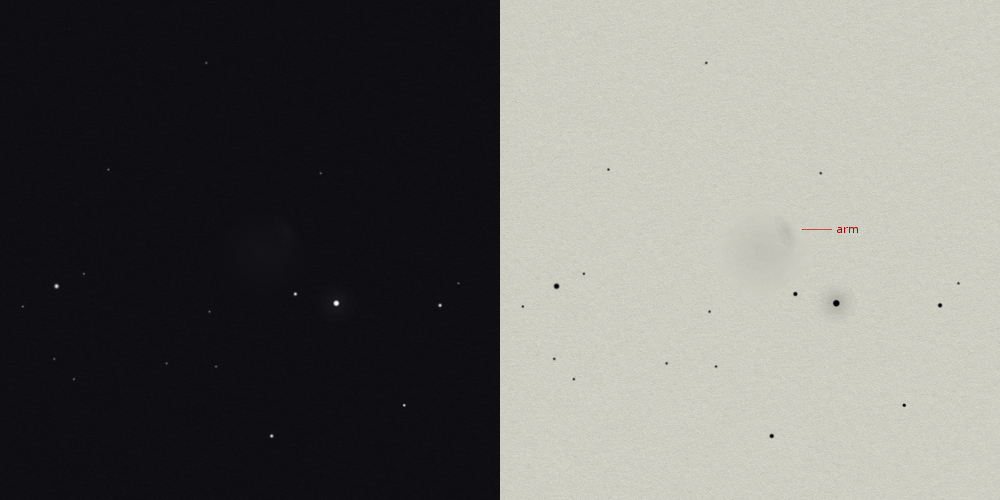
Arp 25 is a part of Arp 114 (including NGC 2300). NGC 2276 is large and very soft, without a visual core area. With effort, a slightly lighter patch can be seen on the W side. This is the heavy arm.
Arp 26 – Messier 101, NGC 5457
mag 7.9, size 29′ x 27′
Challenge: Straight arm NE, bent off brighter W arm; four other straight arm segments around the core; disconnected structure in arm W of core (P)
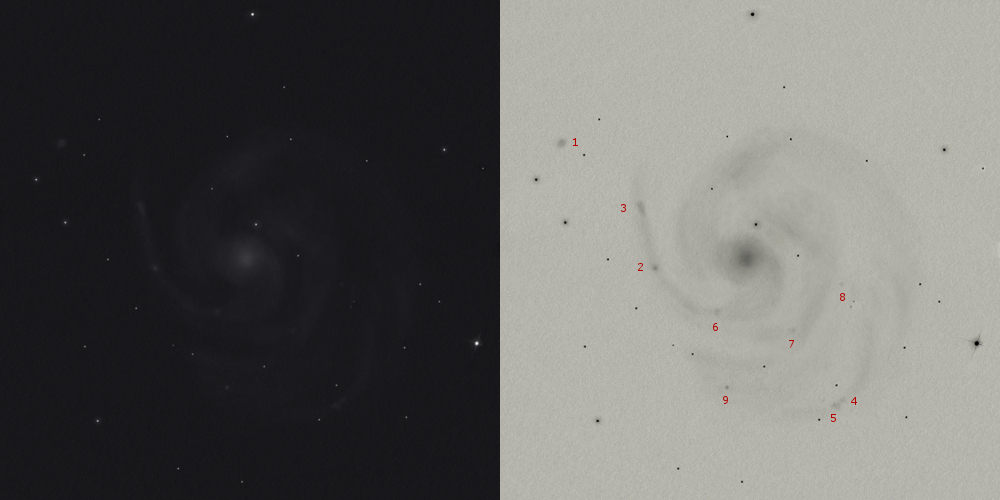
M101 is a monstrous galaxy where it’s possible to make out some of the spiral arm structure, filling up the field of view and surrounding a somewhat better visible core. the whole appearance is still very flimsy. If you don’t know exactly what to look for, then there is a chance that you will see right through it and only see the dim core in the heart of the beast. For the sketch I settle for a 14mm eyepiece, giving a magnification of 129x and an exit pupil of 3.2, which is a bit too high, but at least I’m able to capture the whole galaxy in a pleasing proportion. There are numerous of HII regions hiding in the slender arms of this galaxy and ten in total should be within the reach of my telescope, but only under perfect circumstances. So I switch eyepieces to a 7mm, which darkens the background enough and turns out to generate sufficient magnification to identify them (or at least most of them), here’s where (I think) I saw them:
1. NGC 5471 – Very bright, small and round. Resembles a galaxy
2. NGC 5461 – Very bright core area with a small halo around it
3. NGC 5462 – Large and stretched out in the direction of the spiral arm. Visible as a smooth and even brightening
4. NGC 5447 – Just comes loose from 5. NGC 5450 and the brightest of the two. Both are fairly easily visible
6. NGC 5458 – Weak. Can be seen as a faint brightening in the arm with averted vision
7. NGC 5453 – Utterly weak brightening in the arm with averted vision
8. NGC 5451 – This one takes a lot of effort. It’s near a very faint double star which is very distractive.
9. NGC 5455 – Small tuft of cotton and fairly bright. Visible in a triangle with 2 stars on the outer rim of the galaxy
10. NGC 5449 – Not seen
Arp 27 – NGC 3631
mag 10.4, size 5.0′ x 4.8′
Challenge: The one heavy arm, the absorption tubes, and the faint extension to the N (N)
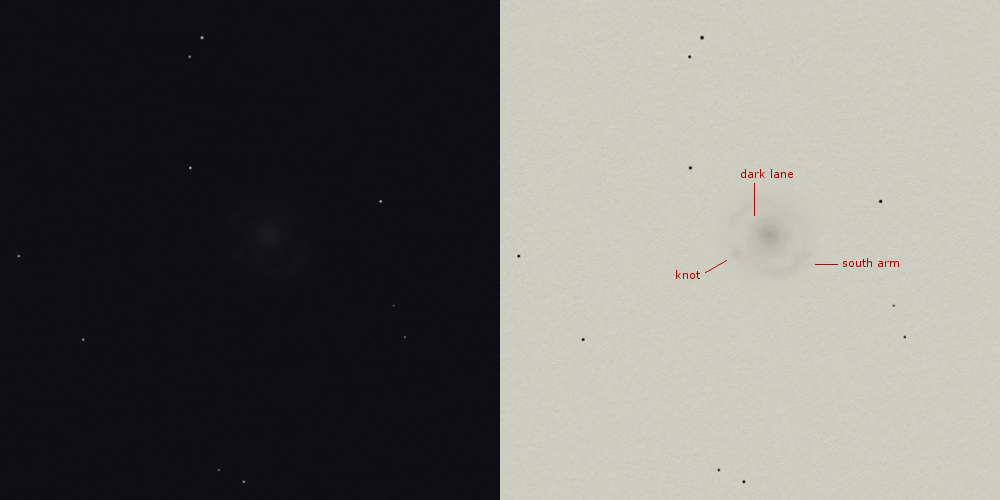
Large face-on with visible spiral structure. It’s a large, round glow with in the center a bright and compact core. At the N and S side of the core dark lanes can be discerned, betraying the spiral arms. At the S side the arm is indeed visible, but on the N side it’s harder. E of the core, near the edge, a knot or a foreground star is seen. Nice!
Arp 28 – NGC 7678
mag 11.8, size 2.4′ x 1.7′
Challenge: Three arms, one of which is heavy (P)
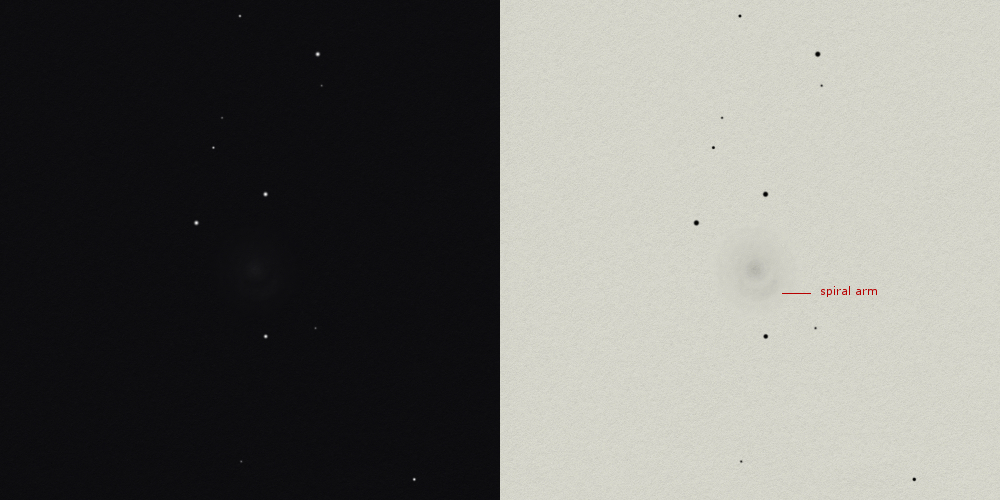
Very soft and almost round galaxy (face-on) with a compact and somewhat brighter core area, nestled between three brighter stars (and one dimmer). With AV the thicker arm on the S can be seen, mainly because of the darker notch between the arm and the core.
Arp 29 – NGC 6946
mag 8.8, size 11.6′ x 9.9′
Challenge: Five arms (P)
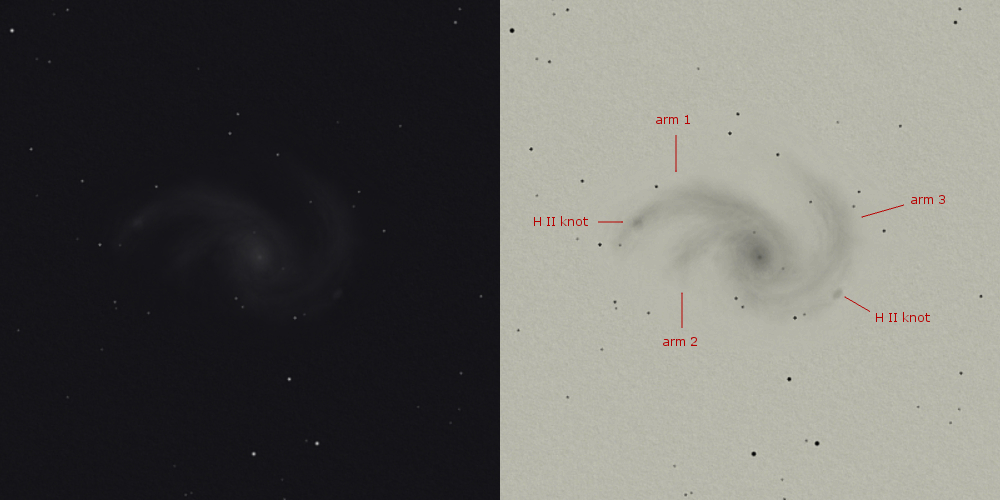
Nicknamed “The Fireworks Galaxy” because of the many supernovae occuring. This is a large face-on with three obvious spiral arms varying in brightness and thickness. The core is small and only a tad brighter than the surrounding (dim) glow. Many foreground stars are visible, embellishing the already splendid view. Two H II knots can be recognized. The fourth arm (detached from the third) and fifth arm were not seen.
Arp 30 – NGC 6365
NGC 6365A: mag 14.7, size 1.2′ x 0.8′
NGC 6365B: mag 14.8, size 1.1′ x 0.2′
Challenge: Multiple faint arms of NGC 6365A (N)

With some effort I can see the main component as a round smudge without any central brightening. Much dimmer that expected. B is not seen, but maybe 10% of the time suspected as an attachment to A. But I’m not convinced enough to add it to the sketch.
Integral sign (Arps 31 – 36)
Arp 31 – IC 167
mag 13.6, size 2.6′ x 1.4′
Challenge: Irregularity in NW arm (N)
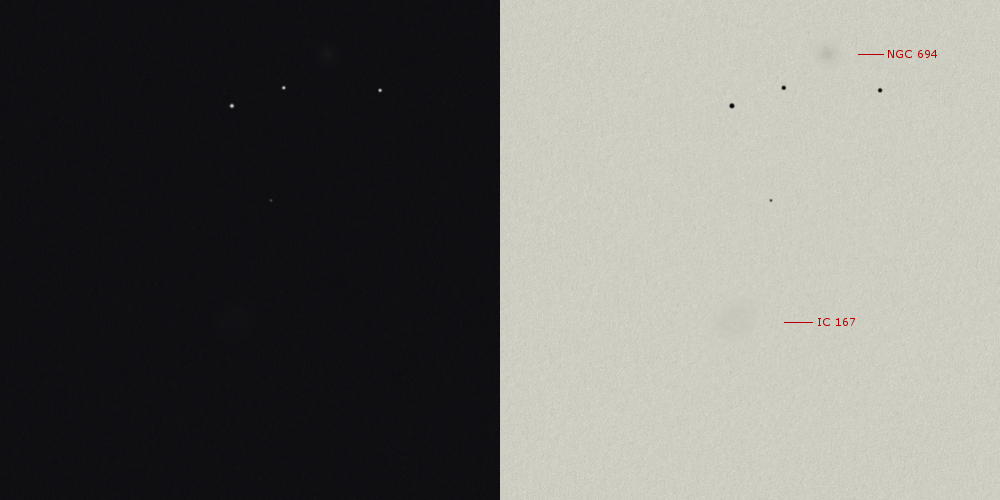
This galaxy is only seen with difficulty with AV. There is no clear core zone and the shape not completely round. Nearby galaxy NGC 694 is seen with ease.
Arp 32 – UGC 10770
VV 89a: mag 14.3, size 1.1′ x 0.5′
VV 89b: mag 17.0, size 0.9′ x 0.3′
Challenge: Arcing southern arm of VV 89a (N)
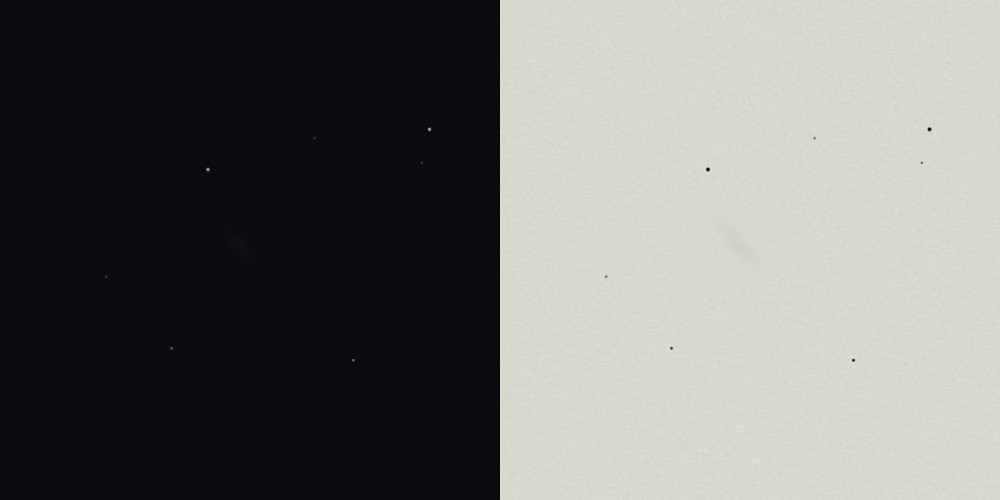
Galaxy is seen as a ribbon, almost with DV. With AV the ribbon is even extended a bit more. The B component is too dim and not visible as a separate galaxy, althought a “bulge” is suspected at times.
Arp 33 – UGC 8613
mag 15.3, size 1.4′ x 0.6′
Challenge: All four VV components and the faint wisp to W (N)
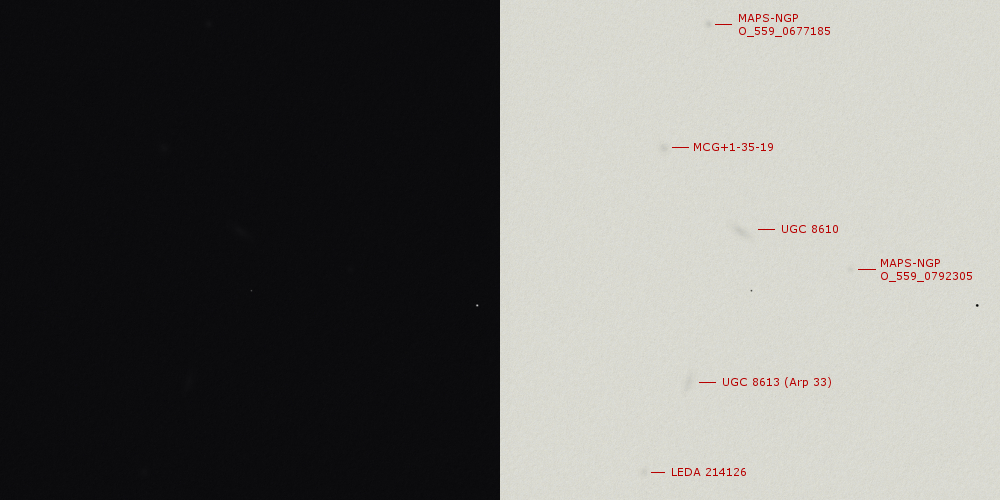
Part of Arp 326, but this one has its own Arp designation. UGC 8613 can be seen elongated, but no structure is seen, it’s very dim.
Arp 34 – NGC 4613 through NGC 4615
NGC 4613: mag 15.5, size 0.5′ x 0.4′
NGC 4614: mag 14.3, size 1.0′ x 0.8′
NGC 4615: mag 13.8, size 1.6′ x 0.7′
Challenge: Integral-sign shape of 4615, knots in its E arm and the hooks to N and SE (N)

Very nice, this triangle of galaxies of which one with a special (integral sign) shape. NGC 4613 is small, round and can only be seen with AV. NGC 4614 is the brightest, round and shows a brighter core. NGC 4615 is needle-shaped but despite that it’s pretty bright (can just be seen with DV), but without central brightening. A long and concentrated observation shows that the shape is not a perfect needle, but a bit more irregular; the true integral sign shape can’t be recognized, but with a lot of effort the SE side shows a hook. Apart from two bright stars, the field is empty.
Arp 35 – UGC 212: PGC 1431 and 1434
PGC 1431: mag 15.5, size 0.3′ x 0.1′
PGC 1434: mag 15.0, size 1.5′ x 0.7′
Challenge: Wide spiral arms in PGC 1434, and faint filament between galaxies (N)
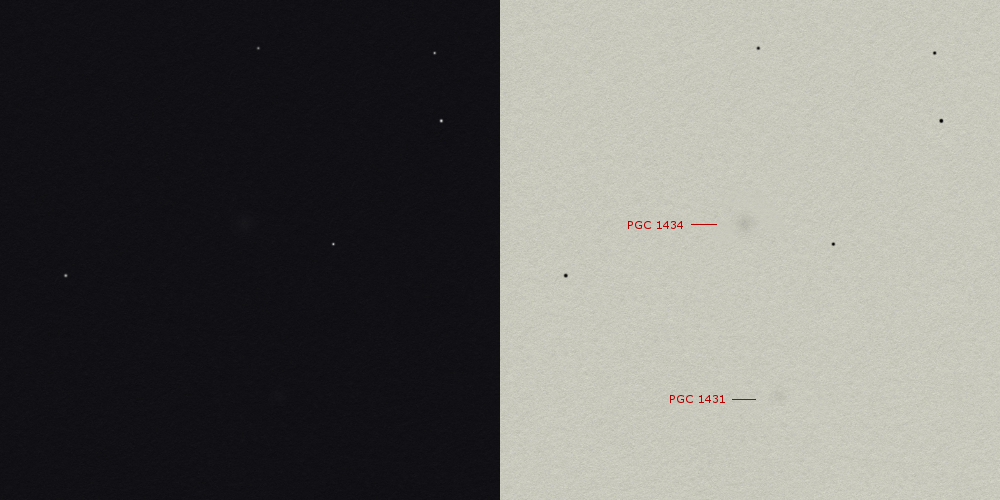
Dim pair, quite widely separated. PGC 1434 can be seen well with AV, but without detail. PGC 1431 is very difficult, but can be seen blinking up from time to time.
Arp 36 – UGC 8560
UGC 8560: mag 14.4, size 1.3′ x 1.2′
NGP9 galaxy: mag 18.7
Challenge: Faint arm W of nucleus, arc of three patches of E of nucleus, and two components of NGP9 companion (N)
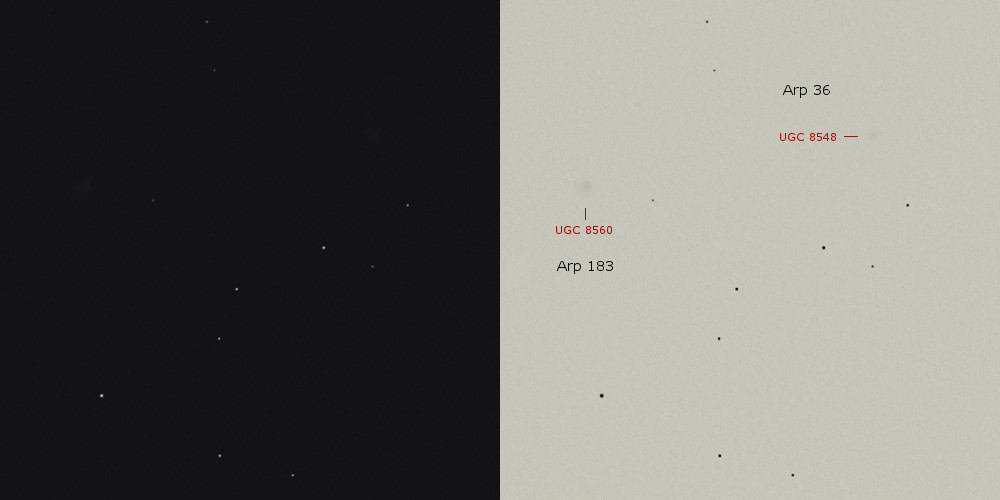
Very faint, small and only seen with effort with AV. In the same field as Arp 183.
Low surface-brightness companions on arms (Arps 37 – 48)
Arp 37 – M77 (NGC 1068)
mag 8.9, size 7.1′ x 6.1′
Challenge: The highly textured arms and the knots on the ENE and SW arms. The faint amorphous outer arms (P)
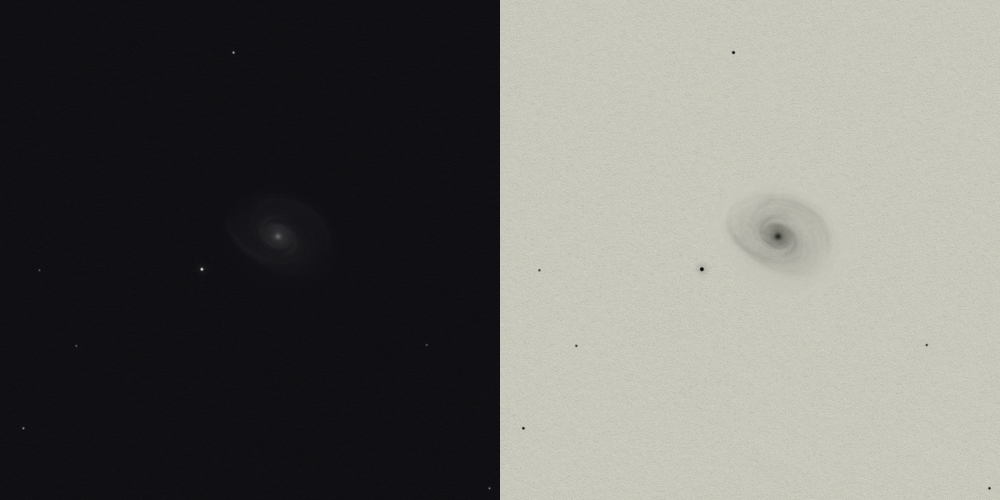
Beautiful face-on galaxy. Extremely bright with stellar nucleus and oval shaped core around it. The outer envelope spans up till halfway a bright star. On the SE side a definite flattening can be seen, here the glow fades more abruptly into the sky background. Two dark lanes can be seen on the SE and NW side, close to the core zone. They give away two spiral arms which can be seen too (with effort), the SE one being the easiest. The start of both arms moving out from the core is a bit brighter. By observing this galaxy at length, you can just “taste” the spiral structure getting through. Fascinating object.
Arp 38 – NGC 6412
mag 11.7, size 2.5′ x 2.2′
Challenge: Northern component (N)
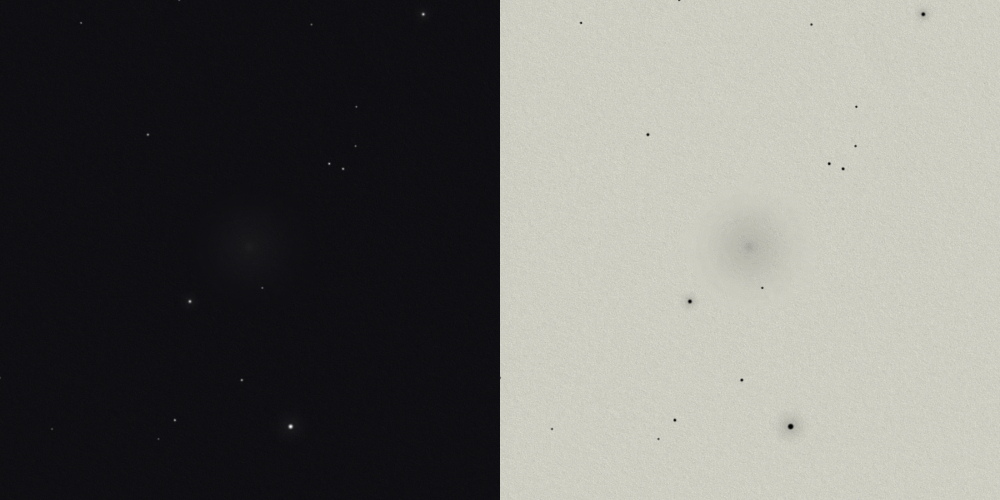
Face-on which appears perfectly round. The glow is very dim and soft. The stellar nucleus is only a bit brighter. A fairly bright star is seen on the S-side of the field. Northern component not visible.
Arp 39 – NGC 1347
mag 13.0, size 1.6′ x 1.3′
Challenge: The companion and the asymmetry of the main galaxy core (N)
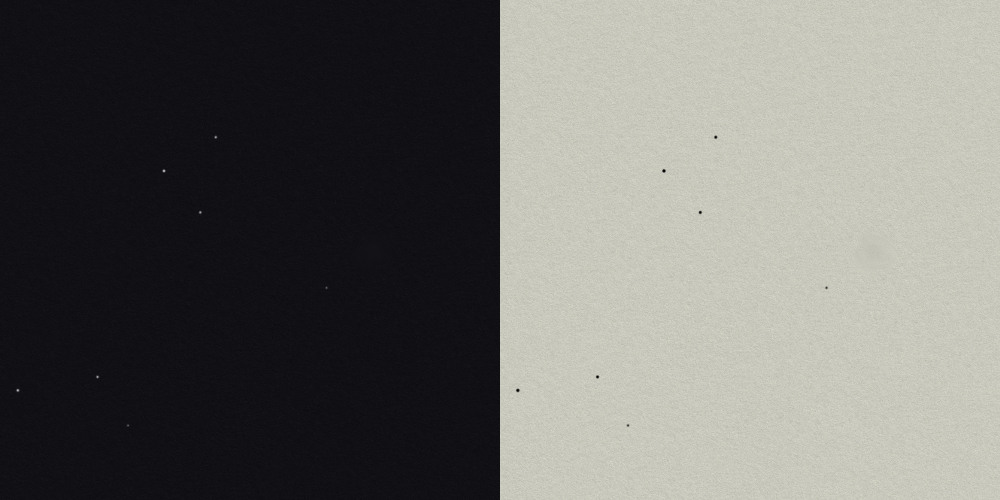
Very difficult, almost non visible, amorphous stain. Can held with AV about half of the time. The component was not seen, but I could see the dim star just next to the galaxy.
Arp 40 – IC 4271, VV 355
mag 15.7, size 0.8′ x 0.5′
Challenge: Absorption between galaxies; tiny S loop of small galaxy (N)
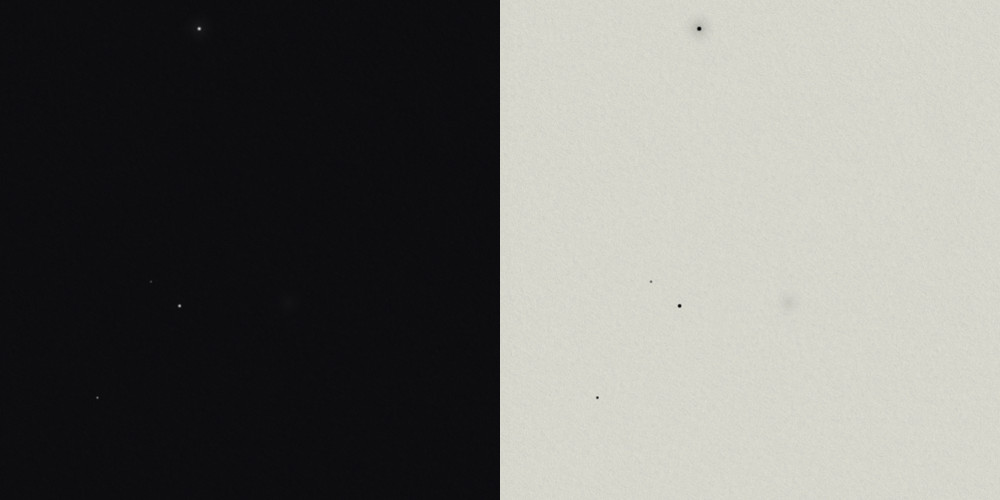
Fairly well visible with AV as one galaxy (not splitted). Round with some central brightening.
Arp 41 – NGC 1232
NGC 1232: mag 10.1, size 7.5′ x 6.5′
NGC 1232A: mag 15.2, size 0.9′ x 0.8′
Challenge: Texture in the arms and asymmetry of the companion (N)
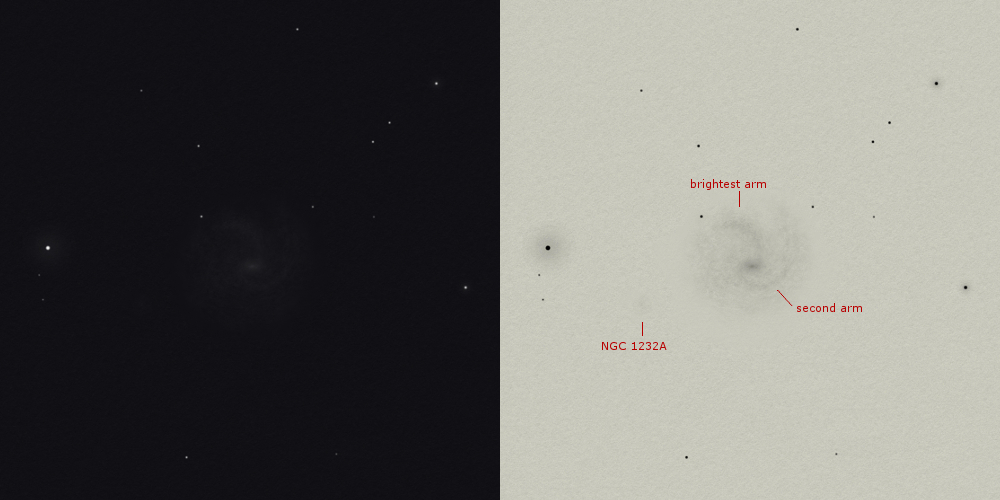
Saved this one for a night with good transparancy to be able to eek out all possible details. This is a pretty large face-on galaxy with a small and compact core. The core is not round, but rather almond-shaped, which betrays the bar. The angle can be seen. On the N-side, the most prominent spiral arm is seen, curling towards a star. On the S-side a more difficult arm can be glimpsed, closer to the center and a lot dimmer. Just as hard as this arm is the small companion NGC 1232A. But it can be seen (with effort with AV) separated from the mother galaxy and in a triangle with a bright star. Beautiful!
Arp 42 – NGC 5829 and IC 4526
NGC 5829: mag 13.9, size 1.8′ x 1.5′
IC 4526: mag 17, size 0.4′ x 0.3′
Challenge: The splits in two arms in 5829; faint NW arm in 4526 (N)
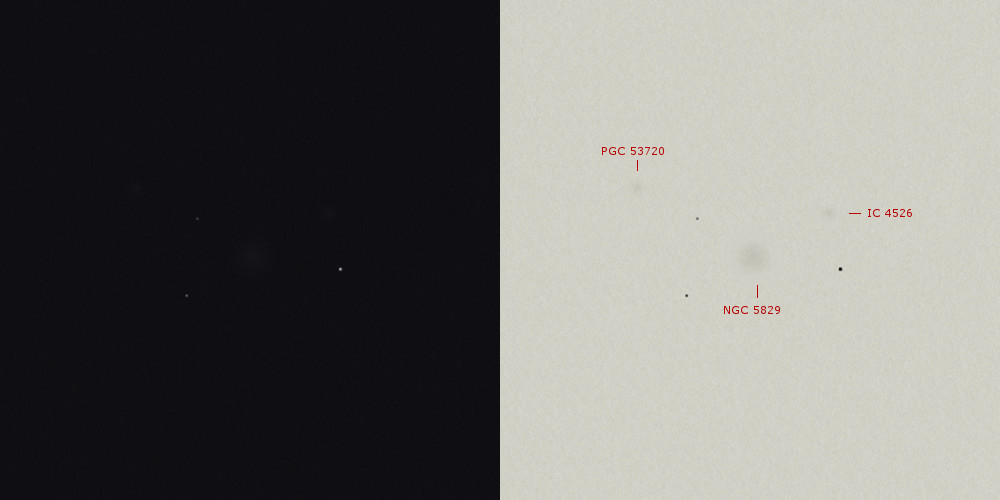
Rather dim group, but the main galaxy NGC 5829 is easily seen as a round face-on without central brightening. IC 4526 is very small and dim and only a fraction brighter than PGC 53720. Both blink up every now and then. The other members of the Hickson group, D and E, were not seen.
Arp 43 – IC 607
mag 13.2, size 1.8′ x 1.5′
Challenge: The bar, disrupted arms, and the comanion (N)
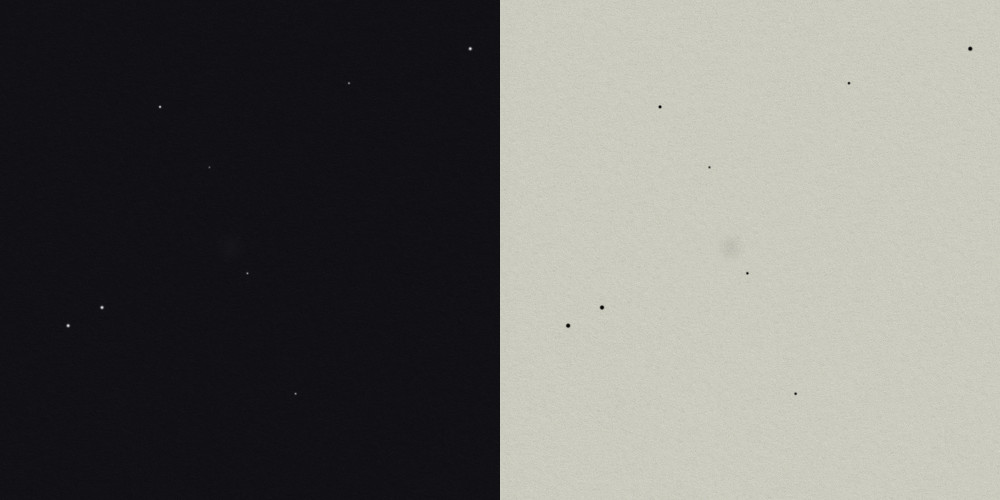
Dim and round, well seen with AV but without any further details.
Arp 44 – IC 609 and companions
IC 609: mag 14.1, size 1.5′ x 0.7′
VV 345b: mag 17.9, size 0.4′ x 0.3′
APMUKS galaxy: mag 19.5, size 0.2′
Challenge: Two distorted spiral arms N of IC 609 nucleus and two companions (N)
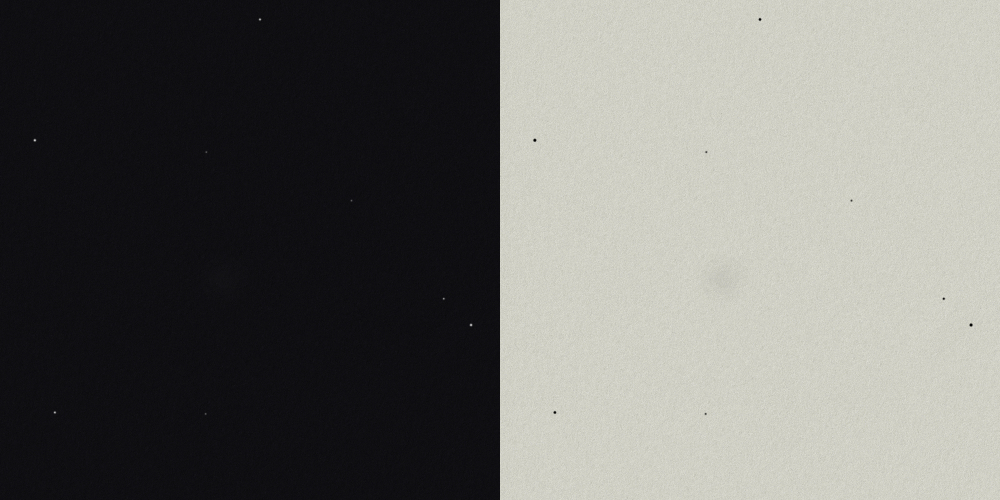
Seen as a large glow, easily with AV. It appears round and without brightening towards the core. No components were observed.
Arp 45 – UGC 9178
mag 15.5, size 1.1′ x 0.5′
Challenge: Extremely faint tail leading to VV 2b (N)

Very dim and small (not stellar), hard to see with AV. No tail and/or companion observed.
Arp 46 – UGC 12665
mag 15, size 1.2′ x 0.9′
Challenge: Asymmetry and companion to NE and subtle line to the SE (N)
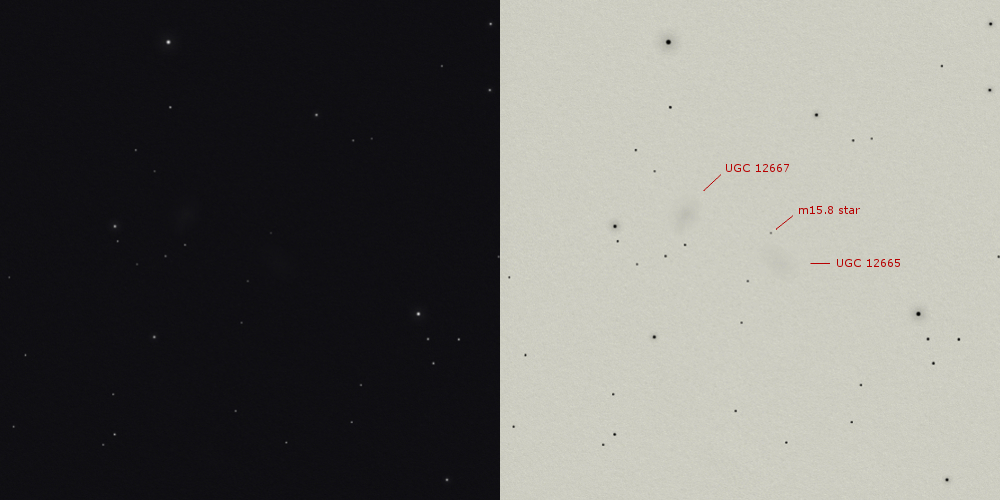
The Arp feature refers to the least brightest galaxy in this field: UGC 12665, but the companion can’t be seen. Instead, a mag 15.8 star can just be glimpsed in the same area. The galaxy itself is very dim and can only be seen with AV as a slightly elongated smudge. The other galaxy, UGC 12667, is brighter and can be seen with DV. It is elongated too and bends toward a nearby star.
Arp 47 – MCG+3-38-14 and companion
MCG+3-38-14: mag 16.2, size 0.8′ x 0.4′
NPM1G +19.0402: mag 16.6
Challenge: Tiny companion at end of hooked arm to E of MCG+3-38-14 (N)
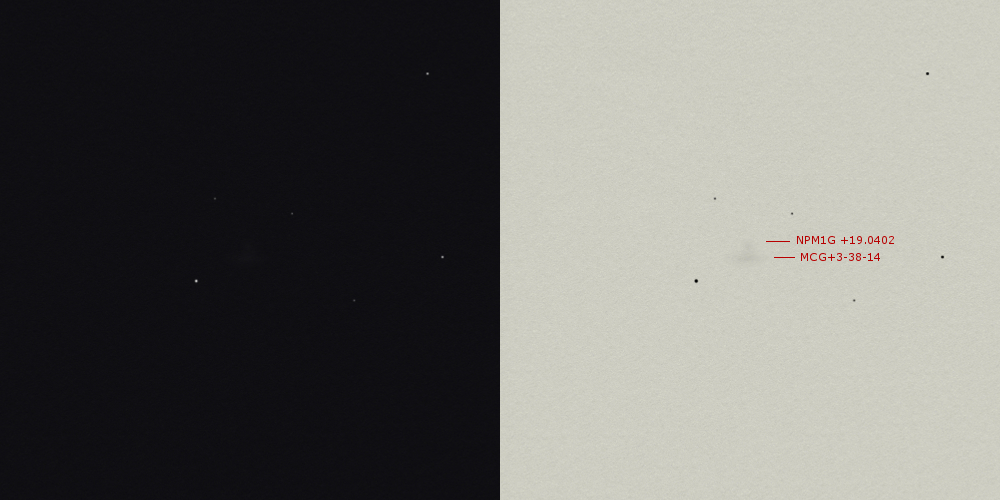
Very hard Arp object; most of the time the patch of nebulosity is seen and at some times this blob can be split into two components where the MCG galaxy is seen elongated. This pair needed all the transparancy it could possibly get, otherwise at least the NPM1G galaxy would have been a negative observation.
Small, high surface-brightness companions on arms (Arps 49 – 78)
Arp 49 – NGC 5665
mag 12.7, size 1.9′ x 1.3′
Challenge: Full counterclockwise path of arm from S to S and the stellar object to the E in arm (NGC 5665A)(N)
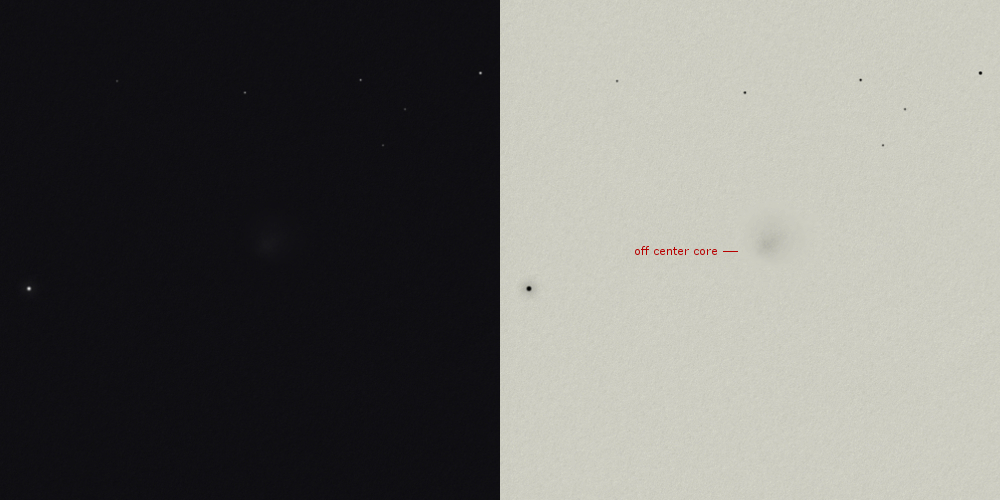
Pretty large and bright galaxy, easily seen with DV. The core area is not exactly located in the center, but more to the E instead. At this side the galaxy looks flatter, providing a bit of a rectangular shape.
Arp 50 – IC 1520
mag 14.0, size 0.5′ x 0.5′
Challenge: Detect the companion (N)
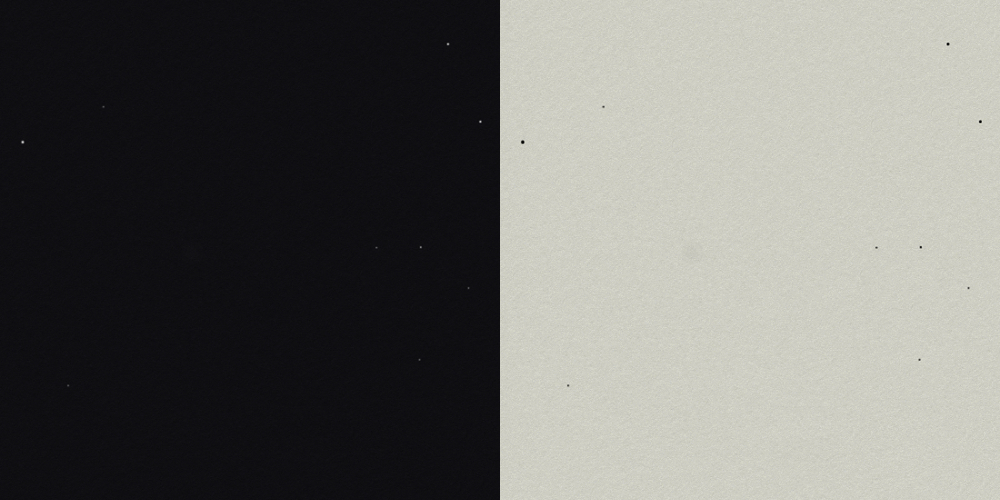
Close to an m7 star. Hard to see with AV; very dim, small, round and without central brightening. no details are observed.
Arp 51 – MCG-2-1-24
mag 15.0, size 0.8′ x 0.6′
Challenge: Faint companion (N)
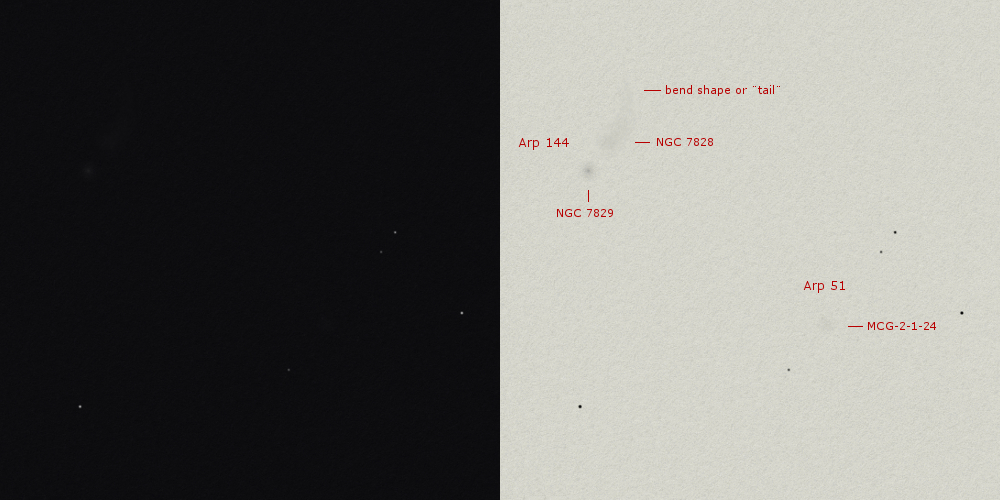
In the same field as Arp 144. MCG-2-1-24 is very dim and was missed during an earlier session. This time the transparancy is adequate enough to see it blinking sporadically, but it’s ultra weak.
Arp 53 – NGC 3290 and companion
NGC 3290: mag 14.5, size 1.0′ x 0.5′
MAC 1035-1716: mag 19, size 0.3′
Challenge: Asymmetric spirals in 3290, four knots in MAC companion, and second companion (N)
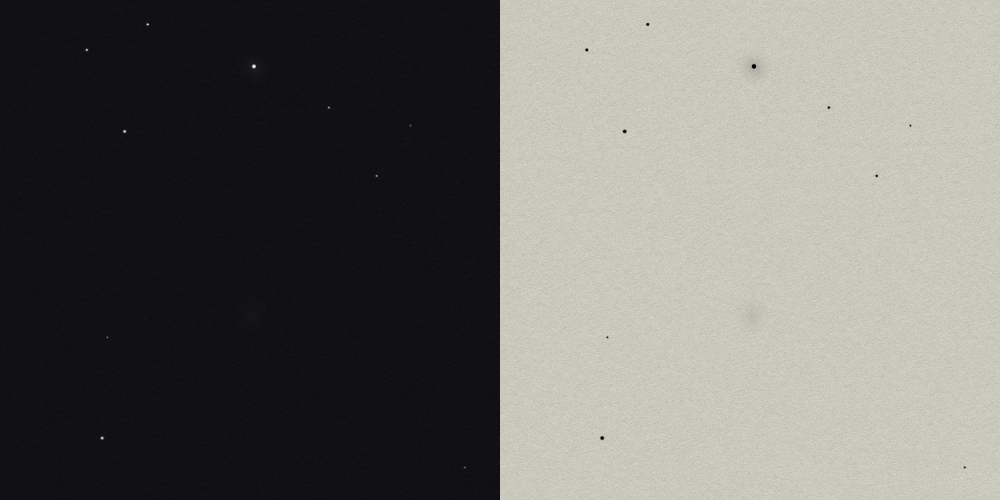
Easily seen with AV as a roundish nebula with some central brightening. Companions and spiral arm were not seen. Close to a bright m8 star.
Arp 54 – MCG-1-7-7 and PGC 9107
MCG-1-7-7: mag 15.0, size 1.0′ x 0.6′
PGC 9107: mag 15.0, size 0.5′ x 0.3′
Challenge: The heavy arm in main galaxy and structure in the companion (N)
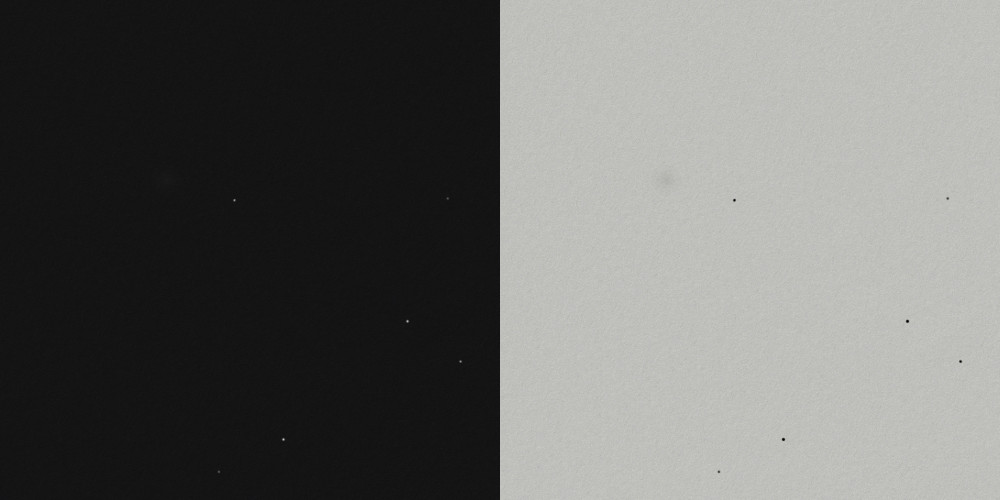
Seen with AV as a tiny puff of nebulosity, no details. Unfortunately, the companion (PGC 9107) was not seen.
Arp 55 – UGC 4881, The Grasshopper
UGC 4881: mag 14.9, size 1.0′ x 0.9′
KUG 0912+445B: mag 16, size 0.4′ x 0.3′
Challenge: U-shape, and plume to WNW of nucleus (N)
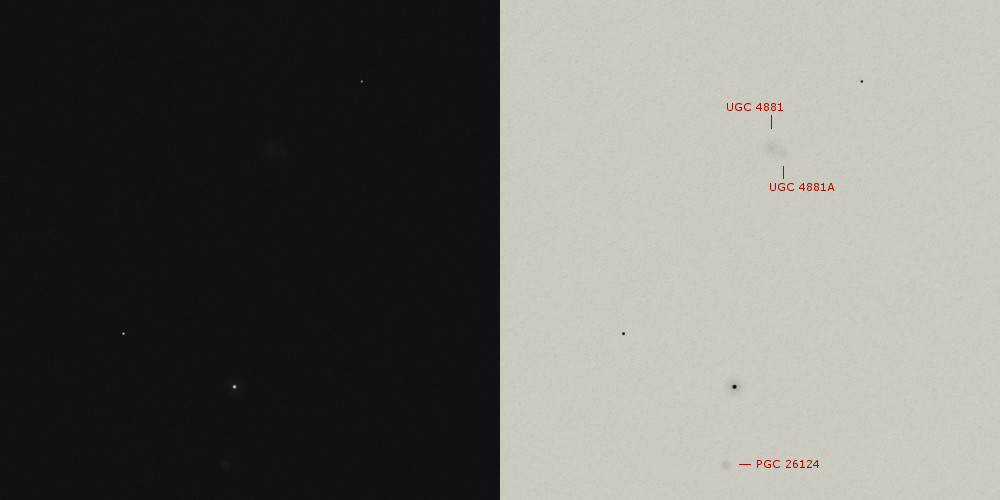
The Grasshopper. Seen directly and with some structure. Somewhat bent shape and a small and dim companion (UGC 4881A) just W of the core is sometimes seen separated. The “plume” and more remotely located components were not seen.
Arp 56 – UGC 1432
mag 14.6, size 0.9′ x 0.6′
Challenge: Western arm and the knot at its end (N)
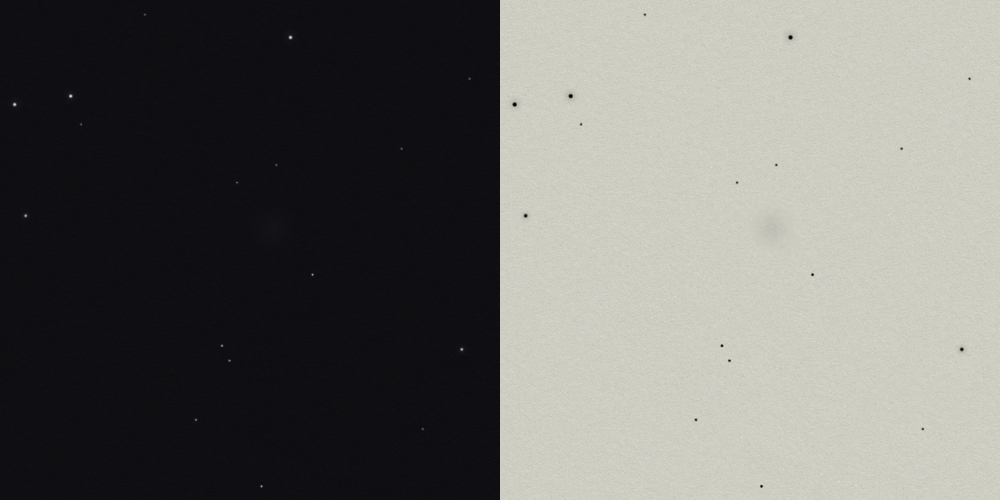
Very dim, only seen with AV as a smooth round glow without a pronounced core zone. The spiral arm and the knot at its remained invisible.
Arp 57 – MCG+3-34-12, VV 298
MCG+3-34-12: mag 15.5, size 0.9′ x 0.6′
MCG+3-34-13: mag 17.3, size 0.5′ x 0.3′
Challenge: Bent arm S from VV 298a (N)

MCG+3-34-12 can be glimpsed with effort as a small and round smear of light. There’s no trace of the companion and obviously the spiral arms were not seen too.
Arp 58 – UGC 4457
UGC 4457: mag 14.2, size 1.8′ x 1.0′
PGC 23937: not described
Challenge: Arm curving from E to N to W to SSE (N)
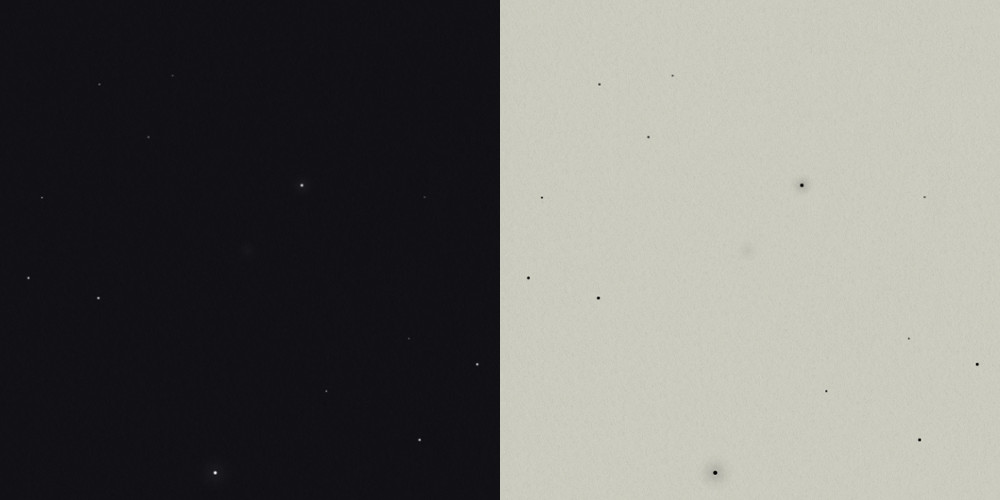
Faint fuzzy with AV, round, no details seen.
Arp 59 – NGC 341 and companion
NGC 341: mag 14.5, size 1.1′ x 1.0′
MCG-2-3-64: mag 15.0, size 0.3′ x 0.2′
Challenge: Companion and wide spiral arms (N)
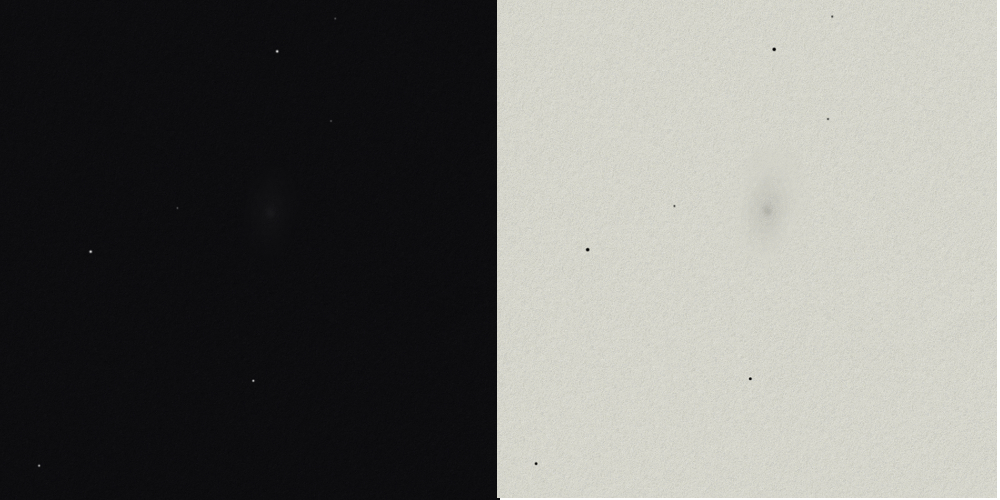
This is a pretty large and oval shaped galaxy, quite easily seen with DV. The angle is obvious as well as the dim and stellar like core. The companion is not seen, but perhaps suspected because of the stretched shape of the galaxy.
Arp 60 – PGC 1762846 and companion
PGC 1762846: mag 17.0, size 0.27′ x 0.23′
MAC galaxy: size 0.2′ x 0.1′
NGP galaxy: mag 19.5, size 0.2′ x 0.1′
Challenge: Three arms and two companions of main galaxy (N)
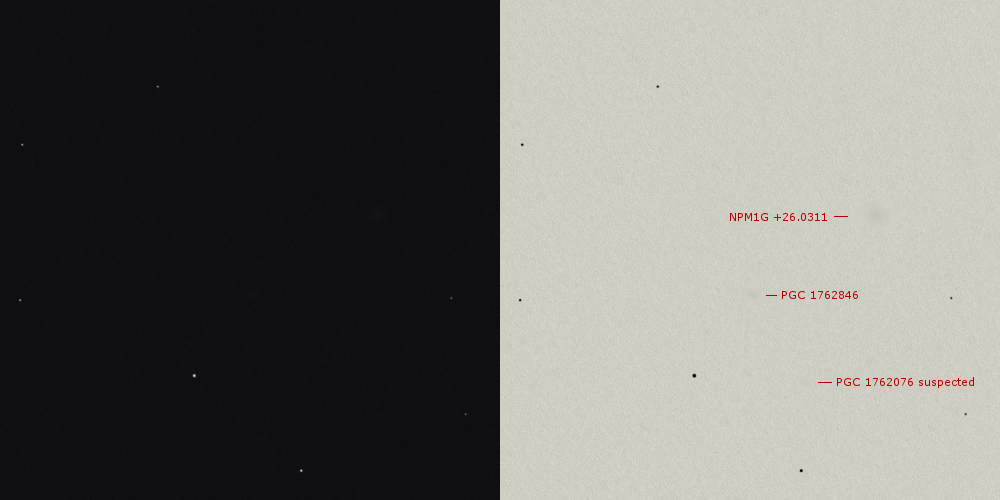
In the same field with Arp 196 (NPM1G +26.0311). PGC 1762846 is on the edge of visibility and only seen with AV about 25% of the time; small and round. This is one of the most difficult Arps I have seen so far.
Arp 61 – MCG+0-12-53 and -55
MCG+0-12-53: mag 15.5, size 0.4′ x 0.4′
MCG+0-12-55: mag 15.1, size 1.0′ x 0.5′
Challenge: Companion and two knots/stars leading to core of -55, straight arm to SE, curved arms to N, one leading to companion (N)

Two dim galaxies with a star in between them. MCG+0-12-53 is the hardest to see, but can be seen (not continuously) with AV. MCG+0-12-55 can almost be seen directly. Both galaxies appear small and round and no further detail is noticed.
Arp 62 – UGC 6865
mag 14.7, size 1.1′ x 0.4′
Challenge: Companion and asymmetry in main galaxy (P)
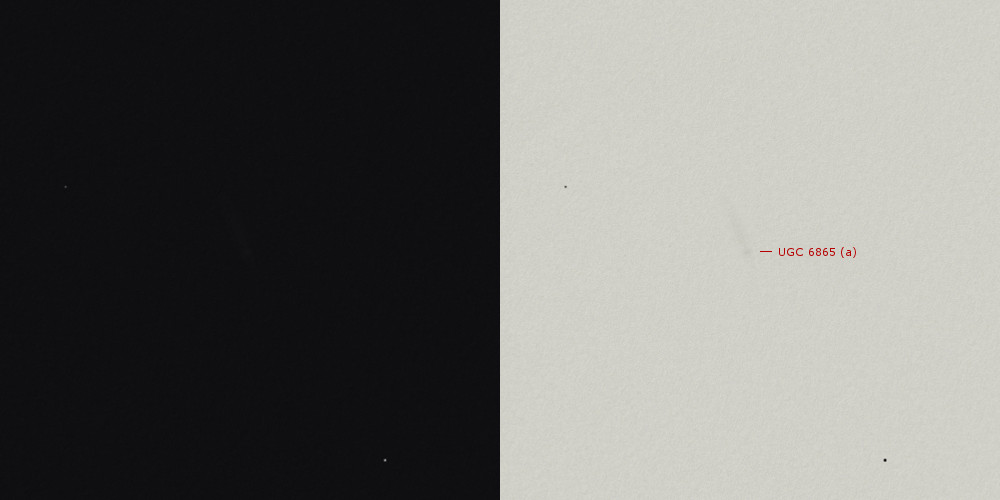
Needle shaped galaxy seen with AV and with effort a small knot near one of the tips. This is the tiny companion on an arm.
Arp 63 – NGC 2944
VV 82a: mag 14.7, size 0.9′ x 0.2′
VV 82b: mag 16.0, size 0.2′ x 0.1′
Challenge: Companion and plumes on larger galaxy (N)
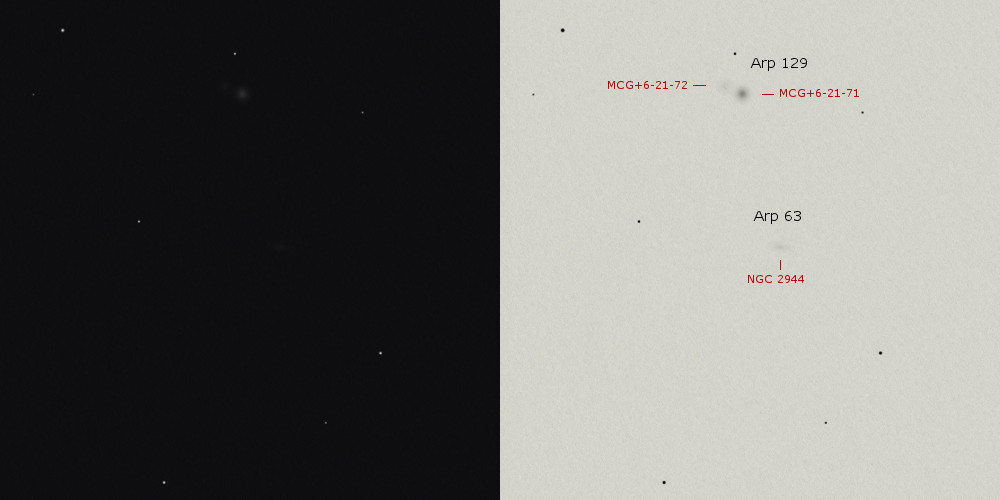
Elongated galaxy and direction can be seen well with AV. Some central brightening, but the double core and companion could not be detected, possibly due to bad seeing. In the same field as Arp 129.
Arp 64 – UGC 9503 and companion
mag 15.1, size 1.5′ x 0.4′
Challenge: Trace both arms to the companion (N)
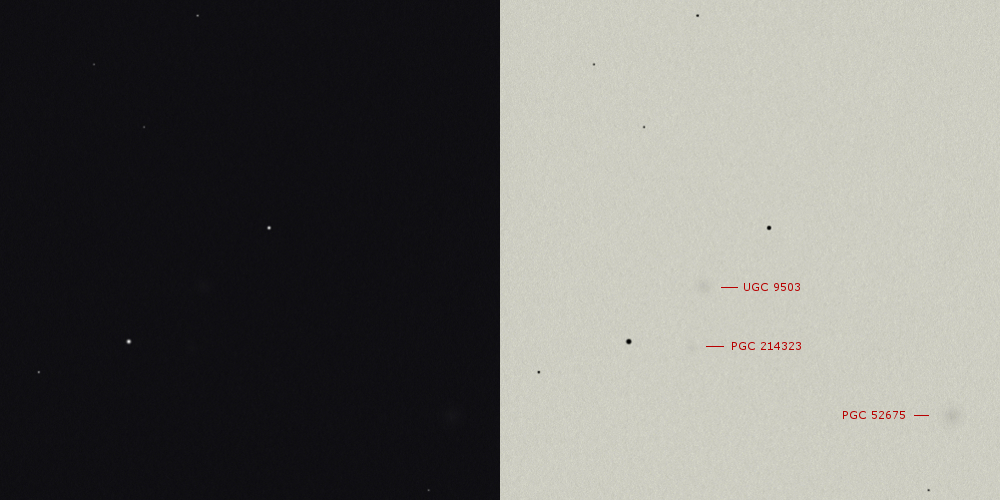
Hard to see with AV as a small and round dot with right next to it PGC 214323 even harder. Close to the pair is PGC 52675 which is easier but doesn’t belong to the Arp galaxies. No spiral arms or other details were visible.
Arp 65 – NGC 91 (also NGC 90) and NGC 93
NGC 91: mag 13.6, size 3.0′ x 0.9′
NGC 93: mag 13.3, size 1.5′ x 1.0′
Challenge: All three companions off the ends of the arms (N)
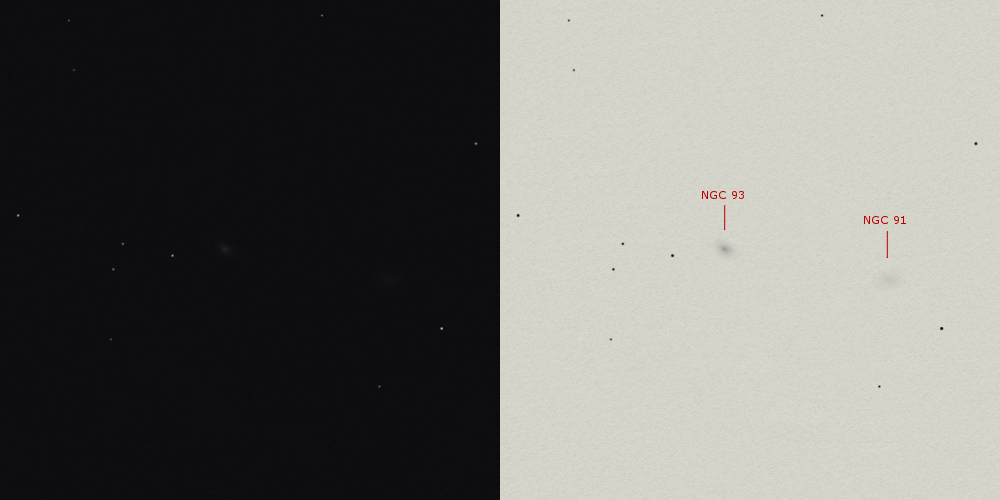
Two galaxies at a large distance from each other. E is NGC 93 and is small, pretty bright, oval and with a distinct core area. The PA can be seen with ease. NGC 91 on the other side is a dim cloud and only seen with AV. No extra details were observed and certainly not the three companions.
Arp 66 – UGC 10396
mag 14.6, size 1.2′ x 0.7′
Challenge: Detect multiple involved companions and sharp bends in arms (N)

Quite large, somewhat oval shaped. Companion and/or star at the N tip not seen.
Arp 68 – NGC 7757
mag 12.7, size 2.5′ x 1.8′
Challenge: Companion and straight N arm (N)
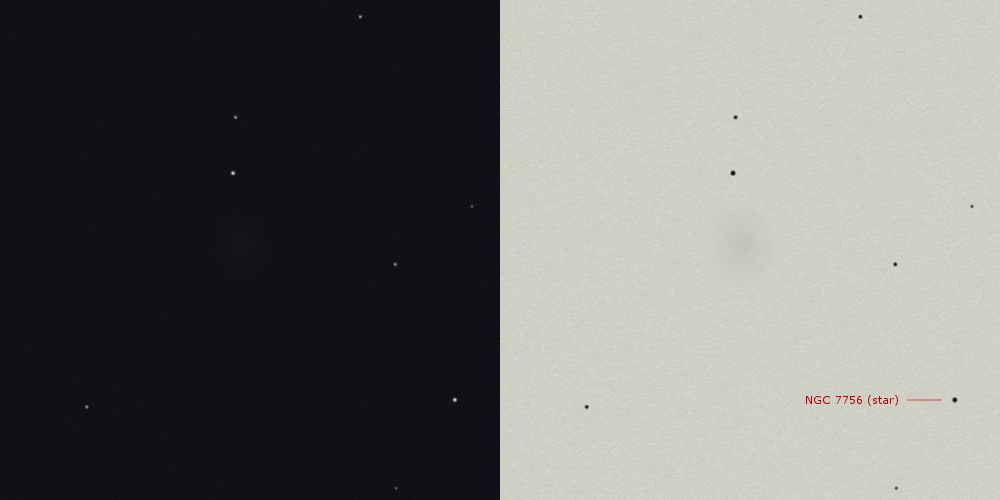
A dim, yet quite large glow, somewhat oval shaped. Can only be properly seen with AV at the end of two m13 stars. The companion was not seen. NGC 7756 nearby I did see, but this is actually a star.
Arp 69 – NGC 5579
NGC 5579: mag 13.6, size 1.9′ x 1.4′
SDSS galaxy: mag 17, size 0.4′ x 0.2′
Challenge: Strange broken arm, S of nucleus (N)
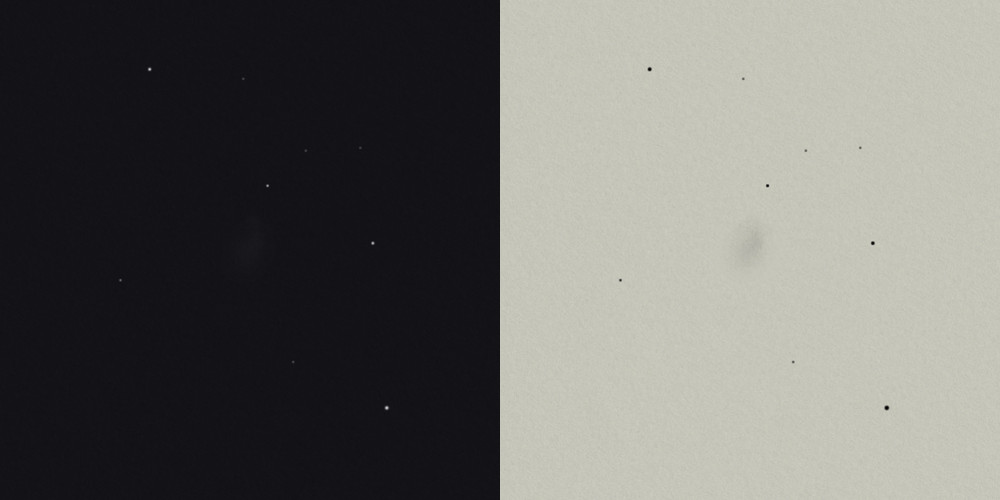
Easily seen with AV, rather large and slightly oval and with a bent shape. Some mottling was observed, but the companion was missed.
Arp 71 – NGC 6045 and NGC 6045B
NGC 6045: mag 13.9, size 1.3′ x 0.3′
NGC 6045B: mag 17.1, size 0.5′ x 0.5′
Challenge: Asymmetry in main galaxy, E and N companions (N)
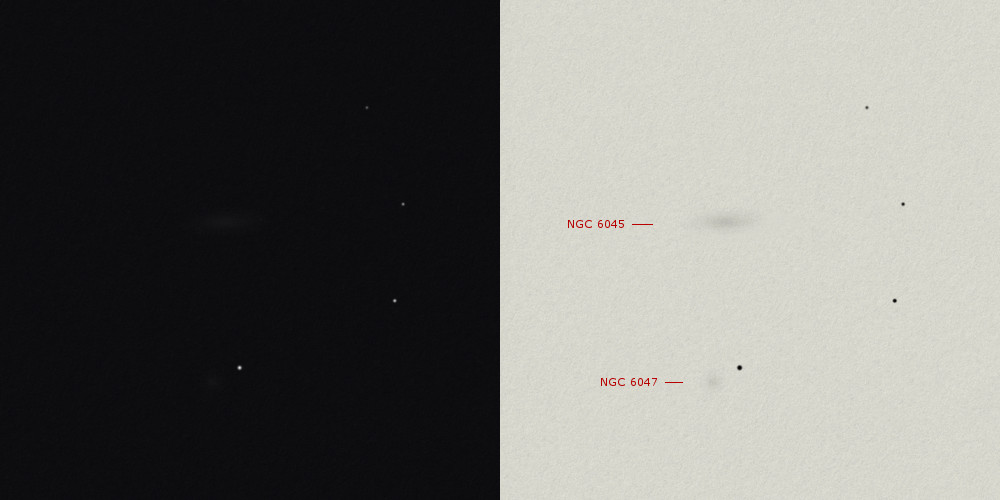
Part of AG 2151 but only the Arp fields were visited. Arp 71 (NGC 6045) has a needle shape and can be seen well with AV. It has a companion on its arm but unfortunately this one (m17) is out of reach of my 16″. Should be doable with a slightly bigger telescope. In the same field, NGC 6047 can be seen. It’s small, round and close to a pretty bright star.
Arp 72 – NGC 5994 & NGC 5996
NGC 5994: mag 15.0, size 0.4′ x 0.2′
NGC 5996: mag 12.6, size 1.7′ x 0.9′
Challenge: Faint and brighter arms of NGC 5996 (N)
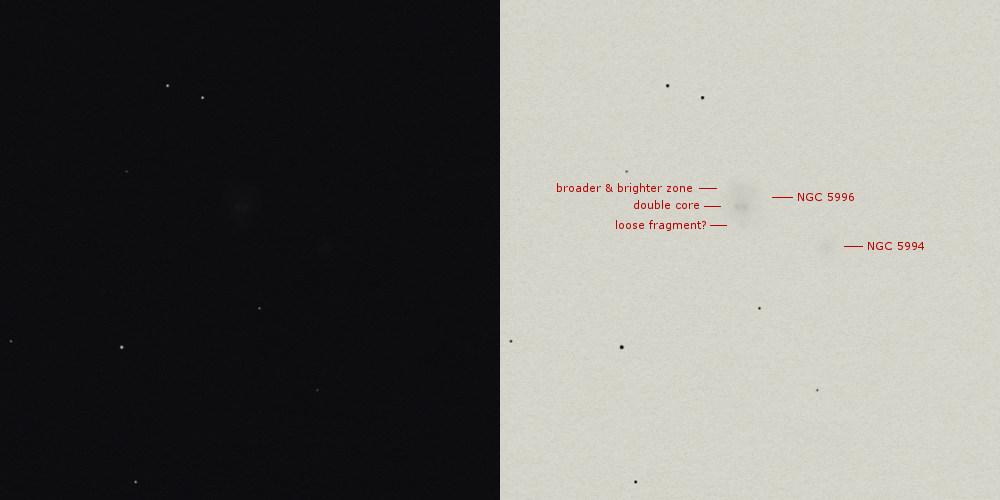
This is a nice pair of very small (almost stellar) and dim (only AV) NGC 5994 and brighter NGC 5996. The latter looks like it has a double core when using high magnification. The top side is broader and brighter and at the lower side a loose fragment is suspected, but it’s very weak.
Arp 73 – IC 1222
mag 13.5, size 1.7′ x 1.4′
Challenge: Splits in both arms (N)

Pretty large galaxy and seen with DV. Round with some central brightning, unfortunately without any structure.
Arp 74 – UGC 1626 and companion
mag 14.1, size 1.6′ x 1.5′
Challenge: The two arms and companion (N)
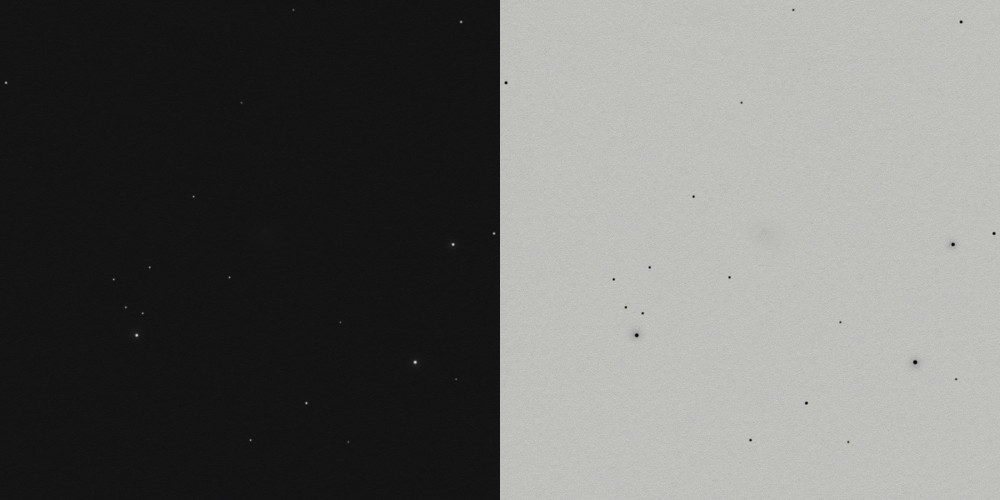
Certainly not the most beautiful, but I’m happy to be able to just see this one. It’s difficult to find in a rich star field, so a detailed star chart was essential. It’s a very faint glow and only distinguished from the background with effort with AV as a non-uniform “stain”.
Arp 75 – NGC 702 and companion
mag 13.3, size 1.6′ x 1.2′
Challenge: Companion and asymmetry (P)
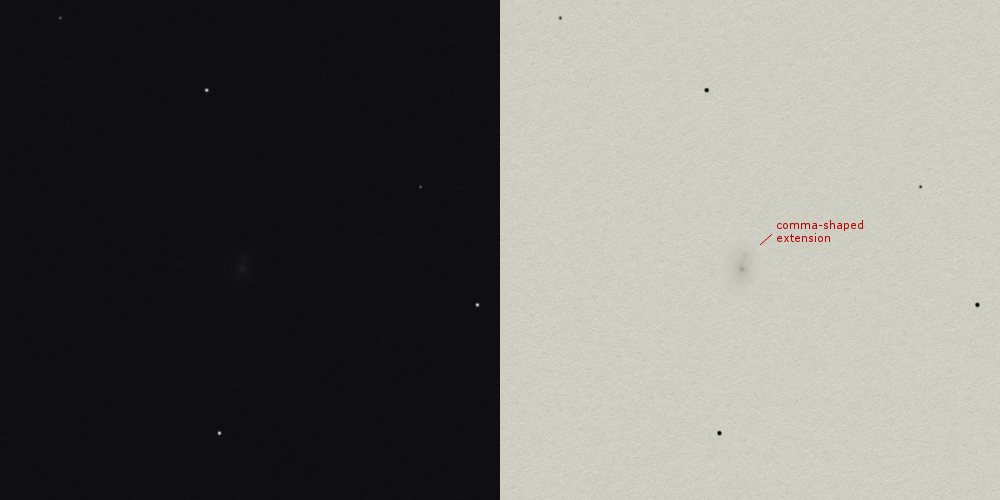
This one is small, but pretty bright and with a stellar core. The companion can not be seen apart, but more as a comma shaped extension. With AV the galaxy is clearly stretched.
Arp 76 – M90 (NGC 4569) and IC 3583
M90: mag 10.3, size 9.7′ x 4.4′
IC 3583: mag 13.3, size 2.2′ x 1.1′
Challenge: Absorption structures near the core of M90, linear core structure of IC 3583 (N)
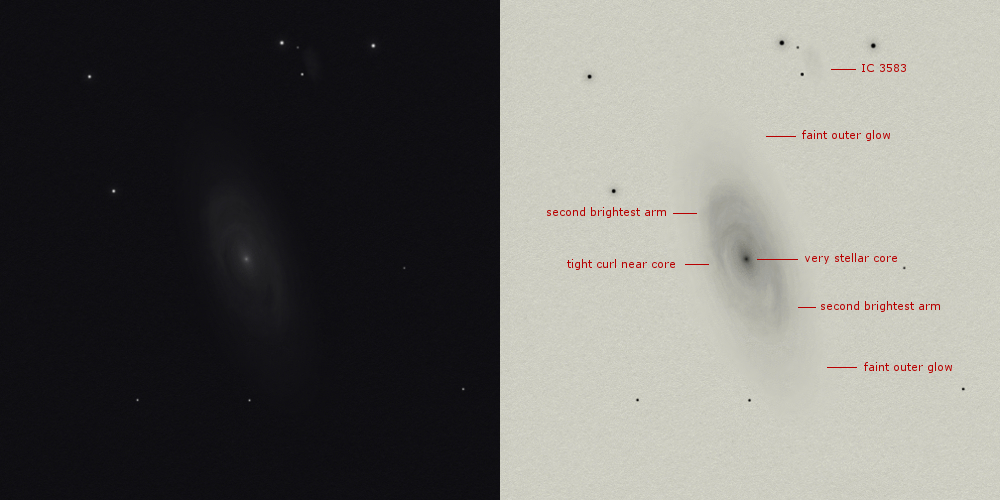
This one is really nice, even though the spiral structure is a bit difficult to follow. It’s seen as a thick cigar, but with AV the shape is more like a needle due to the outer glow that extends far beyond the galaxy. At the N side the easiest arm is visible; a nice curl with below it another (dimmer) arm. They both run down on the E side. At the SW side another spiral arm can be seen that extends a bit further to the S. The core is remarkably stellar and brighter than any star in the field. Above in the image IC 3583 can be seen as a streak of light, captured between 3 bright and a dim star.
Arp 77 – NGC 1097
NGC 1097: mag 9.2, size 12.7′ x 9.4′
NGC 1097A: mag 13.8, size 0.8′ x 0.5′
Challenge: Bright knots in the arms, nonspiral structure S of the companion and the jets beyond the Arp fields (N)
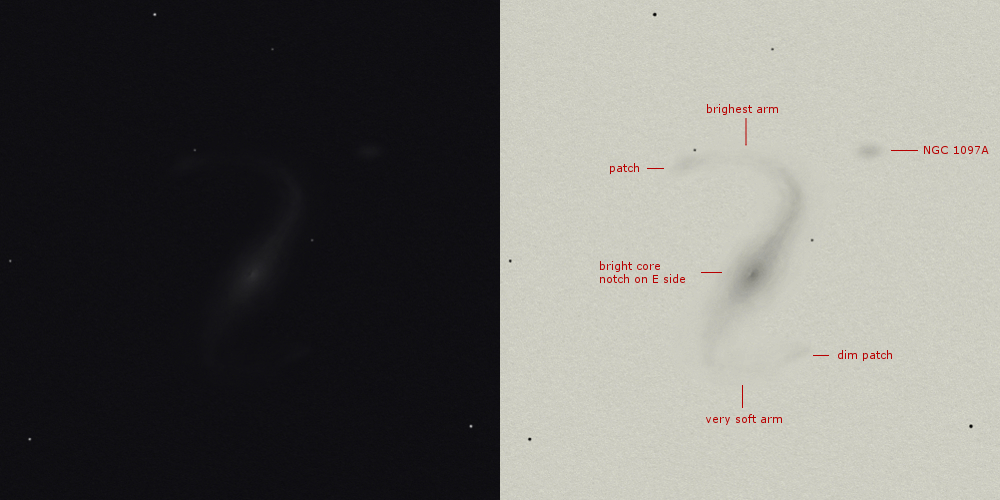
This is a large barred spiral and also very bright. The bar is easily seen and on both sides of the galaxy a spiral arm is observed. The one on the N side is brightest and clearly shows a wide curl. The patch on the tip is brighter and ends near a dim star. The S arm is not as bright and is closer to the galaxy’s body. Also here a patch of nebulosity is seen on the tip. The core is bright, oval shaped and a notch is suspected on the E side. The companion is there like an exclamation mark but is not showing additional detail. These two galaxies together provide for a very nice sight!
Arp 78 – NGC 772, NGC 770 and companions
NGC 770: mag 13.9, size 1.2′ x 0.8′
NGC 772: mag 10.3, size 7.3′ x 4.3′
Challenge: Asymmetric arms and E lobe of 772 (N)

Nice and bright couple. NGC 772 is large, oval shaped with a distinct core area. near the edge of the soft glow in the SE a somewhat brighter part of the spiral structure is visible. North of the core is a dark intrusion which gives the impression of a spiral arm moving out. This arm however is not seen. nearby NGC 770 is small, nearly round and has some brightening towards the center. Other companions and the E lobe are not seen.
Large, high surface-brightness companions on arms (Arps 79 – 91)
Arp 79 – NGC 5490C
mag 14.7, size 1.1′ x 0.8′
Challenge: The two arms and the companion (large lump to S of nucleus) (N)
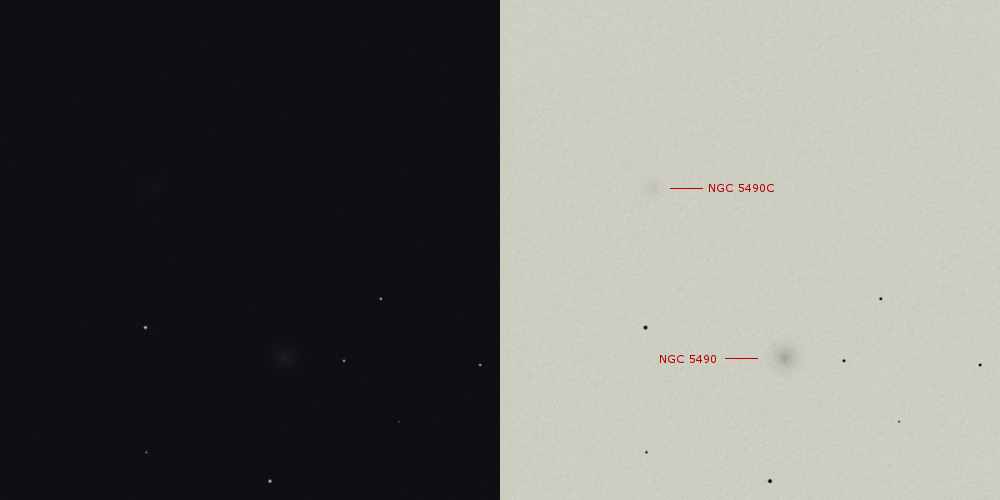
Really close to Arp 117 galaxie IC 982 and IC 983 and to galaxy NGC 5490 (which is much brighter). NGC 5490C is dim and can only seen with AV as a round patch without any further details.
Arp 80 – NGC 2633
mag 12.2, size 2.5′ x 1.6′
Challenge: Lumps on arm to N (N)
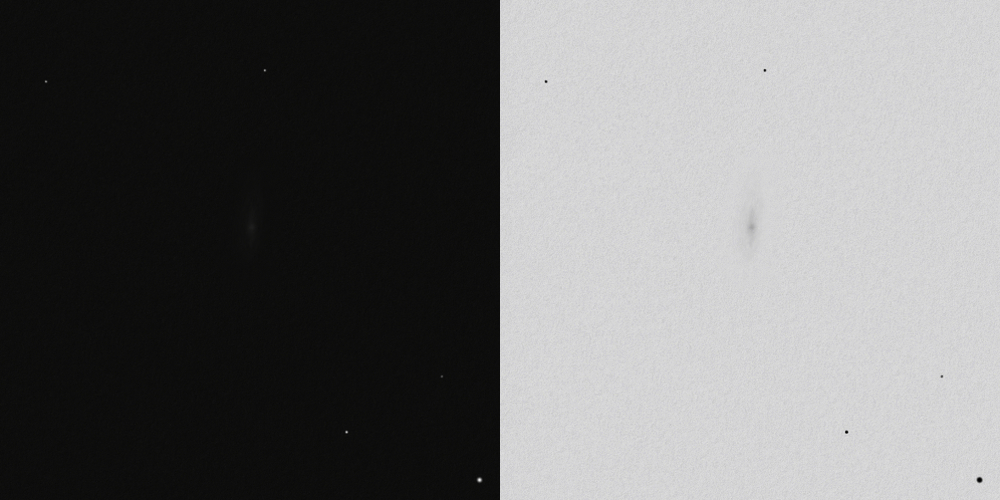
Bright galaxy with a stellar core. Easily seen with DV. From the core there are elongations visible in both directions. To the north it appears a bit longer, which gives the impression of an off center core. The W side is a bit sharper edged.
Arp 81 – NGC 6621 and NGC 6622
NGC 6621: mag 13.6, size 2.1′ x 0.8′
NGC 6622: mag 16.0, size 0.5′ x 0.4′
Challenge: Shape of the NE loop (N)

Compact pair with some nebulosity in between. Brightest and largest is NGC 6621 in the N, it can just be seen with DV. NGC 6622 to the S is smaller and quite dim, but it can be seen without much effort. On the SW there appears to be a notch in the nebulosity. The loop was not seen.
Arp 82 – NGC 2535 and NGC 2536
NGC 2535: mag 13.3, size 3.3′ x 2.8′
NGC 2536: mag 14.6, size 1.0′ x 1.5′
Challenge: Plumes of companion and full extent of the main galaxy arms (N)
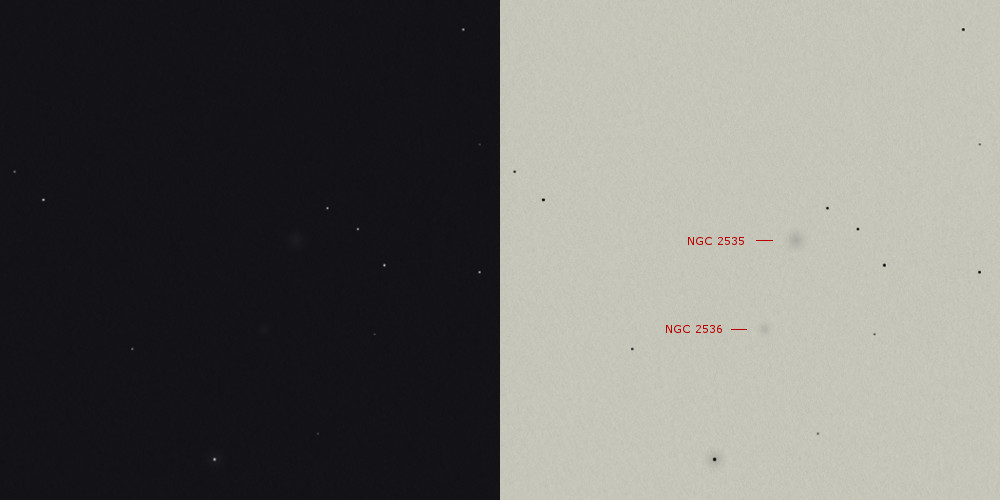
Two round galaxies seen easily in the same field, but widely separated. NGC 2535 can be seen with DV, while NGC 2536 is a bit smaller and dimmer and AV is needed. No additional details were observed, despite the brightness.
Arp 83 – NGC 3799 and NGC 3800
NGC 3799: mag 14.7, size 0.8′ x 0.5′
NGC 3800: mag 13.5, size 2.0′ 0.6′
Challenge: Spiral structure in both galaxies (N)
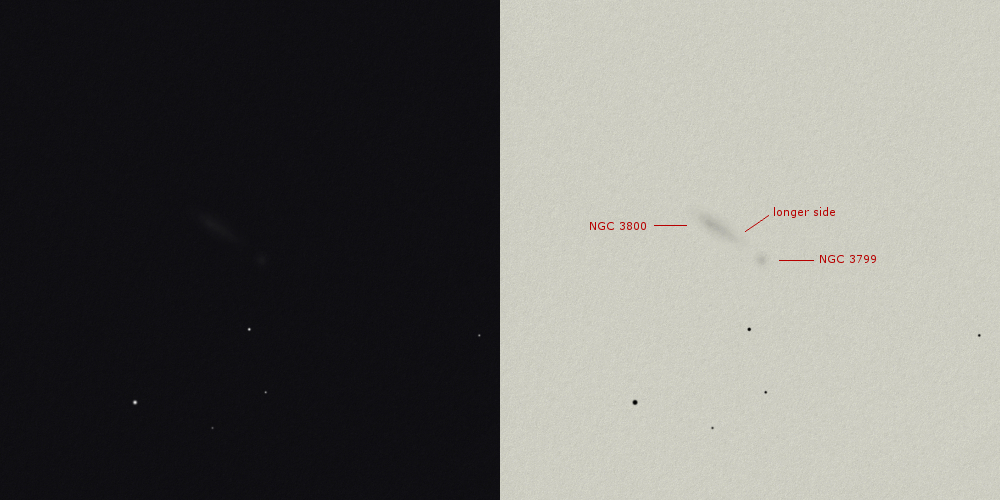
Two galaxies seen separated from each other, but close. NGC 3799 is small, round and can just be seen with DV. NGC 3800 is a bit brighter with a core zone visible and seems to stretch a bit further on the SW side.
Arp 84 – NGC 5394 and NGC 5395
NGC 5394: mag 12.1, size 2.9′ x 1.5′
NGC 5395: mag 11.4, size 2.9′ x 1.6′
MAPS-NGP: mag 18.3, size 0.35′ x 0.1′
Challenge: 5395 asymmetrical arms and rich texture; 5394 wide spirals and arcs around nucleus; and the MAPS galaxy (P)
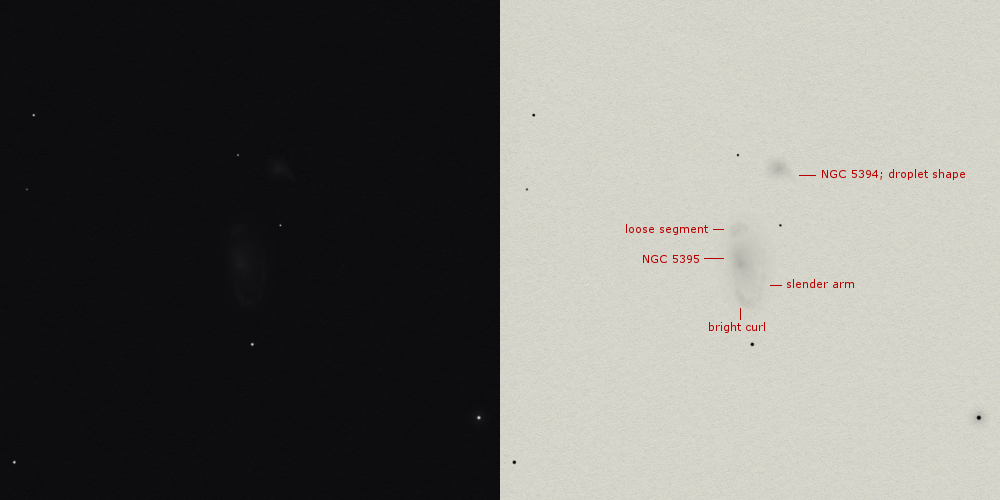
NGC 5395 is the largest and brightest part, with on top of it a loose segment and at the underside a curl that fades out to the N as a dim line. Above and completely separate is NGC 5394 and this is a pretty bright patch in a droplet shape. Nice pair!
Arp 85 – M51 (NGC 5194) and NGC 5195
M51: mag 8.4, size 10.3′ x 8.1′
NGC 5195: mag 10.5, size 5.8′ x 4.6′
Challenge: Spiral arms in 5194; The arm connecting NGC 5194 and NGC 5195; The two fainter wisps running NW and SE of NGC 5195; Absorption structures in each arm of 5194 (P)

The “Whirlpool Galaxy“, probably the most famous of all Arps and it provides a fantastic view. The (face-on) spiral structure is seen immediately with ease. The E and brightest inner arm appears “hooked”. The N and S outer arms are dim and only seen with AV. The W inner arm is clearly specked with a multitude of H II knots. A detached section of the core is visible on the NE side.
NGC 5195 shows a brighter core area than that of M51. The companion galaxy is pear-shaped and has a dark intrusion on the W side. Its bar is pointing to the centre of M51. Even though an arm is clearly stretching in the direction of M51’s outer N arm, the famous “bridge” is not seen.
Arp 86 – NGC 7752 and NGC 7753
NGC 7752: mag 14.3, size 0.8′ x 0.5′
NGC 7753: mag 12.0, size 3.3′ x 2.1′
Challenge: Arm between galaxies (N)
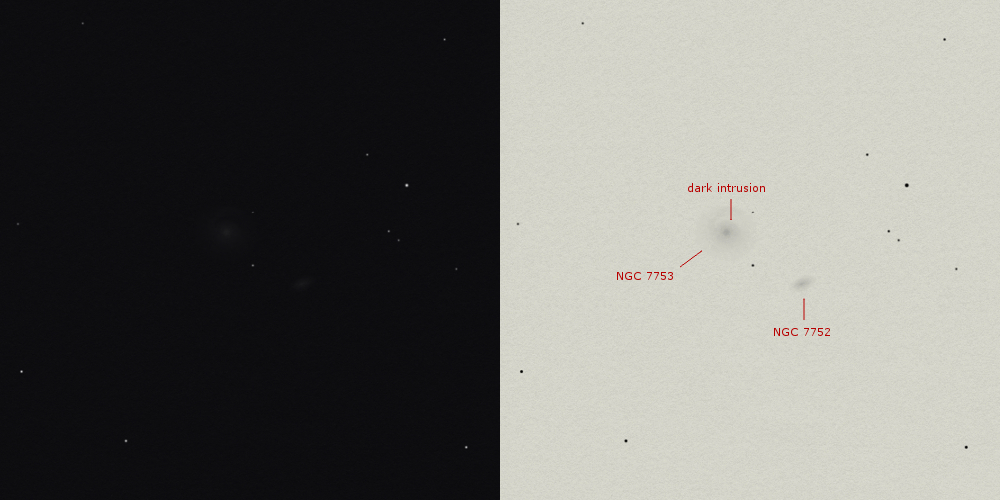
Here’s a nice pair. NGC 7753 is the mother galaxy and is (almost) face-on with a bright and soft core and a large surrounding glow. Somewhat further to the SW NGC 7752 can be seen with DV. It’s small, compact and equally bright as the core of 7753. It’s not round, but slightly oval shaped. The connection between the two galaxies can’t be seen, but a dark intrusion on the N of 7753’s core betrays a spiral arm departing towards a mag 15.6 star.
Arp 87 – NGC 3808
NGC 3808A: mag 13.4, size 1.7′ x 0.9′
NGC 3808B: mag 14.5, size 0.5′ x 0.2′
Challenge: Wrapped arm and anonymous companion (N)
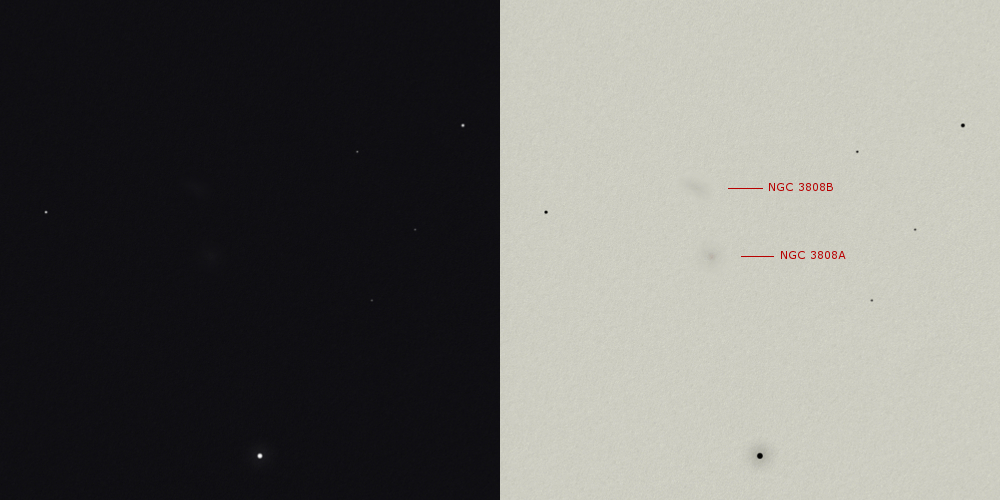
The two galaxies NGC 3808A and 3808B can be seen well with AV and are clearly separated. no connection or spiral structure is seen. 3808A is largest and round. 3808B is smaller, but the stretched shape is noticeable.
Arp 89 – NGC 2648 and MCG+2-22-6
NGC 2648: mag 12.7, size 3.3′ x 1.1′
MCG+2-22-6: mag 15.4, size 0.9′ x 0.4′
Challenge: Faint spirals in 2648 and easter wisp of companion (N)
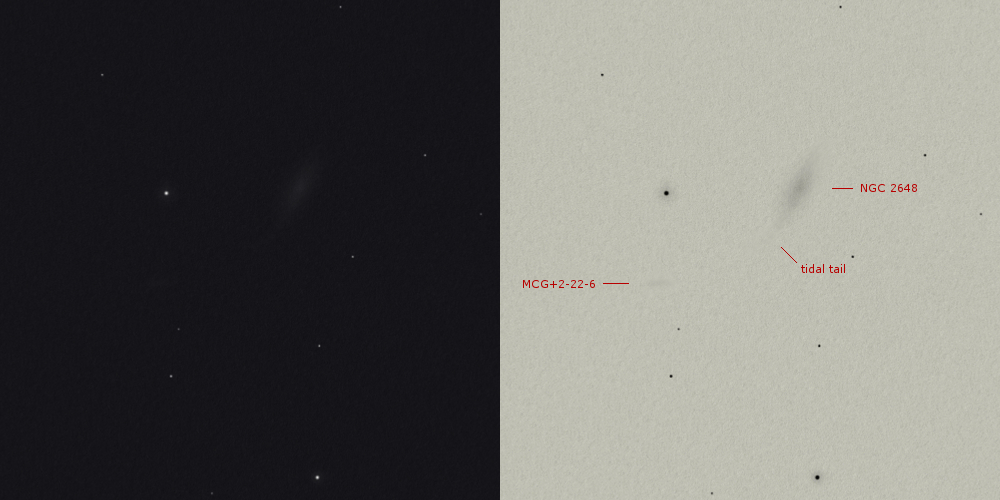
NGC 2648 is large and bright, clearly elongated and the start of a very faint tail can be seen running towards the companion, which in its turn is dim and can only be seen with AV. The elongation is noted, however. Very nice view as the sky conditions permitted the visibility of the tail.
Arp 90 – NGC 5929 and NGC 5930
NGC 5929: mag 14.1, size 1.0′ x 0.9′
NGC 5930: mag 13.6, size 1.7′ x 0.9′
Challenge: Trace brightest arm to companion (N)
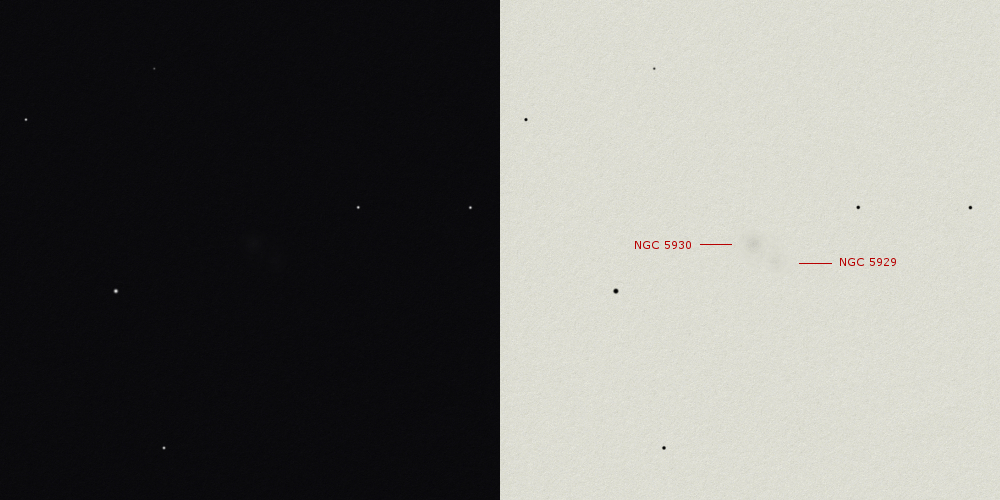
NGC 5929 and NGC 5930 are almost in touch, but easily separated at high power, even though they appear to share their nebulosity. NGC 5930 is the largest and brightest of the two and can be seen directly. NGC 5929 is somewhat dimmer and smaller, but easily seen with AV. Both galaxies appear round and the connecting “bridge” is not seen.
Arp 91 – NGC 5953 and NGC 5954
NGC 5953: mag 13.3, size 1.6′ x 1.3′
NGC 5954: mag 13.7, size 1.3′ x 0.6′
Challenge: Arm connecting galaxies, absorption in both (P)

Very bright pair, close to each other but not touching. 5953 is round and the core zone is clearly visible. 5954 is a bit dimmer and oval shaped, some central brightening can be seen here as well. From this galaxy, an arm runs towards 5953. A dim star nearly touches 5953.
Elliptical galaxy companions on arms (Arps 92 – 101)
Arp 92 – NGC 7603 and NGC 7603B
mag 13.2, size 1.6′ x 1.0′
Challenge: Connection and emission line objects (N)
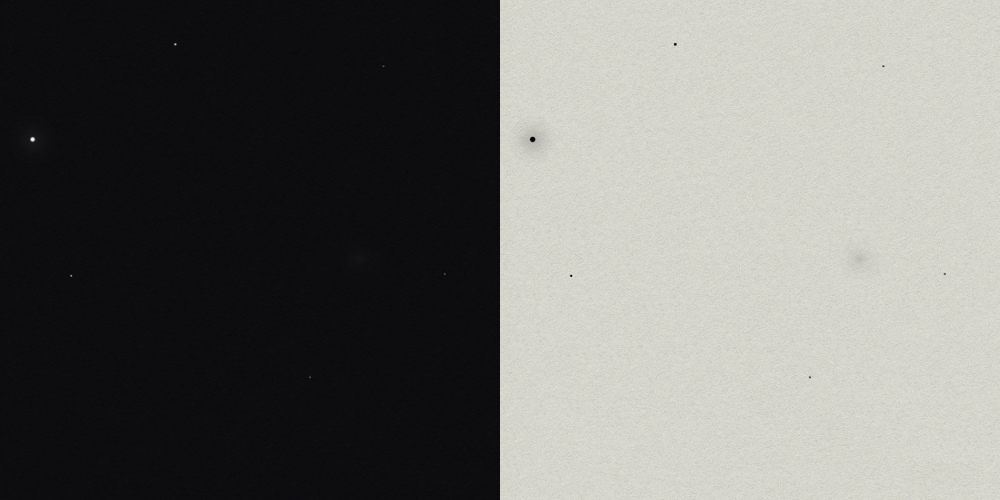
For some reason I needed a detailed map for this one because I could not find it the first time (even though it’s located near a m10 star). But now that it’s found, it is seen with ease as bright and perfectly round. The core area is definitely brighter. I expected to be able to see the companion, but it was not even suspected. I think with a slightly bigger telescope or better sky conditions, this one should be in reach.
Arp 93 – NGC 7284 and NGC 7285
NGC 7284: mag 12.9, size 2.1′ x 1.8′
NGC 7285: mag 12.9, size 2.3′ x 1.3′
Challenge: Long, wide plume exiting to N and swinging all the way around to the S (N)

These two are moderately bright and can be seen separated with ease. NGC 7284 is the brightest of the two and appears as a round dot. NGC 7285 is a bit more smeared out and slightly less bright. The two are covered in a cloud of nebulosity.
Arp 94 – NGC 3226 and NGC 3227
NGC 3226: mag 12.3, size 3.2′ x 2.8′
NGC 3227: mag 11.1, size 5.4′ x 3.7′
Challenge: Spiral arms of NGC 3227, faint wisps NE and SW of 3227, NE plume off NGC 3226 (N)
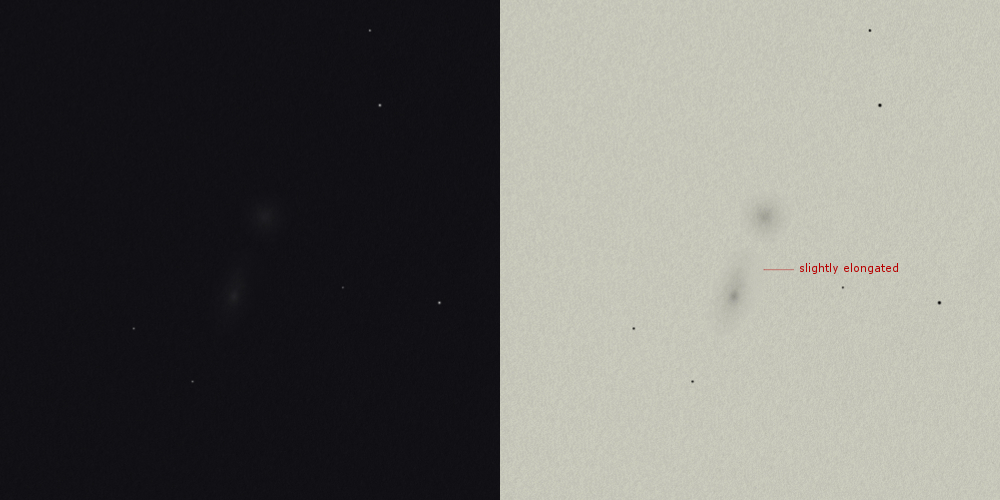
Two very striking galaxies, easily visible. NGC 3226 is brighter and with a bright, non-stellar core. The galaxy appears round. NGC 3227 does have a stellar core which is moderately bright, around it is a large oval glow with a slightly bent shape.
Arp 95 – IC 4461 and IC 4462
IC 4461: mag 15.2, size 0.8′ x 0.6′
IC 4462: mag 16, size 0.3′
MCG+5-34-76: mag 15.3, size 0.5′ x 0.2′
Challenge: Tiny companion inside IC 4461 arm, small companions W and NW of IC 4461, and irregular knots in MCG+5-34-76 (N)
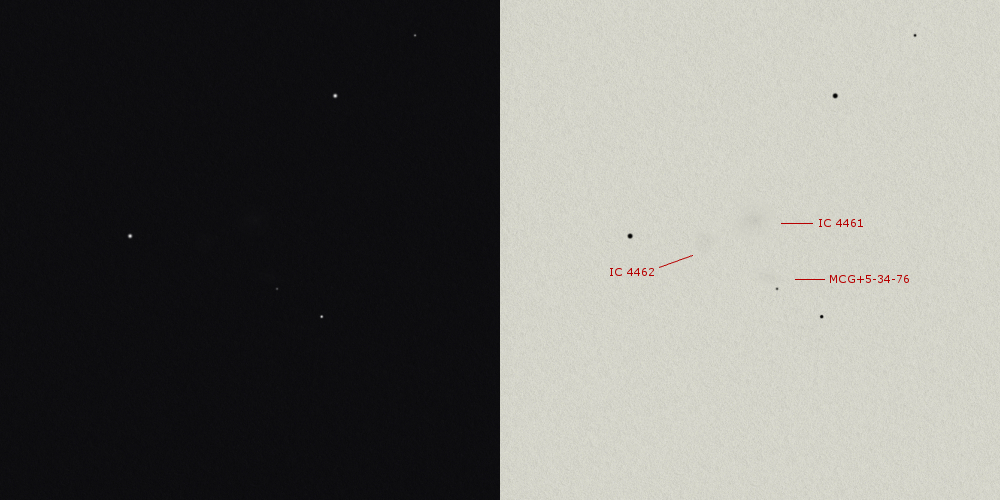
Three galaxies close to each other, with a difference in brightness. All three are hard to see and without any detail. IC 4461 is the brightest and largest ands seen with AV. IC 4462 is the second brightest, somewhat smaller and hard to see with AV. MCG+5-34-76 is very tough, but is seen blinking now and then against a dim star. The shape is a bit elongated.
Arp 96 – MCG+14-4-10 & 11
MCG+14-4-10: mag 15.5, size 0.9′ x 0.8′
MCG+14-4-11: mag 14.6, size 0.9′ x 0.9′
Challenge: Extended arms of MCG+14-4-10 (N)
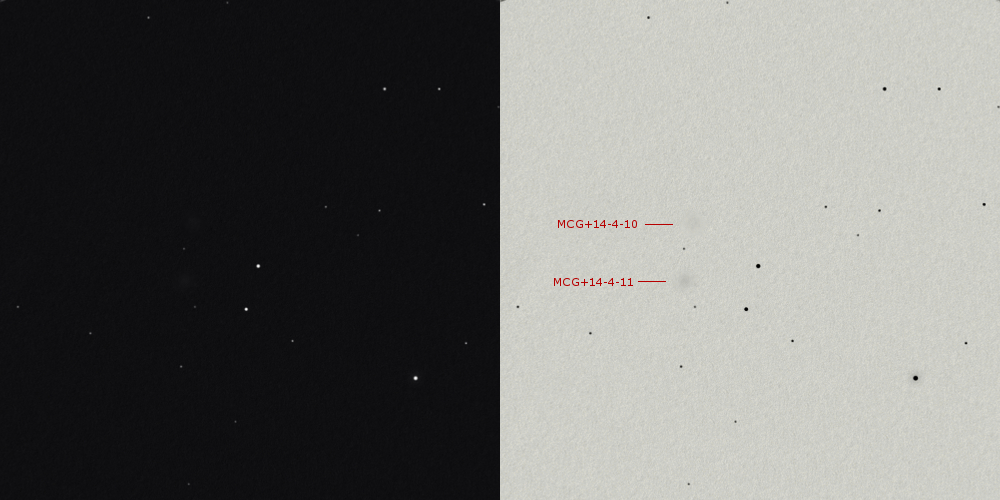
Very faint couple, both only seen with AV as small smudges of light, of which MCG+14-4-10 with difficulty. A dim m15.5 star can be seen in between them. No arms or spiral structure seen.
Arp 97 – UGC 7805A, MCG+5-29-10 and -11
MCG+5-29-10: mag 15.7, size 0.4′ x 0.3′
MCG+5-29-11: mag 15.6, size 2.6′ x 1.0′
MCG+5-29-12: mag 15.5, size 0.3′ x 0.2′
Challenge: Two brighter arms N and S from -11 and the very faint arm running E (N)
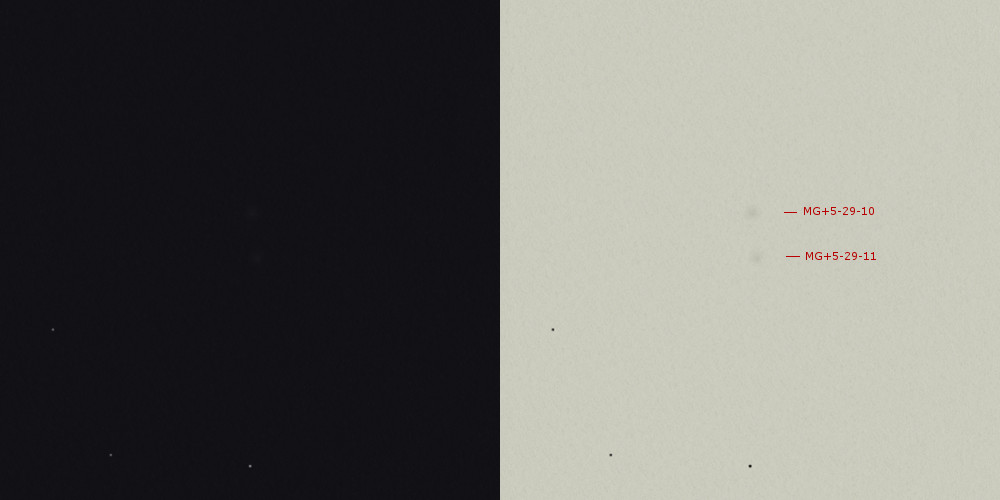
Two galaxies, separated by a large space. Influence on each other is not observable, only seen as two very small and round galaxies. MCG +05-29-010 is the brighter one and seen with difficulty with AV. MCG +05-29-011 is very tought to see with AV. MCG +05-29-012 was not seen at all.
Arp 98 – UGC 1095 and MCG+5-4-66
UGC 1095: mag 15.0, size 1.4′ x 0.5′
MCG+5-4-66: mag 16.0, size 0.3′
Challenge: The differing arms of MCG+5-4-66 (N)
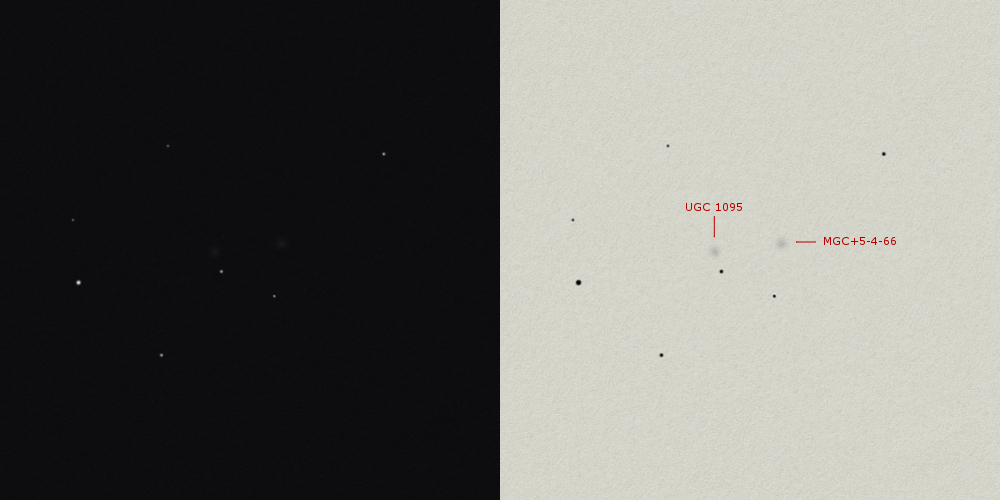
This Arp duo is on the verge of visibility. Both are very small, round and only intermittently seen with AV. MCG+5-4-66 forms a triangle with two mag 14 stars and is just a tad easier to spot than UGC 1095. No details were seen. Very hard observation.
Arp 99 – NGC 7550 group, Hickson 93
NGC 7547: mag 14.7, size 1.1′ x 0.5′
NGC 7549: mag 13.7, size 2.8′ x 0.7′
NGC 7550: mag 12.2, size 1.4′ x 1.2′
Challenge: Connection not seen, but note difference in arm toward and away from E galaxy. Note also material between W spiral and E galaxy. (N)

Arp 99 is a part of Hickson 93 but counts only three galaxies. NGC 7550 is the brightest member of the group and also the largest. Appears perfectly round with a bit brighter core area. NGC 7549 is a pretty large and dim stain and is slightly oval. It points just past NGC 7550. NGC 7547 is the smallest and dimmest one. It’s clearly stretched (2:1) and it too points just past NGC 7550. The light is evenly distributed on the surface. The three galaxies form a nice view and are easy to see. Hickson members NGC 7553 and NGC 7558 were not observed during this session.
Arp 100 – IC 18 and IC 19
IC 18: mag 15.0, size 1.1′ x 0.6′
IC 19: mag 15.0, size 0.6′ x 0.4′
Challenge: N and S tails of IC 18 (N)
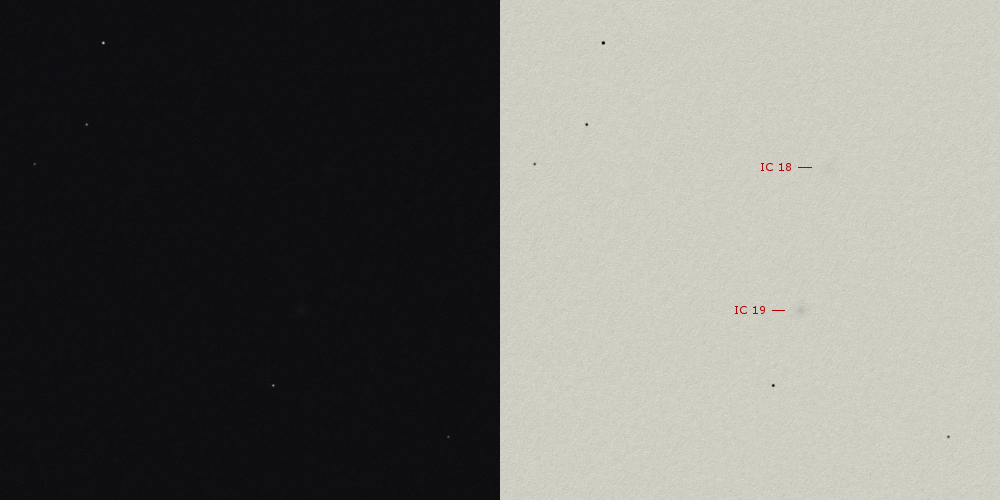
These two galaxies are almost stellar (like stars out of focus). Very tiny. IC 19 is the one best visible (with AV), but shows no details. IC 18 is quite dim and can only be seen half of the time with AV. Two very bright stars just outside the field of view hinder the observation.
Arp 101 – UGC 10164 and UGC 1069
UGC 10164: mag 14.7, size 1.1′ x 0.9′
UGC 10169: mag 14.8, size 2.1′ x 0.4′
Challenge: Tail to NE of UGC 10169 and faint bridge between UGC 10169 and 10164 (N)
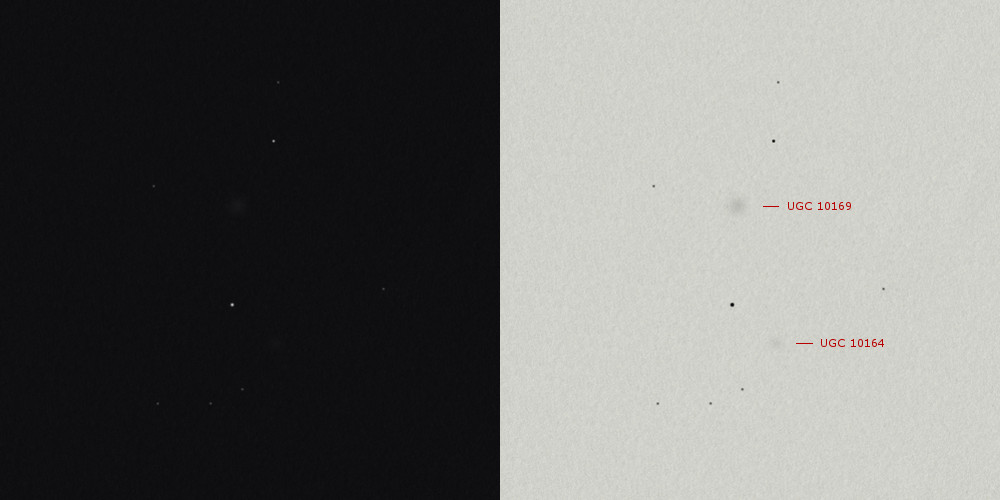
Both galaxies seen with a bright star in between. Both are round and quite small, UGC 10169 is definitely brighter and seen with AV with ease. UGC 10164 requires some more effort. No tail observed.
Elliptical and Elliptical-like Galaxies
Connected to spirals (Arps 102 – 108)
Arp 102 – UGC 10814 and companions
UGC 10814: mag 14.9, size 0.9′ x 0.6′
MCG+8-31-41: mag 15.1, size 0.9′ x 0.7′
MCG+8-31-42: mag 17, size 0.6′ x 0.4′
Challenge: Faint bridge between the galaxies (N)
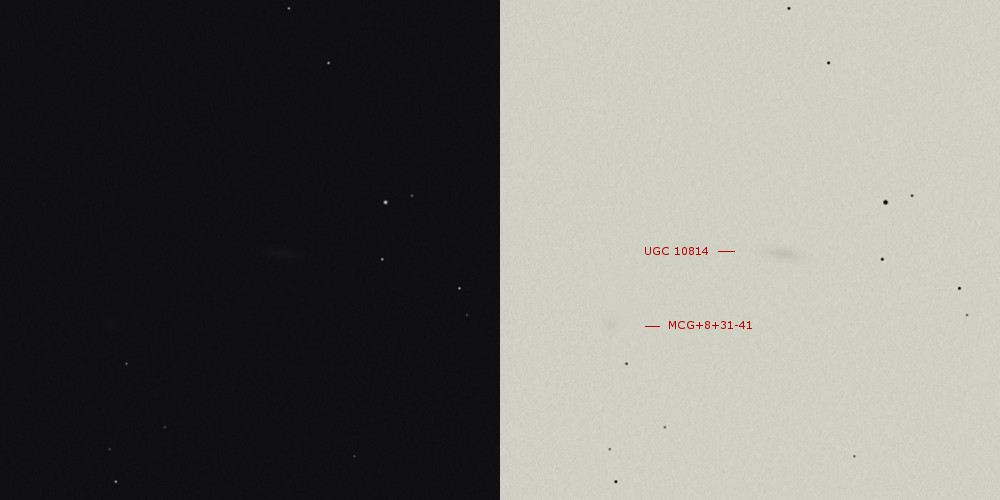
UGC 10814 is well visible with AV and has a needle shape. Length and direction can be confirmed. The companion on the arm (MCG +08-31-042) is invisible at m17 unfortunately, as is the tail. A little further, MCG +08-31-041 is seen as round and is a bit more difficult.
Arp 103 – MCG+3-31-3, Zwicky’s Triplet
MCG+3-31-3: mag 16, size 0.8′ x 0.7′
MCG+3-31-3A: mag 15.7, size 0.4′ x 0.3′
PGC 59062: mag 15.2, size 0.1′
Challenge: Faint filament from S galaxies (N)

Doing the starhop I come accross UGC 10586 and NGC 6241 and both are clearly visible. Arriving at Zwicky’s Triplet, three galaxies should be visible, but I only see two. MCG +08-31-003 is seen with confidence as a pretty large cloud, even with DV. Attached to it should be PGC 59062, but I don’t see it no matter what I try. A bit farther N, hugging a bright star, MCG +08-31-003A is seen with AV.
Arp 104 – NGC 5216 and NGC 5218
NGC 5216: mag 13.6, size 2.4′ x 1.8′
NGC 5218: mag 12.3, size 2.9′ x 1.6′
Challenge: Wisps E and W of 5218, SW of 5218 and connection (N)

Known as Keenan’s system. A bit of a deception. NGC 5218 is largest, somewhat oval and with a stretched core. NGC 5216 is round and with a brigher core than NGC 5218. The connection between the two galaxies is not observed.
Arp 105 – NGC 3561 and NGC 3561A group
NGC 3561: mag 14.7, size 0.9′ x 0.7′
NGC 3561A: mag 14.4, size 0.7′ x 0.6′
Ambartsumian’s Knot: mag 18, size 0.1′
Challenge: VV 237f, 3561A arms, and Ambartsumian’s Knot (N)

Part of AGC 1185, but focus was on the Arp field. Because of low position in the sky and mediocre seeing conditions, not much was seen of the group unfortunately. NGC 3561 was seen with AV with ease, round. Close by, NGC 3561A is much more difficult (despite its higher brightness…) and only seen intermittendly. To the E, MCG+5-27-15 was spotted too with difficulty. This whole galaxy cluster should be revisited with a larger telescope and under better conditions.
Arp 106 – NGC 4211, VV 199
NGC 4211 (VV 199a): mag 14.4, size 1.0′
NGC 4211B (VV 199b): mag 15.5, size 1.4′ x 0.3′
Challenge: S tail of VV 199b (N)
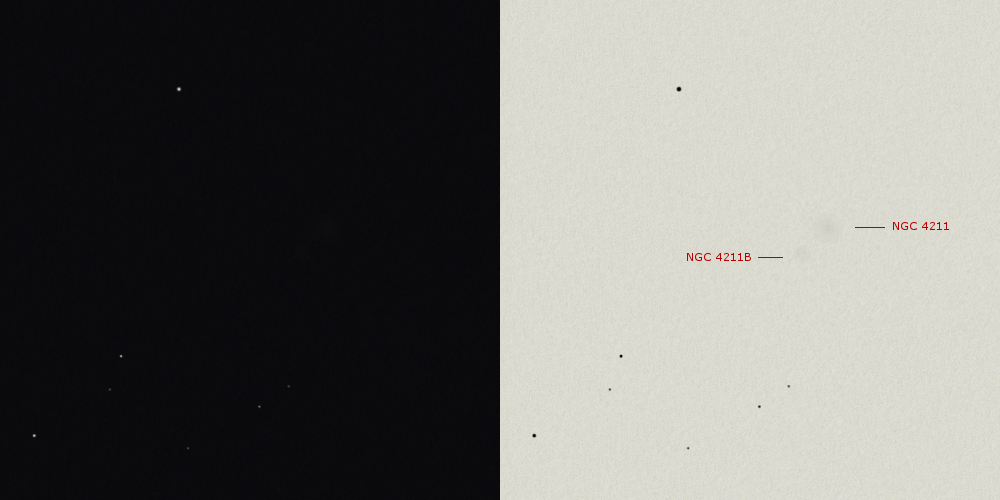
NGC 4211 (VV 199a) is small and dim (mostly seen with AV). The shape is round and the core shows some more brightness. The companion NGC 4211B (VV 199b) is very dim and can’t be seen the whole time but is rather seen blinking up from time to time as a small and round smear of light. The two are not in contact and no further details are seen.
Arp 107 – UGC 5984: MCG+5-26-24 and -25
MCG+5-26-24: mag 14.6, size 1.9′ x 1.2′
MCG+5-26-25: mag 14.6, size 1.0′ x 0.5′
Challenge: Long arcing arm E to S to W, and very faint double arm (N)
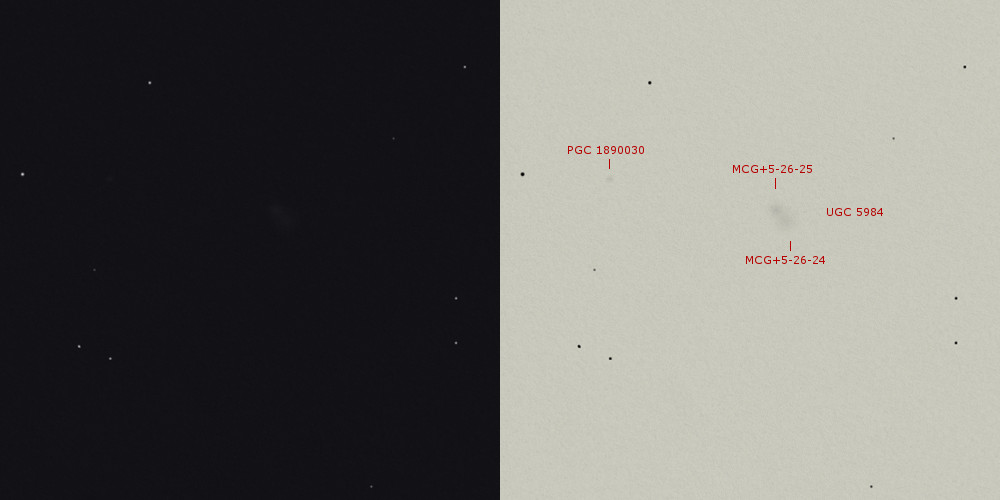
Nice Arp. The two galaxies are pretty hard to separate (with AV) and best seen as a single object. MCG+5-26-24 is a bit larger, more evenly illuminated and dimmer than MCG+5-26-25, that also shows a bit more core. No arms were detected. More remote in the field PGC 1890030 was noticed, so stellar that it was drawn as a star.
Arp 108 – MCG-4-8-17 and -18
MCG-4-8-17: mag 16.0, size 0.8′ x 0.5′
MCG-4-8-18: mag 14.0, size 1.4′ x 1.0′
Challenge: Three arms in MCG-4-8-18 (N)
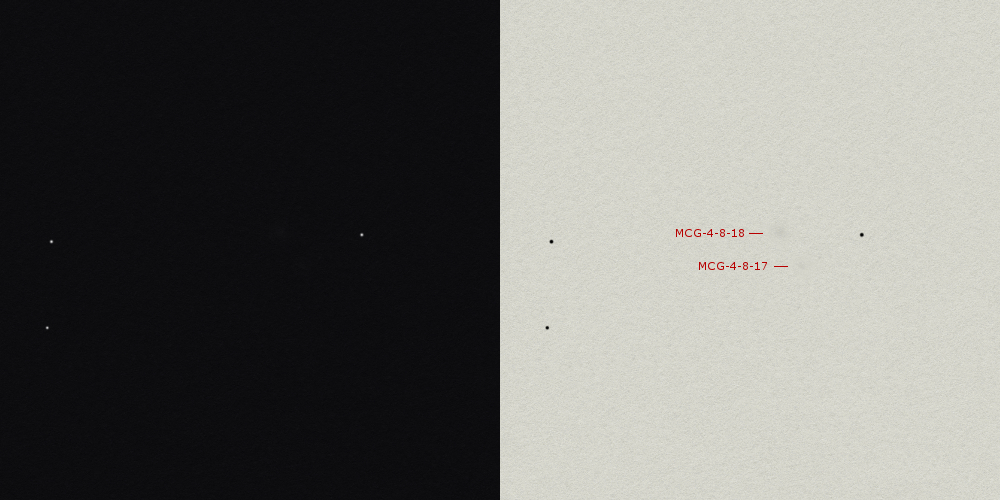
Very faint and small duo. MCG-4-8-17 is the faintest one and can only been seen blinking now and then with AV. MCG-4-8-18 can be seen a bit better, but still with effort with AV. Without any detail.
Repelling spiral arms (Arps 109 – 112)
Arp 109 – MCG+12-15-17 and -18
MCG+12-15-17: mag 15, size 1.2′ x 1.7′
MCG+12-15-18: mag 15, size 0.4′ x 0.4′
Challenge: Loop on -17 (N)

Four galaxies are seen, of which IC 1146 the only one with DV. MCG+12-15-20 is barely seen with AV and the two Arp galaxies can be seen well with AV, MCG+12-15-18 a bit brighter. Together they form an “L”. No details could be seen.
Arp 110 – MCG-3-58-11 and companion
MCG-3-58-11: mag 14.5, size 1.0′ x 0.6′
APMUKS: mag 17.3, size 0.3′ x 0.2′
Challenge: Unusual upper arm and the elliptical companion (P)
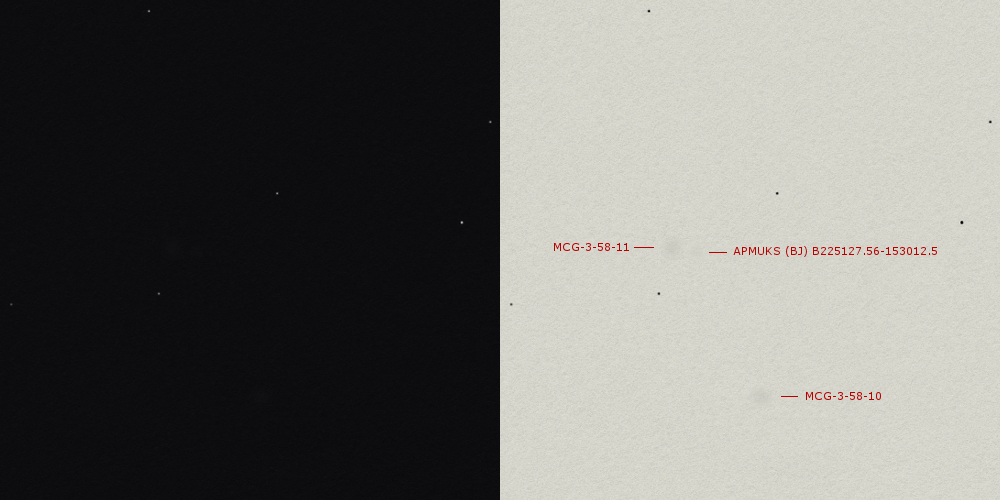
Two galaxies are seen immediately with AV: MCG-3-58-10 and -11. Both are equal in size and brightness. With effort, the companion is seen as well; very tiny and close to -11.
Arp 111 – NGC 5421 and companion
mag 13.4, size 1.6′ x 1.0′
Challenge: Elliptical loop on the bent arm (N)
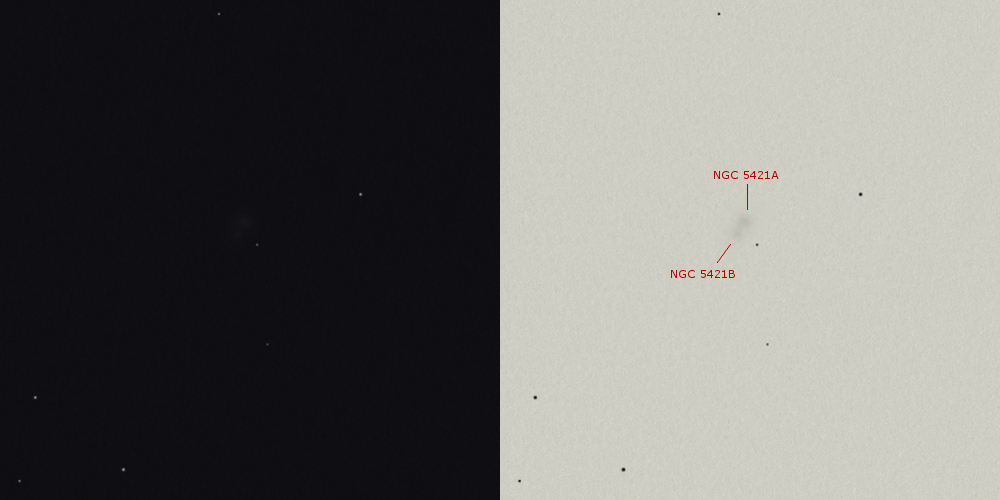
This is a very small and weak duo and it’s a challenge to split both galaxies (I did not see the elliptical loop). At 362x this is successful where NGC 5421A is the largest and brightest of the two and NGC 5421B can only be glimpsed with AV. The two reside in an oval glow and are perpendicular to a mag 15 star. The companion however can not be seen.
Arp 112 – NGC 7805 and NGC 7806
NGC 7805: mag 13.3, size 1.2′ x 0.9′
NGC 7806: mag 14.3, size 1.1′ x 0.8′
MGC+5-1-26: mag 16.5, size 0.6′ x 0.2′
Challenge: N arm of NGC 7806 and asymmetry of MCG+5-1-26 (N)
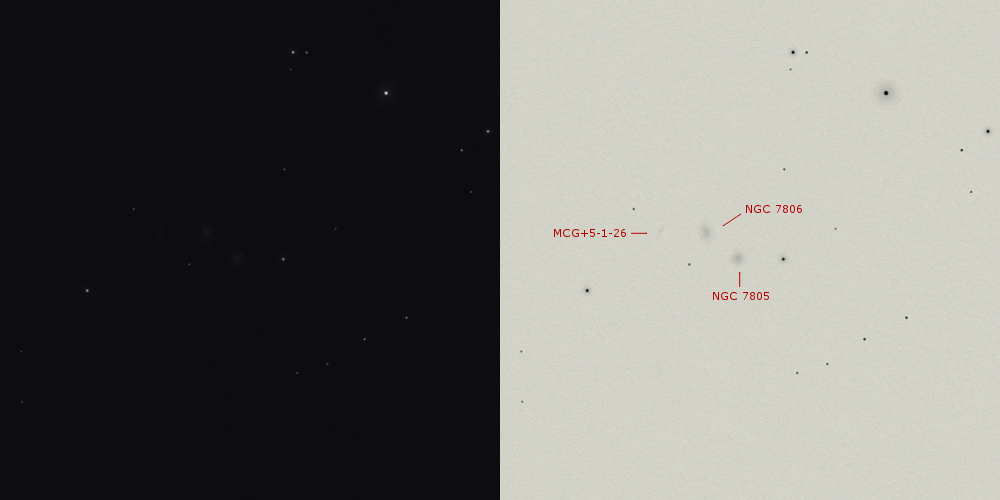
NGC 7805 and NGC 7806 can readily be seen with DV. Both are rather small and appear round, although on close inspection NGC 7806 seems a bit stretched. Surprisingly, the neighbour galaxy MCG+05-1-26 can be glimpsed too with much effort. It’s extremely faint and the light of the small streak of light pulsates in and out with AV.
Close to and perturbing spirals (Arps 113 – 132)
Arp 113 – NGC 67 – 72
NGC 67: mag 15.2, size 1.0′ x 0.7′
NGC 68: mag 14.5, size 1.2 x 1.1′
NGC 69: mag 15.8, size 0.9′ x 0.8′
NGC 70: mag 14.5, size 2.0′ x 1.6′
NGC 71: mag 14.8, size 1.5′ x 1.2′
NGC 72: mag 13.4, size 1.1′ x 1.0′
Challenge: Spiral structure in NGC 70 and NGC 72 (N)
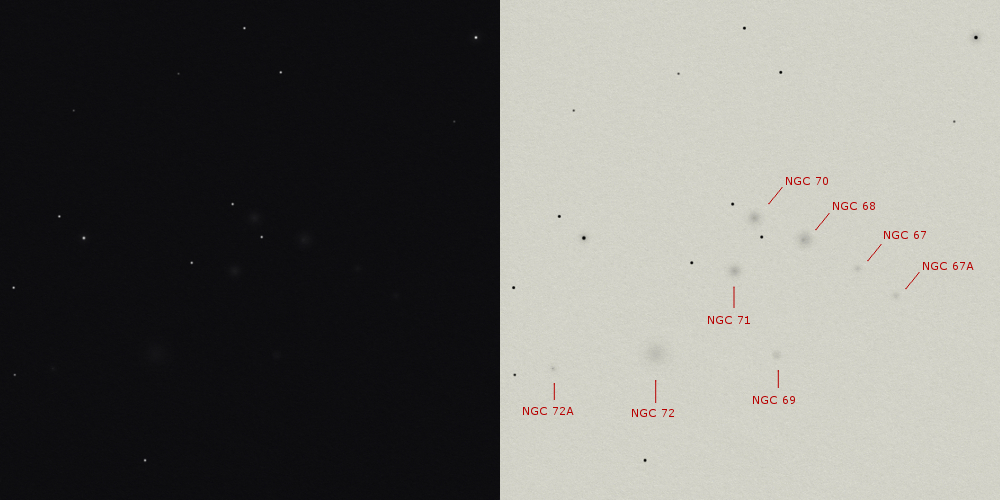
A small area rich with galaxies. At low power a combined smudge of light can be seen, but at high power all galaxies can be separated. The brightest three are in the center and form a triangle between three stars. NGC 68, NGC 70 and NGC 71 are well visible with AV and appear similar in size, shape and brightness. At the SE of this group is a dimmer galaxy with a large surrounding glow. This is NGC 72 and is still pretty obvious with AV. E of it is NGC 72A, this one is stellar and can sometimes be seen with AV. W of it is another dim specimen; NGC 69. This one time can only be seen half of the time with AV. Lastly, there are two more difficult galaxies in line with NGC 70 and NGC 68. These are NGC 67 and NGC 67A. These are almost stellar and could only be discovered by use of a detailed chart. No additional details were seen in these eight galaxies in a single field.
Arp 114 – NGC 2300 and NGC 2276
NGC 2276: mag 11.4, size 2.8′ x 2.6′
NGC 2300: mag 12.1, size 2.8′ x 2.0′
Challenge: Mottling and tubular arm in NGC 2276 (P)
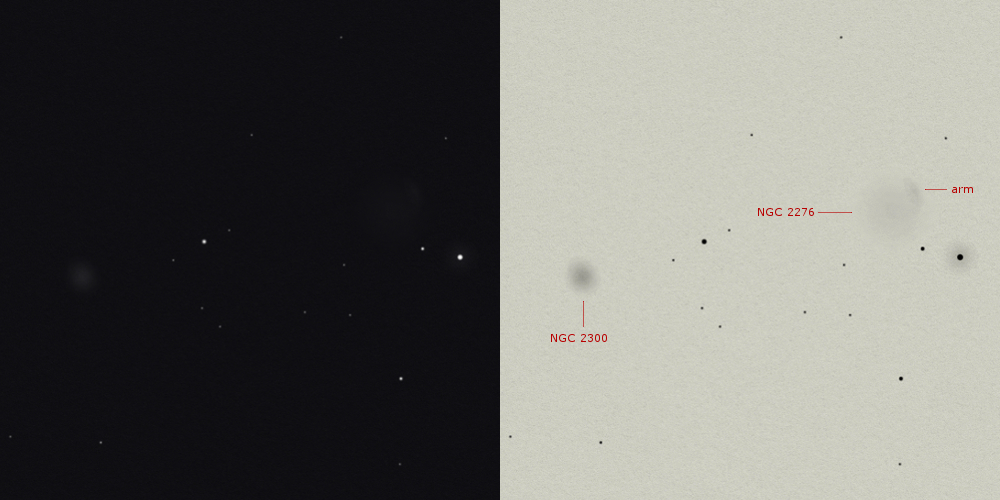
NGC 2276 and NGC 2300 form a very nice and contrasting pair. The difference between the two galaxies is big; NGC 2300 is bright, slightly oval and with a clear core area. NGC 2276 (Arp 25) is large and very soft, without a visual core area. With effort, a slightly lighter patch can be seen on the W side. This is the heavy arm.
Arp 115 – UGC 6678 and companions
PGC 36379: mag 15.2, size 0.5′
UGC 6678: mag 15.6, size 0.9′ x 0.5′
Compact galaxy: mag 15.1, size 0.15′
Challenge: Arm in 6678, and object’s nonstellar quality (N)
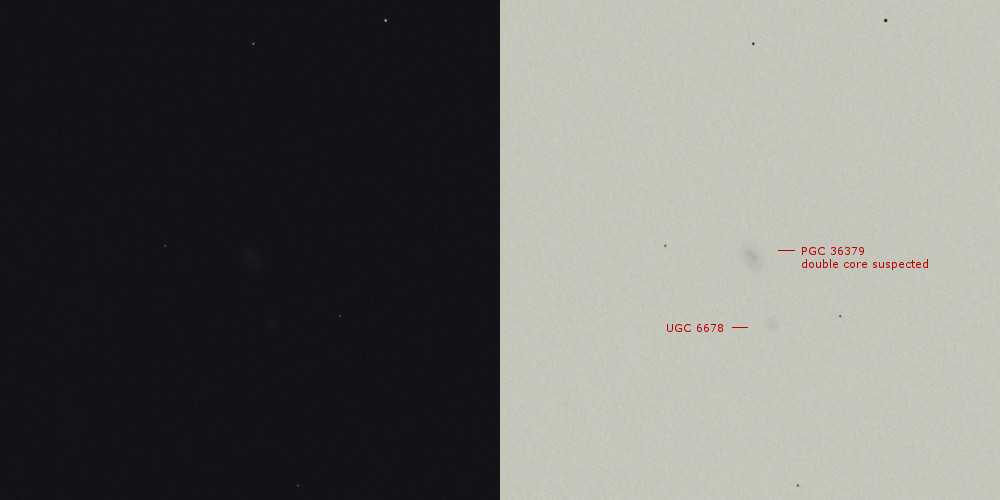
Consisting of widely separated galaxies and two in contact. UGC 6678 is very dim and it needs some effort to see the round smear of light. PGC 36379 is brighter, slightly oval shaped and a double core is suspected. In reality the second core is a different galaxy, but it’s very hard to split the two, even at this high power.
Arp 116 – M60 (NGC 4649) and NGC 4647
M60: mag 9.8, size 7.4′ x 6.0′
NGC 4647: mag 11.9, size 2.9′ x 2.3′
Challenge: Absorption band on NGC 4647 away from M60 (N)
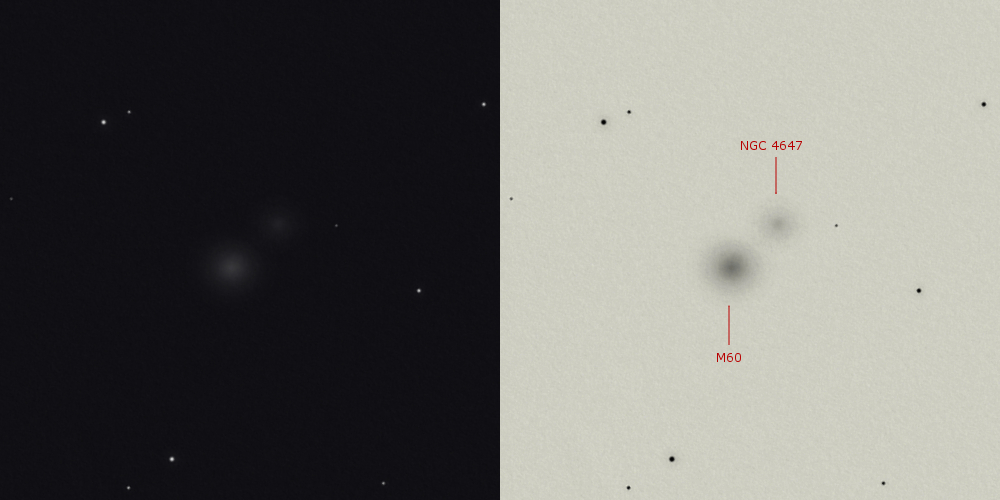
M60 is large, bright and almost perfectly round. There appears to be no visible interaction with the companion galaxy NGC 4647 although they are very close to each other (not in contact). NGC 4647 is softer than M60 and has a smaller core area.
Arp 117 – IC 982 and IC 983
IC 982: mag 14.0, size 1.3′
IC 983: mag 12.5, size 5.4′ x 4.7′
Challenge: Main ring and knots in wider arms in IC 983(N)
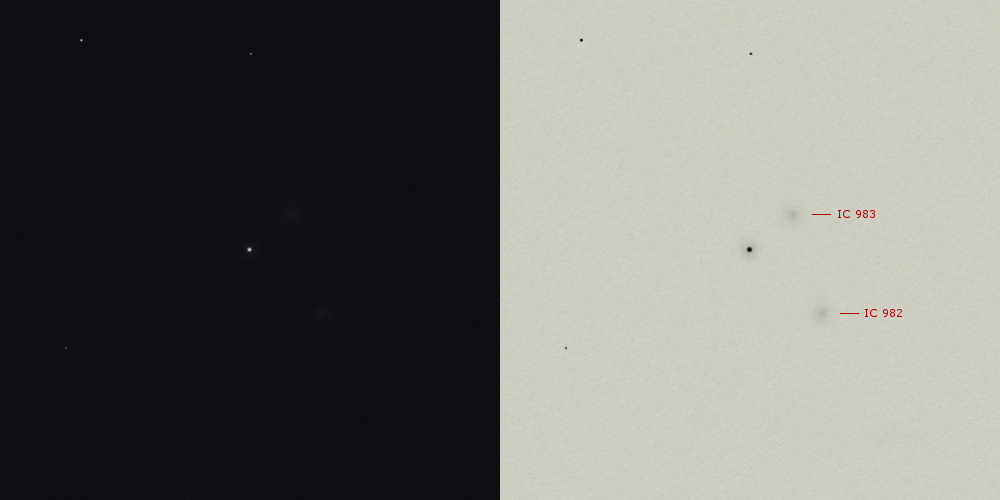
Bright pair, easily seen with DV. IC 983 is a large spiral galaxy, but only the core is visible. That is why it looks similar in size, shape and brightness as IC 982 (lenticular). The star in the center is close by and prevents a proper observation.
Arp 118 – NGC 1143 and NGC 1144
NGC 1143 (or NGC 1141): mag 13.2, size 0.9′ x 0.8′
NGC 1144 (or NGC 1143): mag 12.9, size 1.1′ x 0.7′
Challenge: Knotty loops between the galaxies (N)
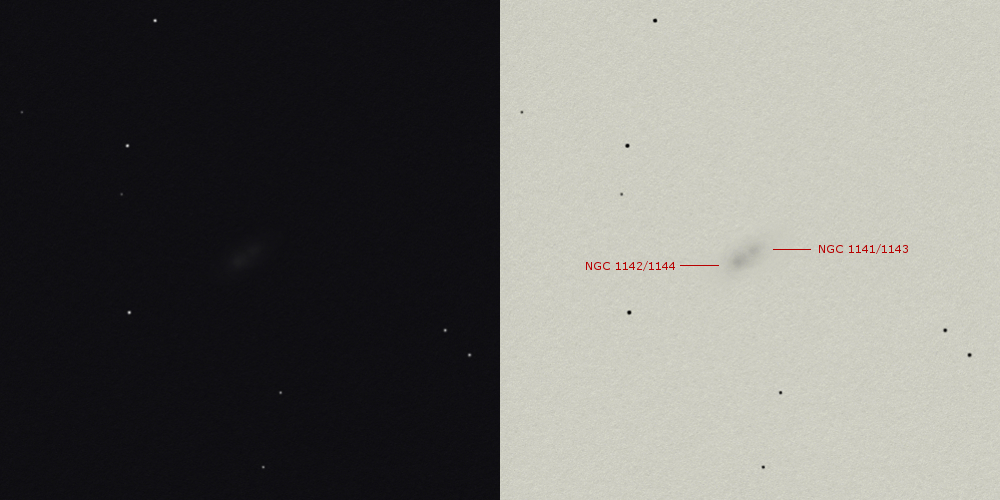
These two can be seen clearly. They are separated, but in a bed of nebulosity. NGC 1142 / 1144 is a tad brighter and both appear round.
Arp 120 – NGC 4435 and NGC 4438, Copeland’s Eyes in Markarian’s Chain
NGC 4435: mag 11.7, size 2.7′ x 2.0′
NGC 4438: mag 10.1, size 8.6′ x 3.2′
Challenge: In NGC 4438: Warped arm in a “wishbone” shape; absorption structure to the W of the nucleus; triple structure in the nucleus (N)
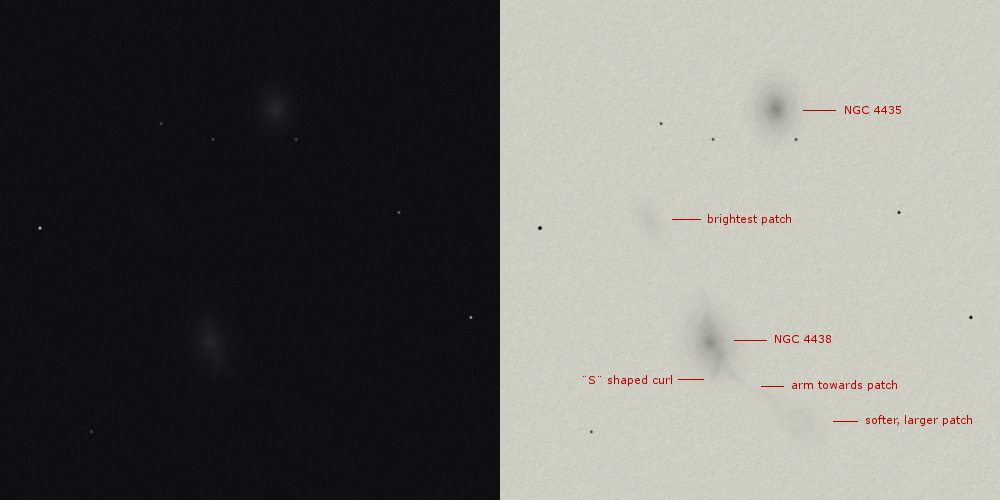
A very bright duo of galaxies within Markarian’s Chain. NGC 4435 is not very special; it’s oval shaped and with a bright (non-stellar) core. But NGC 4438 is the real showpiece. It’s a bit larger and more stretched in an “S” shape (mainly due to a curl on the S-side) and on both sides, pretty far away from the galaxy, two patches of nebulosity can be seen. From the tips of the “S” shape a tail appears to run to these patches and on the S-side this “river” can actually be seen. On the N-side the brain is trying to fill in the missing piece of light, but I need to be harsh on myself and admit that I do not actually see it there. Furthermore, a lot of dim suns are seen, often on the verge of detectibility, which adds beauty to the dramatic vista. What a wonderful couple!
Arp 121 – MCG-1-3-51 and -52
MCG-1-3-51: mag 14.5, size 2.1′ x 0.6′
MCG-1-3-52: mag 15.4, size 0.6′
Challenge: Plume to the S (N)
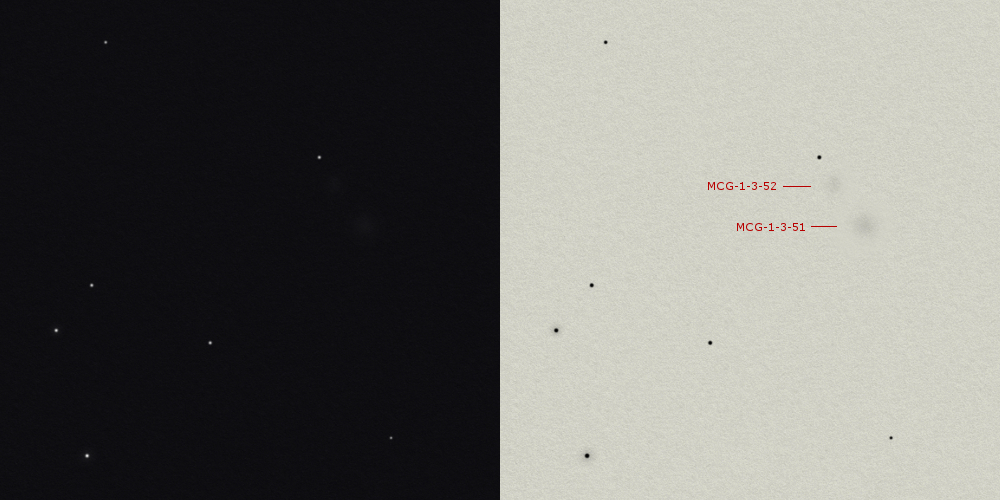
Two galaxies in line with a star. MCG-1-3-51 can be seen directly and is the largest of both. MCG-1-3-52 needs AV, but is easily seen (a bit smaller). No further details are noticed except for the trapezium of stars nearby.
Arp 122 – NGC 6040A and NGC 6040B
NGC 6040A: mag 15.1, size 1.4′ x 0.5′
NGC 6040B: mag 14.9, size 0.8′
Challenge: Full extent of NE arm of 6040A, and connection between two galaxies (N)
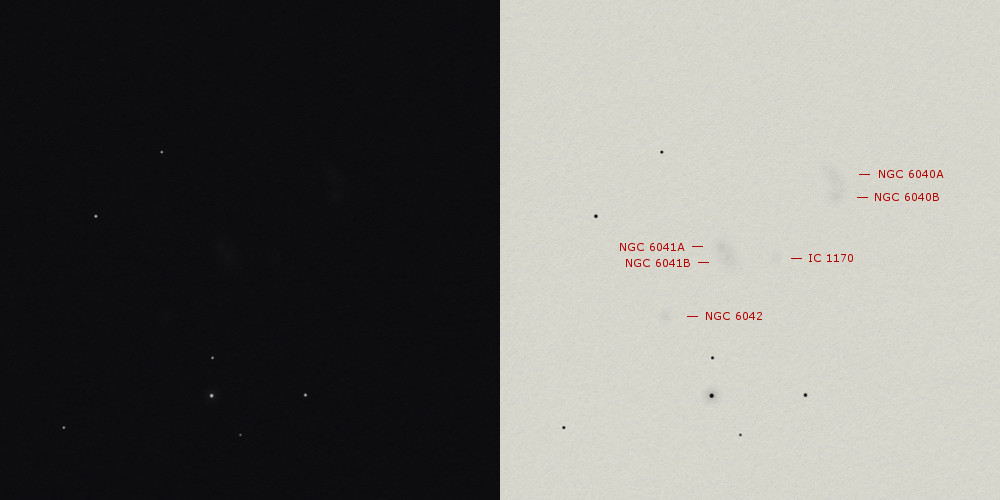
Part of the Hercules Galaxy Cluster (Abell 2151). An oval shaped cloud is seen at once, but it’s difficult to separate it into two parts. NGC 6040B is the brightest part and round. NGC 6040A is just a tiny bit dimmer and has an oval shape, touching its neighbor. All other galaxies in this field are not part of the Arp but very interesting nonetheless, with IC 1170 being the most difficult one to spot.
Arp 123 – NGC 1888 and NGC 1889
NGC 1888: mag 12.0, size 3.5′ x 1.0′
NGC 1889: mag 14.1, size 0.6′
Challenge: Faint parallel feature on opposite side from S0 galaxy and the kink in the SE end (N)
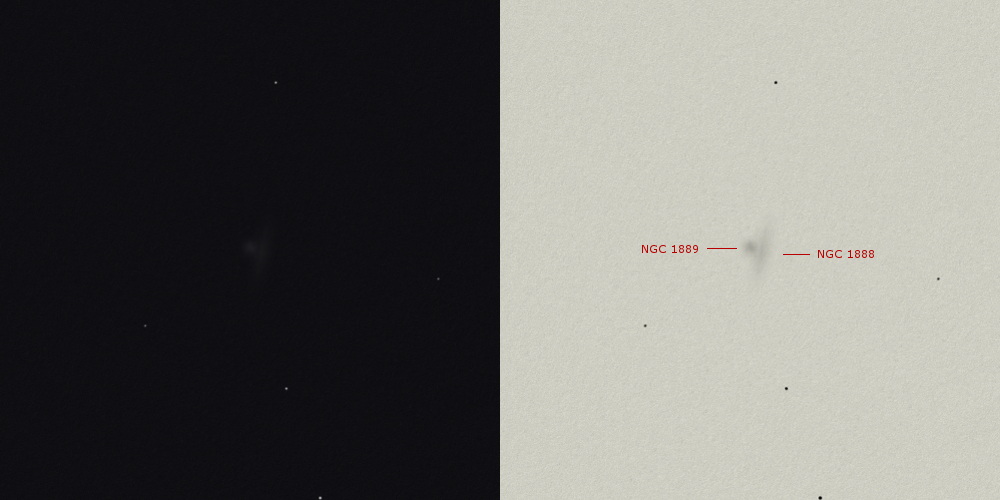
A very nice pair. A small globe is seen directly against a needle shaped galaxy. The two are in contact and surrounded by a shell of nebulosity. it has the appearance of a UFO.
Arp 124 – NGC 6361 and companion
NGC 6361: mag 13.1, size 2.2′ x 0.6′
MCG+10-25-3
Challenge: Faint bridge between the galaxies (N)
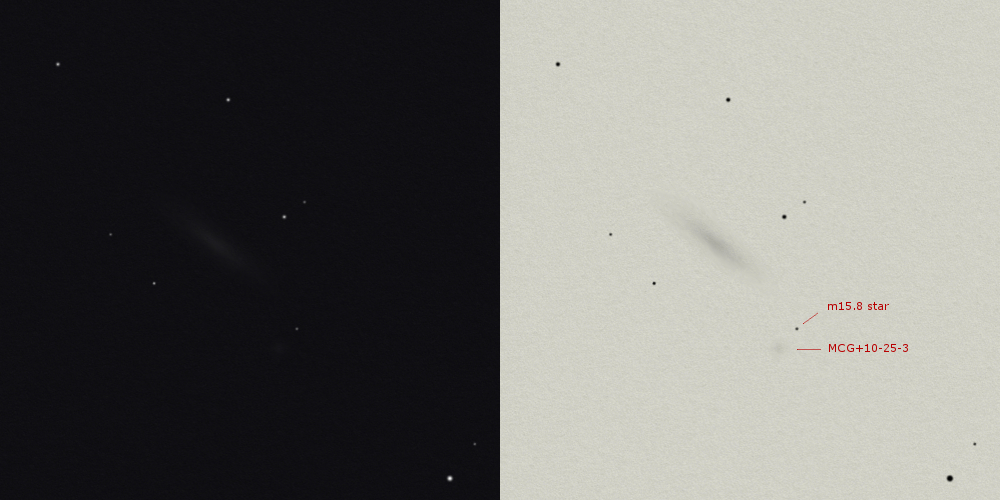
This Arp consists of the long NGC 6361 and small companion. The main galaxy is seen easily with an 4:1 oval shape and a bit of a brightening towards the center. The companion is very tough, it blinks around 40% of the time as a small and round dot, just under (and not to confuse with) a m15.8 star. The bridge between the two galaxies is not visible.
Arp 125 – UGC 10491
PGC 58674: mag 15.5, size 1.1′ x 0.5′
NPM1G +42.0445: mag 16.2, size 0.3′
Challenge: Numerous lumps in both galaxies (N)
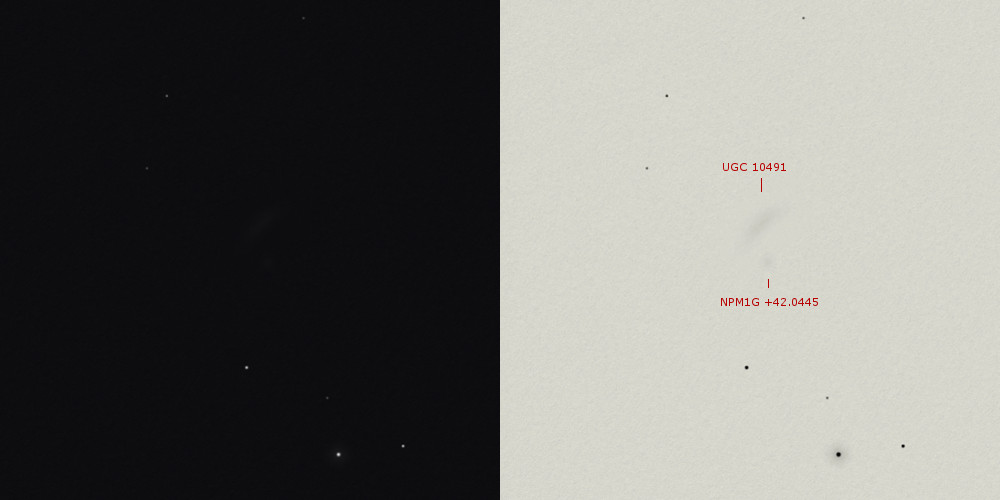
Nice couple! Like a mini Cocoon galaxy (but dimmer and smaller). UGC 10491 is seen with ease with AV and shows a bent shape. The bend moves towards a small and round galaxy that is a bit harder to discern from the background.
Arp 126 – UGC 1449 and MCG+0-6-9
UGC 1449: mag 13.9, size 1.2′ x 0.7′
MCG+0-6-9: mag 13.9, size 0.5′ x 0.4′
Challenge: Irregular knots in UGC 1449 (N)
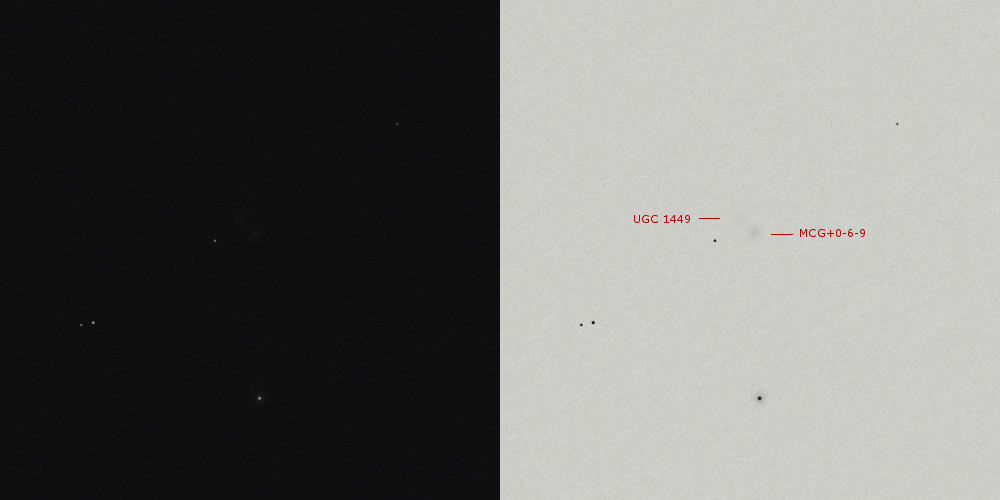
Two small galaxies remain small with high power. Both are well seen, but not the (irregular) knots. The MCG galaxy can just be glimpsed with DV; small, round and with a somewhat brighter core. UGC 1449 is seen with effort with AV.
Arp 127 – NGC 191 and IC 1563
NGC 191: mag 12.5; size 1.5′ x 1.2′
IC 1563: mag 13.6; size 0.8′ x 0.4′
Challenge: Faint arms in NGC 191 (N)

This one is small, but with a surprising appearance; Two galaxies and a (somewhat brigher) object are embedded in a nebulous area. This nebulosity is actually the fuzzy spiral structure of NGC 191, but it’s hard to tell how this is confined. IC 1563 is clearly oval shaped and about as bright as NGC 191. Between the two, in a triangle, is another bright object. It’s unclear if this is a star or a galaxy, but it does appear very stellar and soft at the same time. A high magnification is needed to separate both galaxies.
Arp 128 – UGC 827
VV 205a: mag 16.2, size 0.2′ x 0.2′
VV 205b: mag 16.0, size 0.5′ x 0.4′
Challenge: Separate the two galaxies (N)
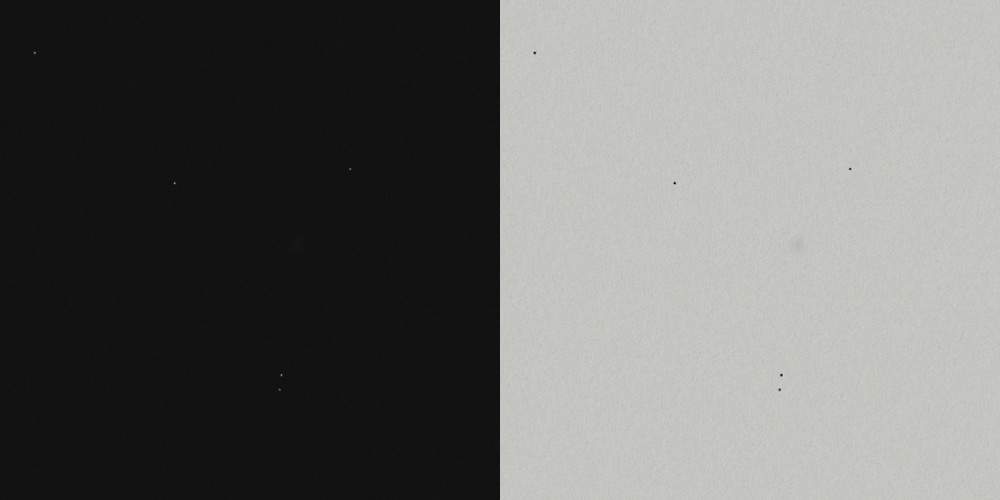
Very dim and only seen with AV. Now and then there is suspicion of a stretched shape or even a double core, but that image can’t be held long enough to confirm with certainty.
Arp 129 – UGC 5146: MCG+6-21-71 and -72
MCG+6-21-71: mag 14, size 0.8′ x 0.5′
MCG+6-21-72: mag 16, size 0.5′ x 0.5′
Challenge: Irregularities and lumps in MCG+6-21-71 (N)
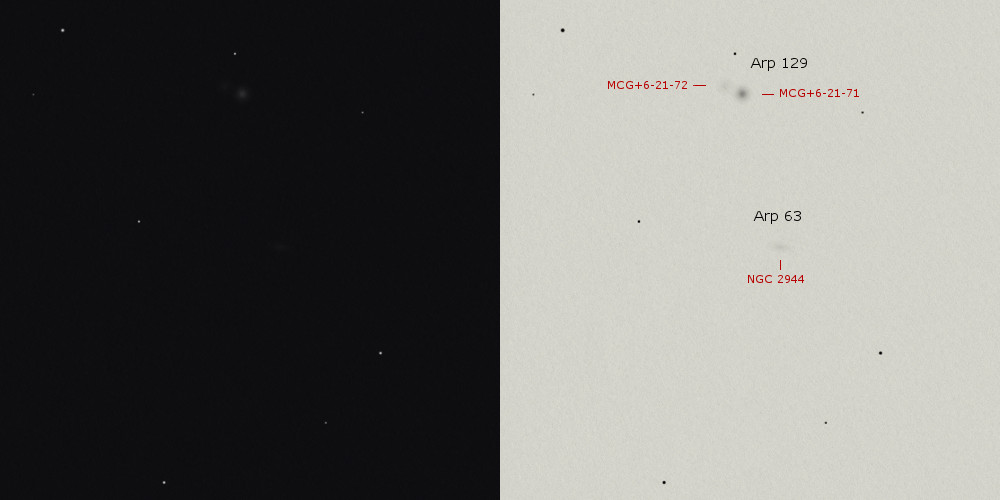
MCG+6-21-71 is unexpectedly bright, almost stellar, but no irregularities are noticed. MCG+6-21-72 is close by, seen with AV, small and round. Both galaxies form a triangle with a nearby star. Arp 63 can be seen in the same field.
Arp 130 – IC 5378: MCG+3-1-15 and -16
MCG+3-1-15: mag 15.4, size 0.6′ x 0.6′
MCG+3-1-16: mag 15.6, size 1.1′ x 0.8′
Challenge: Spiral structure in MCG+3-1-16 (N)
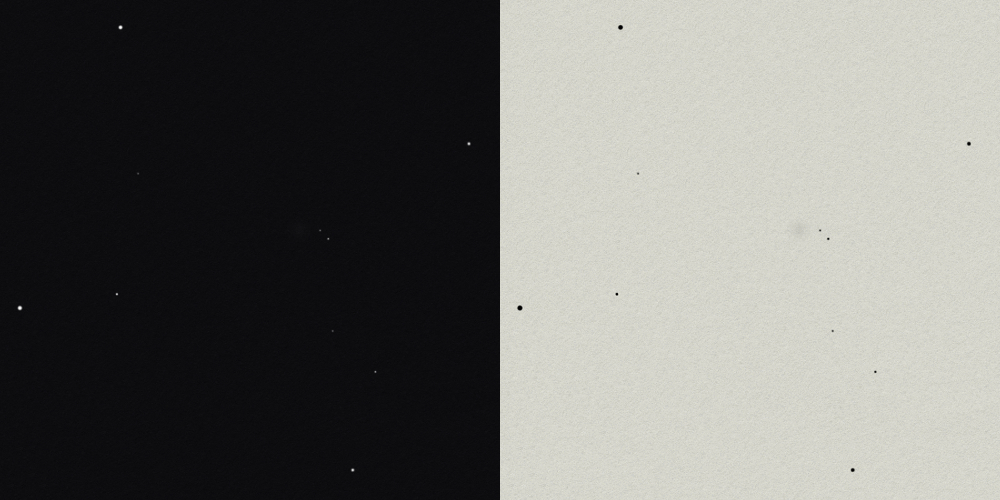
MCG+3-1-15 can be seen well with AV. It’s small, round and no central brightening is observed. A superimposed star is suspected, but could not be verified afterwards. MCG+3-1-16 is (strangely enough) not seen, or even suspected, despite the given magnitude of 15.6.
Arp 131 – MCG-3-8-25 and -26
MCG-3-8-25: mag 14.5, size 1.0′ x 0.7′
MCG-3-8-26: mag 15.0, size 0.6′ x 0.4′
Challenge: Knots in the arm of -26 (N)
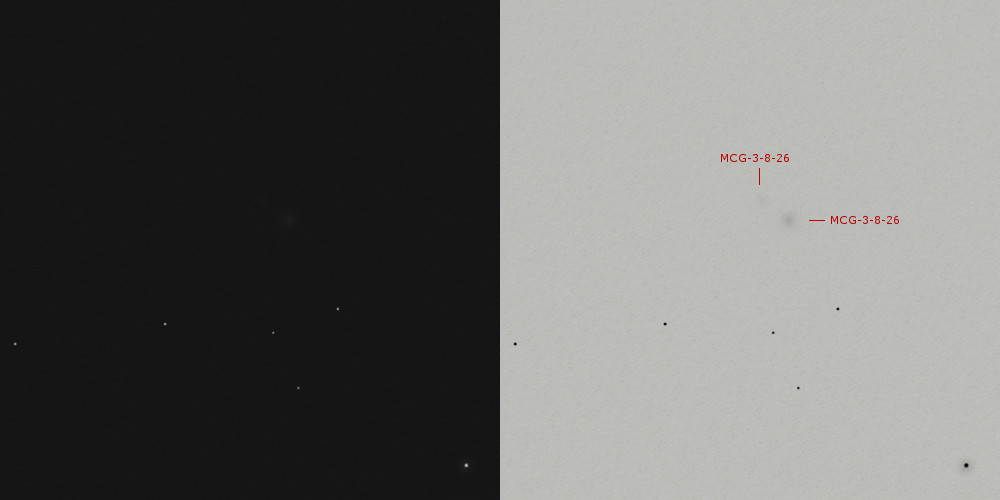
Round and a bit brighter towards the core. MCG-3-8-25 is easily seen with DV, but this can not be said of the companion MCG-3-8-26 which is seen with effort with AV.
Arp 132 – CGCG 11-53
Arp 132E: mag 15.2, size 0.4′ x 0.3′
Arp 132W: mag 15.0, size 0.7′ x 0.4′
LCLG-3 080.08: mag 17.2, size 0.2′
Challenge: Three galaxies and the spiral arm N of 132W (N)
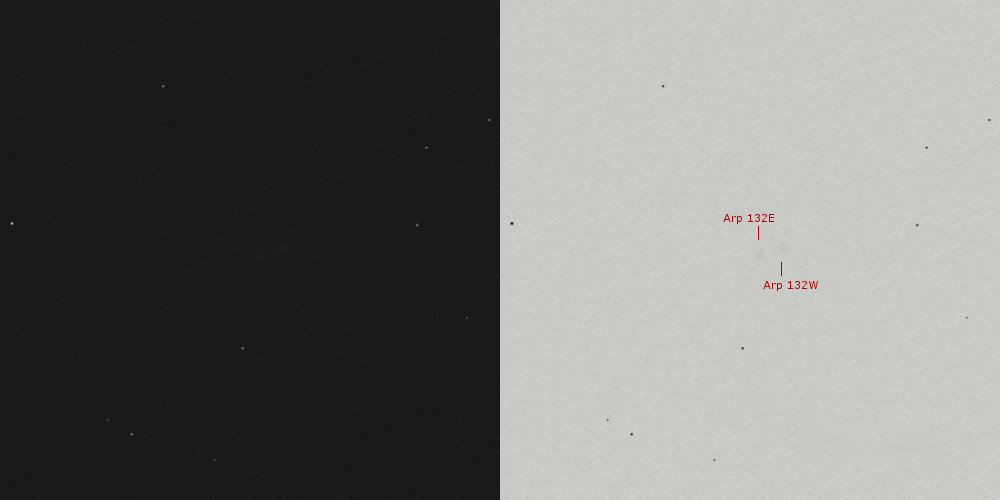
No luck the first time I tried because the exact location could not be found in this star-poor field. This time with a detailed star chart it still took me 15 minutes to be sure of the exact position before increasing magnification. Then after a couple of minutes CGC 11-53 could be seen with AV and it was clear that it consists of two galaxies and not one, both round, about the same size, evenly bright and well separated.
With nearby fragments (Arps 133 – 136)
Arp 133 – NGC 541 and companions
NGC 541: mag 12.1, size 1.8′ x 1.8′
LEDA 86298: mag 13.1, size 0.3′ x 0.2′
Challenge: Three fragments including Minkowski’s object (N)

This is a beautiful field where many galaxies can be discerned. Besides, it’s always nice to see to Arps in one view. One galaxy was sketched as a star, but appeared to be UGC 1003 when checking afterwards. So in total 8 galaxies were observed in a FOV of only 16′. Very nice.
Arp 134 – M49 (NGC 4472)
M49: mag 9.3, size 10.2′ x 8.3′
UGC 7636: mag 14.8, size 1.1′ x 0.9′
Challenge: Detect the dwarf irregular galaxy UGC 7636 companion and detect any structure in it (N)
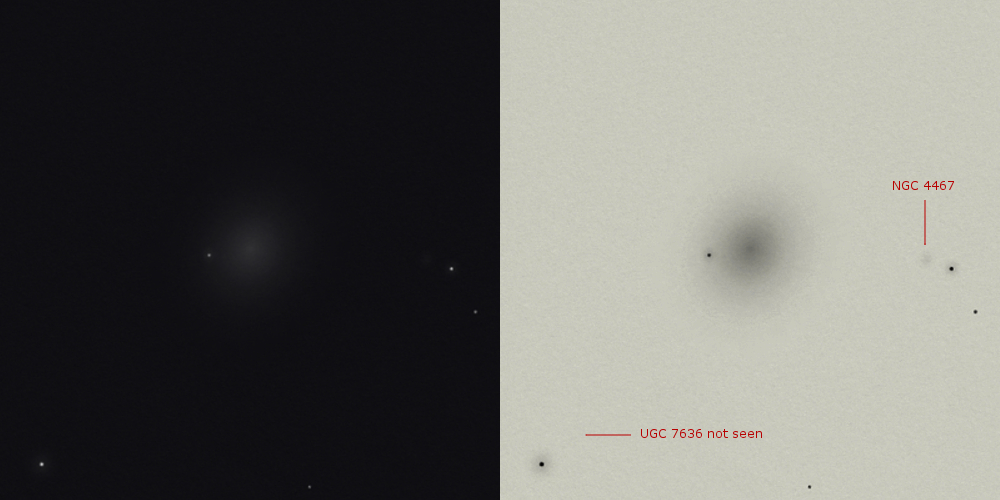
Messier 49 is a large and almost round elliptical, gradually brightening towards the blazing core. In the same field NGC 4467 is visible with AV, but not the fragment UGC 7636. A mag 9 star is close to M49, just touching the edge of it.
Arp 135 – NGC 1023 and NGC 1023A
NGC 1023: mag 9.3, size 8.8′ x 3.0′
NGC 1023A: mag 13.0, size 1.6′ x 1.4′
Challenge: NGC 1023A (Y)

The “Perseus Lenticular Galaxy“. Large and cigar-shaped with a bright and diffuse core. With effort the galaxy NGC 1023A can be seen by AV on the SE tip as a tine smudge just a tad brighter than the sky background. But one has to know where to look.
Arp 136 – NGC 5820 and companions
mag 12.5, size 1.7′ x 1.1′
Challenge: Extension (streamers) off the SE end of NGC 5820 (N)

Now almost in zenith. I use the 5mm to keep a bright double star out of the FOV. NGC 5820 is a bright oval with bright core and soft outer area. The streamers can not be seen, but this galaxy is surrounded by fragments of which one can be (barely) spotted with AV, which is a nice bonus. Closeby is another galaxy: NGC 5821, which is dim but quite large. No additional details can be spotted here.
Material emanating from elliptical galaxies (Arps 137 – 145)
Arp 137 – NGC 2914
mag 13.2, size 1.0′ x 0.7′
Challenge: Hook to N and the wisp to S (N)
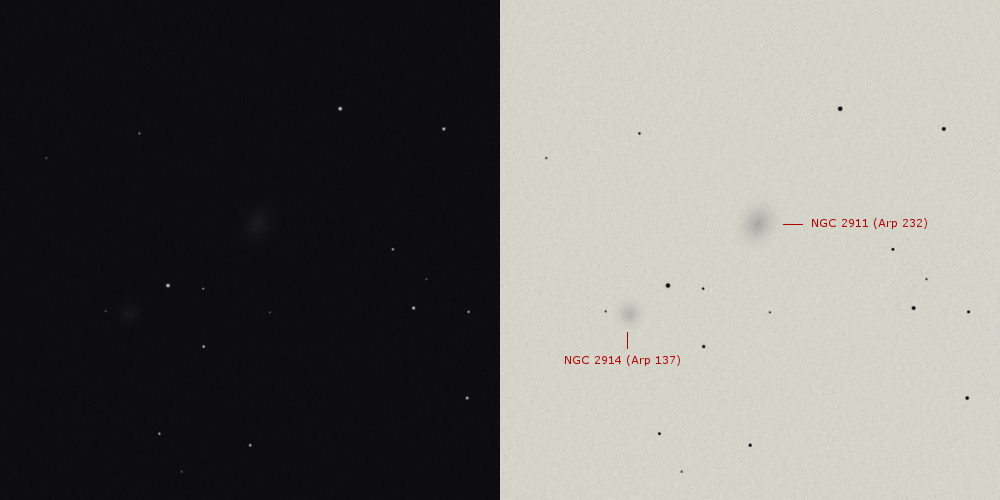
Two Arps in a single view. Arp 137 (NGC 2914) and Arp 232 (NGC 2911). Both are seen with DV and without any recognition of further detail. NGC 2911 is largest, somewhat oval and has a bright core. I don’t see the dim star against it. NGC 2914 is a bit smaller and less bright, but I do see that the core is a bit brighter. Here I do see a dim star just outside the glow.
Arp 138 – NGC 4015
MCG+4-28-109: mag 14.2, size 1.1′ x 0.9′
MCG+4-28-110: mag 15.6, size 0.9′ x 0.2′
Challenge: Short faint plumes from NGC 4015, NW and SE (N)
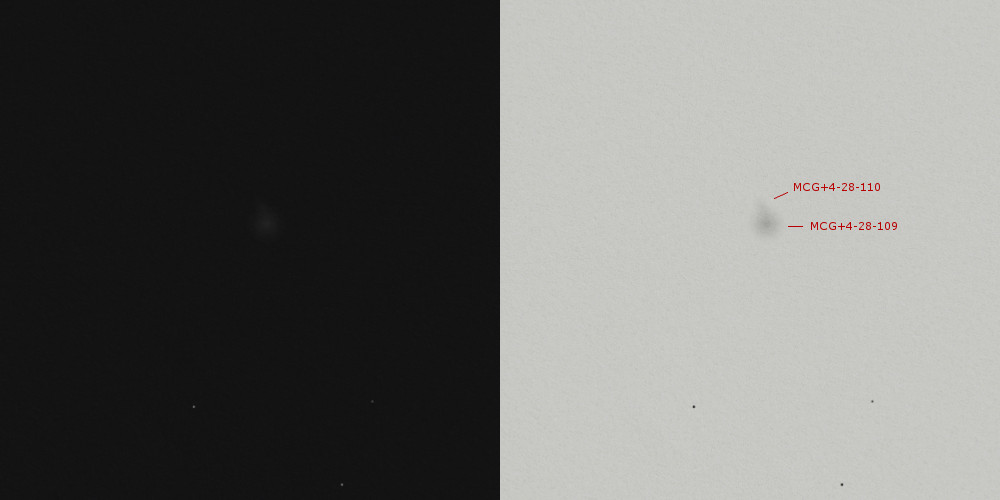
This is a nice Arp that shows its feature well under good conditions and high power: a small edge-on attached to the main galaxy. The needle shape was not really seen, it’s more like a protrusion perpendicular to MCG+4-28-109. A lot of other galaxies can be observed nearby.
Arp 139 – MCG+5-31-135
MCG+5-31-135 (1): mag 16.3, size 0.7′ x 0.4′
MCG+5-31-135 (2): mag 15.8, size 1.0′ x 0.4′
Challenge: Unwrapped spiral arms in component (2) (N)
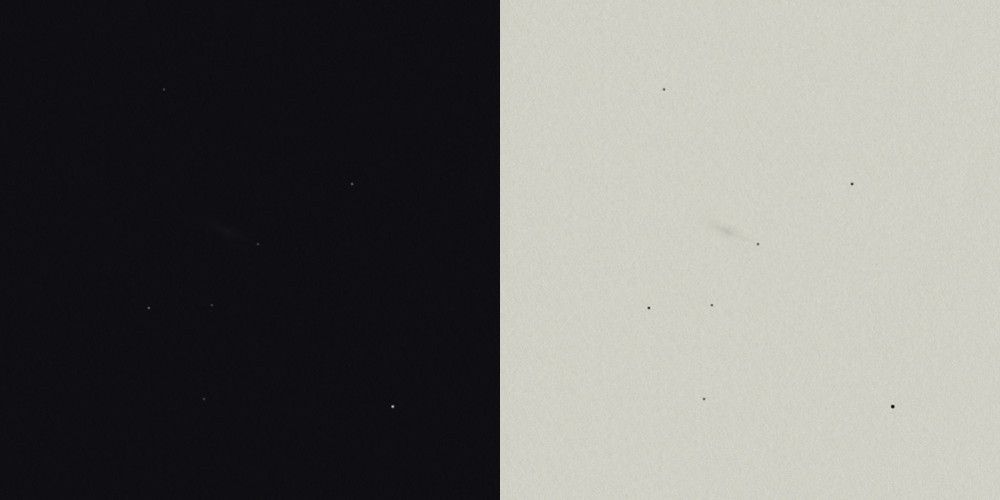
Seen as a line, with a “bulge” just outside the center. The line points towards an m16 star at the tip. The two galaxies could not be splitted.
Arp 140 – NGC 274 and NGC 275
NGC 274: mag 12.8, size 1.5′
NGC 275: mag 12.5, size 1.6′ x 1.1′
Challenge: Chaotic structure of NGC 275 (Y)
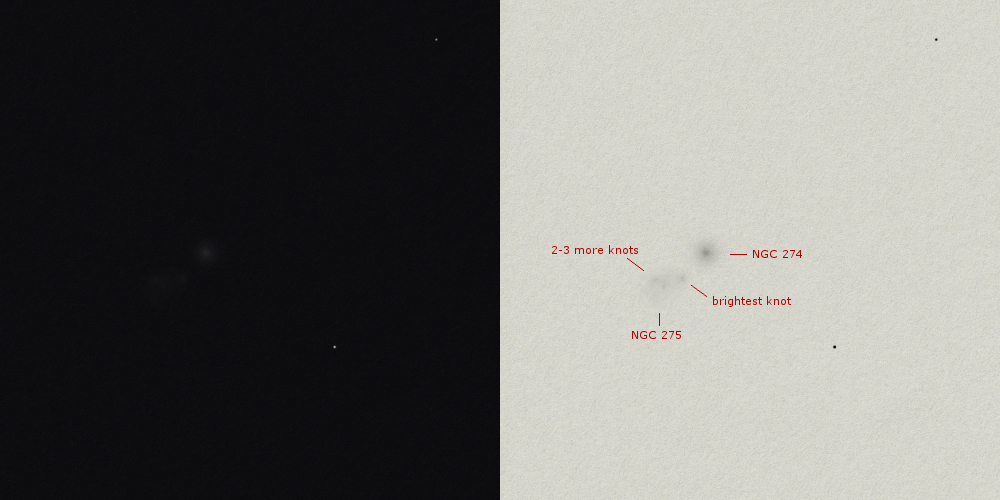
Very nice pair! Two galaxies nearly in contact, but not quite. NGC 274 is bright, round and compact, with a short halo. NGC 275 is larger, dimmer, has a triangular shape and at least two separate core areas are observed.
Arp 141 – UGC 3730
mag 13.2, size 2.8′ x 1.5′
Challenge: Faint southern ring (N)
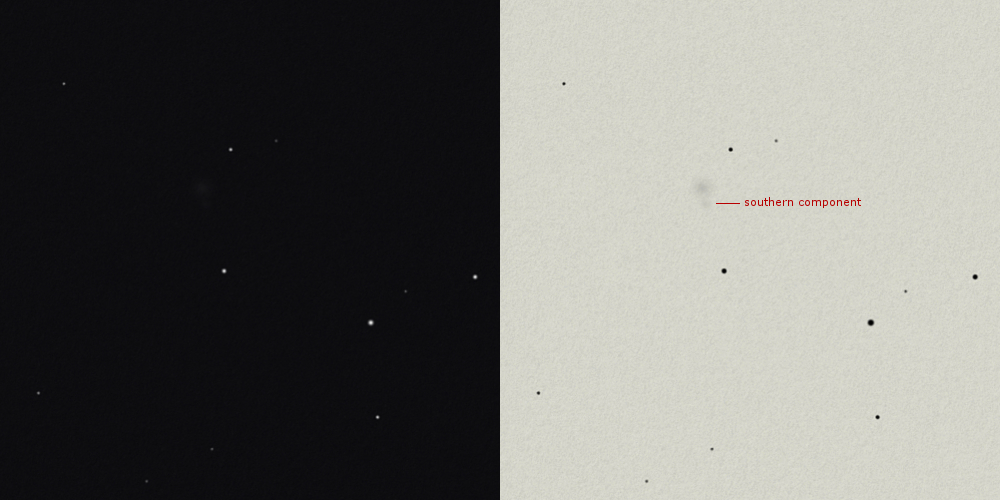
UGC 3730 can be seen well with AV as a small and round smudge of light. The southern component is very hard, but can be seen blinking up from time to time; tiny and just set loose from the main component. The tail and ring are not seen.
Arp 142 – NGC 2936 and NGC 2937
NGC 2936: mag 13.9, size 2.1′ x 0.7′
NGC 2937: mag 14.6, size 0.7′ x 0.5′
Challenge: Absorption lane running the lenght of NGC 2936 and the MAC galaxy (N)
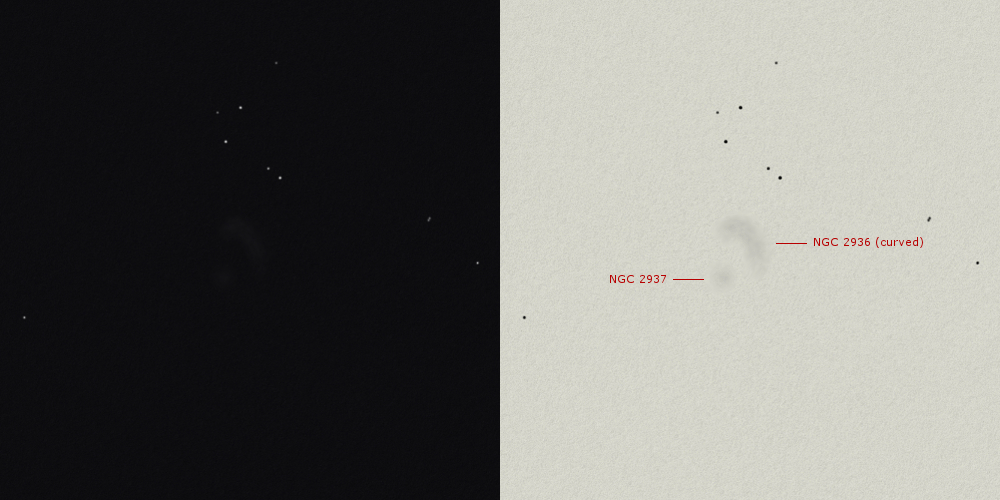
This is a strange one. Two tiny galaxies can be seen close to each other near a concentrated starfield. The influence on one another can be seen. NGC 2936 curls like a banana around NGC 2937. The latter is nothing more than a tiny dot, which is mostly seen with AV. The dim and small MAC 0937+0246 could not be spotted.
Arp 143 – NGC 2444 and NGC 2445
NGC 2444: mag 14.2, size 1.2′ x 0.8′
NGC 2445: mag 13.9, size 1.4′ x 1.1′
Challenge: Plumes on 2444 and knots in 2445 (P)

NGC 2444 and NGC 2445 are attached and are caught in a single, oval shaped glow. 2444 is the brightest of the two and has a clear core area. 2445 is very mottled and clearly two knots can be observed, a real core area is missing. You really have the feeling that 2445 is torn apart due to its contact with 2444. The two galaxies reside in a beautiful star littered field.
Arp 144 – NGC 7828 and NGC 7829
NGC 7828: mag 14.4, size 0.9′ x 0.5′
NGC 7829: mag 14.6, size 0.7′
Challenge: Faint eastward sweep of NGC 7829 and the bent tail NW of NGC 7828 (N)
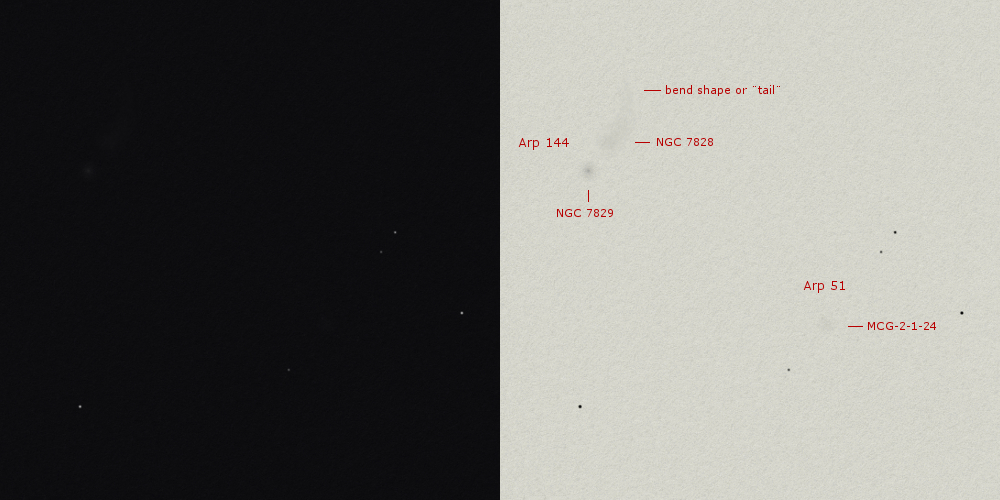
In the same field as Arp 51. Arp 144 is a nice pair of the bright NGC 7829 (small, round and with a stellar core) and NGC 7828. The latter is pretty dim, but can still be seen with DV. It appears a bit like a comet, with a bent tail. The broader part is a bit brighter.
Arp 145 – UGC 1840
PGC 9060: mag 17.8, size 1.8′ x 1.7′
PGC 9062: mag 13.8, size 1.5′ x 1.3′
Challenge: The donut shape (N)
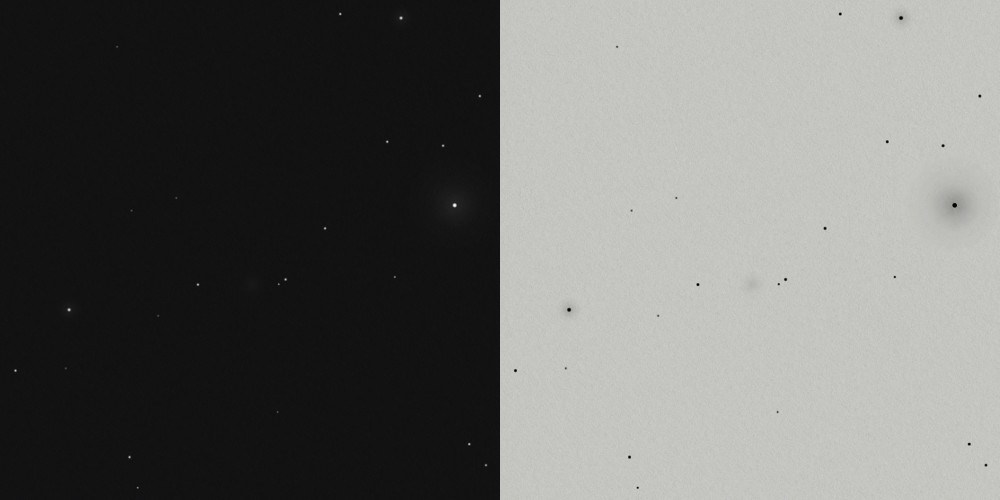
Small and round, seen next to a double star. Well seen with AV. This galaxy is very small, almost stellar and resides in a rich starfield with a very bright (m6) star. Only one galaxy seen, no donutshape.
Galaxies
With associated rings (Arps 146 – 148)
Arp 147 – IC 298 and IC 298A
IC 298: mag 14.3, size 0.5′ x 0.4′
IC 298A: mag 15.1
Challenge: Knots and gaps in the ring and the three bright elements of the companion (N)
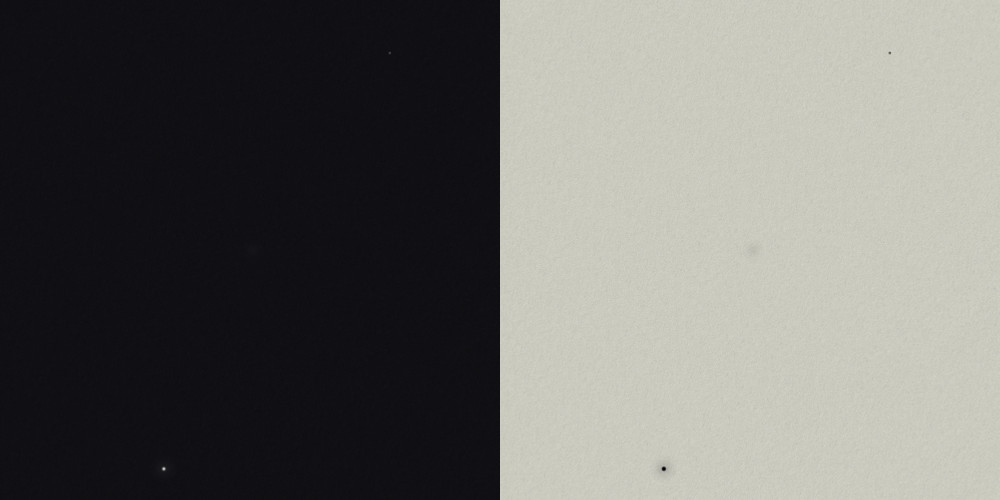
Very dim! Next to a bright star. The galaxy is seen 50% of the time, sometimes two components are suspected and sometimes a stellar dot. Unfortunately, the suspicion can’t be confirmed with certainty.
Arp 148 – MCG+7-23-19, Mayall’s Object
mag 15.4, size 0.5′ x 0.3′
Challenge: Ring structure of VV 32b (N)
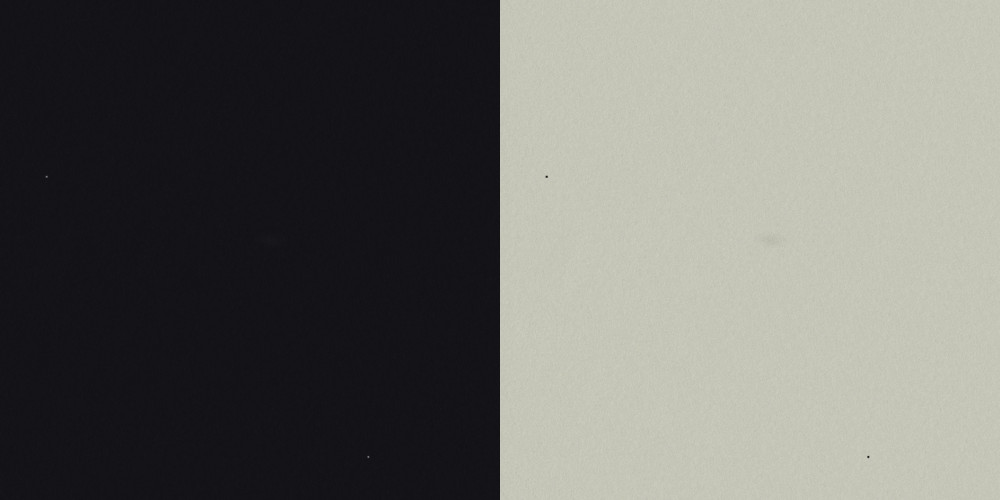
Seen with AV as a 3:1 oval. Small and in a star-poor field. After this observation I noticed that the mirror was very dirty and I washed it first before moving on. So perhaps there could have more detail to see.
With jets (Arps 149 – 152)
Arp 149 – IC 803
mag 15.3, size 0.7′ x 0.1′
Challenge: Extremely faint straight jets heading NW and SW (N)
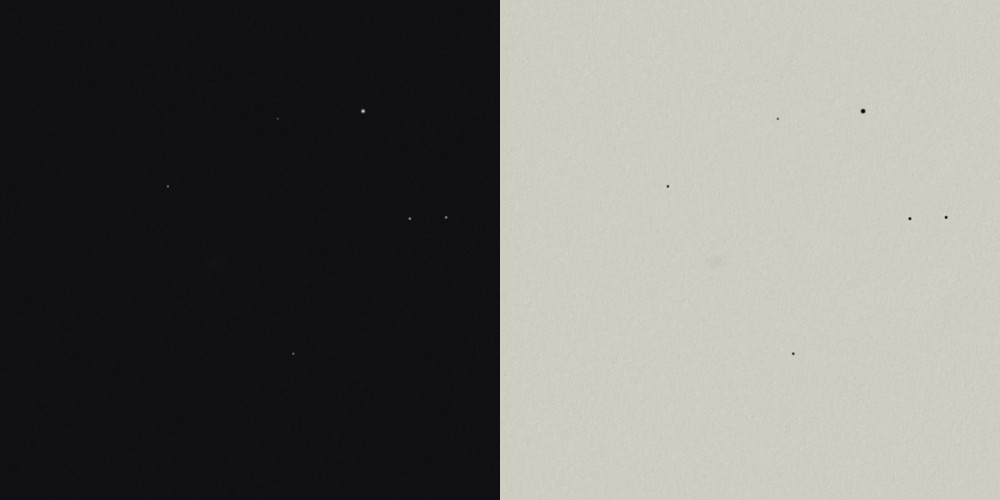
Very tough observation. This galaxy is small and dim, but the elongated shape and direction can be seen. Sometimes, a split core is suspected, but it’s not enough to trust it to the sketch with confidence. As such, the two (disturbed) galaxies are seen as one.
Arp 150 – NGC 7609, Hickson 95
NGC 7609: mag 14.7, size 0.8′ x 0.5′
MCG+1-59-46: mag 17.2, size 0.7′ x 0.2′
MCG+1-59-48: mag 16.0, size 0.7′ x 0.2′
PGC 71077: mag 16.2, size 1.0′ x 0.3′
Challenge: Tails between NGC 7609 and PGC 71077, and texture in the northern tail (N)
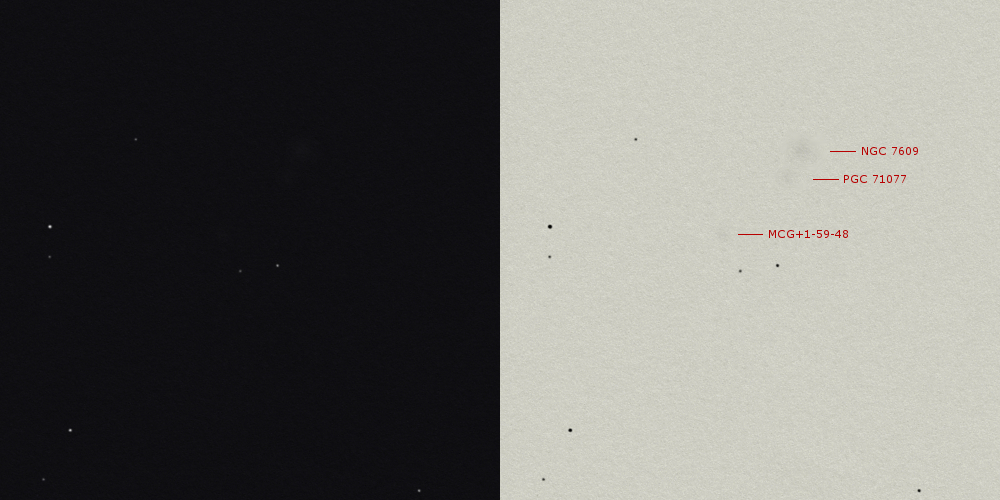
Very dim group of galaxies. NGC 7609 can be seen with ease, but it takes the 5mm to split this galaxy with MCG+1-59-48, which in its turn can only be seen blinking now and then with AV. A a short distance, PGC 71077 can be found, but it it’s even smaller and harder to see. MCG+1-59-46, the fourth (D) member of the group could not be seen.
Arp 151 – MCG+9-19-73
mag 16.8, size 1.3′ x 0.2′
Challenge: Jet and texture in northern end (P)
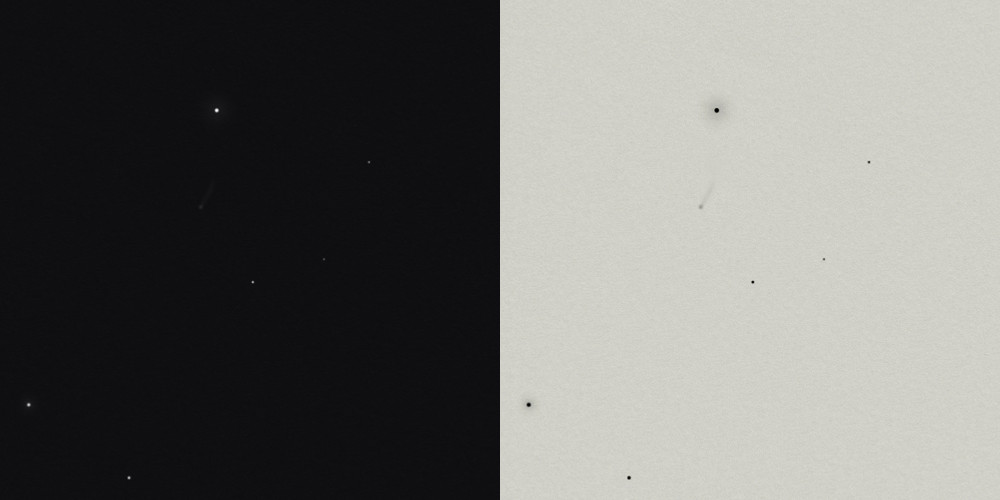
Very difficult observation, but (partially) successfull. Galaxy was first perceived as a dim star (so it’s quite stellar). Now and again the jet towards a bright star can be perceived, but it takes a long and concentrated observation. Nice!
Disturbed with interior absorption (Arps 153 – 160)
Arp 153 – NGC 5128
mag 6.8, size 25.9′ x 20.1′
Challenge: Oblong shape of galaxy, absorption texture, and hook at NW of absorption structure (P)
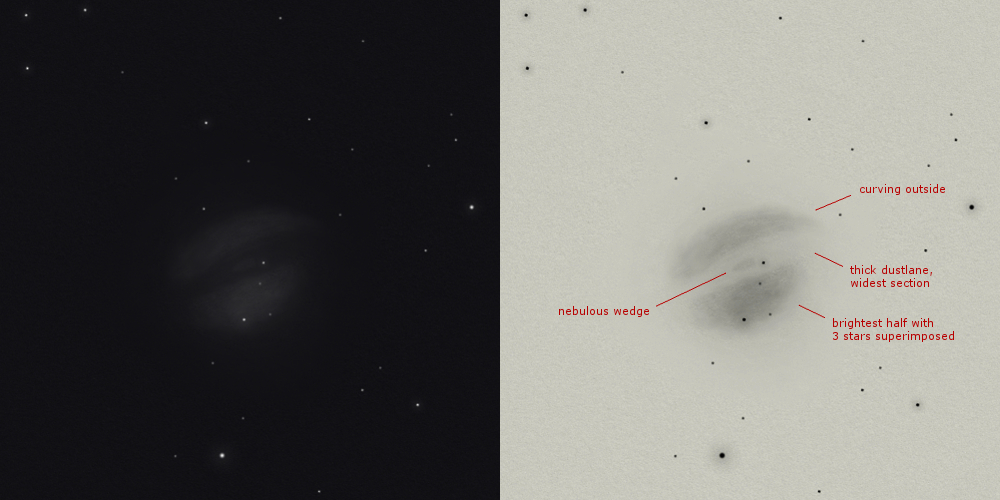
Centaurus A is large and therefore I choose the 10mm to give a nice overview of the area. The galaxy is composed of two halves, of which the S half is the smallest and brightest. There is clearly a star trapped inside it, but with AV two more dimmer ones can be seen. The upper half of the “hamburger” is flatter and wavy and extends a bit more on the W side. The two halves are separated by a majestic dust lane, a bit wider on the W side. It is at this side of the dustlane that a star is seen inside it, with a patch of nebulosity moving away from it to the E. Around the hamburger there is soft glow and the field of view is specked with a lot of dim stars, but also a few brighter ones. It takes quite a lot of time to draw all that I’m seeing here. Marvelous object!
Arp 154 – NGC 1316, Fornax A
mag 8.2, size 12.1′ x 8.6′
Challenge: Absorption structures N and S of nucleus (N)
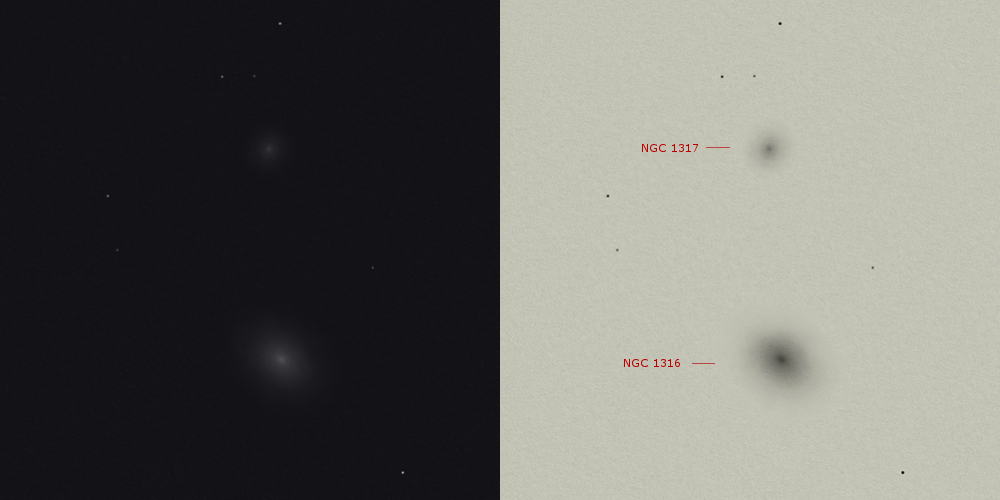
Sometimes an Arp galaxy is just very bright. As in the case of Fornax A and NGC 1317 next to it. NGC 1316 is large, slightly oval and very much brighter towards the core, which is almond shaped and almost stellar. The outer nebulosity fades softly into the sky background. NGC 1317 is smaller, a bit dimmer and more roundish. These two really can’t be missed with DV!
Arp 155 – NGC 3656 and companion
NGC 3656: mag 12.5, size 1.6′ x 1.6′
MCG+9-19-64: mag 15.0, size 0.4′ x 0.2′
Challenge: Detect lumpt to S and split in nucleus (N)
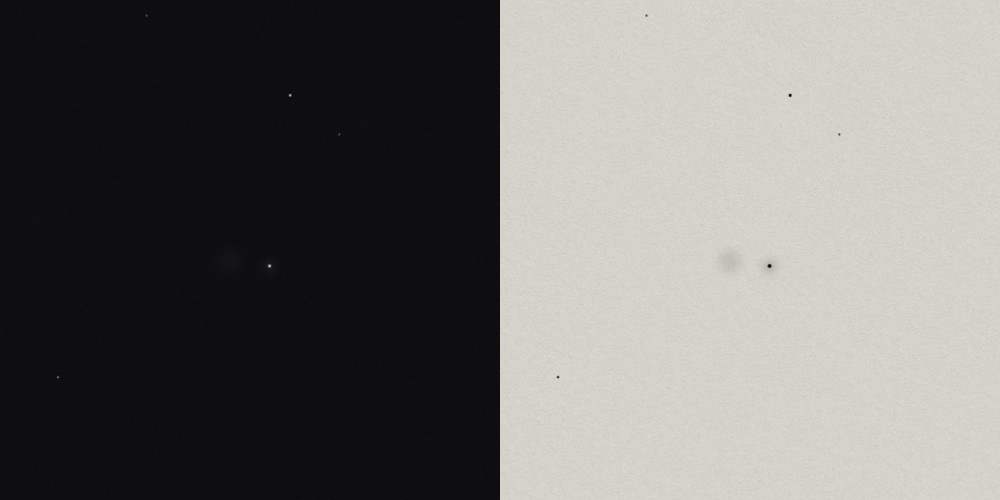
Bright and quite large. Appears perfectly round. Unfortunately, no lump or split core were seen despite of using high power.
Arp 156 – UGC 5814
mag 15, size 1.6′ x 0.9′
Challenge: Faint extension to the SE (N)
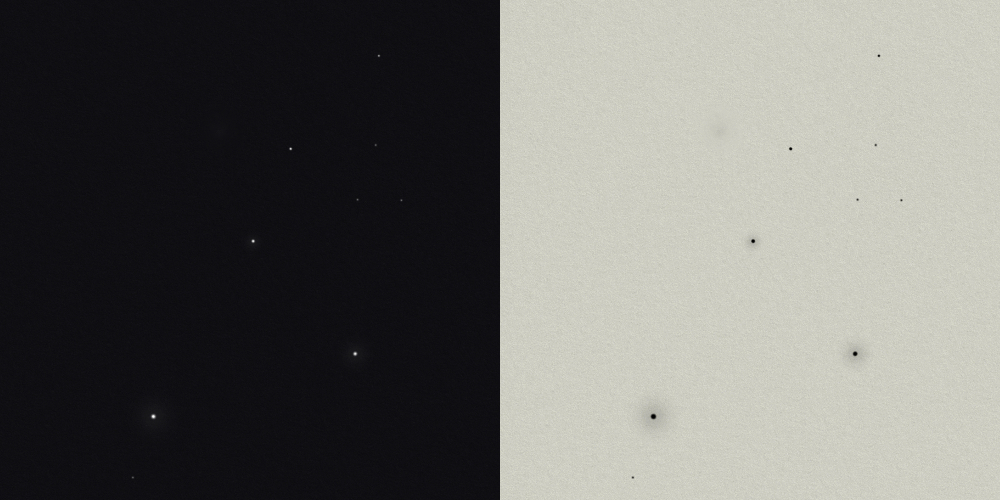
Dim, but well seen with AV. A round stain, a bit brighter in the center and without any further details. A bright star hinders a proper observation a bit.
Arp 157 – NGC 520 and companion
NGC 520: mag 11.5, size 4.5′ x 1.8′
UGC 957: mag 18.0, size 1.2′ x 0.9′
Challenge: Faint tails N and S, and companion (N)
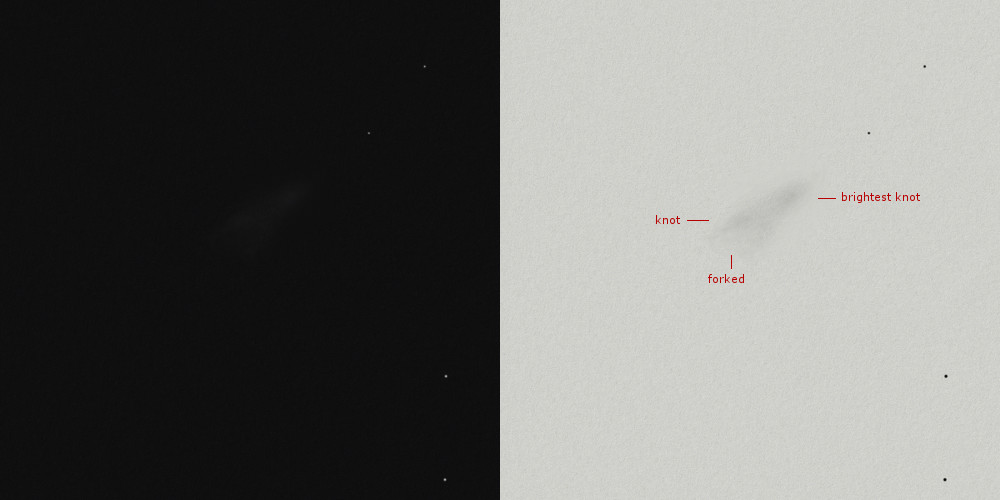
Immediately seen, stretched and forked with clearly two knots inside. Beautiful! The companion remained hidden.
Arp 158 – NGC 523
mag 13.5, size 2.5′ x 0.7′
Challenge: Faint ESE extension (N)
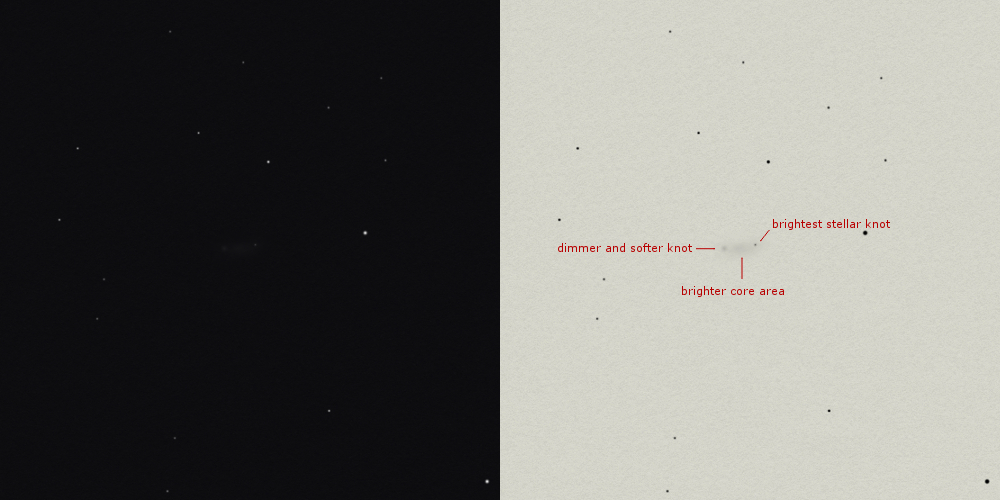
Strange object. Hard to see with DV as a (slightly bend) stretched galaxy with some central brightening. At both “tips” a knot can be seen. The W knot is brightest and stellar (like a dim star), while the E knot is larger, softer and can only be glimpsed with AV.
Arp 159 – NGC 4747
mag 12.4, size 3.5′ x 1.2′
Challenge: Irregular absorption structure SE along nucleus and plume to NE (N)
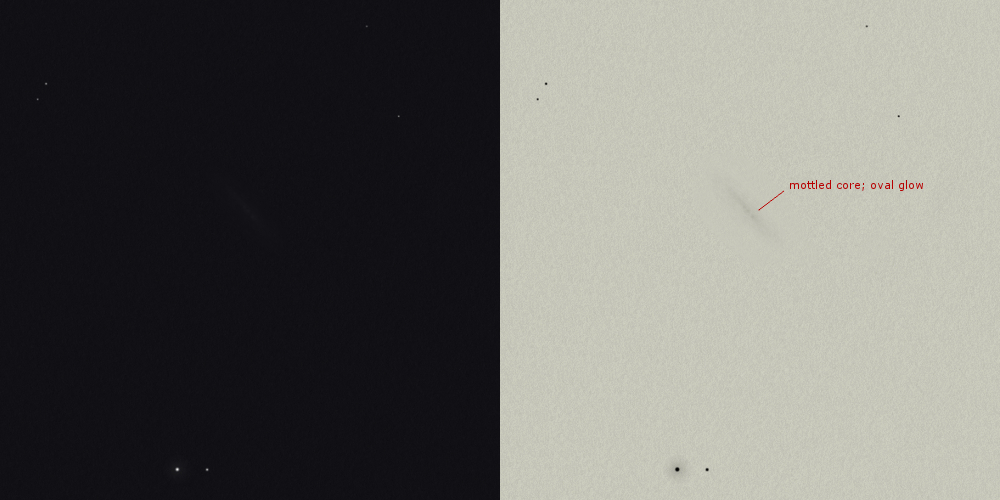
This is a dim galaxy but can just be seen with DV. Despite its dimness it’s a nice view because of its needle shape with an oval glow around it (not edged sharply). The core zone is stretched and not evenly brightened; it’s mottled and sometimes the loose core parts can be glimpsed (two or three). Tough observation, but nice.
Arp 160 – NGC 4194, The Medusa
mag 12.5, size 2.8′ x 2.1′
Challenge: Absorption structure to NE of nucleus, arc to S, and faint wide spray to N (P)
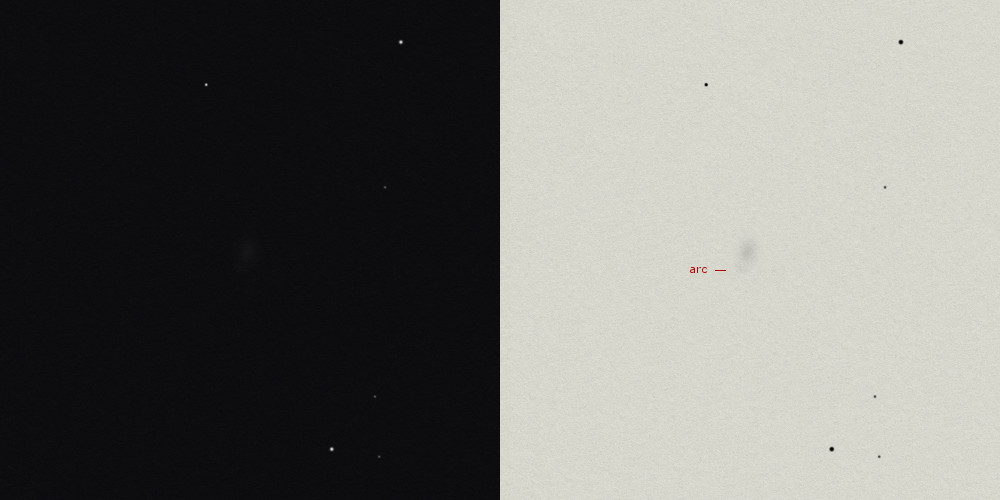
Interesting object. At first, only an oval and almost stellar galaxy is seen, but at high power (and good seeing) more details become visible. At the S side there is more nebulosity than at the N side and because of this the galaxy appears a bit like a comet. Now and again, a patch of this nebulosity is seen separated, this is the “arc” that is a part of the challenge.
Diffuse filaments (Arps 161 – 166)
Arp 161 – UGC 6665
mag 14.7, size 0.4′ x 0.4′
Challenge: The jet and full extent of the plume (N)
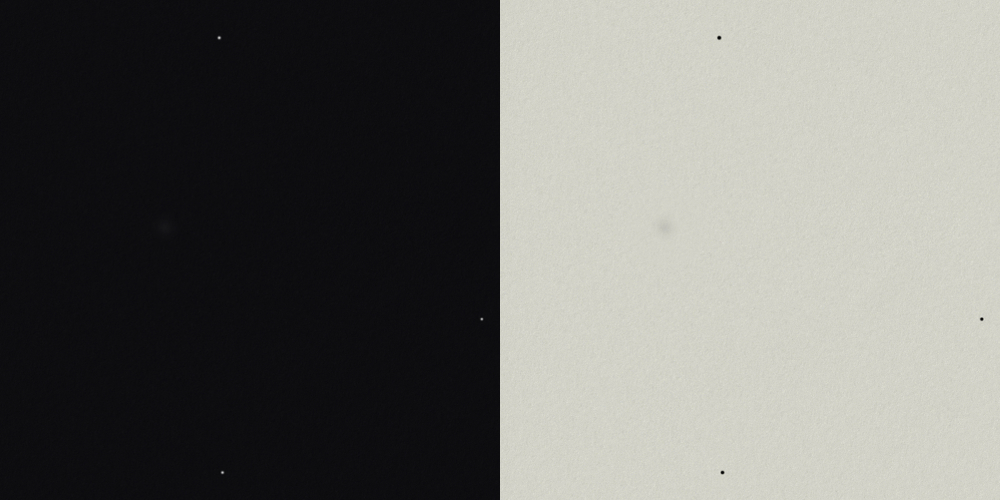
Very small, appears round although the direction is suspected, but it’s too dim to confirm. Jet and plume definitely not seen.
Arp 162 – NGC 3414
mag 12.0, size 3.5′ x 2.6′
Challenge: Diagonal filament (Y)
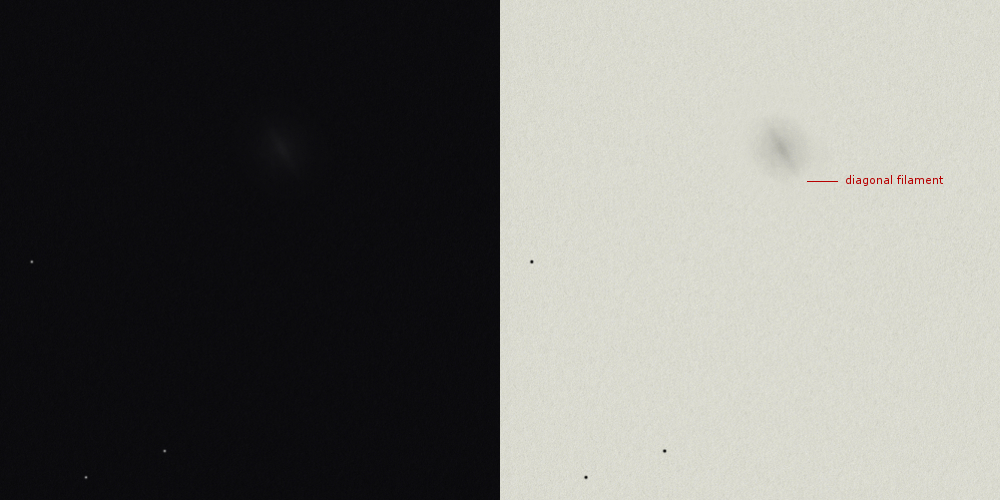
Here’s a bright and quite large galaxy that appears round at first glance, with a very bright core and soft outer envelope. Observing with AV shows the diagonal filament fairly easy, like a needle sticking through it. This galaxy resides in a poor star region.
Arp 163 – NGC 4670
mag 12.7, size 1.5′ x 1.1′
Challenge: Hooked filament to the W of the nucleus, curving to N (N)

NGC 4670 is pretty bright, with a distinct bar that sticks like a needle through the galaxy, pointing towards a bright star. It’s clearly visible with DV, but the hooked filament is not. Nearby NGC 4673 can be seen in the same field, forming a triangle with the Arp galaxy and the bright star.
Arp 164 – NGC 455
mag 12.6, size 2.0′ x 1.2′
Challenge: Faint filament to N and wisp to S (N)
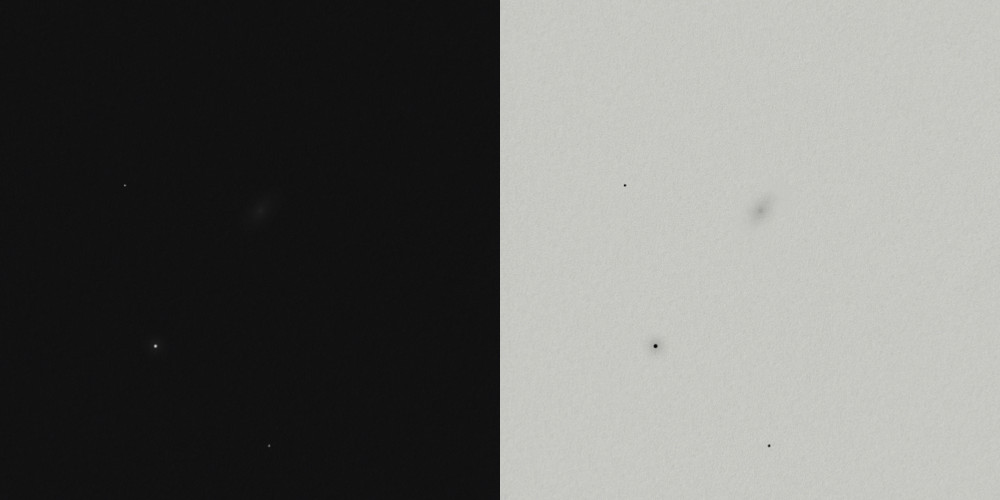
Bright and easily seen. The galaxy has a stellar core and is stretched, but no whisps can be noticed.
Arp 165 – NGC 2418
mag 12.2, size 1.8′ x 1.4′
Challenge: Looped streamer to SE and plume N (N)
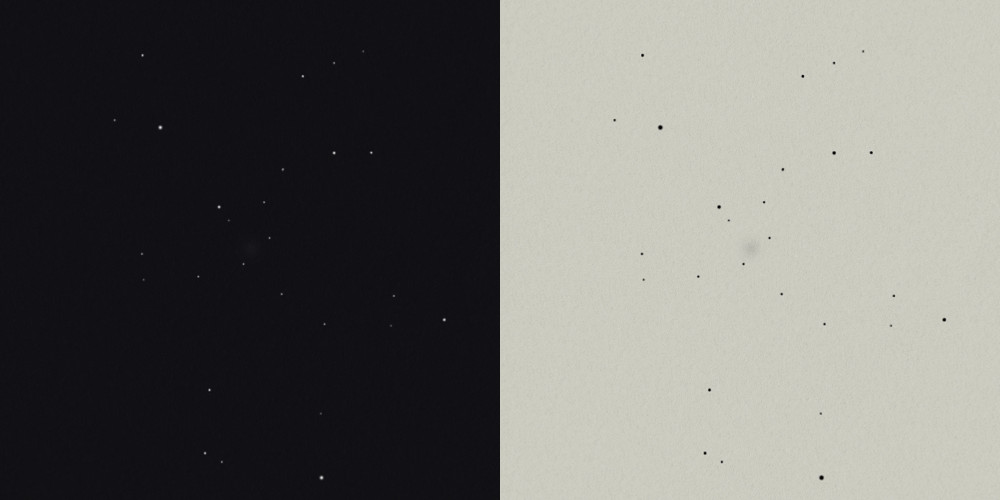
Bright and almost round galaxy in a nice star field. Two stars are very close to the galaxy. No further details are noticed.
Arp 166 – NGC 750 and NGC 751
NGC 750: mag 12.9, size 1.7′ x 1.3′
NGC 751: mag 13.5, size 1.4′
Challenge: Three faint radial companions (N)
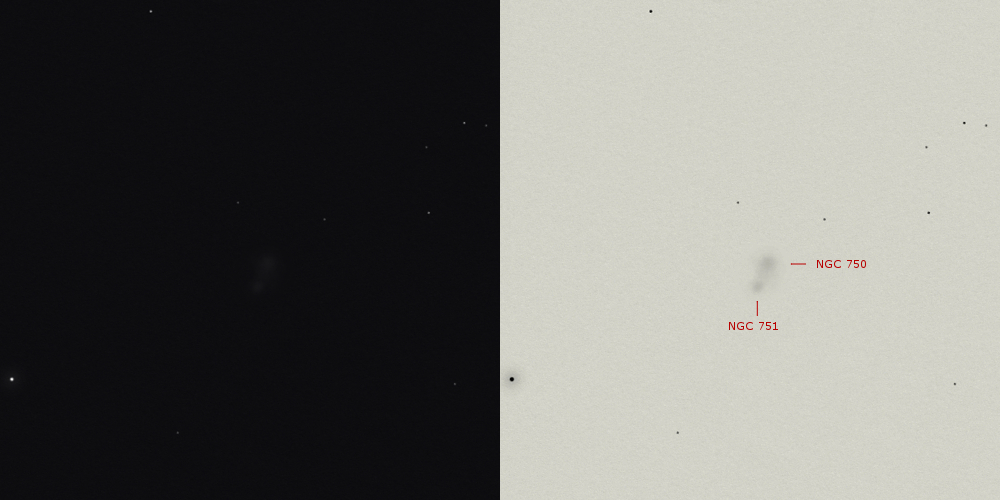
Two galaxies are visible in this Arp. Both can be seen and separated easily. The surrounding nebulosity has a droplet shape because there’s a small notch on the E side. On the N side the nebulosity is a bit broader. NGC 750 is the largest and brightest of the two, the core is round. NGC 751 is smaller and oval shaped, the PA can be followed. The companions were not seen.
Diffuse counter-tails (Arps 167 – 172)
Arp 167 – NGC 2672 and NGC 2673
NGC 2672: mag 12.7, size 3.0′ x 2.8′
NGC 2673: mag 14.4, size 1.2′
Challenge: Plume of 2673, curving from SE to E (N)
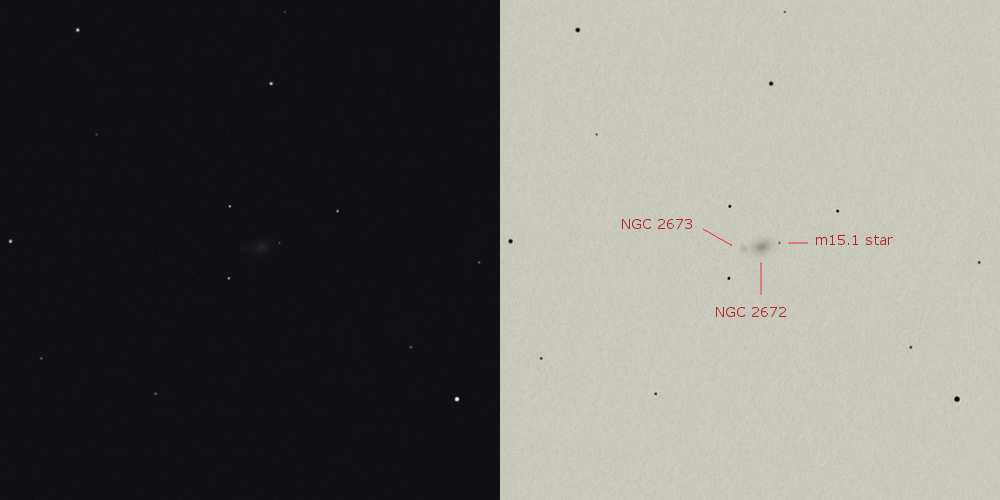
Two small galaxies not far from M44 that almost touch each other. 2672 (W) is larger, oval and can be seen with DV. The brightness gradually decreases towards the edges and W of it is a dim star. 2673 can only be seen with AV as a dim and round cloud.
Arp 168 – M32 (NGC 221)
mag 9.0, size 8.8′ x 6.5′
challenge: The plume (N)
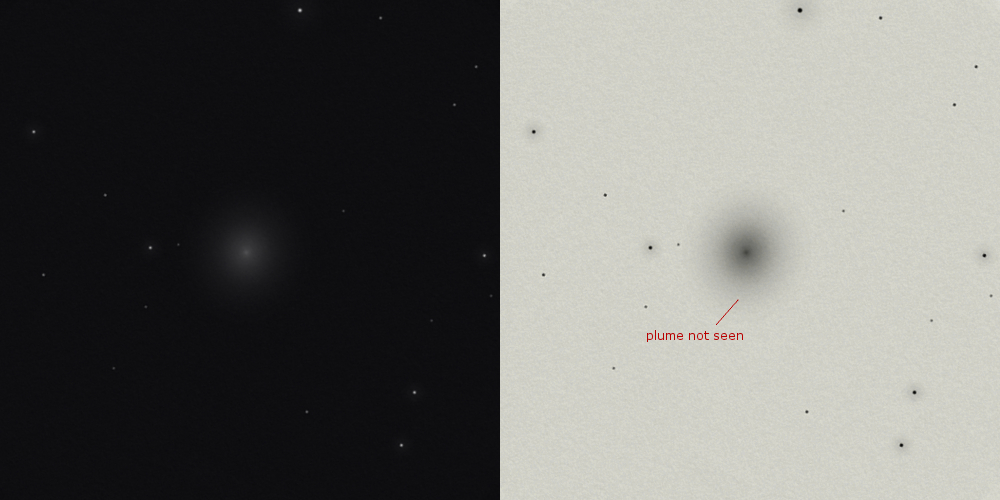
Often overlooked while observing the great M31 nearby. No special detail can be seen. M32 is moderately large and slightly oval shaped. At high magnification the difference in brightness within the galaxies is notable and not equally decreasing towards the outer section; the core is almost stellar and the brightness remains high until 50% outwards, after which it drops significantly. The plume was not seen.
Arp 169 – NGC 7236 and NGC 7237
NGC 7236: mag 13.5; size 0.7′
NGC 7237: mag 15.0; size 0.7′
NGC 7237C: size 0.4′ x 0.3′
Challenge: Faint plumes (N)
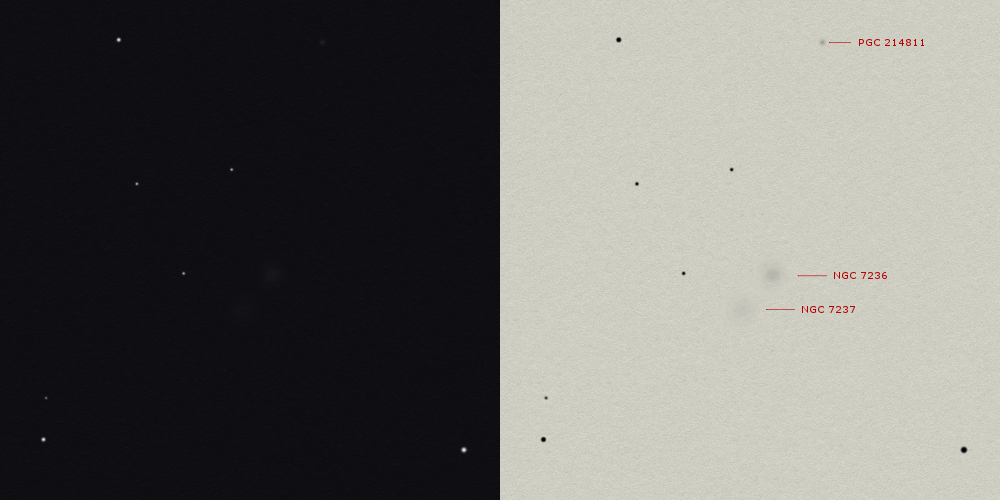
NGC 7236 and NGC 7237 are clearly seen separated and are both small and round. NGC 7236 is brightest, but can’t quite be seen with DV. Centrally it’s a tad brighter. NGC 7237 is only seen with AV as a smooth glow. slightly further in the field PGC 214811 can be picked up with AV, appearing starlike.
Arp 170 – NGC 7578 group, Hickson 94
NGC 7578A: mag 14.4, size 1.4′ x 1.4′
NGC 7578B: mag 15.0, size 1.0′ x 1.0′
PGC 70936: mag 16.3, size 0.3′ x 0.2′
Challenge: Faint members of Hickson group, and counter-tail (P)
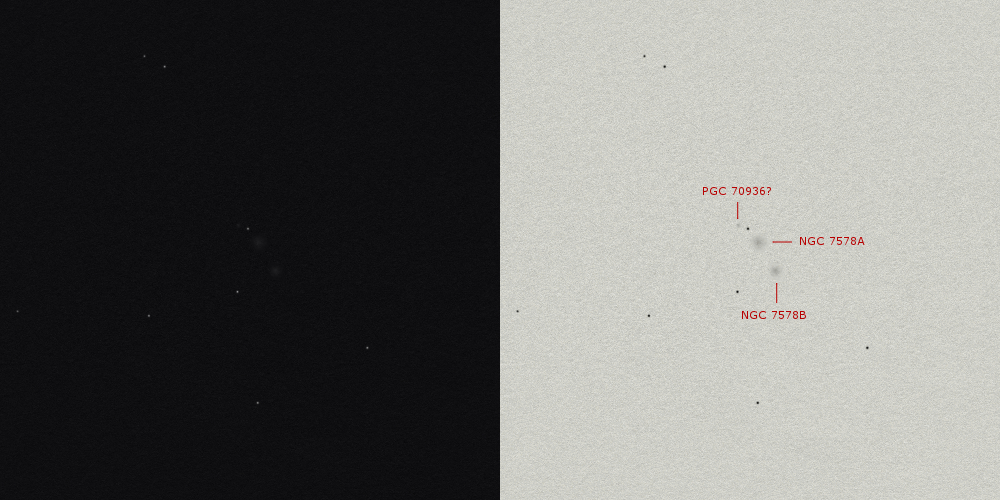
This is a very compact group of many galaxies, of which two are quite easily seen (with AV). NGC 7578A is in the center as a small and round glow, just a bit brighter than NGC 7578B SW of it, which shows a similar size and shape. In the extension of these two a mag 14 star is seen. Very close to this star PGC 70936 seems to blink now and then in and out of view as a very dim star, but it’s a doubtful observation. I did not observe any other members of the Hickson group, while 94C just a bit further away should not be a very big problem to see.
Arp 171 – NGC 5718 and IC 1042
NGC 5718: mag 13.9, size 1.4′ x 1.0′
IC 1042: mag 14.3, size 1.0′ x 0.9′
Challenge: Wisps E and W of IC 1042, brighter area E of NGC 5718, and the faint SDSS companion (N)
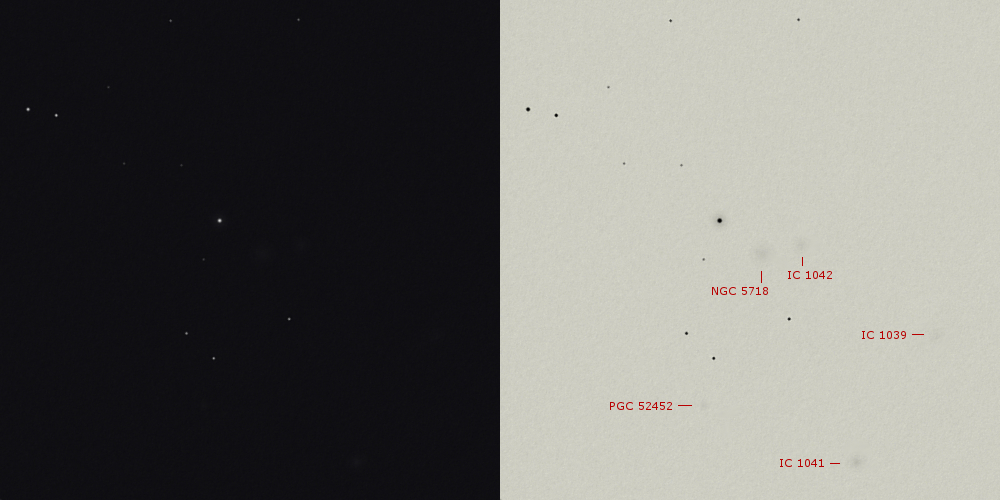
Nice field, filled with stars and galaxies. First the Arp pair: NGC 5718 and IC1042. Of these two the first is the brightest and slightly larger, just seen with DV. The IC is only seen with AV. Both are round. A bit to the S, but still within the field of view, IC 1041 is easily seen. About as bright as the NGC, but smaller and with some central brightening. In between there is IC 1039, hard to see with AV, small and round. Also PGC 52452 is visible, but was noted as a dim star, so it’s really small and dim.
Arp 172 – IC 1178 and IC 1181
IC 1178: mag 15.2, size 1.0′
IC 1181: mag 16.8, size 0.8′ x 0.7′
Challenge: Broad, curving counter-tails from both galaxies (N)
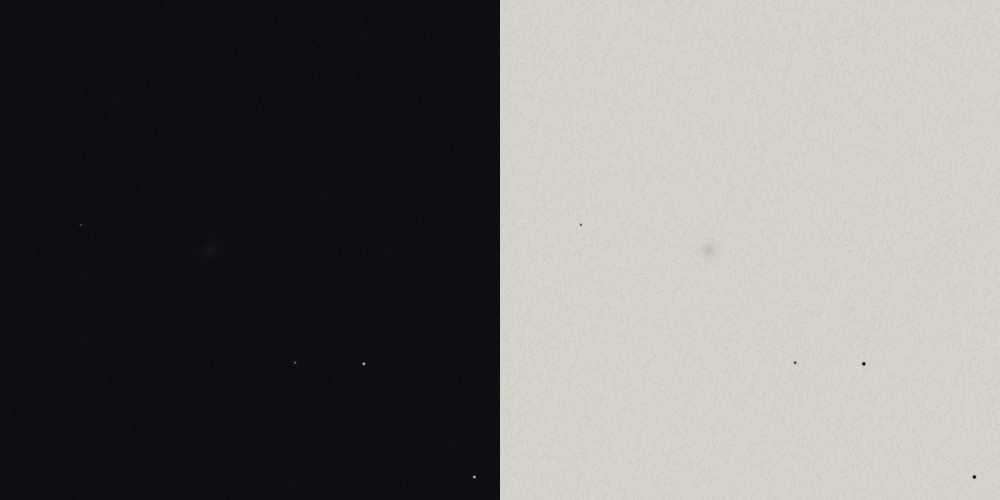
Part of AGC 2151, but only the Arp fields were visited. Two galaxies should be visible at Arp 172, but I see only one with AV, while afterwards looking at other people’s notes it strikes me that many of them see two galaxies. Strange… IC 1181 (or IC 1178) was definitely seen by me, but not IC 1181B. Consulting different sources on IC 1181B, I notice there is a big variety in the perceived magnitude. At m16.8 as in the Arp book by Jeff Kanipe it would almost definitely be out of reach for my 16″.
Narrow counter-tails (Arps 173 – 178)
Arp 173 – UGC 9561
MCG+2-38-19: mag 15.6, size 1.2′ x 0.2′
MCG+2-38-20: mag 15.0, size 0.6′ x 0.4′
Challenge: The plume S of -19, and the smaller plume NW of -20 (N)
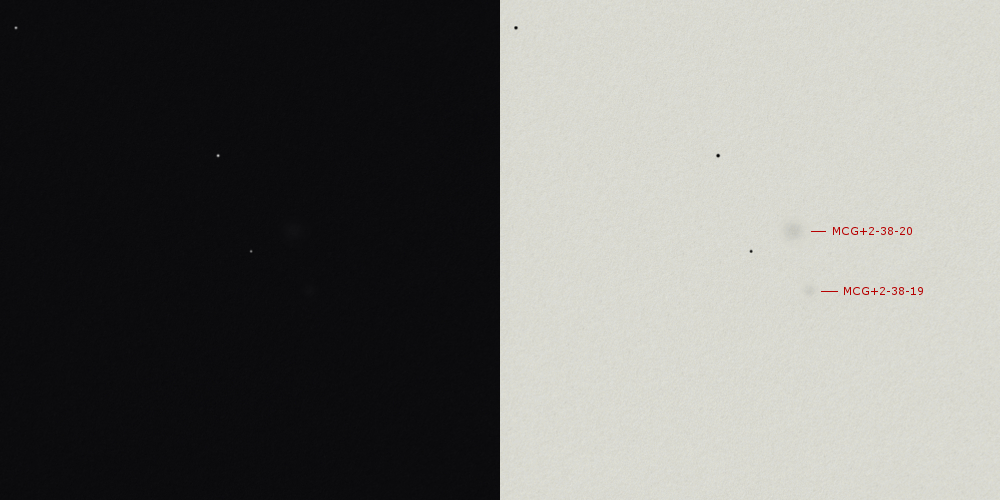
Two galaxies can be seen in a diamond shape with two stars. The brightest, MCG+2-38-20 is very dim, small and seen round with AV. MCG+2-38-19 is only seen with a lot of effort as a meaningless dot of light.
Arp 174 – NGC 3068 and companion
UGC 5353: mag 15.4, size 0.9′ x 0.8′
LEDA 87670: mag 16, size 0.2′
Challenge: Full extent of the long southern tail (N)
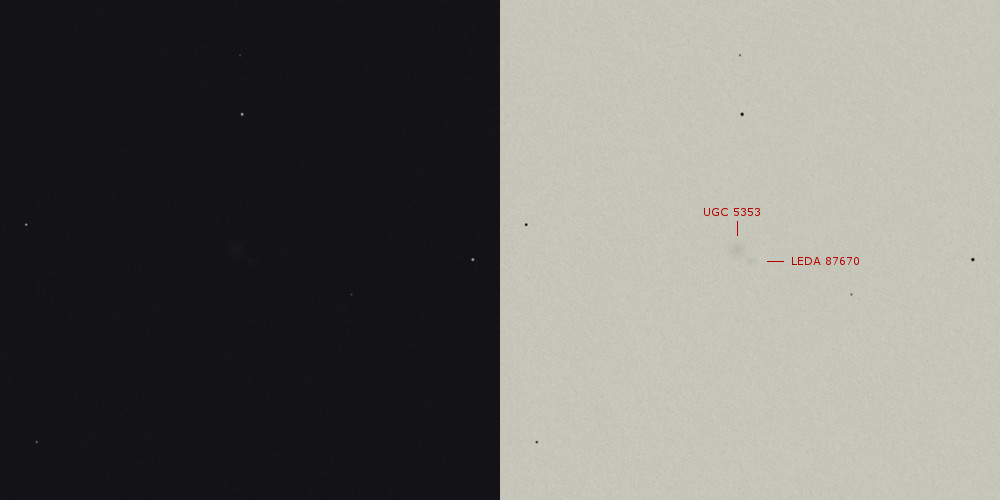
Two galaxies in close contact, but seen separated. NGC 3068 can be seen easily with AV, a bit brighter towards the center. NGC 3068B (LEDA 87670) is very small, almost stellar, and takes some more effort to be noted.
Arp 175 – IC 3481 and companions
IC 3481: mag 14.3, size 0.8′ x 0.6′
IC 3481A: mag 15.3, size 0.7′ 0.4′
IC 3483: mag 14.9, size 0.5′ x 0.4′
Challenge: Connections between the three galaxies (N)
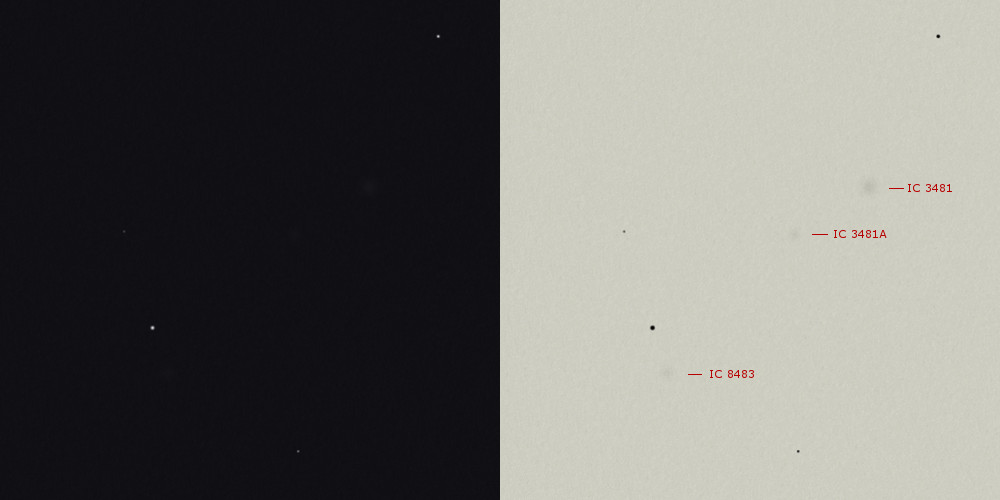
Three galaxies are visible, but connections are not seen. IC 3481 is the brightest and largest member, round, and can be seen with DV. IC 3481A is small and is difficult to spot with AV. IC 8483 is close to a bright star and takes some effort to see with AV as well, perhaps because of the star’s glare.
Arp 176 – NGC 4933 group
NGC 4933A: mag 15.2, size 1.0′ x 0.8′
NGC 4933B: mag 12.7, size 1.8′ x 1.1′
NGC 4933C: mag 15.3, size 0.4′
Challenge: Tails from 4933A and absorption in B (N)
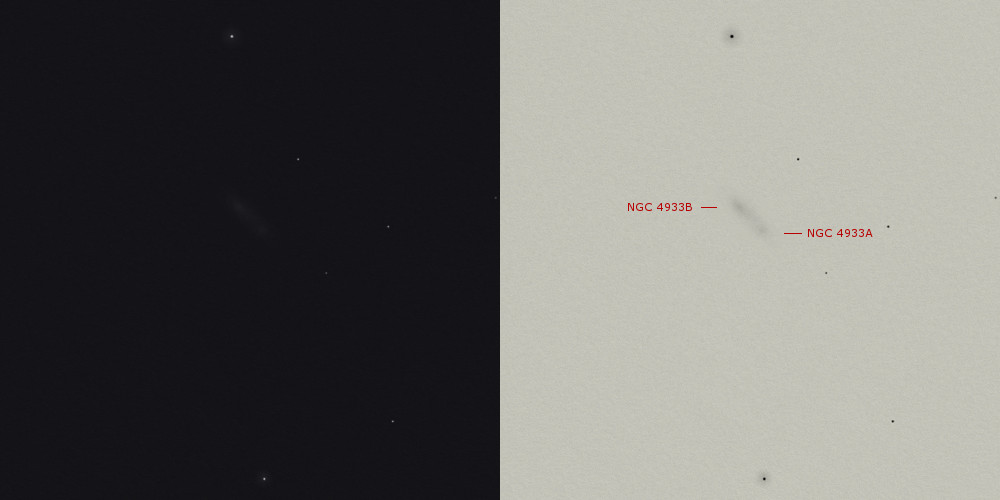
Two galaxies seen with DV: NG 4933A and NGC 4933B. A is small and round. In a common oval shaped nebulosity at the other tip B can be seen as slightly brighter, larger and with an oval core area. Together, the galaxies appear as a line. NGC 4933C was not seen.
Arp 177 – MCG+4-35-16 and -17
MCG+4-35-16: mag 18.0, size 0.4′ x 0.3′
MCG+4-35-17: mag 17.3, size 0.2′ x 0.2′
Challenge: All three components and asymmetry in -16 (N)
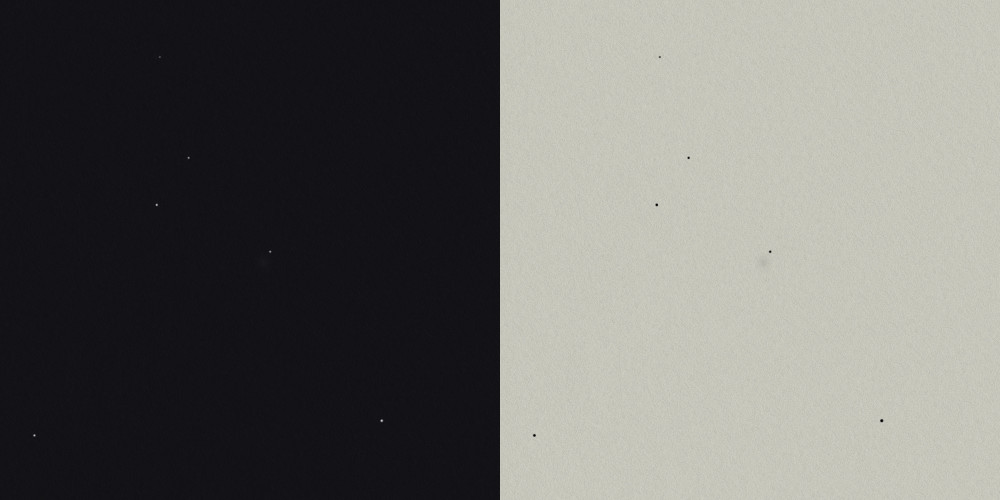
Two galaxies seen as one, or probably only MCG+4-35-17. Third component not seen. Small woolly dot seen with AV against, but separated from a dim star. Not extremely difficult.
Arp 178 – NGC 5613 through NGC 5645
NGC 5613: mag 15.5, size 0.5′ x 0.4′
NGC 5614: mag 12.5, size 2.5′ x 2.0′
NGC 5615: mag 17.8, size 0.1′
Challenge: Bright inner and faint outer rings in 5613, off-center ring in 5614, plume of 5615 (N)

Three galaxies are supposedly visible, but NGC 5615 is clearly out of reach with a magnitude of 17.8. Besides, the galaxy is stellar and very close to NGC 5614, so very high power would be needed to seperate them. NGC 5614 is very bright and very easily seen with DV. It’s round and with a bright core. With some effort, NGC 5613 is seen too a bit more remote.
Narrow filaments (Arps 179 – 193)
Arp 181 – NGC 3212 and NGC 3215
NGC 3212: mag 14.0, size 1.1′ x 1.0′
NGC 3215: mag 13.1, size 1.1′ x 1.1′
Challenge: Westward filament in NGC 3212 (N)
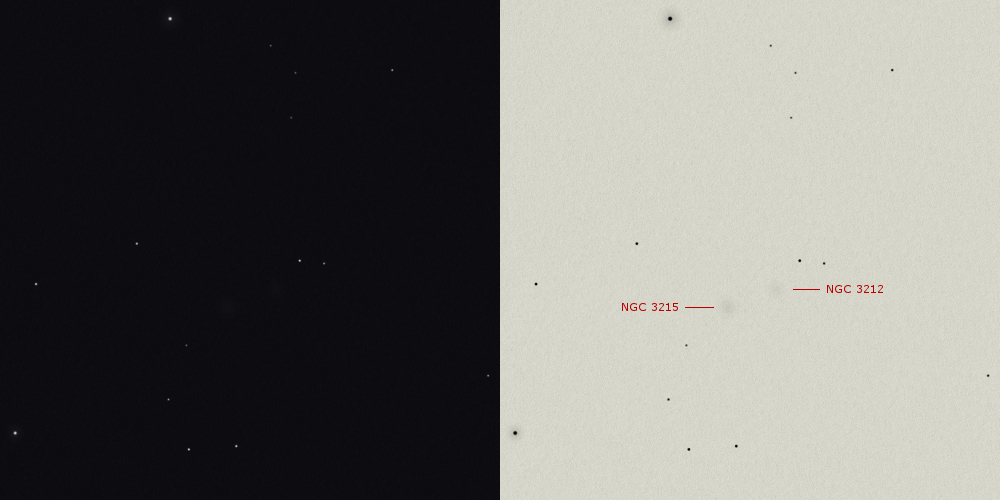
Two tiny galaxies with a very small difference in brightness and size, NGC 3215 the best visible of both. Both visible with AV only and no influence on each other is seen. No spiral structure and filaments.
Arp 182 – NGC 7674 Group, Hickson 96
NGC 7674: mag 13.9, size 1.1′ x 1.0′
NGC 7675: mag 14.8, size 0.6′ x 0.5′
MCG+1-59-81: mag 16.1, size 0.4′ x 0.3′
PGC 71507: mag 17.1, size 0.2′ x 0.1′
Challenge: Long straight, very faint filament like bow wave from companion (N)
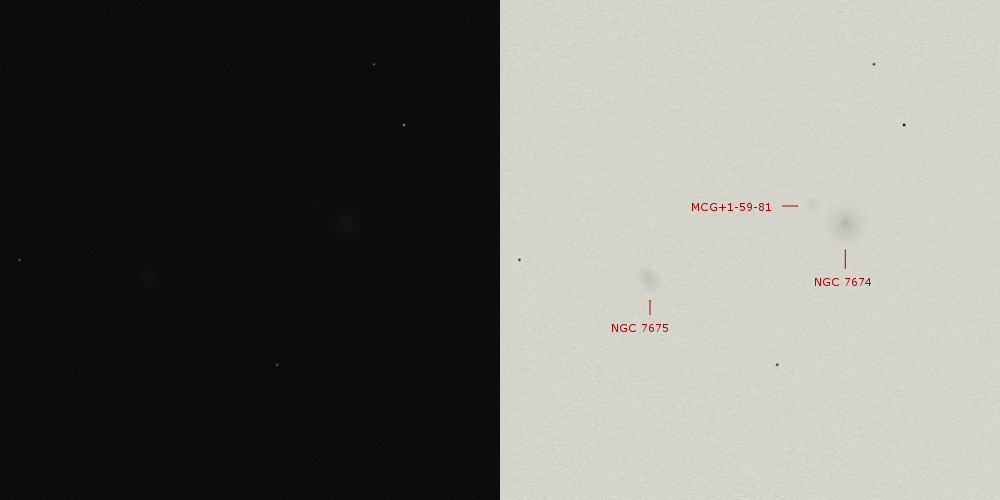
Compact group of four galaxies, of which three are visible. Also known as Hickson 96.
NGC 7674 is the largest and brightest member, brightening towards the core en with a large surrounding glow. No spiral structure is visible. A very small and dim galaxy is just next to it: MGC+1-59-81. This one is only seen with AV, but still set loose from its neighbour. NGC 7675 can just be seen with DV as a small oval, the PA can be seen. There is no brightening towards the core. PGC 71507 is out of reach for now, but should be possible from an even darker location.
Arp 183 – UGC 8548
mag 15, size 1.3′ x 0.6′
Challenge: Knots, especially in south arm (N)
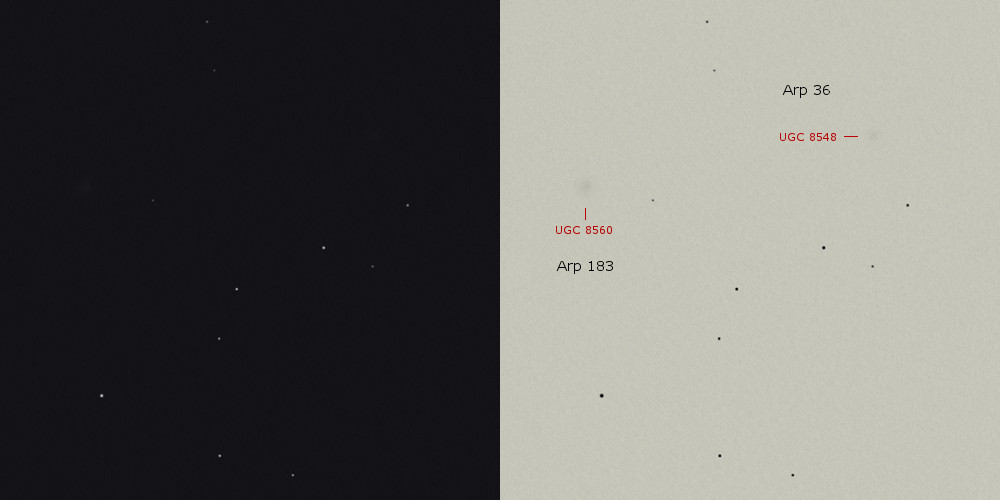
Could be seen quite easily with AV as a round galaxy without any further details. In the same field as Arp 36.
Arp 184 – NGC 1961
mag 11, size 4.6′ x 3.0′
Challenge: The filaments (P)
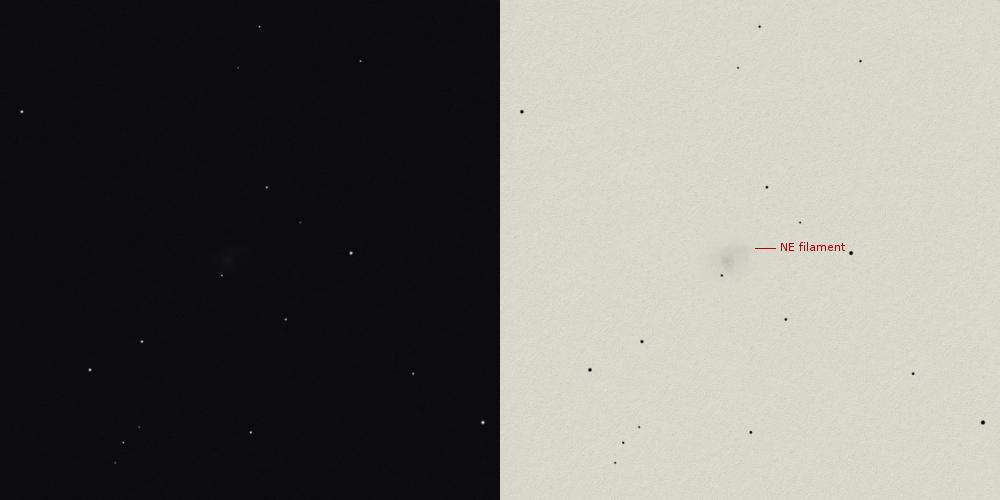
Soft oval glow, just visible with direct sight. Hard to see spiral structure, but after longer observation the filament on the NE side is recognized. Also the nebulosity between the core and the dim star to the S seems a bit brighter, which make the shape of the galaxy look like a mushroom.
Arp 185 – NGC 6217
mag 11.2, size 3.0′ x 2.5′
Challenge: outer filaments (N)
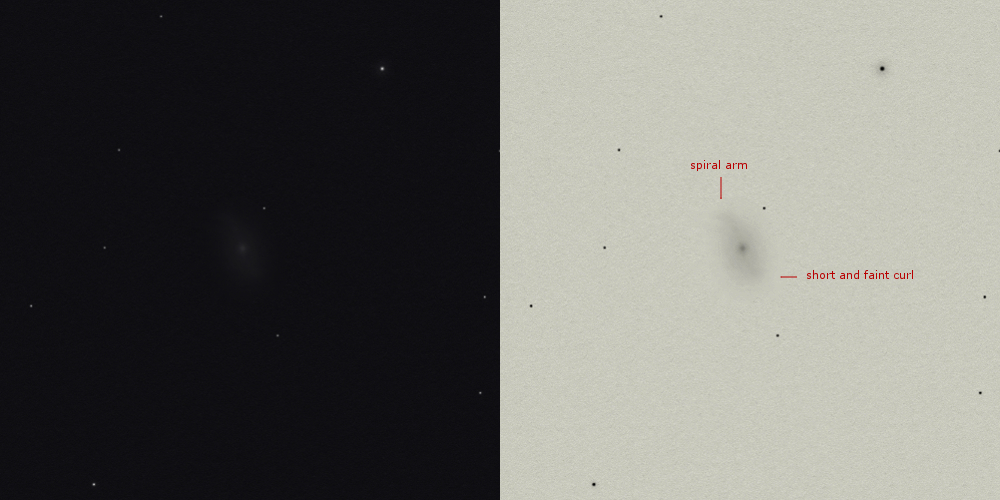
Bright galaxy with stellar nucleus. The start of the N arm can be seen with AV, curling to the E. The S arm is more difficult. Only the start can be seen with AV, but the curl is dimmer and shorter than the N arm. The filaments are invisible.
Arp 188 – UGC 10214, The Tadpole
mag 14.4, size 3.6′ x 0.8′
Challenge: Unusual spiral structure and filament (N)
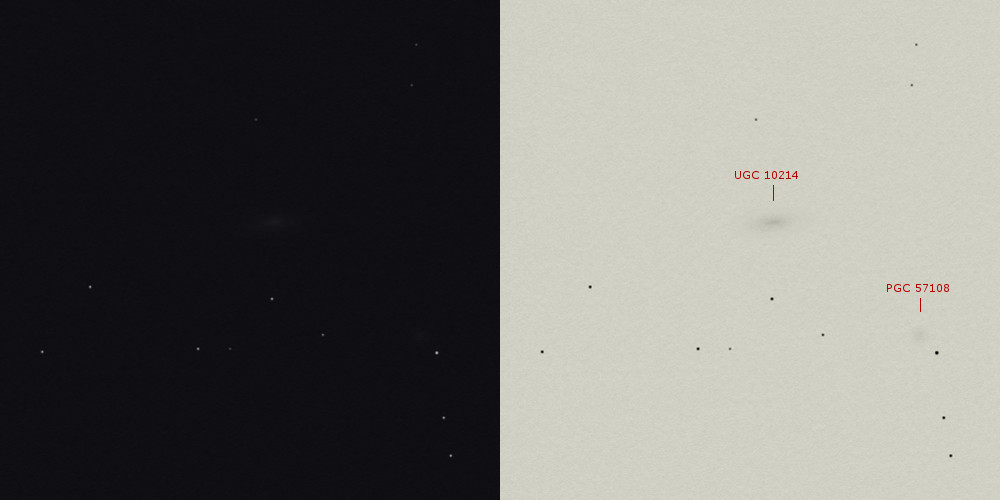
On different nights I tried to see the tail, but even under these ideal circumstances I could not spot it. The galaxy itself is bright and shows some central brightening. The shape is oblong. It resides in a nice starfield, together with PGC 57108 (seen quite easily against a star).
Arp 189 – NGC 4651
mag 10.8, size 4.0′ x 2.7′
Challenge: Tail to E, short arc at end of tail, short counter-tail W (N)
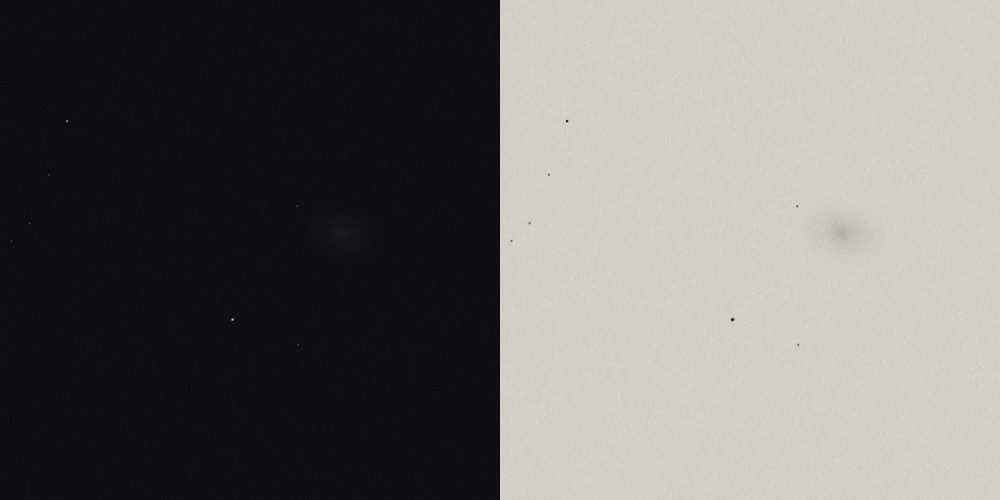
Large and very bright oval, brighter towards the center. Almond shaped, bright core. This galaxy is very mottled and spiral structure is suspected, but difficult to trace.
Arp 190 – UGC 2320: MCG+2-8-14 and -15
MCG+2-8-14: mag 15.4, size 0.7′ x 0.6′
MCG+2-8-15 (1): mag 15.2, size 1.7′ x 0.4′
MCG+2-8-15 (2): size 0.6′ x 0.5′
Challenge: Northern filament (N)
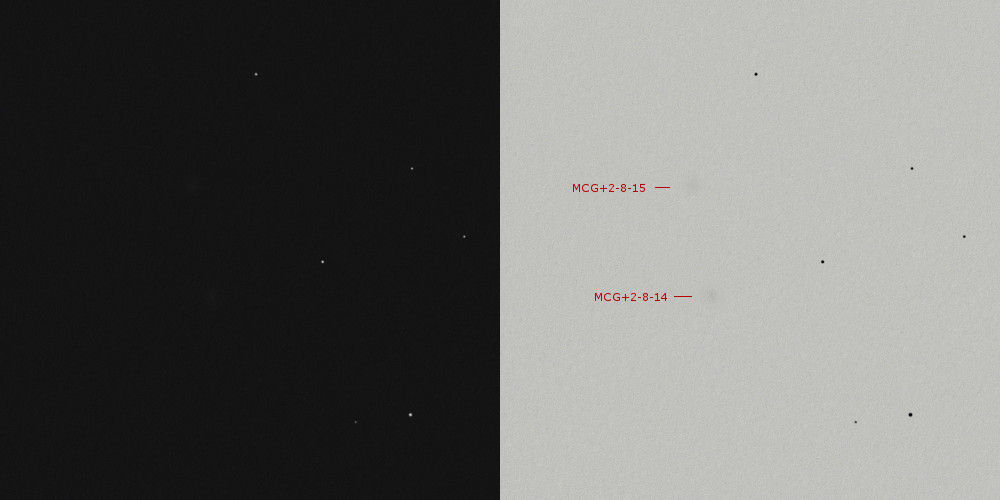
This pair is easy to miss, but the galaxies are both seen after a while with some effort. MCG +02-08-014 (UGC 2320A) can be seen glowing now and again as a round dot. MCG +02-08-015 is more difficult, but could be confirmed as well. The filaments were not seen.
Arp 191 – UGC 6175: MCG+3-28-62/-63
MCG+3-28-62: mag 16.0, size 0.3′ x 0.2′
MCG+3-28-63: mag 14.7, size 1.3′ x 0.7′
Challenge: Plume from -63, stellar-like objects N and S of nucleus (N)
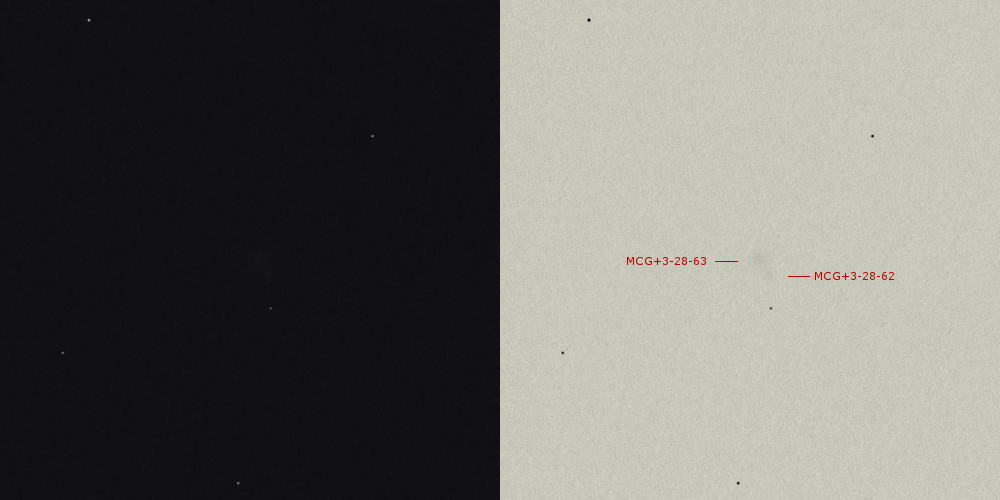
Nice couple, but dim and small. MCG+3-28-63 is the largest and brightest of the two and can be seen well with AV as a round dot. MCG+3-28-62 is smaller and only seen with effort with AV. At high power there is a clear separation between the two galaxies. Nearby a m15.5 star.
Arp 192 – NGC 3303
mag 14.5, size 3.1′ x 2.2′
Challenge: Large plume E, faint plume SW (N)
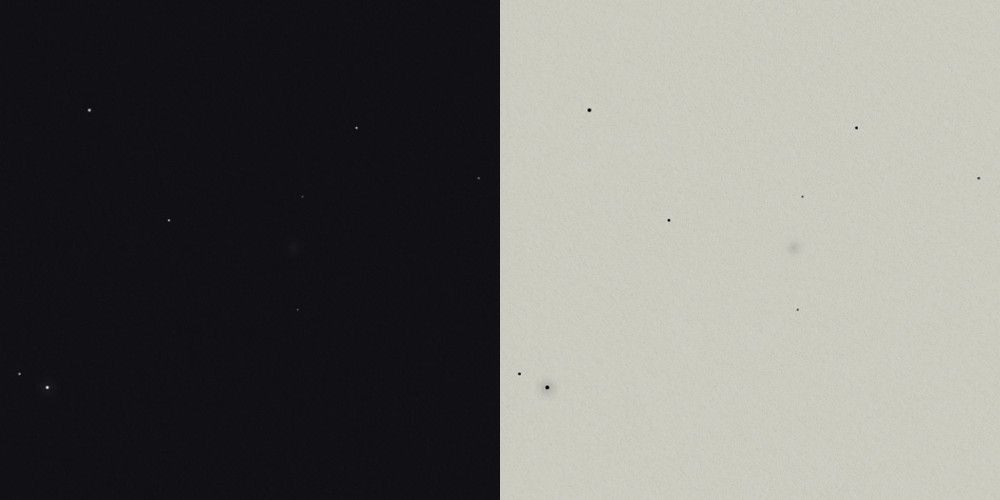
Could just be seen using DV. Round and without further details.
Arp 193 – IC 883
mag 14.4, size 1.6′ x 0.6′
Challenge: Detect the faint spikes or plumes (N)
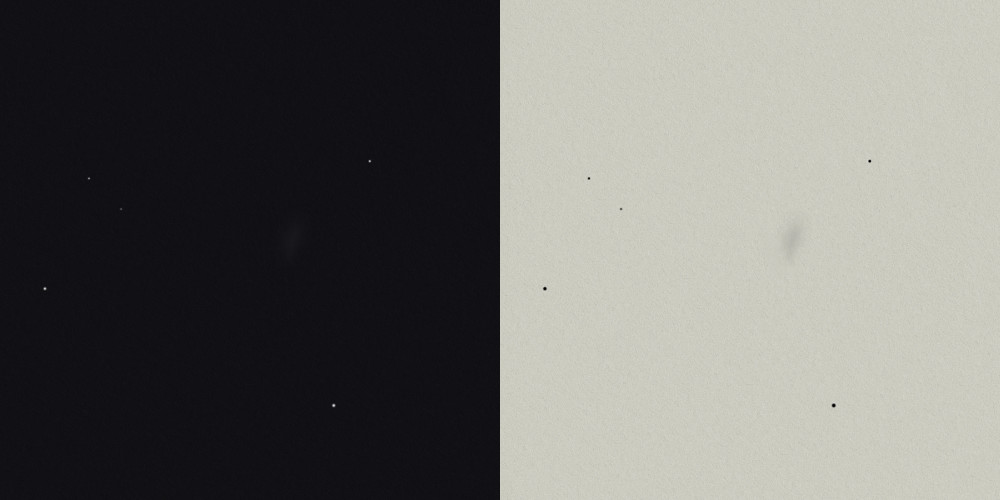
Oval shaped with hardly any brightening towards the center. The shape is slightly bent but this appearance may have been caused by an (invisible) m17 star at the tip. No plumes observed.
Arp 194 – UGC 6945
VV 126a: mag 15.8, size 0.4
VV 126b: mag 16.3, size 0.8′ x 0.6′
Challenge: Spiral arms in 126b, knots between a and b (N)
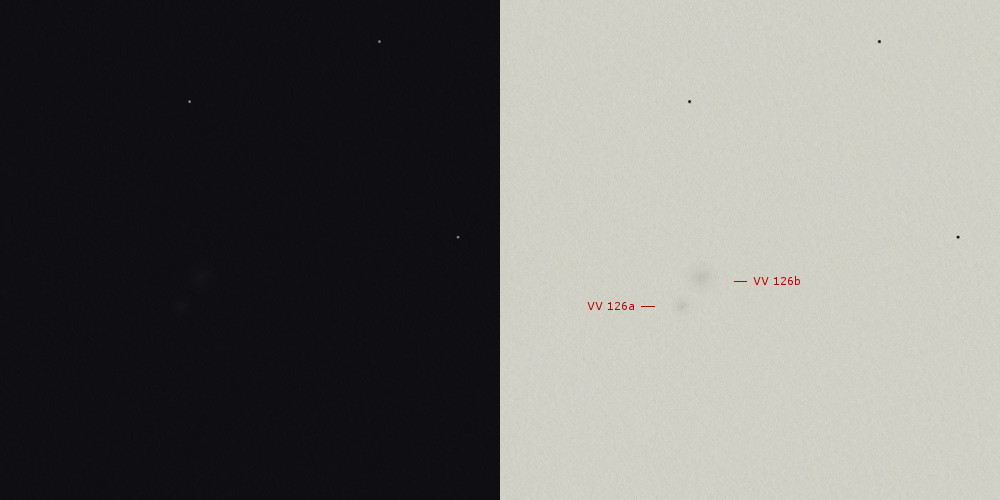
Two galaxies can be seen fairly well with AV, well separated at this high power. VV 126b is largest and only a tad brighter than VV 126a. Both appear round without any further details.
Material ejected from nuclei (Arps 194 – 208)
Arp 195 – UGC 4653
mag 14.5, size 1.9′
Challenge: Northern spike (ejecta?) (N)
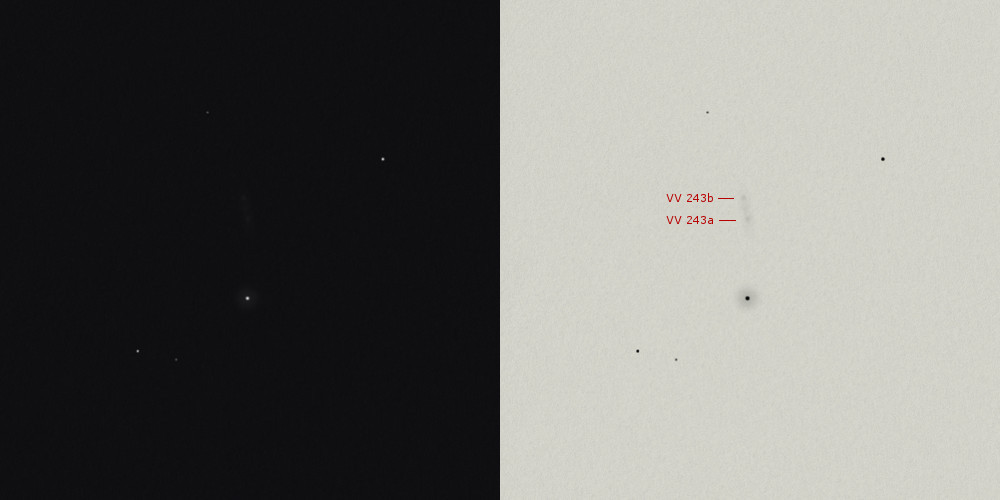
Dim, but seen as a ribbon with some knots in it with AV. Difficult observation.
Arp 196 – NPM1G +26.0311
NPM1G +26.0311: mag 16.0, size 0.5′ x 0.5′
NGP galaxy: mag 18.8, size 0.3′ x 0.1′
Challenge: Flattened ring and plume through companion (N)
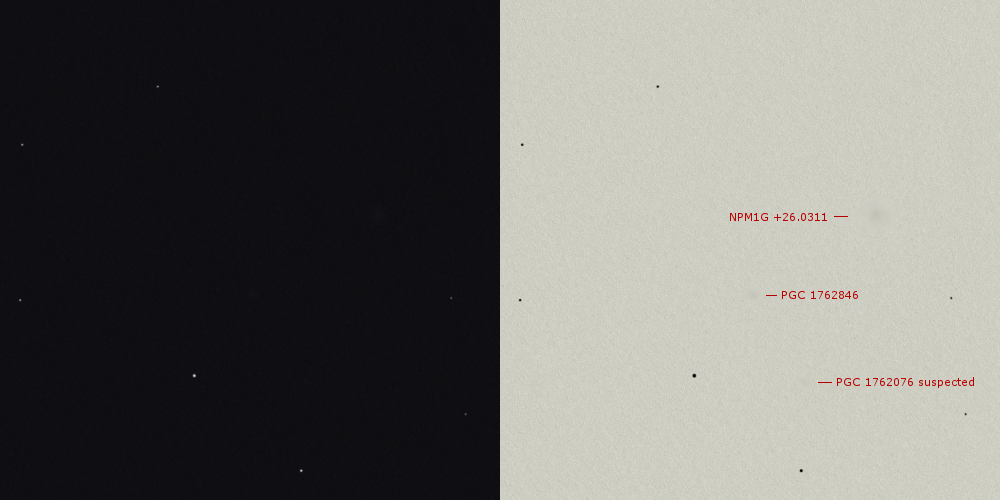
In the same field with Arp 60 (PGC 1762846). NPM1G +26.0311 is seen with AV as a round patch of light. Very dim, but not nearly as dim as Arp 60. A third (PGC) galaxy was suspected, but could not be confirmed.
Arp 197 – IC 701
mag 14.6, size 1.4′ x 0.7′
Challenge: Bar in VV 3a, visibility of 3b, and filiment between a and b (B=N)

Seen with AV as round, small and without any further details. Close to a nearby star, some nebulosity is observed, this is PGC 35485.
Arp 198 – UGC 6073
VV 267a: mag 15.2, size 1.3’x 0.8′
VV 267b: mag 15.3, size 0.9′ x 0.15′
Challenge: Separate the components, discern the wide, faint spirals in VV 267a (N)
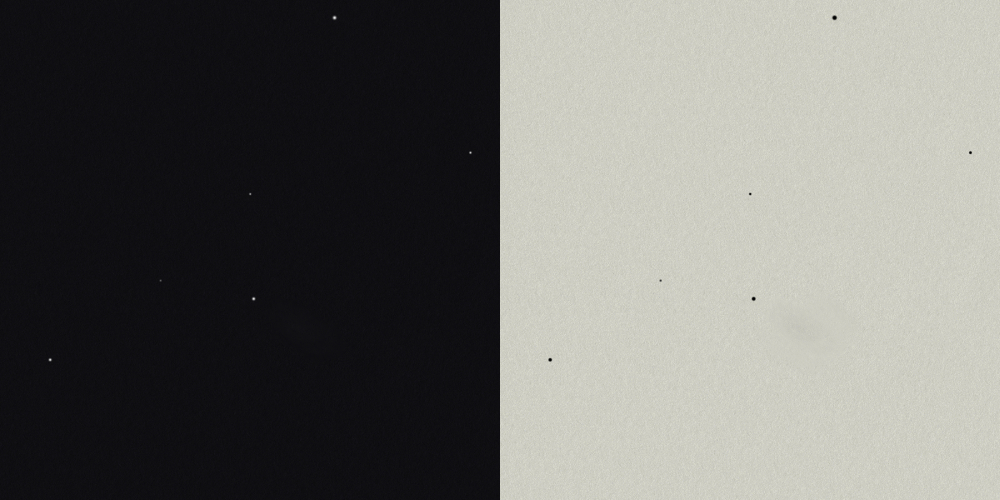
Very tough object, hard to find and only seen with effort with AV. Seen as one galaxy where the (or a) core zone is only suspected. The stretched glow is seen as if it is coming from a nearby star.
Arp 199 – NGC 5544 and NGC 5545
NGC 5544: mag 13.4, size 1.0′ x 1.0′
NGC 5545: mag 14.0, size 1.3′ x 0.4′
Challenge: Broken ring around 5544, NE arm of 5545 (N)

Nice, but dim pair, however both can be seen with DV. NGC 5544 and NGC 5545 are almost in touch with each other and appear to share the same envelope of nebulosity. NGC 5544 is the brightest of the two and has a round shape. NGC 5545 is stretched and points just besides its neighbour. Both galaxies show more brightness towards the center.
Arp 200 – NGC 1134
mag 12.1; size 2.5′ x 0.9′
Challenge: The asymmetry and emanations (N)

Clearly seen, oval and with some central brightening. A star is very close to it and on this side the galaxy looks flattened.
Arp 201 – UGC 224: MCG+0-2-18 and -19
MCG+0-2-18: mag 16.0, size 0.4′ x 0.2′
MCG+0-2-19: mag 16.4, size 0.7′ x 0.4′
Challenge: The “ejecta” (N)
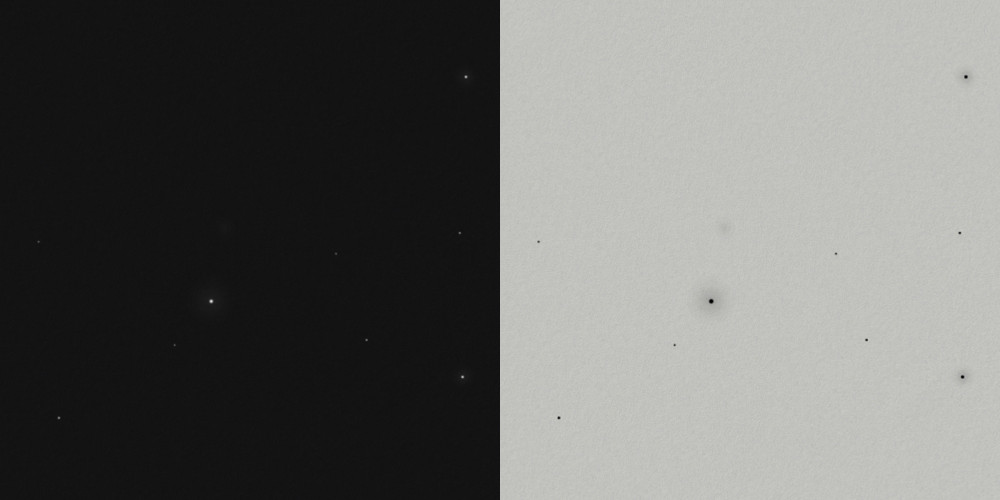
Not separated; seen as one small galaxy, hard to see with AV. Increasing magnification did not show more.
Arp 202 – NGC 2719 and NGC 2719A
NGC 2719: mag 14, size 1.3′ x 0.3′
NGC 2719A: mag 14, size 0.9′ x 0.6′
Challenge: Triple core of 2719A and the faint tail (N)
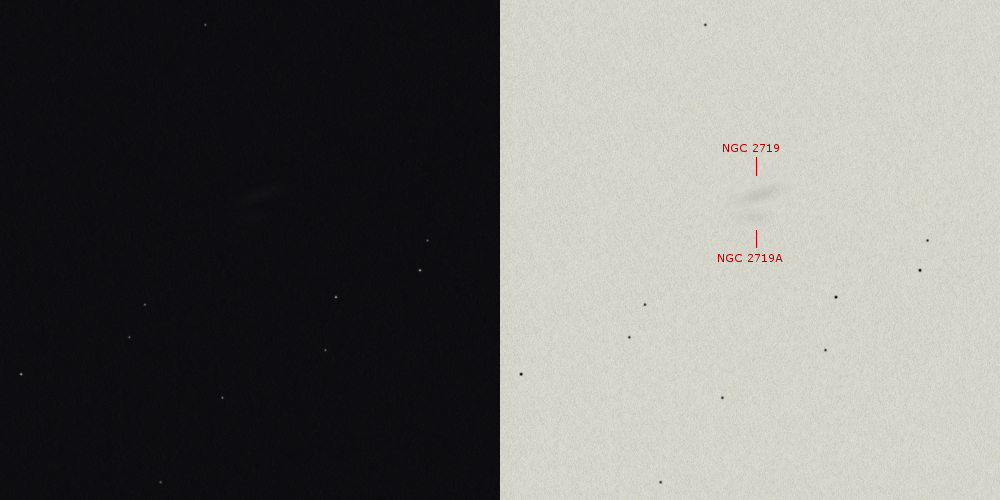
NGC 2719 can be seen directly as a needle pointing NW. Almost parallel to it is a smaller, dimmer and a bit broader galaxy: 2719A. It takes AV to clearly see it and to split the two galaxies.
Arp 203 – NGC 3712
mag 14.9, size 1.7′ x 0.6′
Challenge: Faint plumes (N)
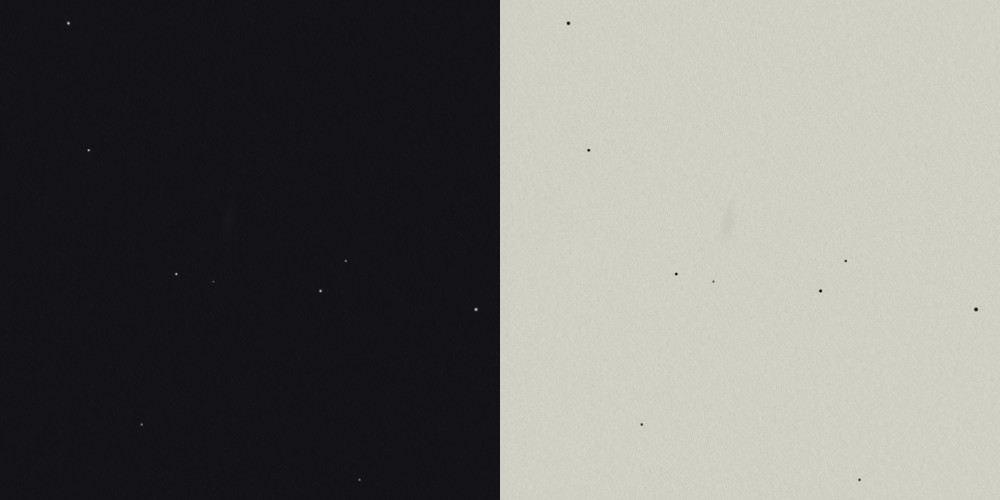
Very dim and hard to discern with AV, but length and direction can be noted. A very bright star nearby hinders the observation.
Arp 204 – UGC 8454: MCG+14-6-24 and -25
MCG+14-6-24: mag 15.6, size 2.5′ x 0.5′
MCG+15-6-25: mag 16.0, size 0.6′ x 0.2′
Challenge: Faint bridge between the two galaxies (N)
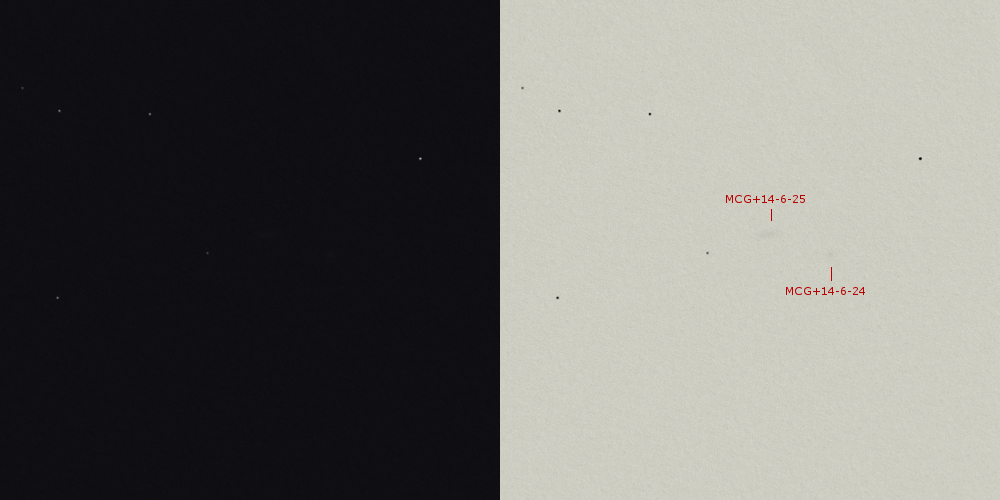
Very faint pair. Only found after a long time and confirmed after prolonged observation. MCG+14-6-24 is blinking now and then into averted visibility, small and round. MCG+4-6-25 is hard to see with AV, but the long shape and directed can be noted. The two galaxies are not connected.
Arp 205 – NGC 3448 and companion
NGC 3448: mag 12.0, size 4.8′ x 1.4′
MCG+9-19-52: mag 17.0, size 2.1′ x 1.2′
Challenge: Wisps to E and W of NGC 3448, asymmetry, and jet from MCG+9-19-52 (N)
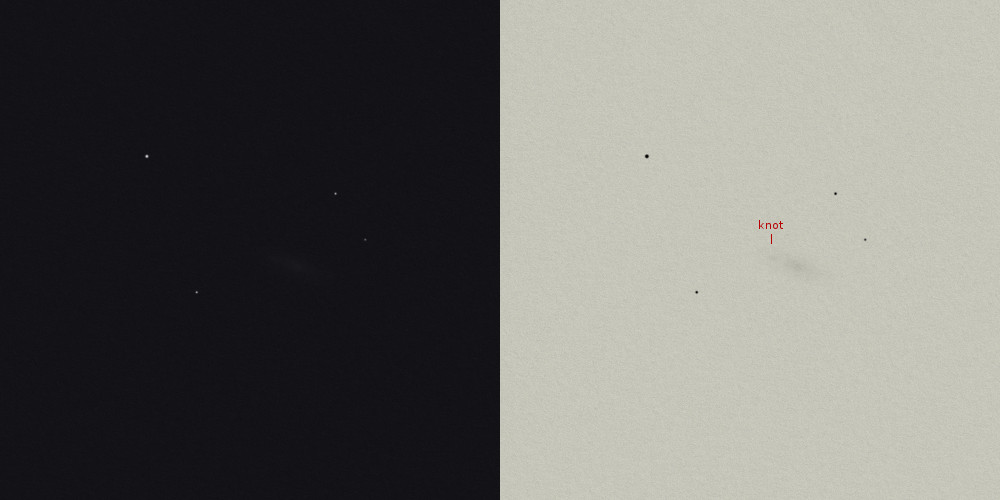
Bright galaxy, easily seen directly and with some details. Wingshape (3:1) and a brighter core. Knot at E tip, seen with AV.
Arp 206 – NGC 3432 and companion
NGC 3432: mag 11.7, size 6.8′ x 1.5′
UGC 5983: mag 17, size 1.2′ x 1.0′
Challenge: Detect UGC 5983 and the faint detached element in NE side of NGC 3432 (N)
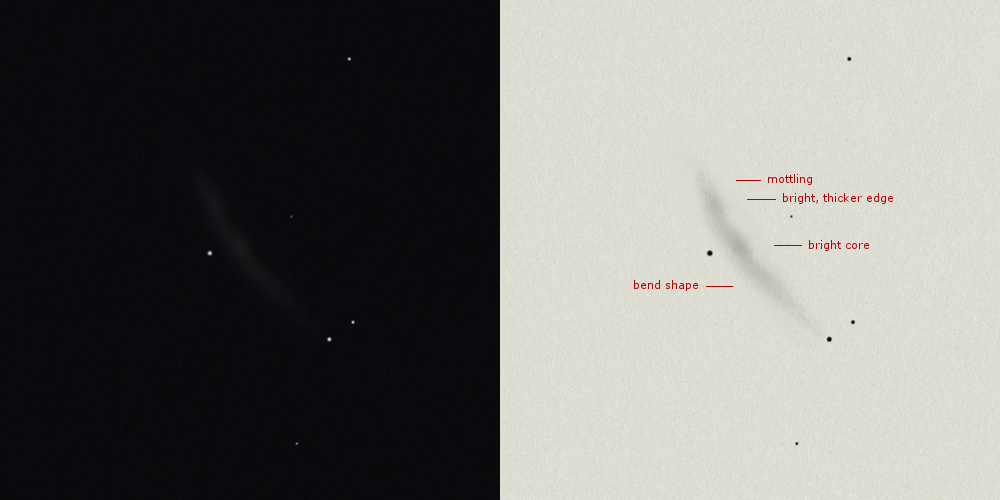
Beautiful edge-on with lots of detail to be seen, captured between some bright stars. The galaxy is very long and the shape is slightly bend. The core is stretched and clearly brighter. At the NE side a bulge can be seen as a brighter patch. A bit further NE (at the tip) clear mottling is noted. Unfortunately, the companion could not be detected.
Arp 207 – UGC 5050
mag 15.4, size 1.2′ x 0.2′
Challenge: Full extent of emanation to the SW (N)

Small streak of light against a dim (m14.5) star, seen only with AV. The direction was difficult because the galaxy is rather short.
Arp 208 – MCG+8-31-9, -10, and -11
MCG+8-31-9: mag 17.0, size 0.7′ x 0.1′
MCG+8-31-10: mag 16.0, size 0.4′ x 0.3′
MCG+8-31-11: mag 16.0, size 0.4′ x 0.3′
Challenge: Knots in the loop of -10 and -11 (N)

A comma-shaped galaxy is seen with AV with some difficulty amidst a wealth of stars. MCG+8-31-10 and MCG+8-31-11 are not separated, but seen as one. MCG+8-31-9 is not in reach of my 16″ and is missed.
Irregularities, absorption and resolution (Arps 209 – 214)
Arp 209 – NGC 6052
mag 13, size 0.9′ x 0.7′
Challenge: Oblong core and line of knots (P)
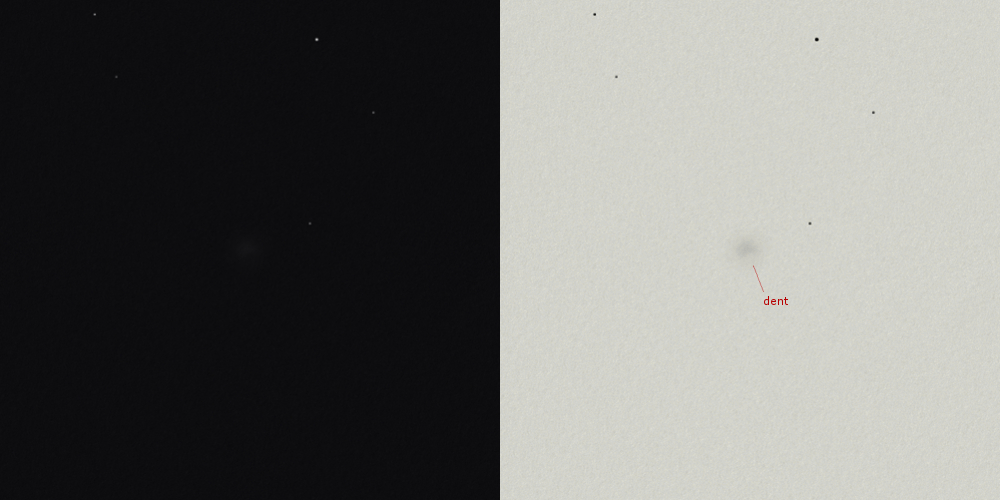
Pretty dim galaxy and very small. The core is a bit brighter with around it a round glow. High magnification reveals a comma shape, as if the galaxy has a dent on one side.
Arp 210 – NGC 1569
mag 11, size 3.7′ x 1.8′
Challenge: Mottling and absorption structures at NW and SE (N)
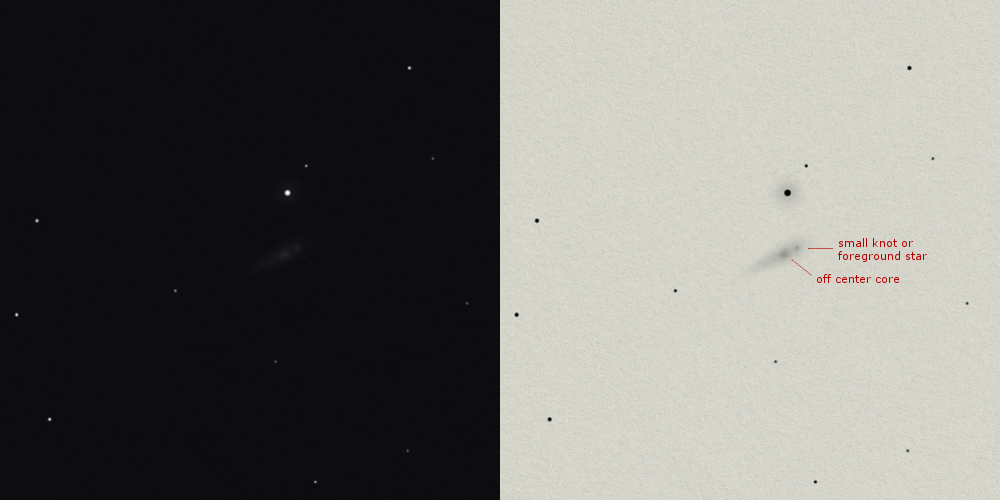
This is a pretty bright galaxy and can be well seen with DV. It appears comet-like; the W side is longer and broader. The obvious core is placed a bit off-center and at the W side of the core a small knot can be detected, almost touching the core. Not sure if this is a foreground star or something different. High magnification is needed to see the “double core”.
Arp 211 – MCG+7-26-33 and -34
MCG+7-26-33: mag 17, size 0.3′ x 0.3′
MCG+7-26-34: mag 16, size 0.3′ x 0.3′
Challenge: Multitude of tiny, starlike knots (N)
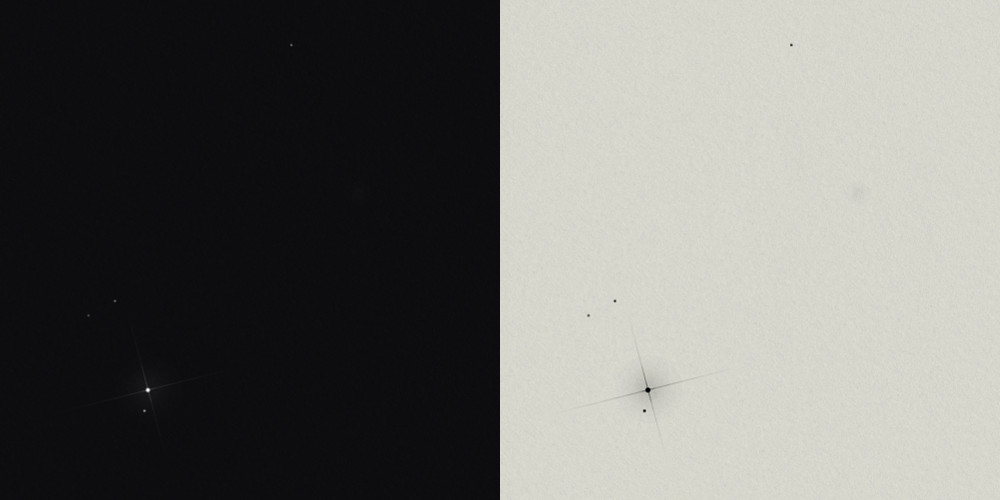
Extremely hard. Blinks up only 30% of the time, and only when the m7.4 star is kept out of the field of view. Seen as one galaxy; could not be separated into two components.
Arp 212 – NGC 7625
mag 12.1, size 1.6′ x 1.5′
Challenge: Detect the absorption tubes (N)
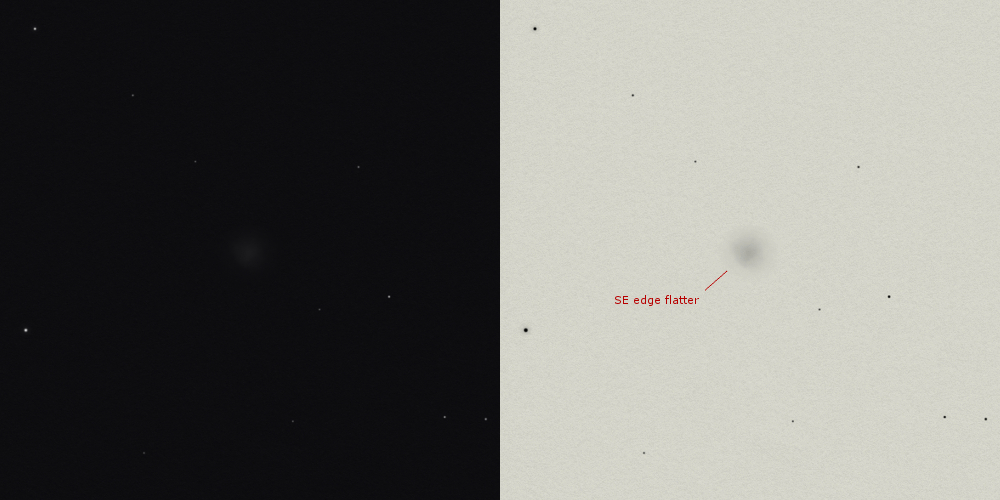
Compact and bright galaxy, easily seen. The core is not stellair but gets brighter towards the center. A mag 6 star is just outside the field. The edge is soft, but appears flattened in the SE, this gives the galaxy a triangular shape. The absorption tubes were not seen.
Arp 213 – IC 356
mag 10.5, size 5.3′ x 3.9′
Challenge: The absorption lanes (N)

Pretty bright and large galaxy. The core is small and bright and from there the outer glow dissipates very softly into the sky background. The shape is slightly elongated and there’s a dim star on the NE edge. The absorption lanes are not seen.
Arp 214 – NGC 3718
mag 10.7, size 9.2′ x 4.4′
Challenge: Long tails N and S, absorption features nearer nucleus, the three “barbs” to the E, and the wide outer loops (P)
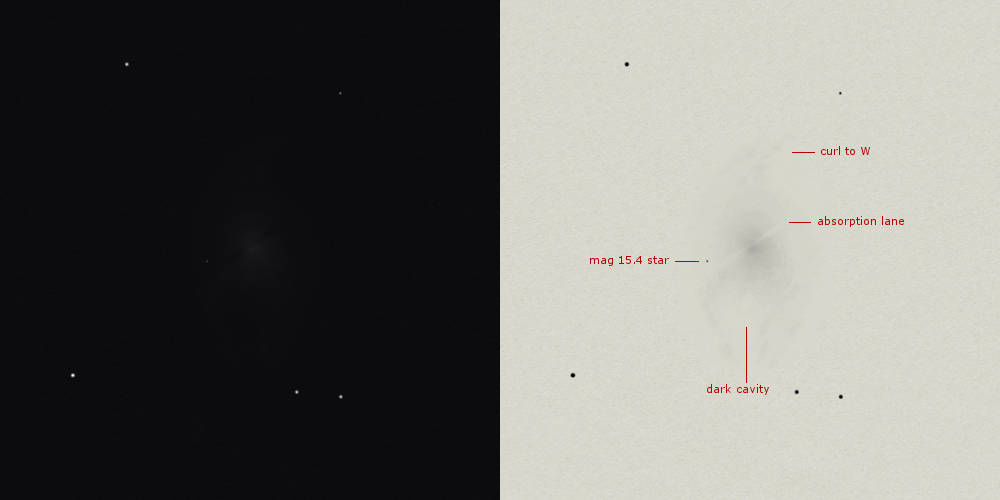
Unexpected showpiece. There is much to see; a large galaxy with a bright core zone and a dust lane crossing through it. The core can’t be split at this magnification though. To the S, the spiral structure is showing a cavity which makes this part of the galaxy look like a “flame”. To the N, the nebulosity makes a curl to the W and on the E side a dim star can just be discnerned. Looks like a ghost version of the famous Hamburger Galaxy.
Adjacent loops (Arps 215 – 220)
Arp 215 – NGC 2782
mag 11.7, size 3.5′ x 2.6′
Challenge: Large faint halo with brighter area W of core and wing to E (N)
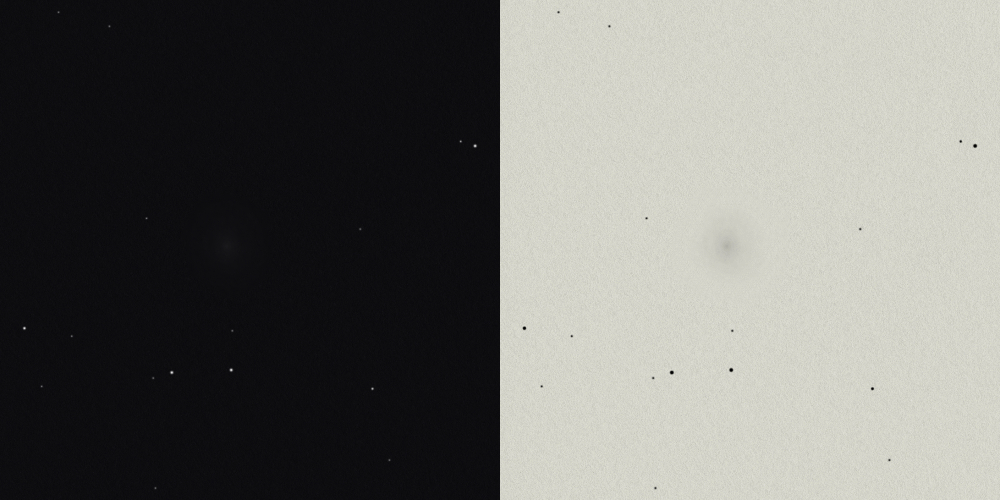
Bright galaxy that can be seen with ease. The shape is almost round, slightly oval en the PA is difficult to recognize. The 1/3 core area is very bright and appears almost stellar. At times, some of the brighter areas appear to surface, but it’s too uncertain to draw any of it.
Arp 216 – NGC 7679 and NGC 7682
NGC 7679: mag 12.9; size 1.4′ x 0.9′
NGC 7682: mag 14.1; size 1.2′ x 1.1′
Challenge: Loop and patches (N)

Two small galaxies. NGC 7679 is the brightest, with some brightening towards the core. It appears perfectly round. NGC 7682 is a bit more oval shaped, is dimmer, but can still be seen with DV. No further details are visible.
Arp 217 – NGC 3310
mag 10.8, size 3.3′ x 3.0′
Challenge: Knots N of nucleus, arcs NW and SW, jet piercing NW arc (N)

This one is small and has a somewhat square shape. It shows strong mottling (like a bright “fuzzball”). During the sketching process a small loose segment catches my attention just E of the galaxy. A nice bonus, because I don’t see any of the other features. However, I can’t find any information on the segment so it could have been only in my imagination.
Arp 218 – MCG+3-40-57
mag 15.4, size 0.9′ x 0.5′
Challenge: Observe both S and N arms forming complete circles (N)
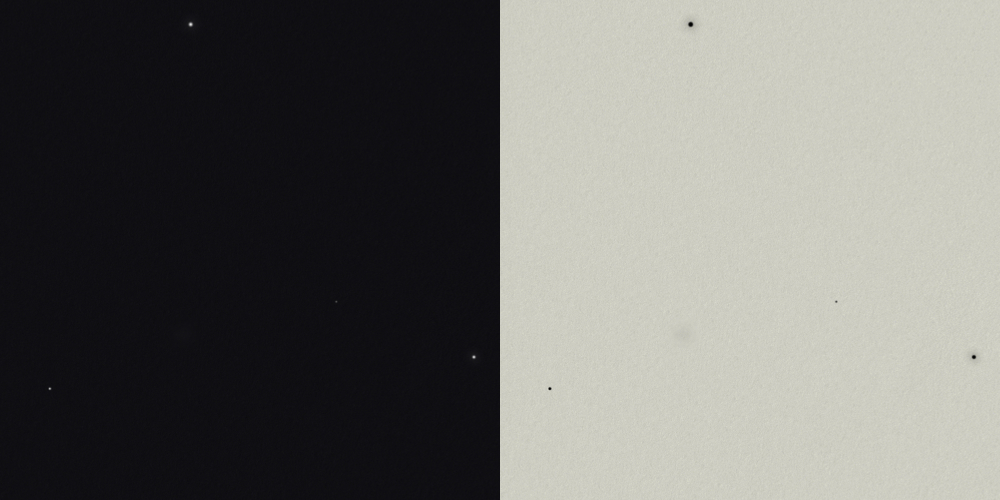
Difficult Arp, hard to see with AV and two bright stars disturb a good observation. Only one part of the galaxy is seen and can’t be held the whole time.
Arp 220 – IC 4553
mag 13.1, size 1.5′ x 1.2′
Challenge: Triangular envelope, two lobes of the nucleus, and faint arc to W (N)
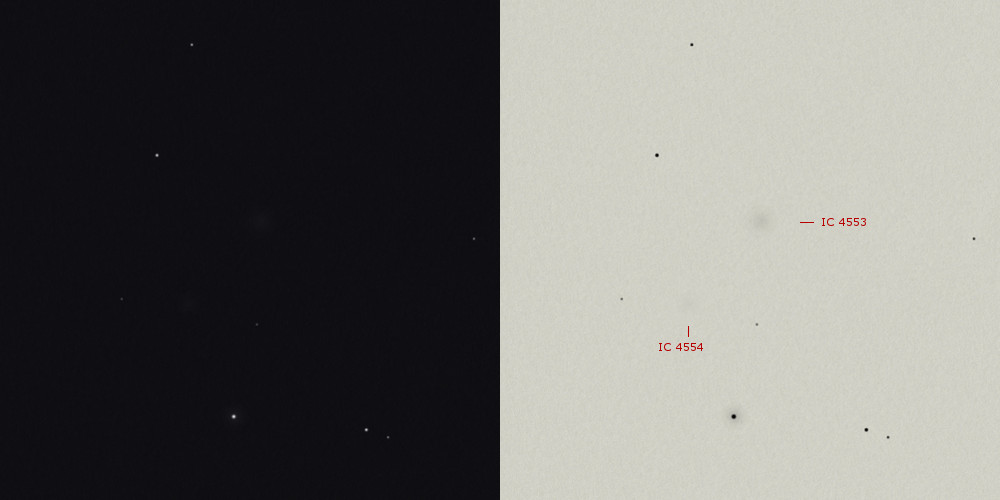
IC 4553 is quite bright and not too small, no triangular shape was observed; the galaxy appeared round. The very small and dim nearby galaxy IC 4554 was only spotted with AV with effort.
Amorphous spiral arms (Arps 221 – 226)
Arp 221 – MCG-2-25-6 and companions
MCG-2-25-6: mag 14, size 0.7′ x 0.6′
MAC 0936-1120: mag 18, size 0.4′ x 0.3′
W companion is mag 16
Challenge: Detect faint extension S and arm NE (N)
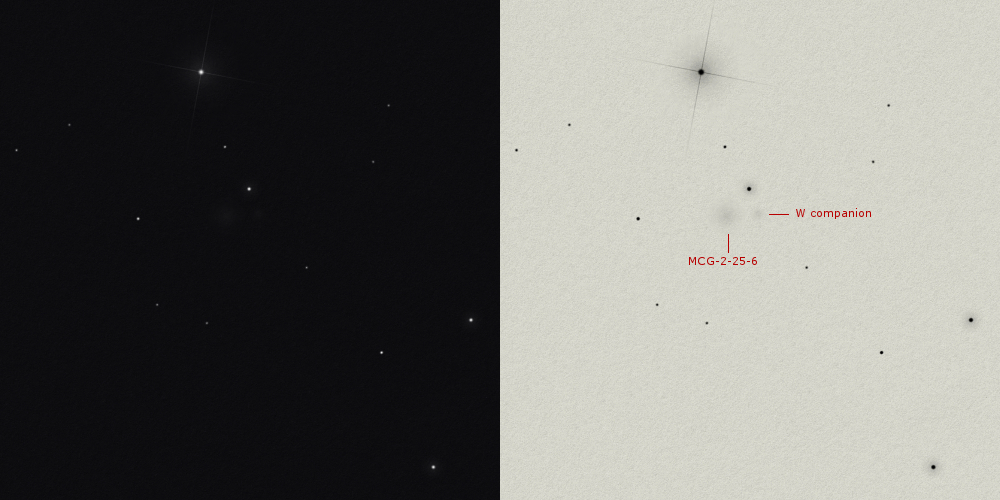
This is a really tight group. The core is just visible with DV of MCG-2-25-6. The tiny companion (that does not hold its own designation) is hard to see with AV. Together they form a triangle with a star. MAC 0936-1120 stays hidden, perhaps because a very bright star hinders the view.
Arp 222 – NGC 7727
mag 10.6, size 4.7′ x 3.6′
Challenge: Edges in the amorphous arms (N)
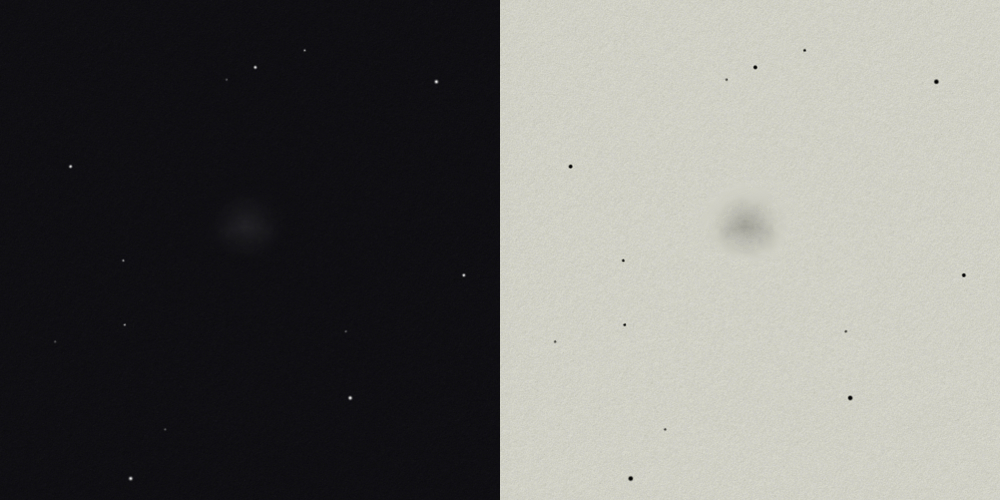
Fairly bright galaxy with obvious core zone. With AV the shape resembles that of a cradle, definitely not round. There is a noticeable ring of stars around the galaxy.
Arp 223 – NGC 7585
mag 11.4, size 3.0′ x 2.5′
Challenge: Lumpiness of the halo, E and NW (N)
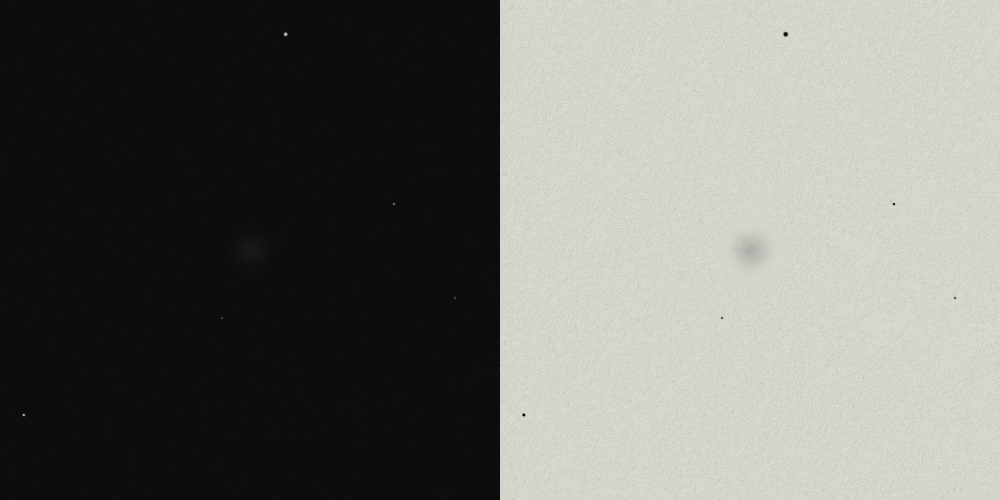
This galaxy is bright, round and looks like an elliptical. No details seen or even suspected.
Arp 224 – NGC 3921 and companions
NGC 3921: mag 12.4, size 2.1′ x 1.3′
SDSS companions are approximately mag 16
Challenge: Loop to S and faint tail further to S (N)
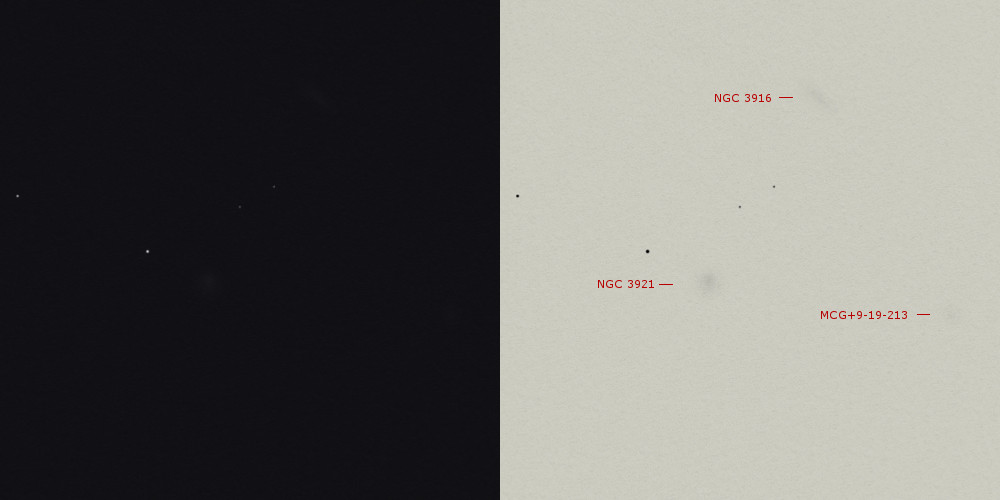
Three galaxies in one field of view; NGC 3921 is the brightest one and easily seen with DV. It’s round and the core appears to be slightly N of the middle. NGC 3916 can also be seen with ease, but it takes AV. It has a needle shape and the angle is noted. MCG+9-19-213 is the hardest one, but can just be seen against the sky background.
Arp 225 – NGC 2655
mag 10.1, size 4.9′ x 4.1′
Challenge: Faint amorphous arms and the texture in the SW part of the nucleus (N)
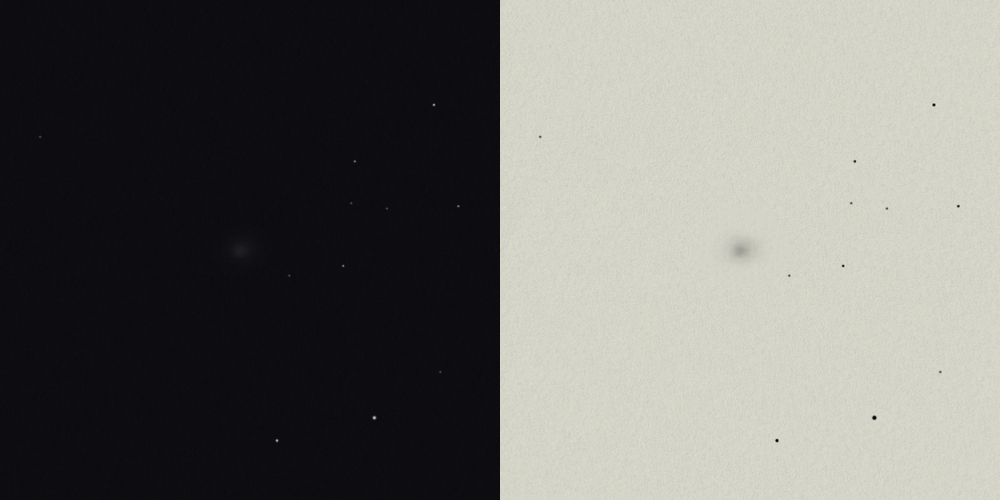
This is a bright galaxy with half core area and half soft outer halo. The galaxy is slightly oval shaped and the direction can just be guessed. No details are observed.
Arp 226 – NGC 7252
mag 11.4, size 3.8′ x 2.4′
Challenge: Long, almost straight, tails and the three loops that give the galaxy its nickname, the “Atoms for Peace” galaxy (N)
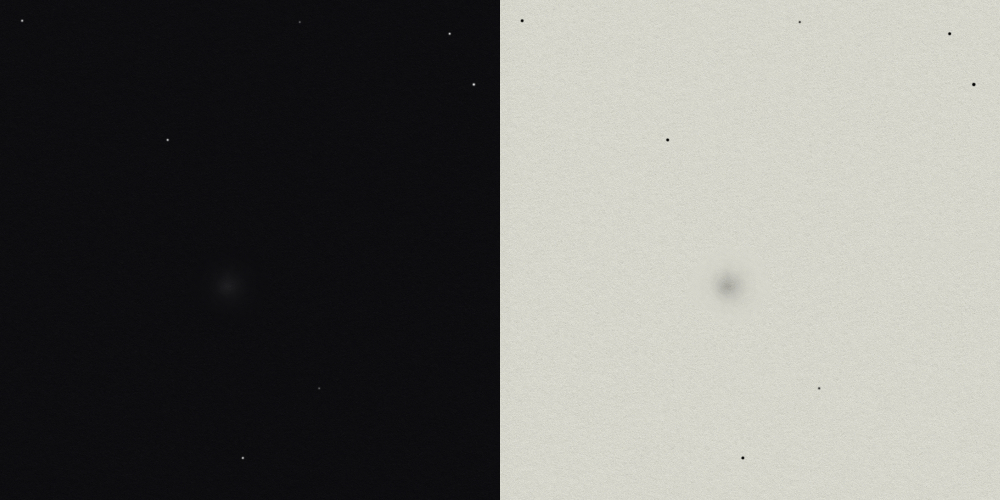
No details are seen, this galaxy appears pretty bright and round with an obvious core zone, almost stellar.
Concentric rings (Arps 227 – 231)
Arp 227 – NGC 470 and NGC 474
NGC 470: mag 12.5, size 2.8′ x 1.7′
NGC 474: mag 11.5, size 7.1′ x 6.3′
Challenge: Detect extremely faint rings or arms around NGC 474 (N)
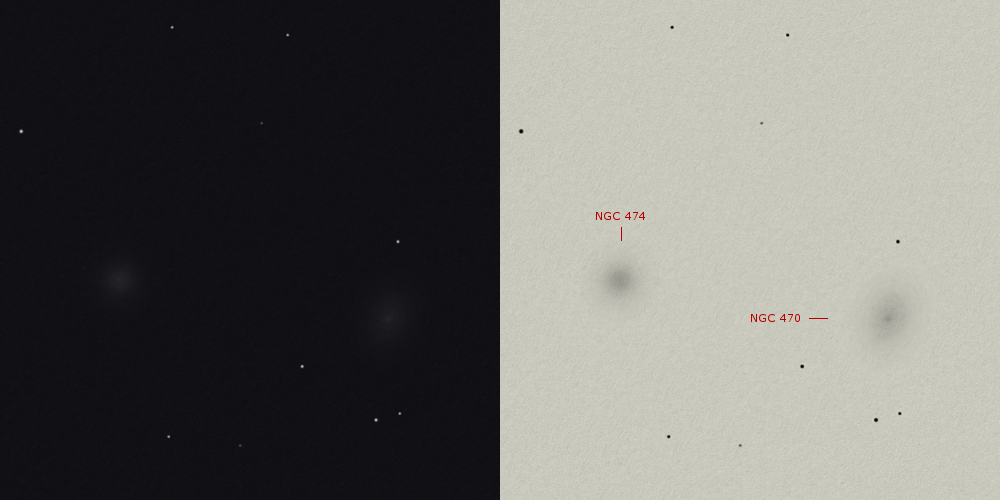
Very bright couple. NGC 470 is the largest of the two and slightly oval shaped. A very tight core is seen, alsmost like a central star with AV. NGC 474 is round and more compact, the core is large and bright. The faint rings around NGC 474 could not be seen.
Arp 229 – NGC 507 and NGC 508
NGC 503: mag 15.1, size 0.3′
NGC 504: mag 14.3, size 1.7′ x 0.4′
NGC 507: mag 12.2, size 3.1′
NGC 508: mag 14.1, size 1.3′
IC1687: mag 13.7, size 0.5′ x 0.3′
CGCG 502-72: mag 14.5, size 0.5′ x 0.4′
Challenge: Faint outer halo of NGC 507 enveloping NGC 508 (N)
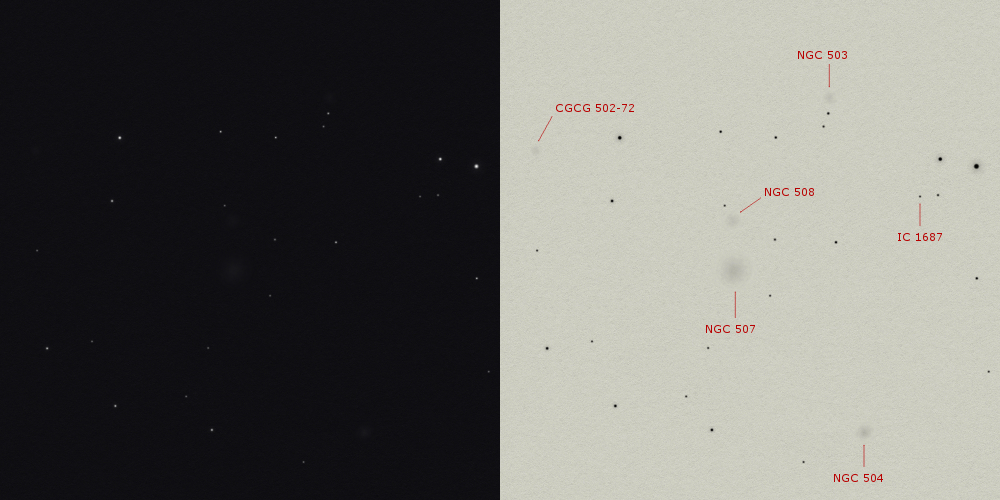
NGC 507 and NGC 508 are in the center of the group, pretty close to each other. The halo enveloping 508 is not visible. NGC 507 is brightest and largest, it’s round can be seen easily. NGC 508 just N of it is still pretty bright, small and round and with no central brightening. NW is NGC 503 and this one is very small, dim and can only be seen with AV. SW is NGC 504 and this is the second brightest of the group, to be seen with DV. The shape is round and compact. The protrusions are not observed. Two more dim galaxies enrich the field; MCG +05-04-048 (also CGCG 502-72) is very small en dim and can only be spotted with difficulty. IC 1687 was observed as a dim star, so it’s very small (only the core to be seen) but not too difficult with AV. This is a nice and rich Arp group.
Arp 230 – IC 51
mag 13.0, size 1.4′ x 1.2′
Challenge: Outer shell segments (N)

Pretty bright and with a bit brighter core area. A bit oval shaped. No bar or further details were seen.
Arp 231 – IC 1575
mag 14.2, size 0.8′ x 0.7′
Challenge: Faint southern arc (N)
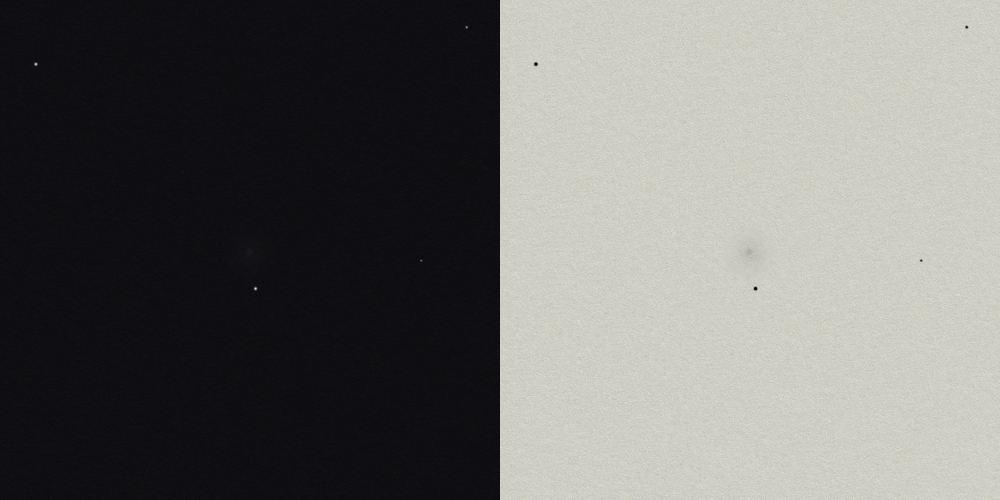
Brighter and larger than expected. Can be seen well directly. The core is stellar, but not much brighter than the surrounding (round) nebulosity. Close to a somewhat brighter star, but not touching.
Appearance of fission (Arps 232 – 256)
Arp 232 – NGC 2911
mag 11.5, size 4.1′ x 3.2′
Challenge: Absorption lane running NW (N)
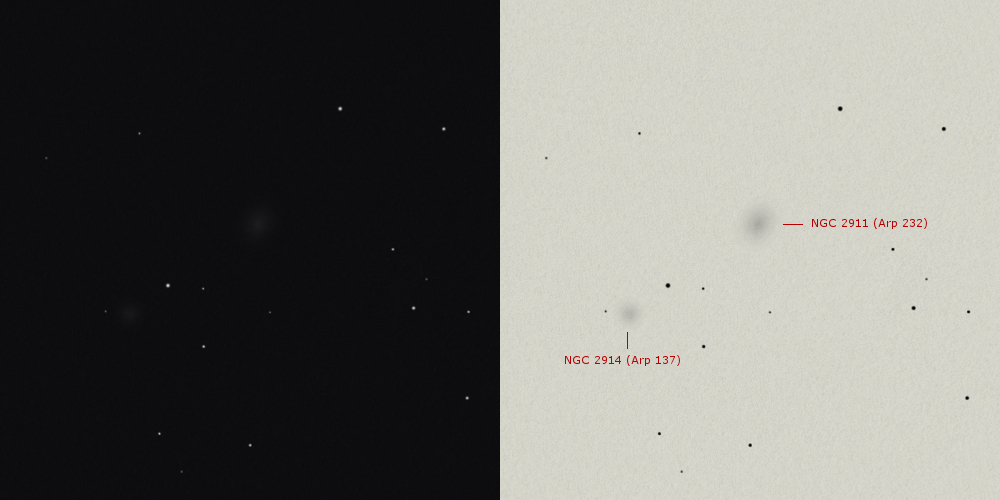
Two Arps in a single view. Arp 137 (NGC 2914) and Arp 232 (NGC 2911). Both are seen with DV and without any recognition of further detail. NGC 2911 is largest, somewhat oval and has a bright core. I don’t see the dim star against it. NGC 2914 is a bit smaller and less bright, but I do see that the core is a bit brighter. Here I do see a dim star just outside the glow.
Arp 233 – UGC 5720
mag 13.4; size 1.0′ x 0.9′
Challenge: Shape of the nucleus (N)
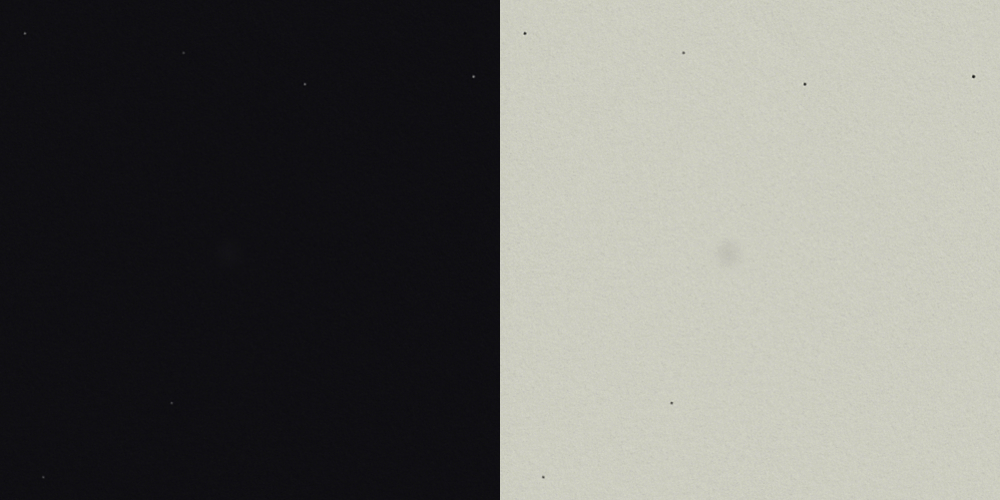
Small and almost perfectly round. Hard to distinguish at low power, but visible with DV at high power. The core is somewhat brighter, but other than that no details can be seen.
Arp 234 – NGC 3738
mag 11.9, size 2.5′ x 1.9′
Challenge: Line of knots S of nucleus (P)
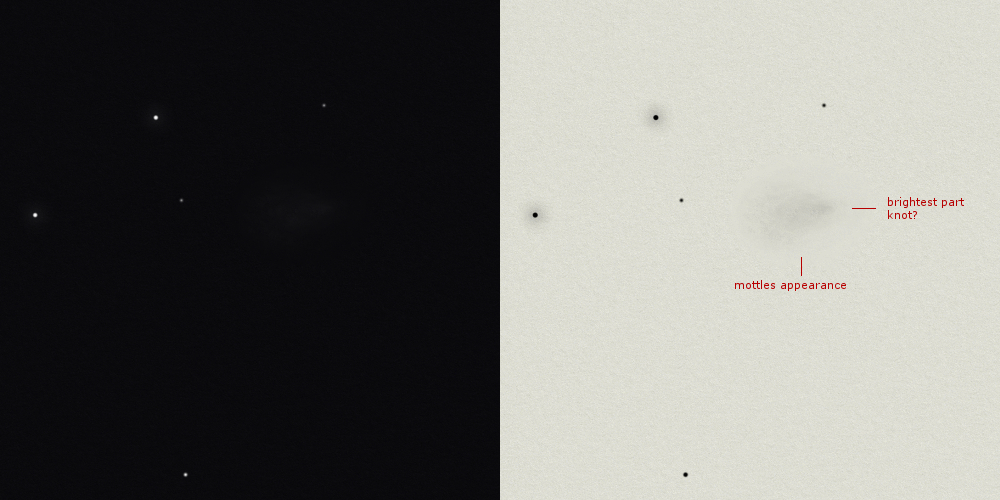
Quite large, appears like a shapeless face-on. Clearly seen with DV. With AV the galaxy appears more triangular or comet shaped. The galaxy is clearly mottled, although no separate clumps, except for one on the outer W side, is noticeable.
Arp 235 – NGC 14
mag 12.7; size 2.8′ x 2.1′
Challenge: Two overlapping galaxies (N)
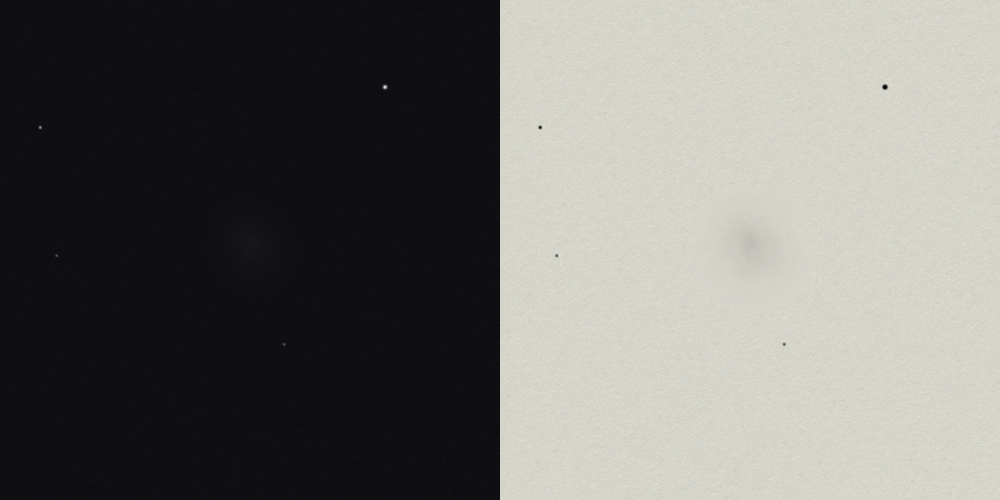
Very soft and oval shaped. Pretty large and seen with DV. It’s a bit more bright towards the center, but no further details are noticed.
Arp 236 – IC 1622 and IC 1623
IC 1622: mag 15.0, size 0.9′ x 0.6′
IC 1623A: mag 14.5, size 0.9′ x 0.7′
IC 1623B: mag 15.5, size 0.4′ x 0.3′
Challenge: Wobbly core of IC 1623B (N)
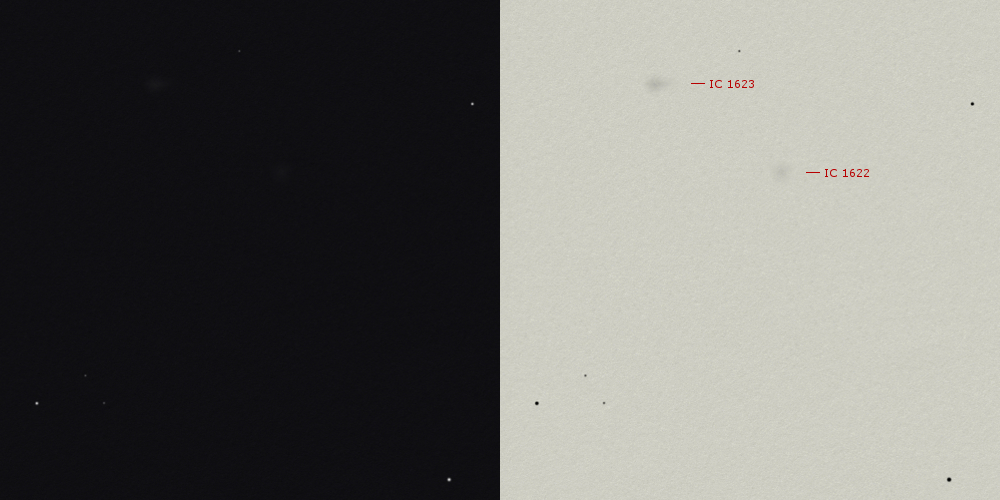
This pair is fairly bright. IC 1623 is seen instantly as round, but a bit longer shaped with AV. IC 1622 is easily seen with AV. Both are small. IC 1623 is not seen, but only suspected due to the stretched shape of the galaxy with AV.
Arp 237 – UGC 5044 in Hickson 38
MCG+2-24-13: mag 15.3, size 1.0′ x 0.6′
MCG+2-24-14: mag 16.0, size 0.4′ x 0.2′
Challenge: Three faint plumes (N)
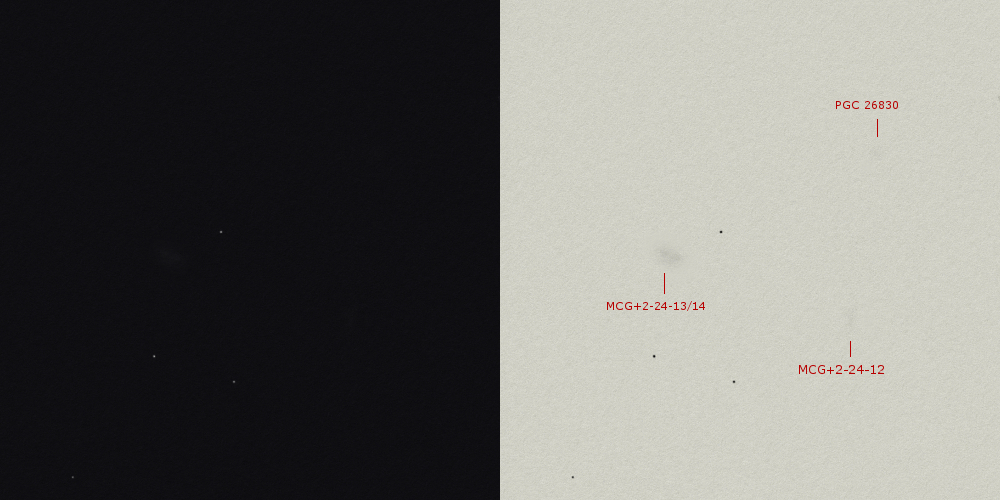
The two galaxies of UGC 5044 are seen as one and not (truly) separated, only suspected with AV. These are the brightest two galaxies in the field. MCG+2-24-12 can be seen off and on with AV and is clearly not round but more needle shaped. PGC 26830 is extremely difficult and can only be confirmed after a long and focussed observation.
Arp 238 – UGC 8335, MCG+10-19-56/57
MCG+10-19-56: mag 15.0, size 0.8′ x 0.7′
MCG+10-19-57: mag 15.2, size 1.5′ x 0.3′
Challenge: Three wisps SE, S, and NW, and SDDS companion (N)
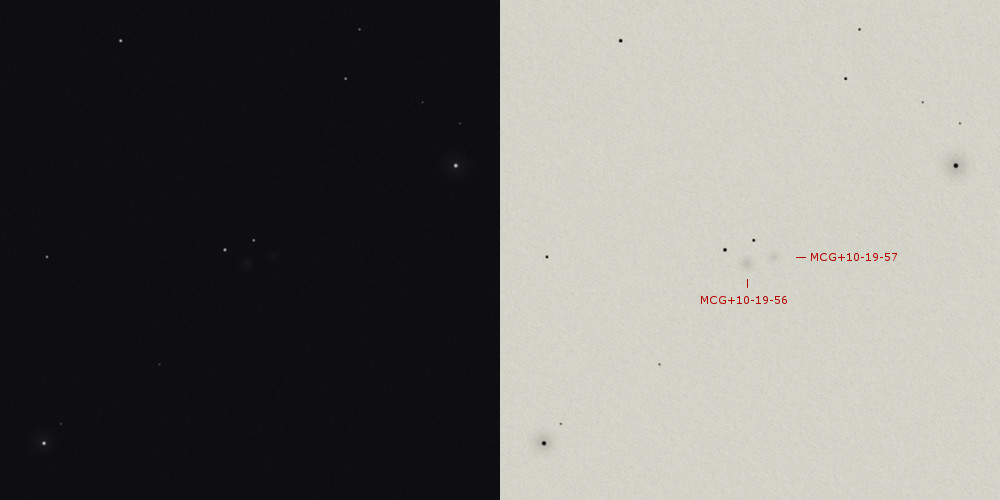
Nice, but very small. Two galaxies form a diamond with two somewhat brighter stars. Both galaxies are small and round, but MCG+10-19-56 is just a bit brighter than its neighbor MCG+10-19-57 (UGC 8335A). The “disturbances” are not observed, but the cores are clearly splitted.
Arp 239 – NGC 5278 and NGC 5279
NGC 5278: mag 13.6, size 1.3′ x 1.0′
NGC 5279: mag 15.0, size 0.6′ x 0.4′
Challenge: Connected arms (N)
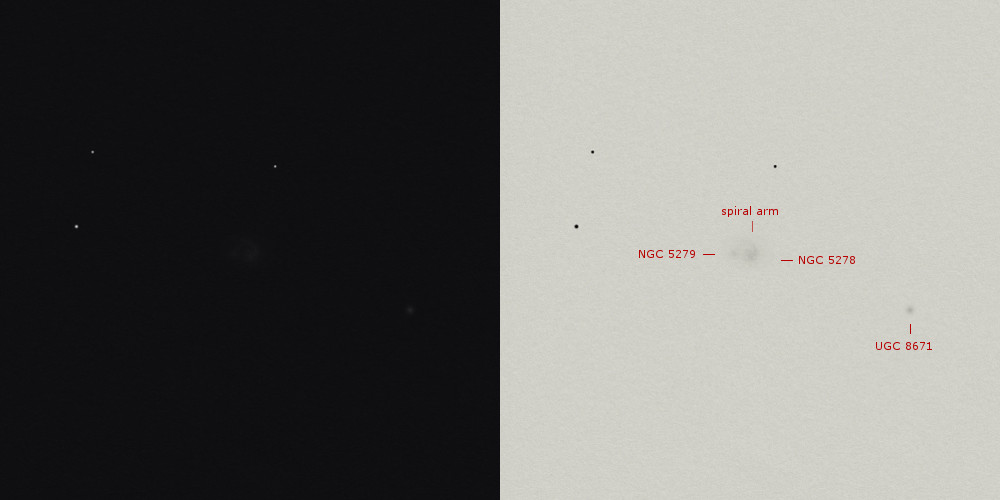
Two galaxies nearly in contact. NGC 5278 is the largest and brightest and is evenly illuminated. NGC 5279 is small clearly less bright, but can still be seen with DV. The spiral arm can be seen N, where there is more nebulosity as well. The complete bridge however is a “bridge” too far. SW in the field UGC 8671 is spotted; surprisingly bright and stellar.
Arp 240 – NGC 5257 and NGC 5258
NGC 5257: mag 12.9, size 1.8′ x 0.9′
NGC 5258: mag 12.9, size 1.7′ x 1.1′
Challenge: Arms of each galaxy and the bridge between them (N)
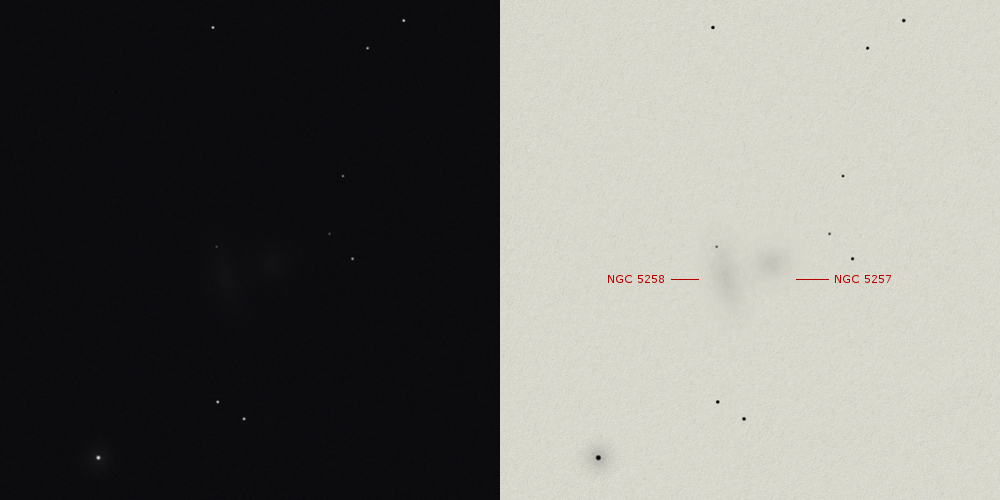
Arp 240 is a bright duo, consisting of NGC 5257 and NGC 5258. Both can be seen with DV and are of similar brightness. The core area is not much brighter in both. 5257 is round (a bit flattened) en 5258 appears a bit longer. At the latter, a dim star is seen on the N tip. The “bridge” connecting both galaxies is not seen.
Arp 241 – UGC 9425
mag 15.0; size 1.1′ x 0.6′
Challenge: Separate cores and both outer arms (N)
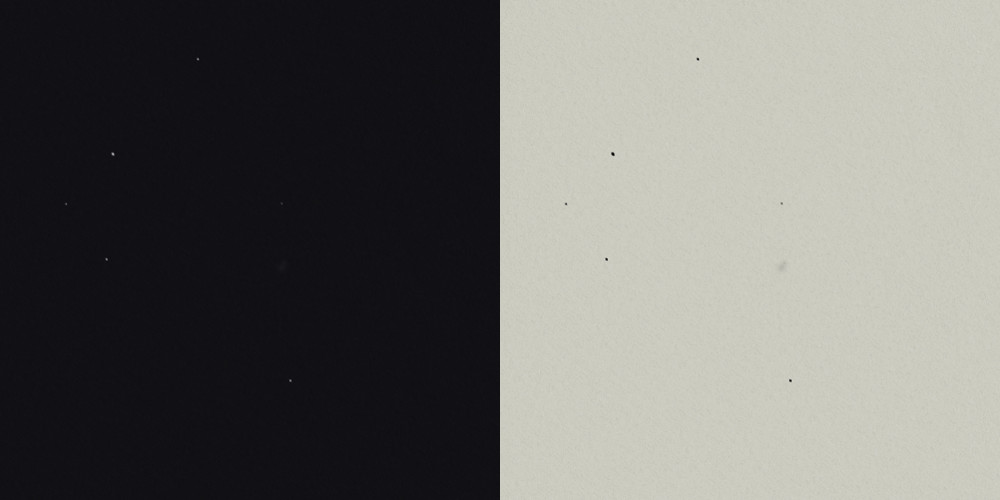
Very small, but visible with AV. Due to poor seeing, power could not be higher. At 259x a double core is suspected, but could not be confirmed. The cores are definitely not separated.
Arp 242 – NGC 4676A and NGC 4676B
NGC 4676A: mag 14.7, size 2.3′ x 0.7′
NGC 4676B: mag 14.4, size 2.2′ x 0.8′
Challenge: Both tails, differing structure in cores (P)
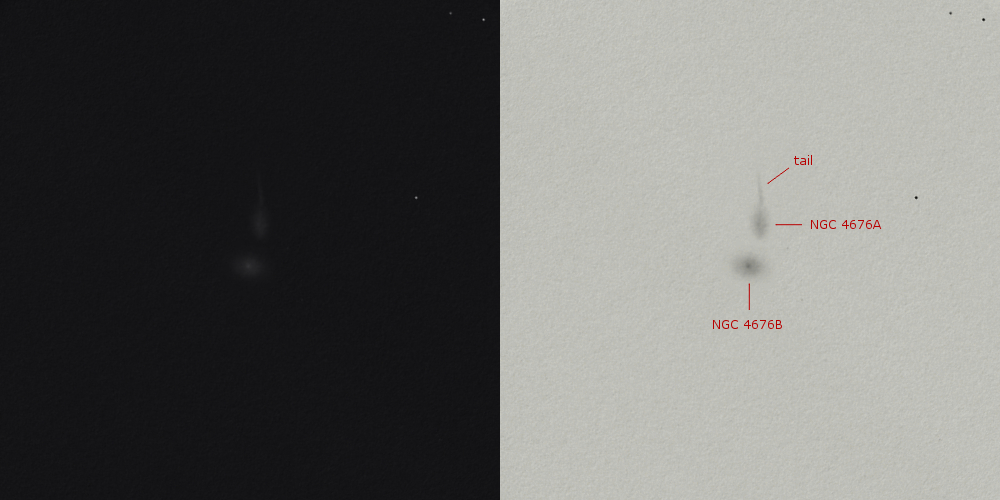
“The Mice“. Very small and dim ovals, hard to locate. At first (direct) sight NGC 4676B appears brightest with a stellar core, but with AV NGC 4676A swells and the extension can be seen as a straight line (with much effort). The second tail remains invisible.
Arp 243 – NGC 2623
mag 13.4, size 2.4′ x 0.7′
Challenge: Complex structure in core and full extent of tails (N)
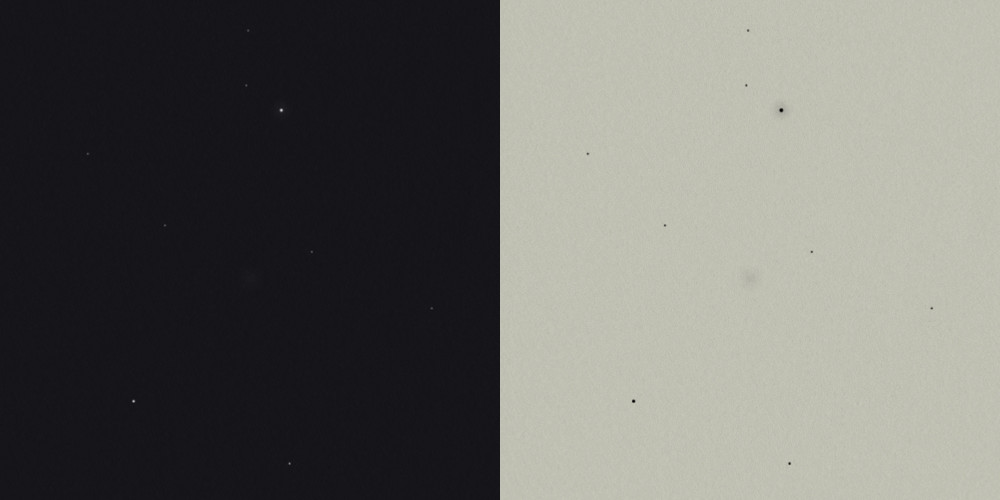
Small and round, well seen with AV. Without any details, probably because of terrible seeing.
Arp 244 – NGC 4038/39, The Antennae
NGC 4038: mag 11.2, size 5.2′ x 3.1′
NGC 4039: mag 11.1, size 3.1′ x 1.6′
Challenge: The meandering “lasso” of knots around the nuclei and full extent of the antennae (P)

The “pacman” shape is immediately seen, where the largest and brightest half shows quite a lot of mottling. Some knots and brighter areas are noticed. Also in the smaller and dimmer half a brighter patch can be observed and this half is a bit softer defined. The “neck” is the narrowest part and from here I can see some nebulosity heading S. A bit further to the S I think I see a small part of the antennae, but it’s tremendously dim. In the 10mm the whole field is strewn with stars and of course this only adds to the already mesmerizing view.
Arp 245 – NGC 2992 and NGC 2993
NGC 2992: mag 13.2, size 4.5′ x 1.0′
NGC 2993: mag 13.1, size 1.3′ x 0.9′
RFGC 1621: mag 16.7, size 1.4′ x 0.1′
Challenge: Tidal tails N of NGC 2992 and E of NGC 2993, connection between them, and Z-structure of NGC 2992 core (P)
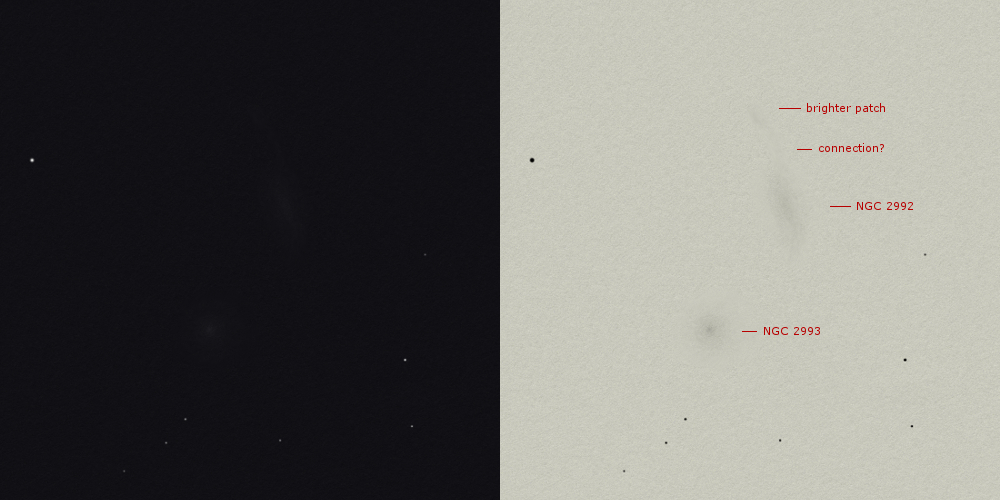
Beautiful and bright couple. NGC 2993 appears the brightest of the two and can be seen with DV with ease, it’s round and with a stellar core and swells considerably when looking with AV. NGC 2992 is just a tiny bit dimmer, is oval shaped and has an elongated core zone. Slightly remote of this galaxy, a brighter patch of nebulosity is noticed; this is the brighter part of the tidal tail. The connection between this patch and the galaxy is suspected, but can’t really be confirmed (it can be that the brain automatically “fills” this void).
Arp 246 – NGC 7837 and NGC 7838
NGC 7837: mag 16, size 0.4′ x 0.2′
NGC 7838: mag 14.3, size 1.0′ x 0.3′
Challenge: Both galaxies and spiral structure in NGC 7838 (P)
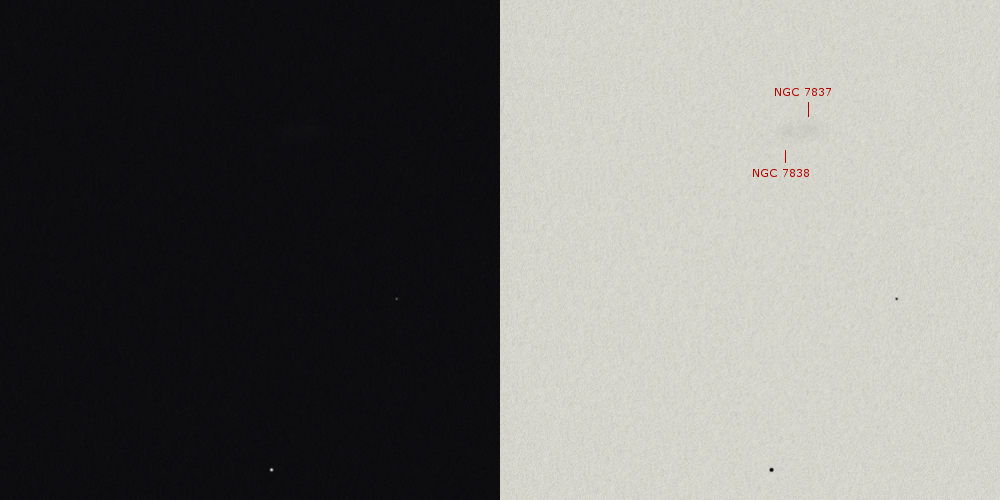
Many galaxies seen in this field, but I concentrated only on the Arp. NGC 7838 is seen best within a stretched glow. NGC 7837 is very difficult; it only blinks now and then at the opposite side of the shared nebulosity.
Arp 247 – IC 2338 and IC 2339
IC 2338: mag 15.4, size 0.6′ x 0.5′
IC 2339: mag 15.4, size 1.1′ x 0.6′
Challenge: Southern arm of IC 2338 and eastern wisp of IC 2339 (N)
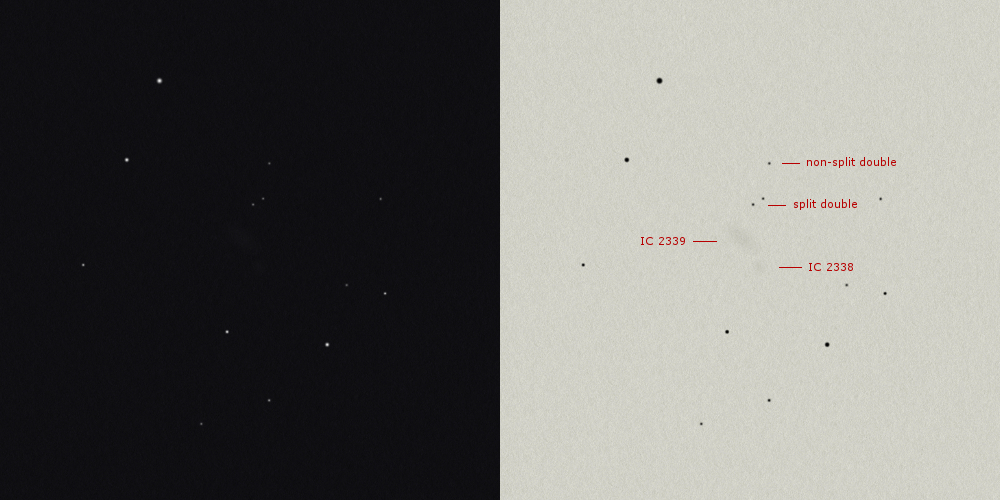
Two galaxies nearby two double stars, of which one could be split. IC 2339 is the brighest and largest of the two and the shape is clearly not round. IC 2338 is smaller, like a dot and only seen with AV with difficulty. The two galaxies were seen separated from each other.
Arp 248 – Wild’s Triplet
MCG-1-30-32: mag 15.3, size 0.8′ x 0.5′
MCG-1-30-33: mag 14.1, size 3.1′ x 0.7′
MCG-1-30-34: mag 15.9, size 0.5′ x 0.4′
Challenge: Spiral structure in all three galaxies and bridge between -32 and -33 (N)
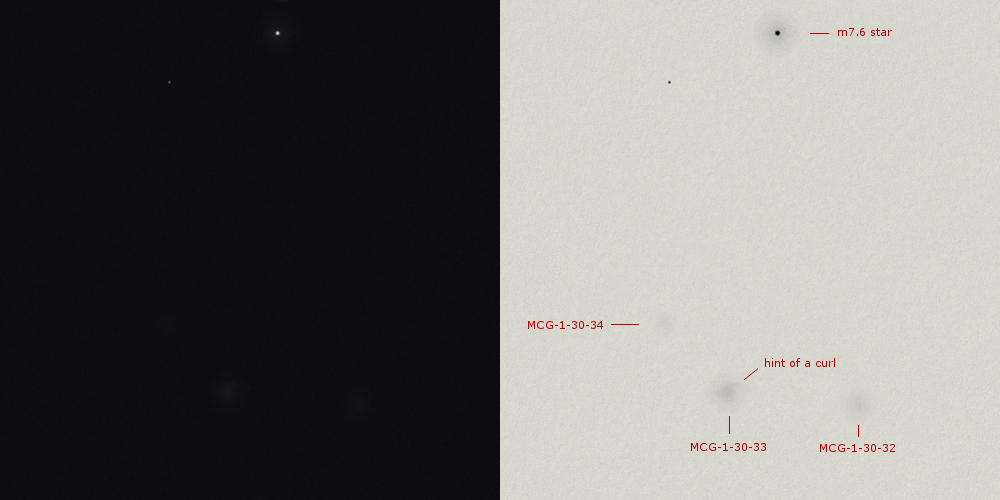
All three galaxies can be seen, differing in brightness. MCG-1-30-33 in the center is brightest and largest and the start of a spiral arm is suspected towards MCG-1-30-32. This one is without detail and dim, but can be held with AV easily. MCG-1-30-34 in very dim and small and can only be seen blinking now and then, but it’s definitely there. No stars are seen in the direct surrounding, only near the edge is a very bright star that needs to be kept out of view for better observation of the triplet.
Arp 249 – UGC 12891, VV 186
mag 16.2, size 1.3′ x 0.5′
Challenge: The jet (N)
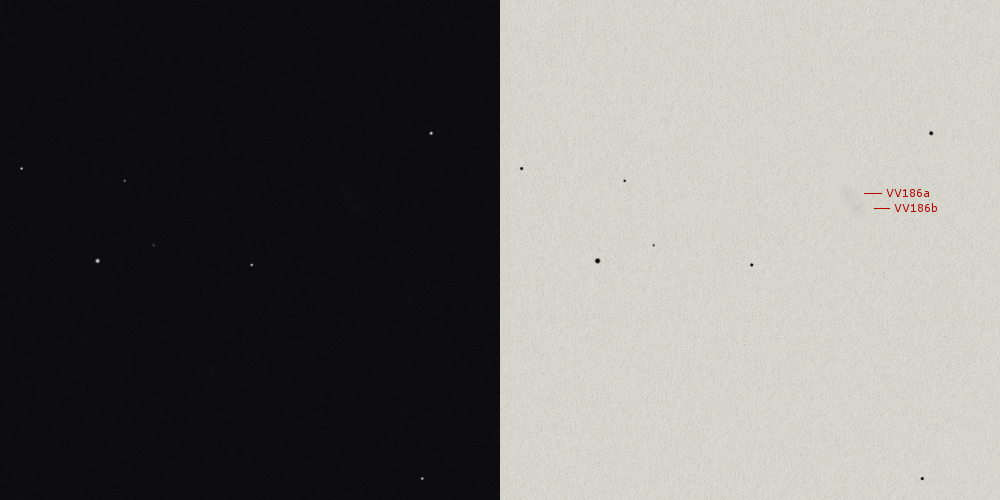
This one is hard to find. It’s small, very weak, but can be well seen with AV. After a while, the long shape and sometimes the double core can be seen individually. VV186b is the brightest of both.
Arp 250 – IRAS F07327+3529
mag and size unknown
Challenge: Asymmetry in western galaxy (N)
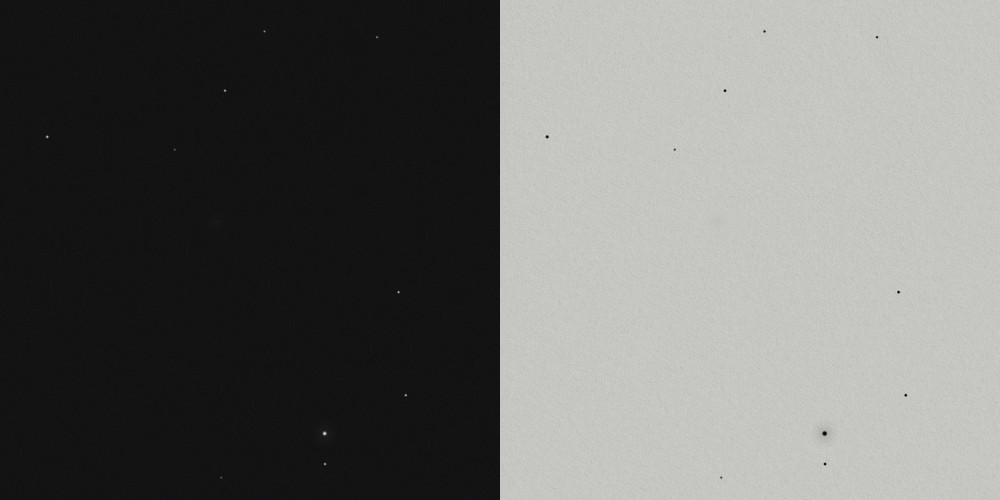
Very, very difficult to see with AV. Only PGC 21362 can be seen of the two galaxies involved. Magnitude is unknown, but estimated around 16. Once of the more challenging Arps of the list.
Arp 251 – MCG-2-3-37 and companions
mag 15.5, size 0.8′ x 0.3′
Challenge: Arms in two spiral galaxies, and N bifurcation (N)
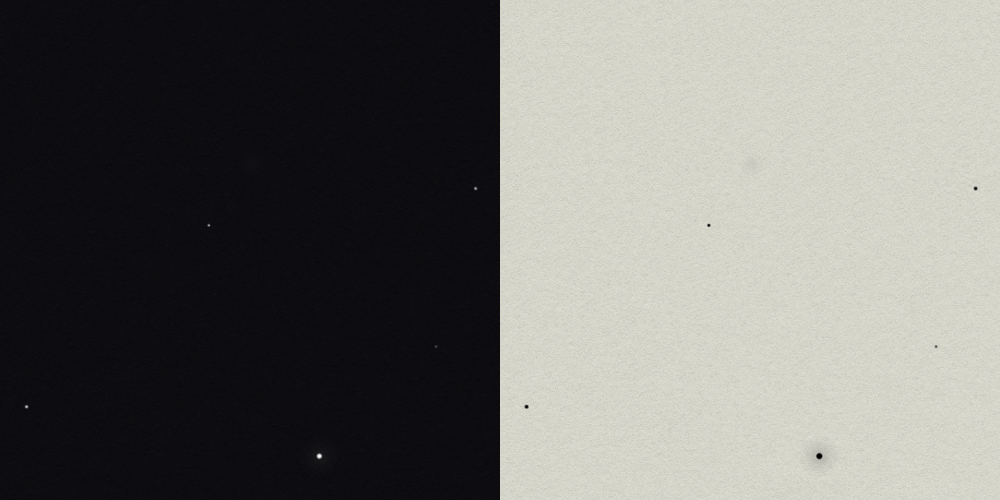
Only seen with AV and with effort as a stain, non-stellar. All companions seen as one.
Arp 252 – ESO 566-IG007 and -IG008
ESO 566-IG007: mag 15.3, size 1.6′ x 1.2′
ESO 566-IG008: mag 16.3, size 0.8′ x 0.6′
Challenge: Detect plume curving N from 008 and “S”-curving plume from 007 (N)
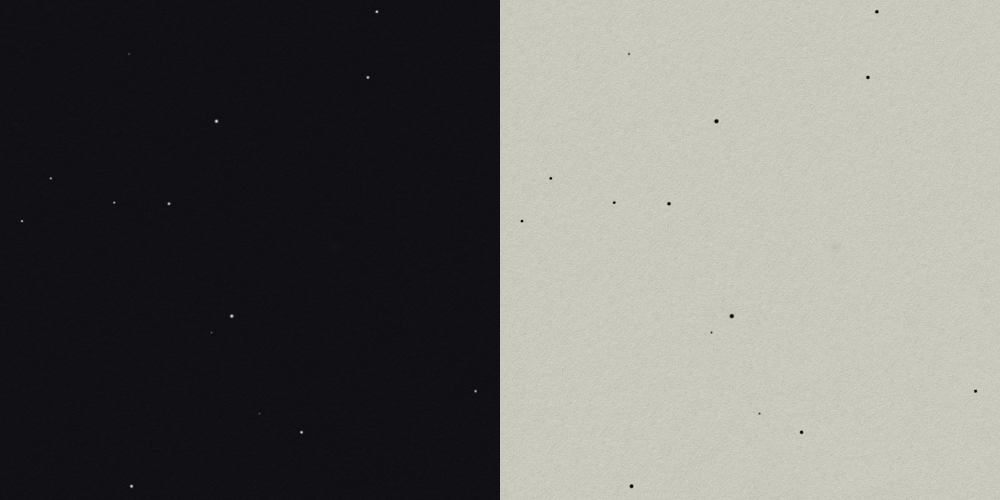
Very hard to see with AV and only the brightest of the two was seen with certainty, 008 was only suspected but could not be confirmed. This is tiny speck of light and was only found by use of a detailed star chart.
Arp 253 – MCG-1-25-31 and -32
MCG-1-25-31: mag 15.0, size 1.3′ x 0.2′
MCG-1-25-32: mag 15.2, size 1.2′ x 0.4′
Challenge: Detect faint bridge connecting the two components (N)

Arriving at the correct location I don’t immediately see something, so I start with drawing the star field. Once I’m used to the view, I start to see blinking a very long, slightly bent “ribbon”. After long observation I start to see two core zones, but I don’t necessarily see the two galaxies separated. These are MCG-1-25-31 en -32 and a bit remote also MCG-1-25-33 is seen with AV as a dim, oval patch. This was a very hard observation.
Arp 254 – NGC 5917 and companions
NGC 5917: mag 14.5, size 1.5′ x 0.9′
MCG-1-39-3: mag 14.6, size 4.4′ x 0.6′
Challenge: The asymmetric arms in NGC 5917, and the full extent of the faint plumes N and S of MCG-1-39-3 (P)
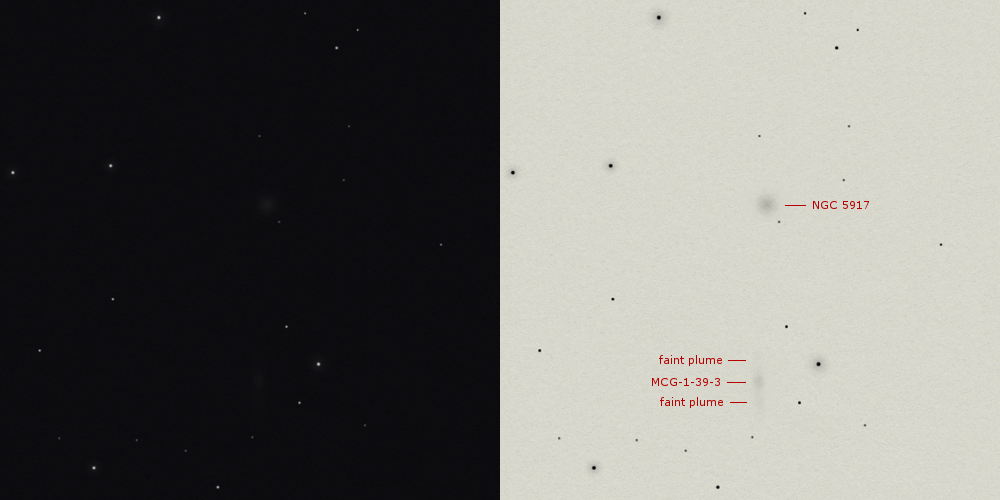
NGC 5917 is round and can be seen with DV, but not terribly bright. It does appear to show some central brightening. With AV MCG-1-39-3 can be seen close to it and with effort the extensions in both directions can be seen as well.
Arp 255 – UGC 5304
VV 342b: mag 14.0, size 1.0′ x 0.8′
VV 342b: mag 18.0, size 0.2′
Challenge: Spiral arms in VV 342b, and faint plume N from 342c (N)
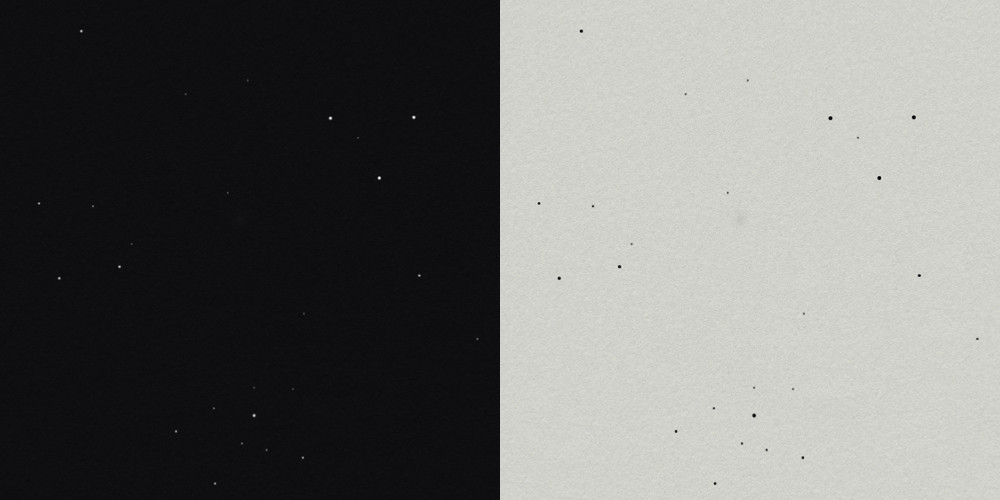
UGC 5304 is difficult to see with AV, partly due to bad seeing conditions. No other galaxies seen in the field and no details. The galaxy is small, round and with some central brightening.
Arp 256 – MCG-2-1-51 and -52
MCG-2-1-51: mag 14.3, size 1.1′ x 0.6′
MCG-2-1-52: mag 13.6, size 1.4′ x 0.9′
Challenge: Spirals in -52 and split arm in NE arm (N)
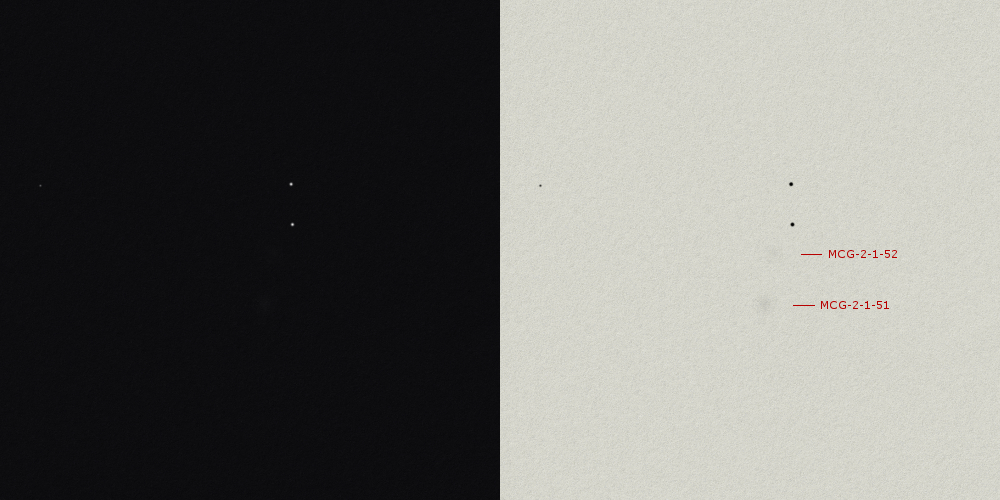
MCG-2-1-51 is already noticed in the search eyepiece with AV. When cranking up magnification, the galaxy stays small and can only be seen with AV. The neighbour galaxy MCG-2-1-52 is somewhat dimmer, but can be seen with AV most of the time. No shape is noticed. The two reside close to a double star.
Irregular clumps (Arps 257 – 268)
Arp 257 – UGC 4638
MCG+0-23-5: mag 15, size 1.5′ x 0.8′
MCG+0-23-6: mag 17, size 0.8′ x 0.5′
Challenge: The thin arc, five main lumps, and the fainter arc at N (N)
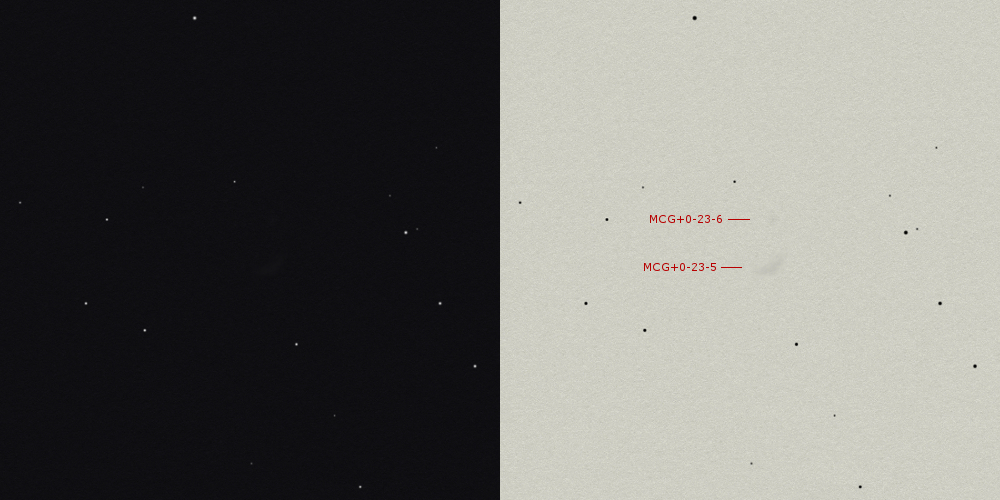
The main galaxy is seen easily with AV in a nice ring of stars, it has a bent shape and curls towards a much fainter and small component that can only be seen blinking now and then.
Arp 260 – UGC 7230
UGC 7230: mag 14.5, size 0.6′ x 0.3′
UGC 7230B: mag 14.8, size 0.9′ x 0.4′
Challenge: “S” shaped arms in UGC 7230 and broad faint plume heading S. N)
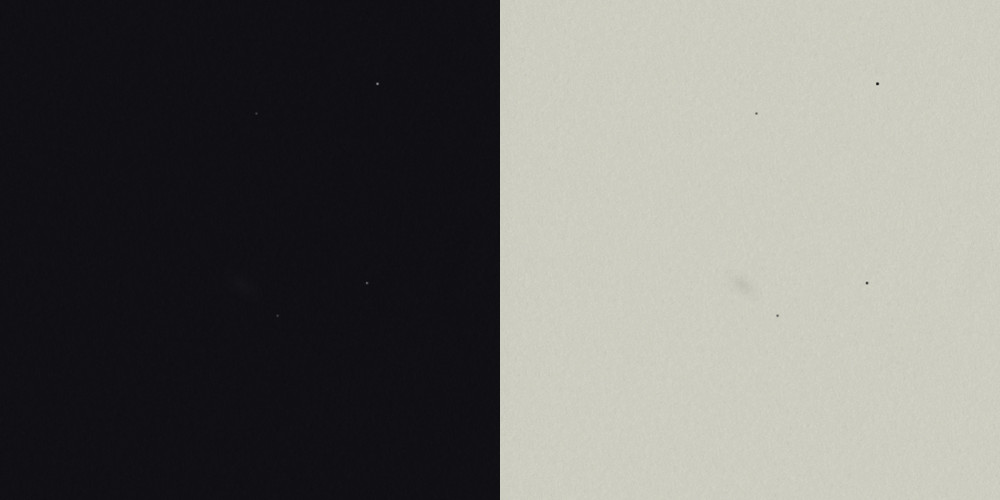
Somewhat stretched galaxy in the direction of a dim star. The companion galaxy was not seen separated and neither was the m16 star in between them. One single elongated smudge seen with AV.
Arp 261 – MCG-2-38-16 and -17
MCG-2-38-16: mag 13.4, size 3.0′ x 2.0′
MCG-2-38-17: mag 13.4, size 1.7′ x 0.9′
Challenge: Two bridges between -16 and -17 (N)
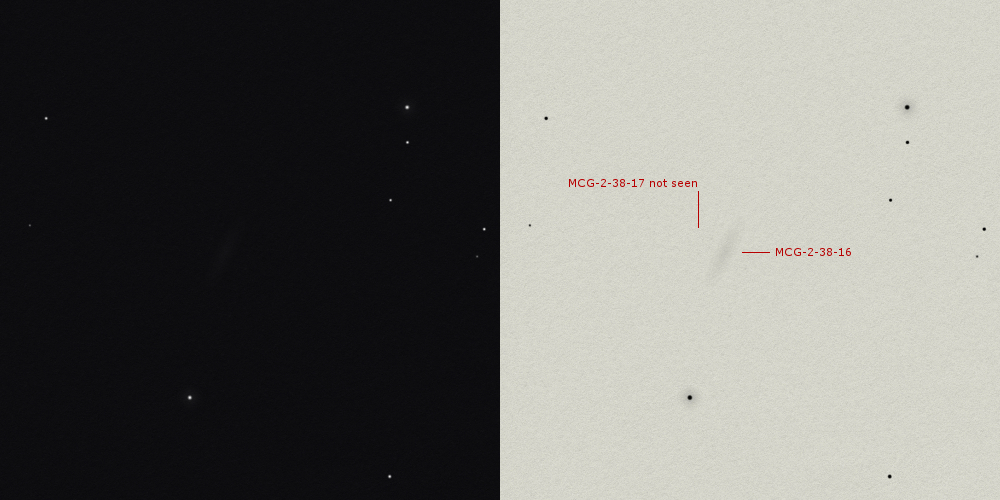
This is a tough one. MCG-2-38-16 can only be seen with effort with AV, but the needle shape (and direction) can be guessed. The companion MCG-2-38-17 remains hidden and thus also the two bridges that are supposed to connect them. Unfortunately I did not pay attention to PGC 53943 nearby.
Arp 262 – UGC 12856: MCG+3-1-3 and -4
MCG+3-1-3: mag 15.6, size 0.4′ x 0.4′
MCG+3-1-4: mag 14.5, size 1.6′ x 1.0′
Challenge: The lane and irregular clumps (N)
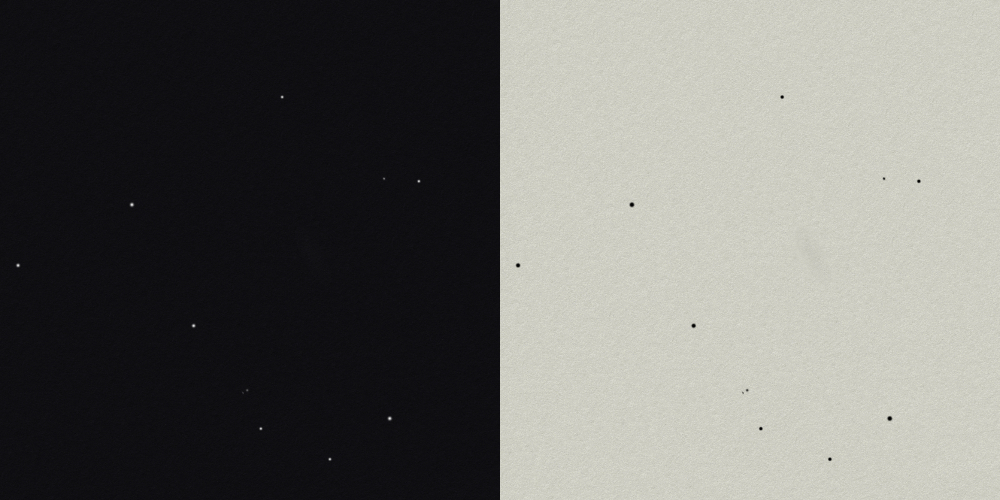
This one is hard to find and I need a detailed chart to be able to find it. Even then it’s hard to see with AV, but that can be because of the mediocre transparancy. The angle of the galaxy can be seen, but not the irregular and individual clumps.
Arp 263 – NGC 3239
mag 11.4, size 5.0′ x 3.3′
Challenge: Knots, E hook plume, SW “spike” pointing SE (P)
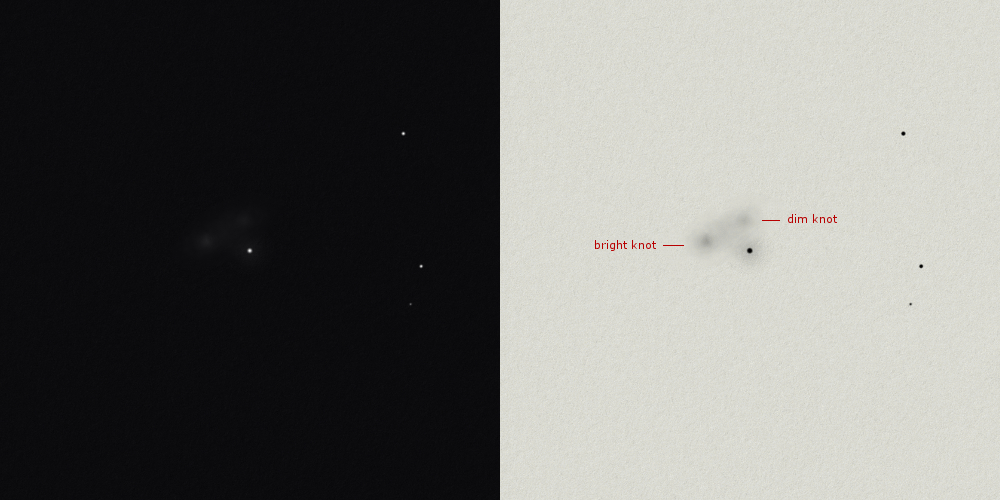
Strange looking galaxy; more like a rectangular glow against a bright star. Two knots are visible within this glow, at the tips. One is bright and can be seen directly, the other one is smaller and dimmer and is only visible with AV. The “plumes” are not seen.
Arp 264 – NGC 3104
mag 13.1, size 3.4′ x 2.3′
Challenge: Textured clumps (N)
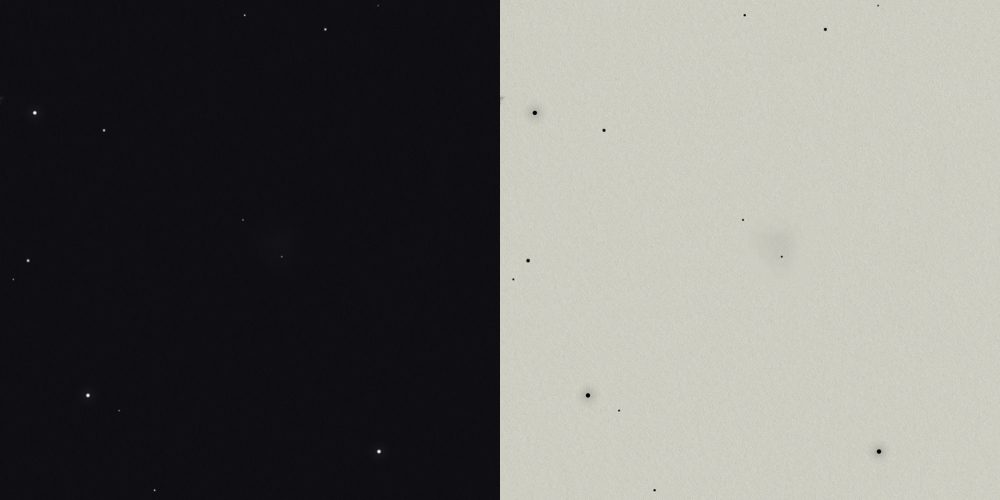
A not too small and dim galaxy that shows not central brightening; the sparse light is evenly distributed from core to edge. The shape is definitely not round, but rather triangular and a star is placed on the S side. The galaxy resides in a pretty rich starfield.
Arp 265 – IC 3862
mag 16, size 1.3′ x 0.6′
Challenge: Looping arm with small knots to N (N)
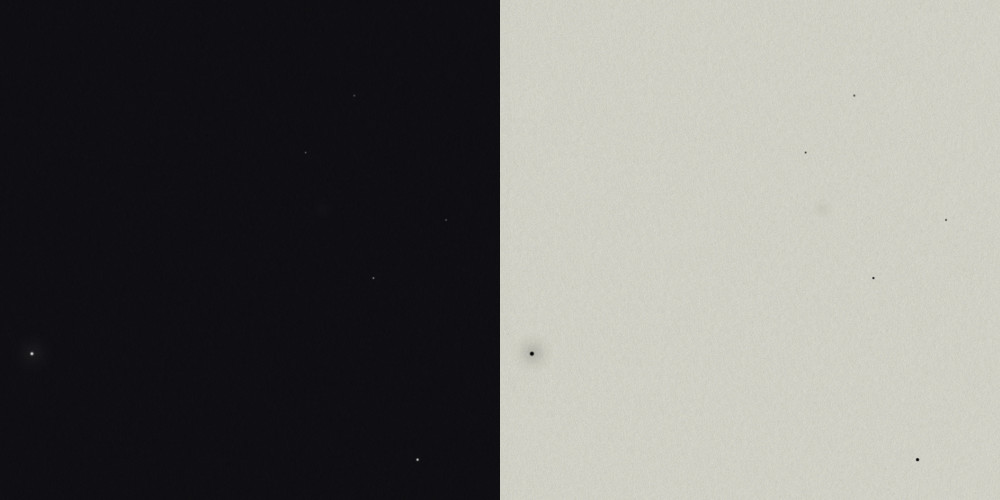
Extremely difficult! Only blinks up sporadically, but could be confirmed nevertheless. A very tough observation. No further details observed.
Arp 266 – NGC 4861
mag 13.2, size 4.0′ x 1.5′
Challenge: Knots and asymmetry (P)
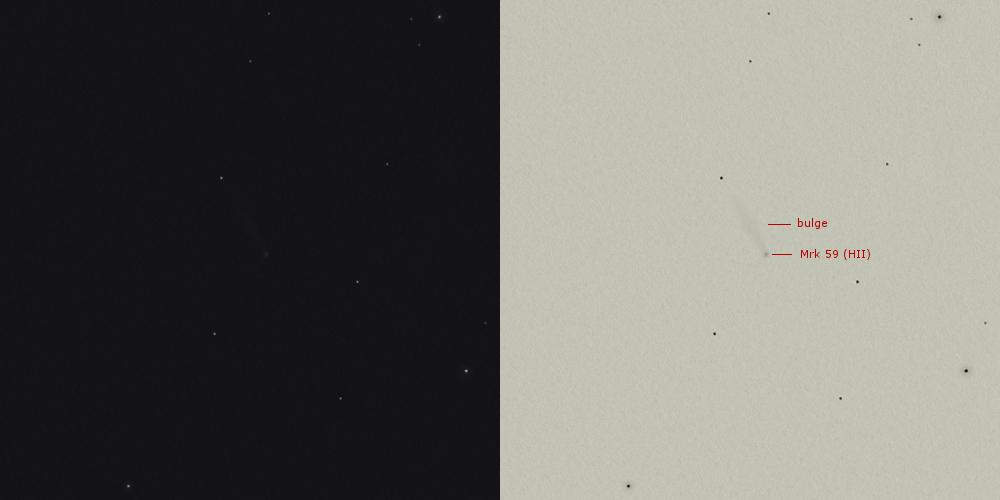
Strange looking galaxy; a large and long streak of light stretches between a star and a HII knot (both easily visible). The brain fills in the space between the star and knot, but careful examination shows that the galaxy does not quite reach the star. A little off-center a bulge can be seen in the core.
Arp 267 – UGC 5764
mag 15.2, size 2.0′ x 1.2′
Challenge: Full extent of brighter part of galaxy and the faint ring (N)
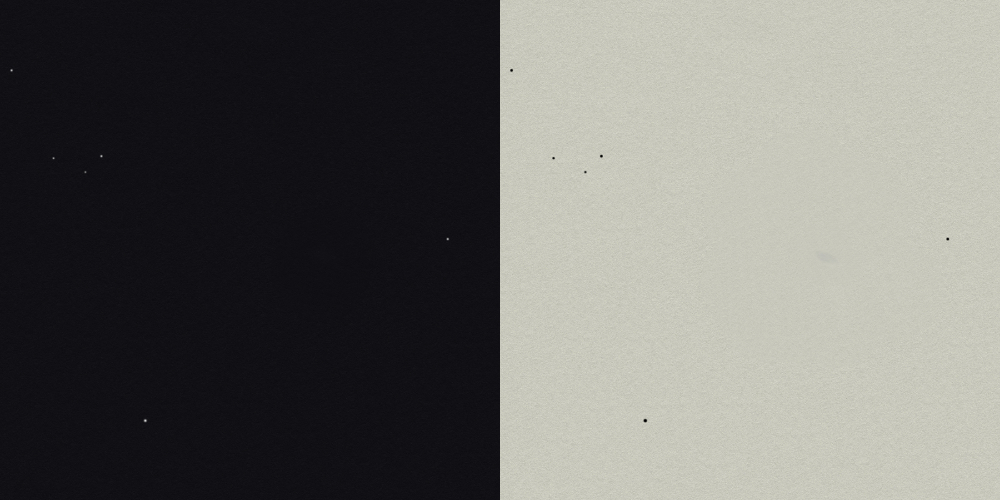
Very small and extremely dim. Very hard to see with AV, but the direction can be suspected. Needed a detailed chart to locate this galaxy.
Arp 268 – UGC 4305, Holmberg II
mag 10.7, size 8.0′ x 6.3′
Challenge: Linear loop of emission regions (P)
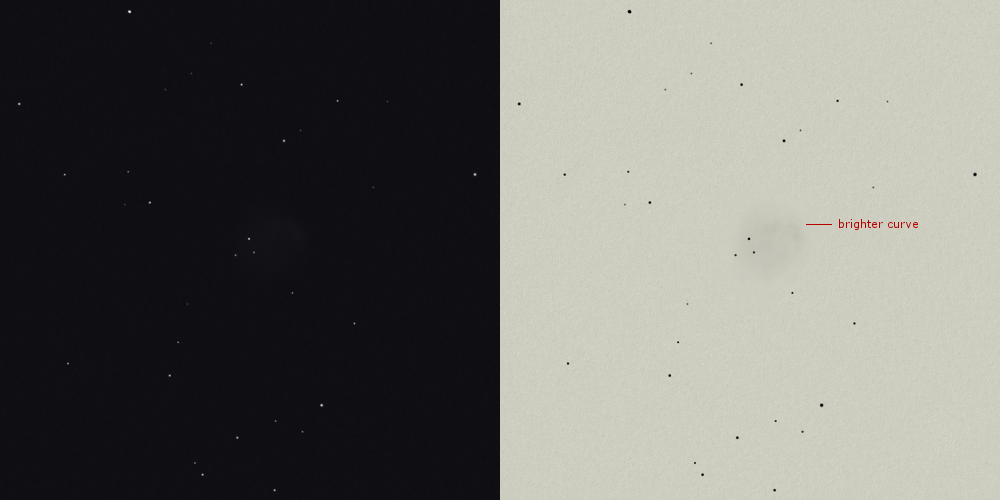
Very dim, but large and roundish “stain” with a remarkable triangle of mag 12 stars at the foreground. Low surface brightness with no core zone, but an arc of nebulosity can be seen moving W from the three stars. This is one of the easier Holmberg galaxies, but could only be seen with AV.
Double Galaxies
Connected arms (Arps 269 – 274)
Arp 269 – NGC 4485 and NGC 4490
NGC 4485: mag 12.3, size 2.3′ x 1.6′
NGC 4490: mag 10.2, size 6.3′ x 3.1′
Challenge: Knots, asymmetry and the tail E of NGC 4490 (P)
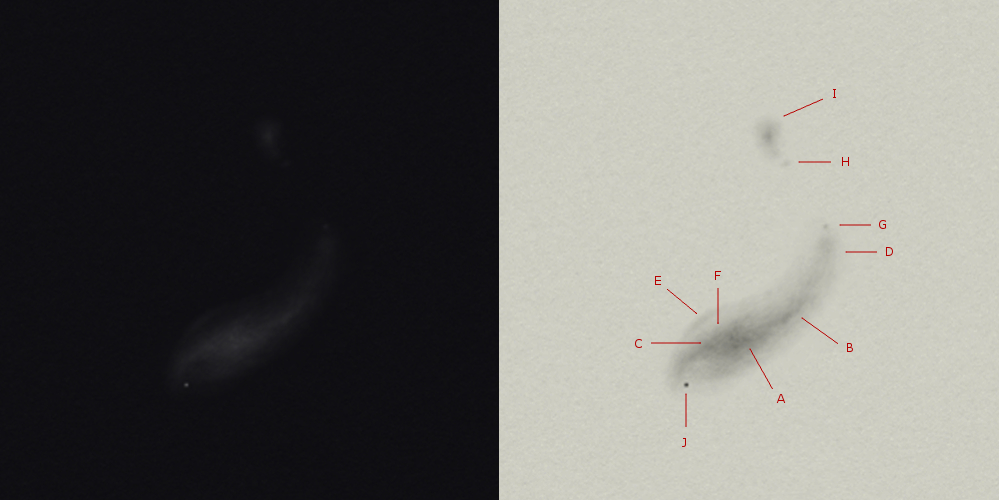
The “Cocoon Galaxy“. This famous duo in Canes Venatici is a real treat in the northern sky. It comprises two galaxies that have an obvious influence on each other. A lot of structure and irregularities can be seen; NGC 4490 is oval shaped and the largest and brightest of the two, with a distinct (mottled) core area and two spiral arms showing a long and flattened “S”. NGC 4485 has a curved “droplet” shape with a loose fragment on top.
A – The core of 4490; bright and mottled, shaped like a stretched “D” or “Δ”. On the SE and NW side two spiral arms are reaching outwards.
B – Slightly brighter part of the northern arm.
C – The SE arm, a bit brighter, thicker and shorter than the N one.
D – A brighter “patch” of nebulosity at the end of the N arm.
E – A streak of nebulosity, like an island, set loose from the galaxy and separated by a dark lane.
F – Dustlane? Or just an empty space between NGC 4490 and the “island”.
G – Suspicion of a dim star, or maybe a H II knot?
H – Fragment, set loose from NGC 4485.
I – NGC 4485; a droplet shaped galaxy, arching towards NGC 4490. The core is small and just a tiny bit brighter.
J – A mag 14.7 star, easily seen at the outer SE region of 4490, embedded in a darker notch.
Arp 270 – NGC 3395 and NGC 3396
NGC 3395: mag 12.2, size 2.1′ x 1.2′
NGC 3396: mag 12.6, size 3.1′ x 1.2′
Challenge: Many knots and arcing arm in 3395 (P)

Nice pair, close to each other at an almost right-angle. NGC 3396 is somewhat brighter and is seen as a 2:1 streak of light with the core area a bit brighter, surrounded by a fuzzy halo. NGC 3395 is a bit dimmer and more evenly illuminated. With AV the start of a spiral arm can be seen to the S. There ‘s a lot of space between the two galaxies.
Arp 271 – NGC 5426 and NGC 5427
NGC 5426: mag 12.7, size 3.0′ x 1.6′
NGC 5427: mag 12.0, size 2.8′ x 2.4′
Challenge: Bifurcated arm and connection between galaxies (N)
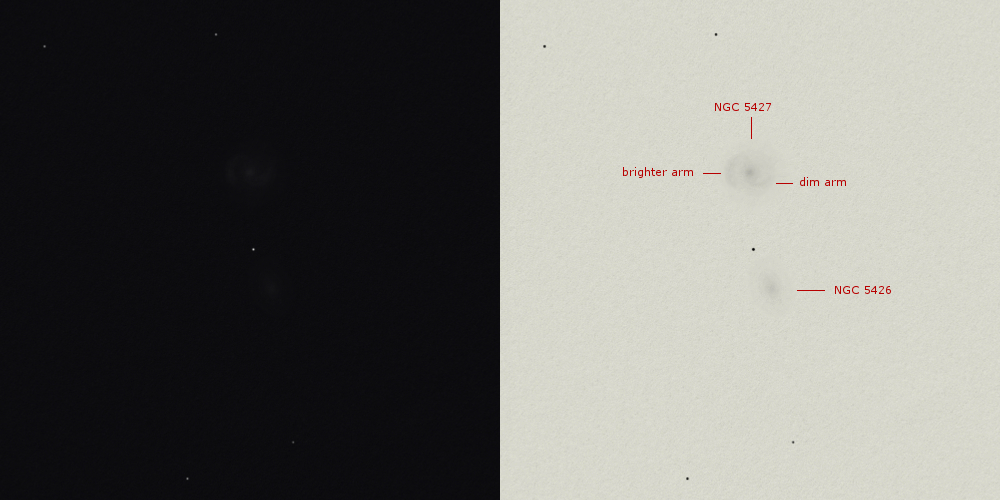
Pretty bright and even some spiral structure can be observed. Both galaxies are seen with DV, however NGC 5426 with some effort. NGC 5427 is larger, brighter and round and two spiral arms are visible. Between the two galaxies there is dark space with a dim star in it. The bridge between the two galaxies is invisible.
Arp 272 – NGC 6050 and IC 1179
NGC 6050: mag 15.4, size 0.9′ x 0.6′
IC 1179: mag 16.0 size 0.6′ x 0.4′
Challenge: Spirals in NGC 6050, elongated core of IC 1179 (N)
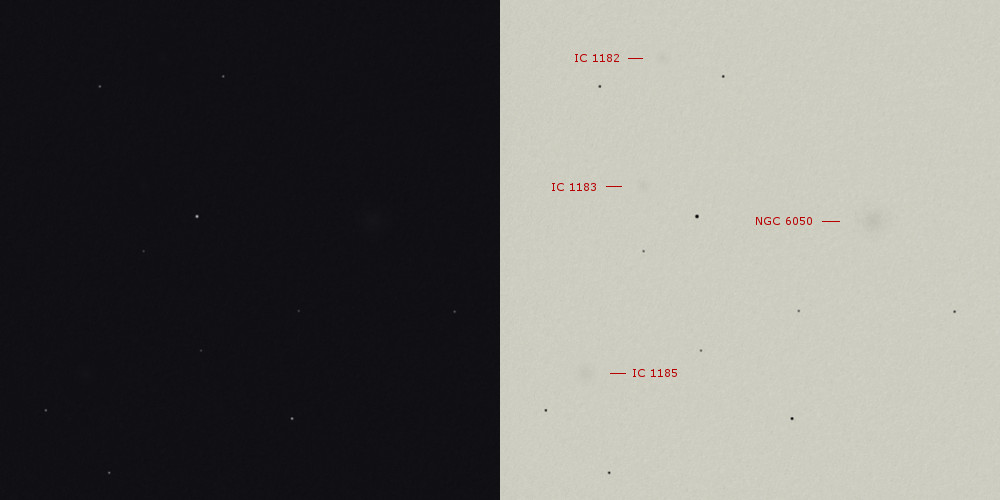
Part of AGC 2151, but only the Arps in the field were visited. Arp 272 is NGC 6050 and it appears like a face-on galaxy; it’s quite large, round, without central brightening and it takes a bit of effort to see it with AV. The companion (IC 1179) was not seen, probably just out of reach at m16. In the same field, Arp 71 can be seen, but that one has a sketch of its own. Furthermore in this field, IC 1185 is noticed with AV and also IC 118 and IC 1183. These last two are very tiny and were marked as a star at first. Nice area!
Arp 273 – UGC 1810 and UGC 1813
UGC 1810: mag 13.4, size 2.0′ x 1.3′
UGC 1813: mag 15.1, size 1.5′ x 0.4′
Challenge: Asymmetrical arms in UGC 1810 (P)
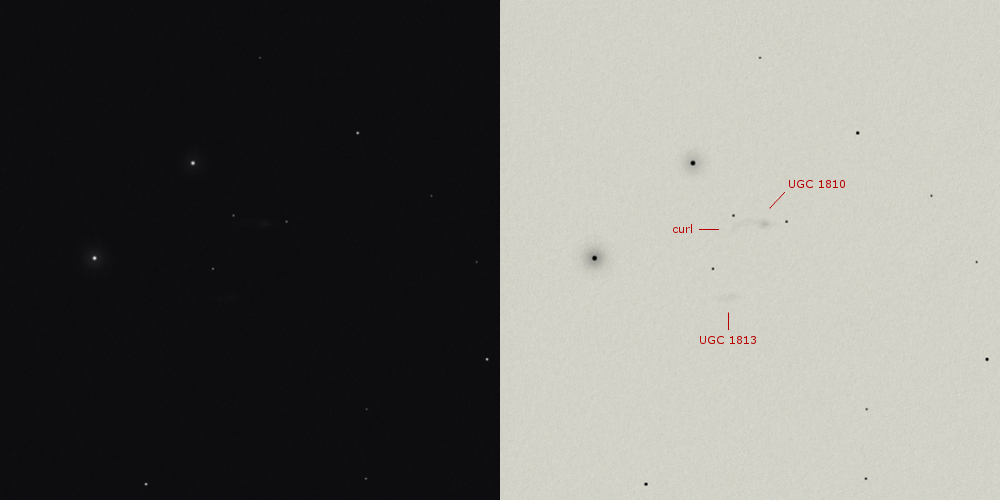
Extremely hard observation. UGC 1810 is the brightest of the two, but despite that only seen with AV (mainly the core). However, the extension in both directions is suspected as well as the curving arm on the E side. UGC 1813 is only sometimes seen with AV as a small streak of light and is a threshold observation.
Arp 274 – NGC 5679 group
MCG+1-37-34: mag 14.9, size 0.7′ x 0.5′
MCG+1-37-34: mag 14.2, size 1.1′ x 0.7′
MCG+1-37-36: size 0.3′ x 0.2′
Challenge: Arms in both galaxies (-34 and -35) and connection between them (N)
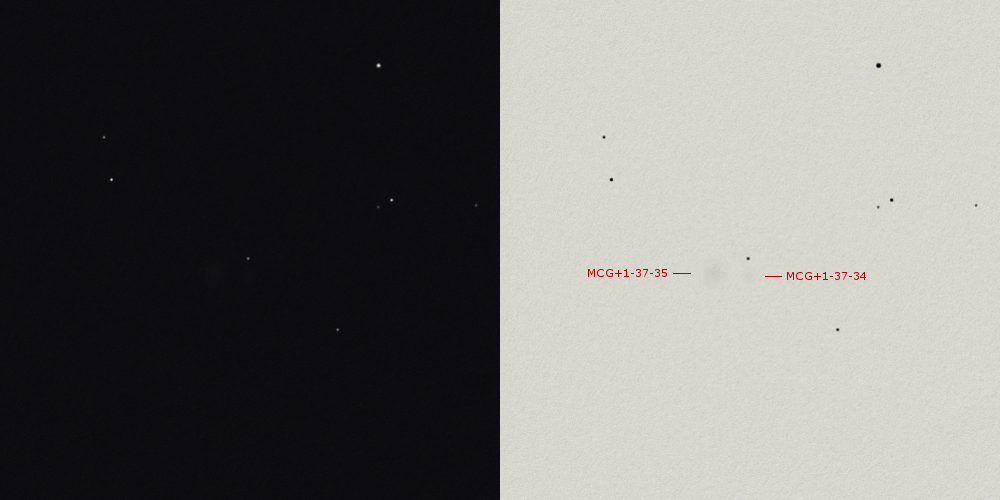
This is a dim and small pair, so high power is needed to see details. NGC 5679 can be seen with AV, small and round. MCG+1-37-34 is very dim and small and can not be held with AV the whole time. The third MCG is not seen unfortunately. The two galaxies are located against a dim double star, which could not be split and was seen as one.
Interacting (Arps 275 – 280)
Arp 275 – NGC 2881, VV 293
mag 14.1, size 0.8′ x 0.6′
Challenge: Arms in VV 293a and knots in VV 293b (N)
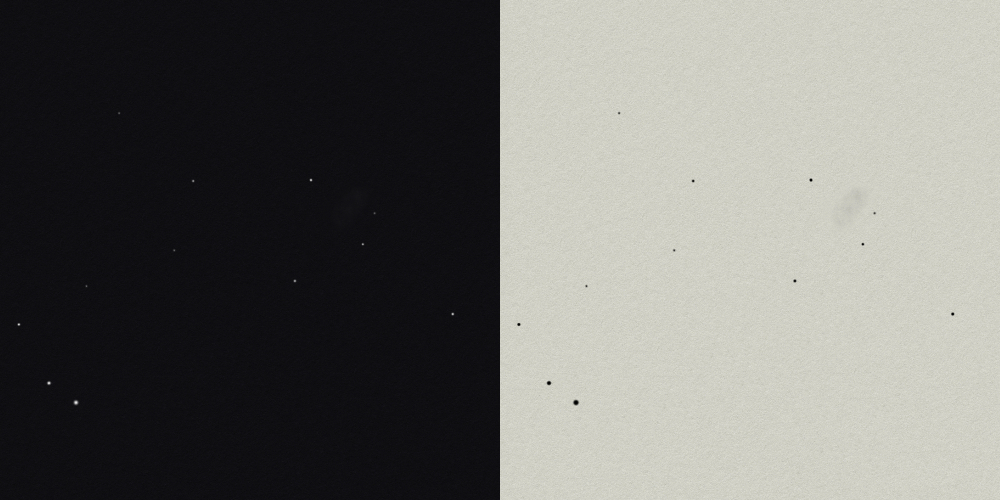
Two galaxies within a shared glow, but they can’t be seen separated. Instead, the galaxy appears oval shaped, very mottled and with an irregular structure.
Arp 276 – NGC 935 and IC 1801
NGC 276: mag 13.6; size 1.7′ x 1.1′
IC 1801: mag 14.6; size 1.3′ x 0.6′
Challenge: Asymmetrical structure and knots in NGC 935 (N)
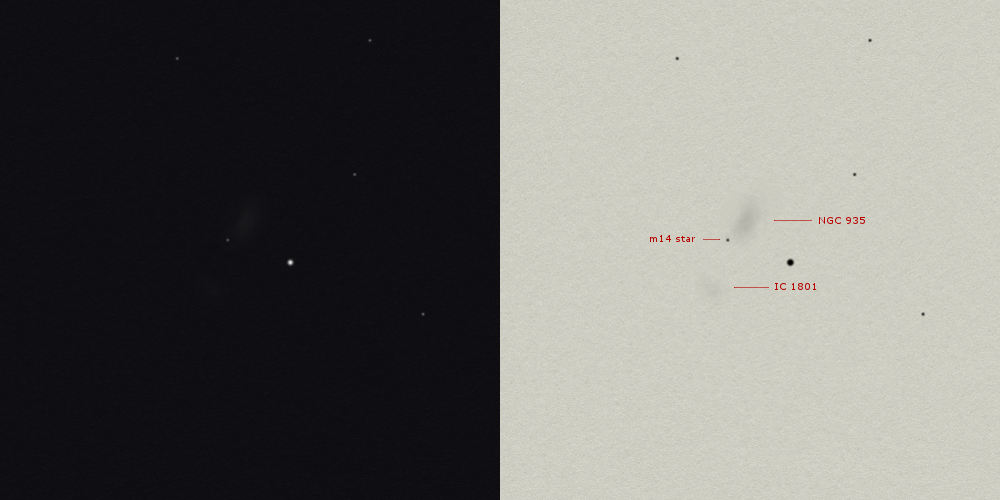
Small, but the galaxy is easily seen with a somewhat brighter core zone. Loose component IC 1801 is tough and difficult to see with AV. The couple is right next to a pretty bright (m10) star. On the S side of NGC 935 a dim m14 star is seen towards the galaxy seems to curl.
Arp 277 – NGC 4809 and NGC 4810
NGC 4809: mag 14.2, size 1.6′ x 0.9′
NGC 4810: mag 14.8, size 0.8′ x 0.5′
Challenge: Mottled structure around both galaxies, caterpillar shape of NGC 4809 (N)
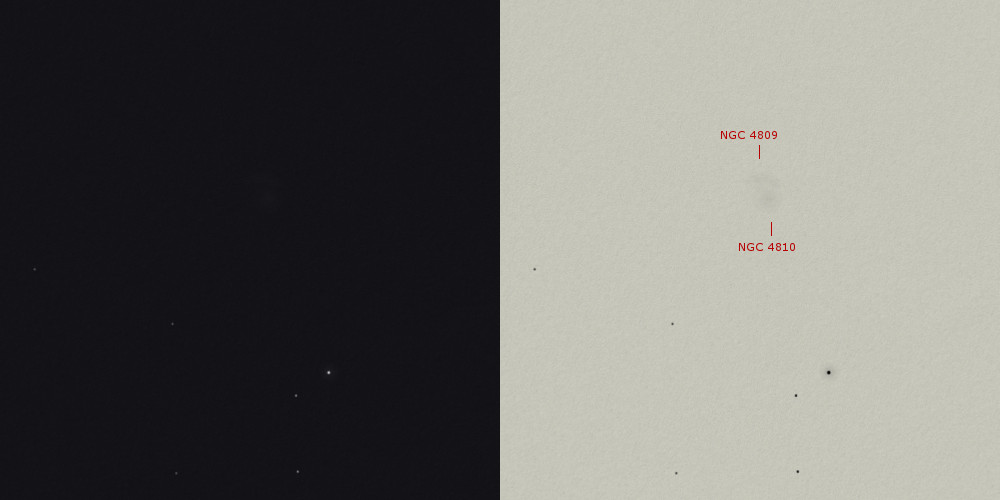
Nice Arp, but dim. Two galaxies in close contact, but seen separated. NGC 4810 is brightest and appears round. NGC 4809 is dimmer and more stretched, a bent shape is noticed. Both galaxies are only seen with AV.
Arp 278 – NGC 7253A and NGC 7253B
NGC 7253A: mag 13.6, size 1.7′ x 0.7′
NGC 7253B: mag 14.4, size 1.6′ x 0.5′
Challenge: Asymmetry in the outer areas (N)
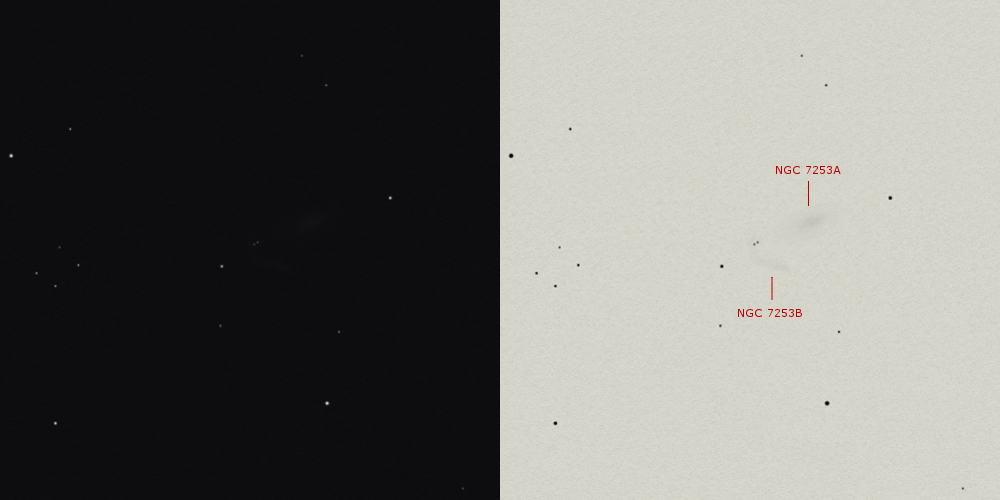
Nice but faint duo. NGC 7253A is brightest and is best seen with AV as a stretched galaxy with some central brightening. Almost perpendicular to it is NGC 7253B and is barely seen with AV as a streak of light. The two are “separated” by a dim double star (m15.4) which give this Arp a nice touch. A dark sky is mandatory.
Arp 279 – NGC 1253 and NGC 1253A
NGC 1253: mag 11.7, size 5.3′ x 2.3′
NGC 1253A: mag 14.4, size 1.3′ x 0.8′
Challenge: Texture in both galaxies and the arcing arm to the W of NGC 1253A (P)
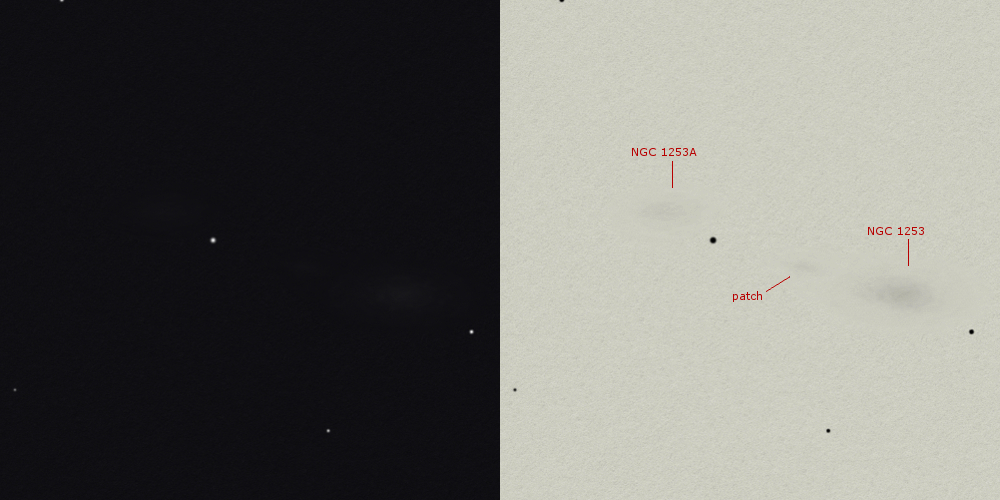
When the object sails into view I see a thick and grainy “cigar” in an interesting star field. E of the cigar there is a tiny puff of smoke, but it’s on the limit of visibility. In line and on the other side of the brightest star in the center NGC 1253A is seen quite easy with AV. The two galaxies form a nice appearance.
Arp 280 – NGC 3769 and NGC 3769A
NGC 3769: mag 12.6, size 3.3′ x 0.9′
NGC 3769A: mag 14.7, size 1.0′ x 0.4′
Challenge: Structure in both galaxies and knot N in 3769 (P)
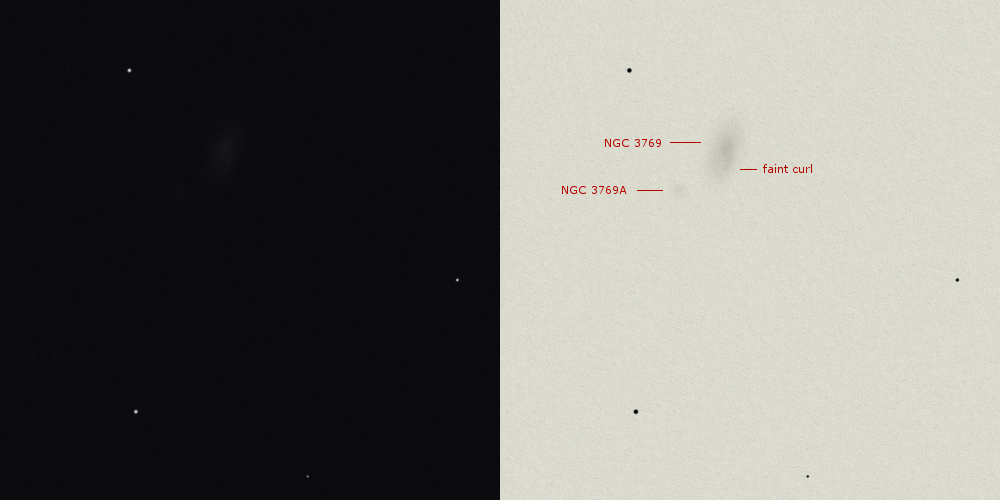
NGC 3769 is well visible; oval shaped with a brighter core area and suspicion of a curl in the direction of the companion. This NGC 3769A is small and very dim without any detail. Nice pair, a bit like a mini-cocoon.
Infall and attraction (Arps 281 – 286)
Arp 281 – NGC 4627 and NGC 4631
NGC 4627: mag 13.1, size 2.6′ x 1.8′
NGC 4631: mag 9.8, size 15.5′ x 2.7′
Challenge: Plumes N and S of NGC 4627; filamentary absorption structures throughout body of NGC 4631 (P)
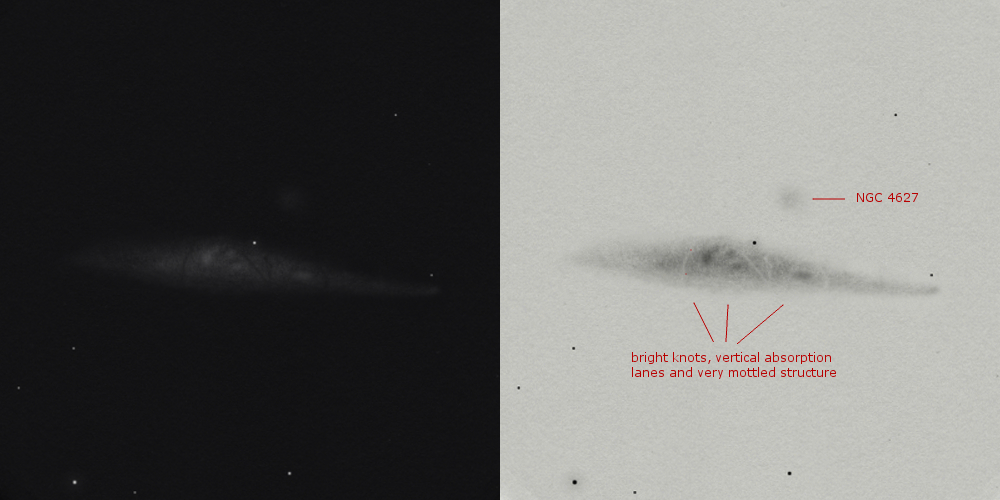
This is “The Whale” or “Herring” galaxy and the resemblance is striking. The size of NGC 4631 is enormous and fills a great deal of the field. The core is not clearly defined but looks more as if snowballs have been thrown at it. The surface is highly mottled and absorption lanes can be suspected, running vertically through the center. NGC 4627 can just be seen with DV as a dim smudge. A bright star is located between it and the core of NGC 4631.
Arp 282 – NGC 169 and IC 1559
NGC 169: mag 12.4, size 2.7′ x 0.7′
IC 1559: mag 14.7, size 0.8′ x 0.4′
Challenge: The spirals in NGC 169 (N)
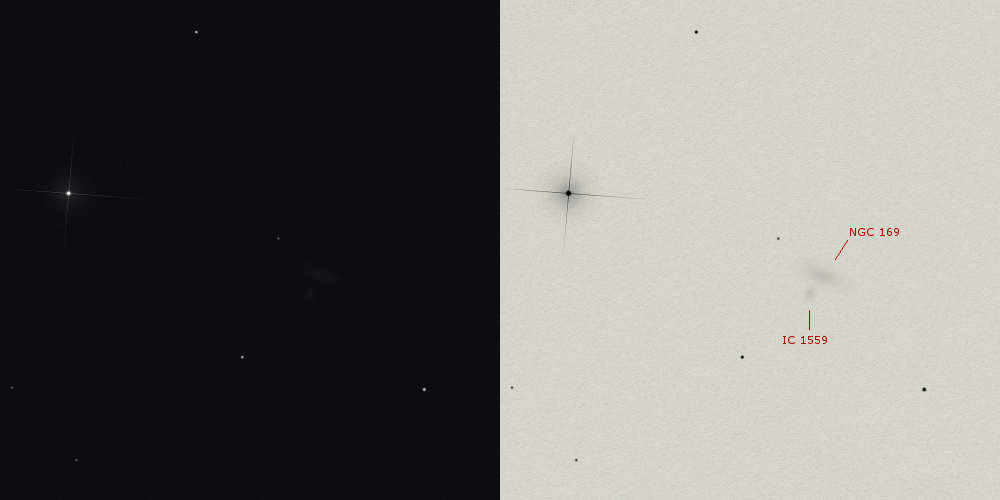
Two galaxies really close to one another, but seen separated. NGC 169 is stretched and dim, best seen with AV. IC 1559 is even dimmer, smaller and round. It’s nearly perpendicular to the NGC galaxy. A very bright mag 6.3 star adorns the field, but it complicates a good observation.
Arp 283 – NGC 2798 and NGC 2799
NGC 2798: mag 12.3, size 2.6′ x 1.0′
NGC 2799: mag 14.3, size 1.9′ x 0.5′
Challenge: Knots in 2799 and the faint arcing wisp to N of 2798 (N)
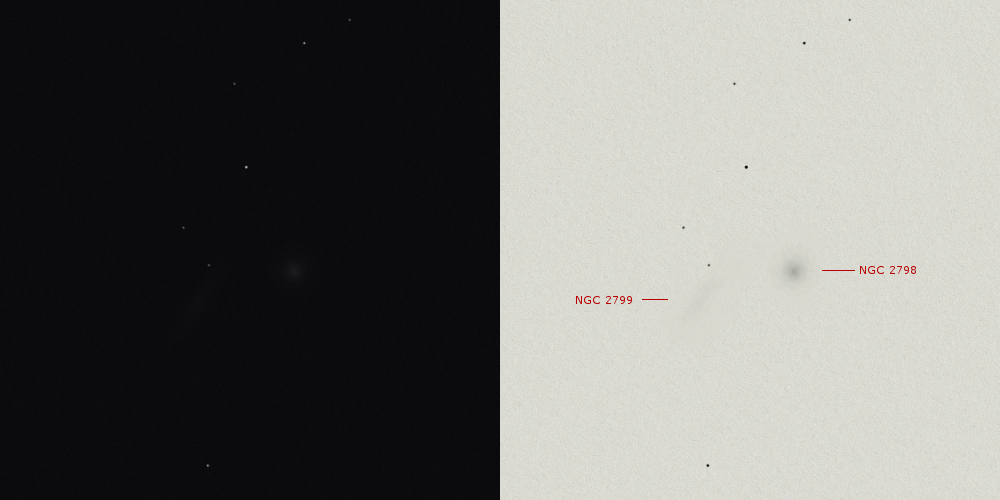
NGC 2798 is pretty bright with a round core area and a round haze around it. With AV NGC 2799 can be seen as well with a needle shape (difficult). No further details are observed.
Arp 284 – NGC 7714 and NGC 7715
NGC 7714: mag 12.5; size 2.2′ x 1.1′
NGC 7715: mag 14.5; size 2.6′ x 0.5′
Challenge: Detect the tails and counter-tails (N)
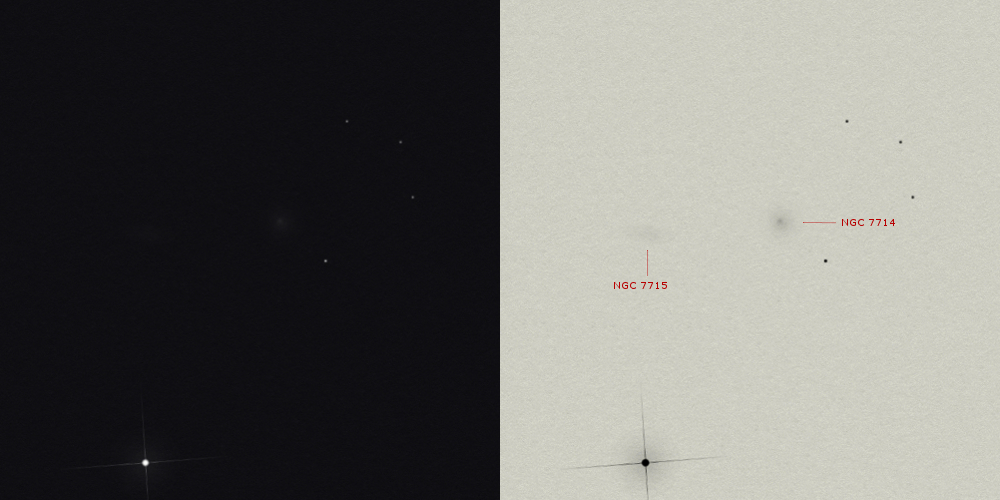
Two galaxies at quite a large distance from each other. No nebulosity seen between the two. NGC 7714 is clearly the brightest, round and with a bright and small core area. NGC 7715 is hard to see with AV, but is clearly linear with even brightness accross the surface. The very bright 16 Psc (m5.9) is in the same field of view and makes a proper observation of the galaxies difficult.
Arp 285 – NGC 2854 and NGC 2856
NGC 2854: mag 13.0, size 1.7′ x 0.6′
NGC 2856: mag 14.1, size 1.1′ x 0.5′
Challenge: Jet from core of NGC 2856, pointing away from NGC 2854, and spiral arms in 2854 (N)
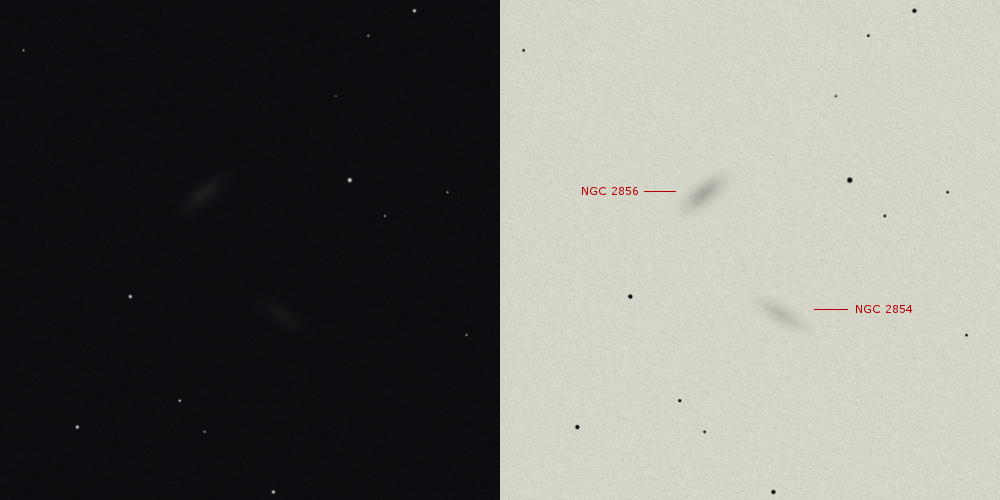
These two galaxies are rather far apart and don’t seem to influence each other. Both can be seen (perpendicular) with DV. NGC 2856 is slightly broader, brighter and larger. No jet or spiral structure seen.
Arp 286 – NGC 5566 group
NGC 5560: mag 13.2, size 3.7′ x 0.7′
NGC 5566: mag 11.5, size 6.6′ x 2.2′
NGC 5569: mag 13.9, size 1.7′ x 1.4′
Challenge: Ring and split in NE arm of NGC 5566 (N)
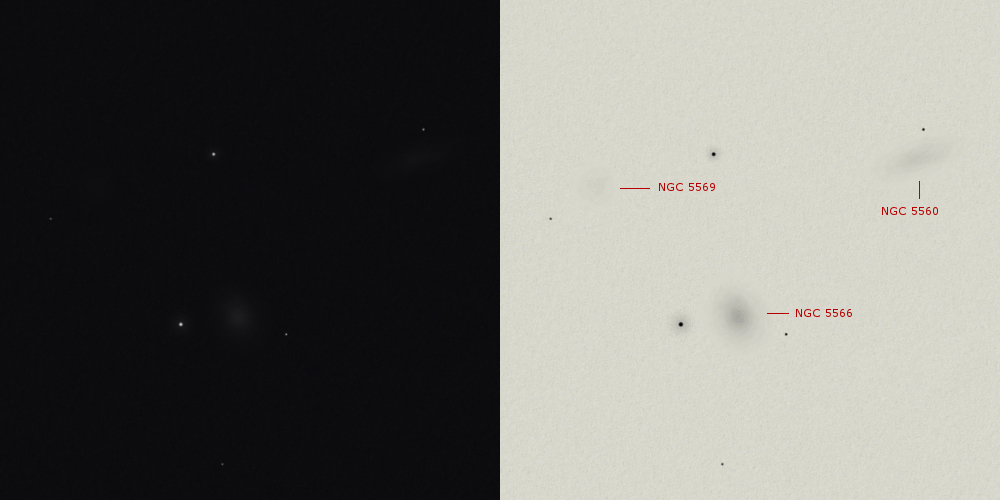
This a very bright group, at least two of the three galaxies. NGC 5566 is most prominent and very bright with a slightly oval core. The weak outer part could not be seen. NGC 5560 is also quite apparent with DV and is seen as a fat stripe. NGC 5569 completes the group and is seen with difficulty with AV like a round stain without central brightening.
Wind effects (Arps 287 – 293)
Arp 287 – NGC 2735 and NGC 2735A
NGC 2735: mag 13.3, size 1.2′ x 0.4′
NGC 2735A: mag 15.3, size 24″ x 12″
Challenge: NGC 2735A and the detached segment at PA 260° of NGC 2735 (P)
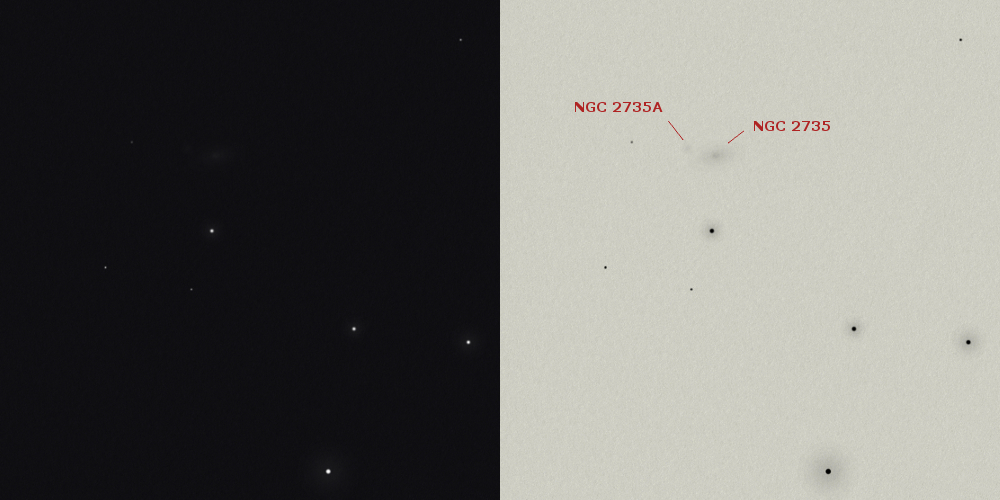
Two small galaxies, seen detached from each other. 2735 (W) is a stretched oval (3:1) with a brighter core area. E of it, almost in line, 2735A can sometimes be glimpsed as a round and small cloud. The surrounding star view is attractive; four bright stars adorn the field in a “Y” shape.
Arp 288 – NGC 5221 and NGC 5222
NGC 5221: mag 13.8, size 2.4′ x 0.8′
NGC 5222: mag 14.1, size 1.3′ x 1.0′
VV 315c: seze 0.6′ x 0.3′
Challenge: Inner arms, plume NW, and looping arm SE of 5221; structure in VV 315c; faint wisp off SW of stellar object to SE of 5222 (N)
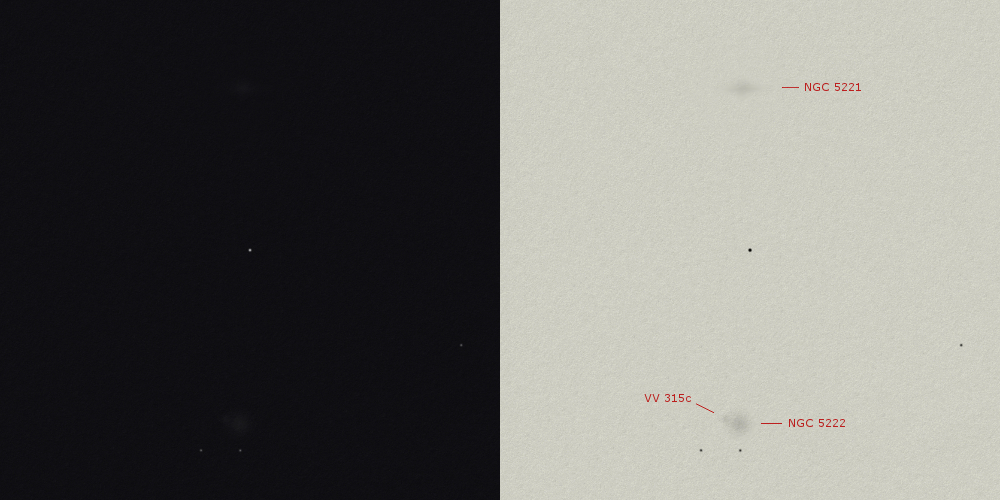
nice and bright couple, easily seen with direct sight. NGC 5222 is the brightest and largest of the two, seen round. Against two dim stars. With AV the companion VV 315c is seen right against the mother galaxy. NGC 5221 is only a bit dimmer and smaller and appears round at first sight. However, with AV the galaxy’s stretched shape is seen.
Arp 289 – NGC 3981
mag 12.1, size 5.3′ x 2.3′
Challenge: Asymmetry in main arms and one or more of the faint filaments (N)
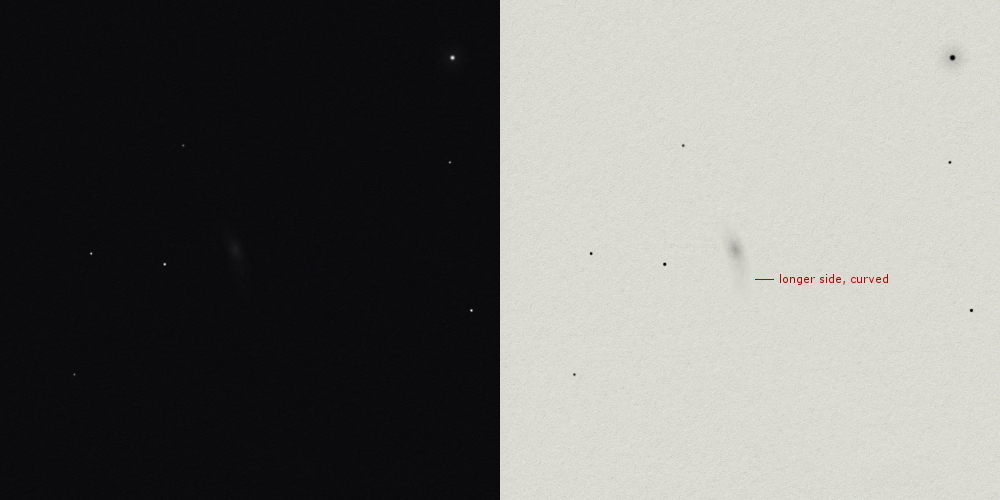
NGC 3981 is a bit of an asymmetrical one. The mottled core area can be seen with DV, but with AV the extension is seen. The S-side is longest and appears to slightly bend near the tip. The N-side is shorter, but quite broad.
Arp 290 – IC 195 and IC 196
IC 195: mag 13.9, size 1.2′ x 0.6′
IC 196: mag 13.6, size 2.8′ x 1.4′
Challenge: Distorted arms at both ends of IC 196 (P)

Both galaxies are seen with DV and IC196 is showing some nice features; two patches and a slightly curved arm. With that at least a part of the challenge is accomplished. The pair resides in an attractive star field.
Arp 291 – UGC 5832
mag 13.7, size 1.2′ x 1.0′
Challenge: Offset outer ring (P)
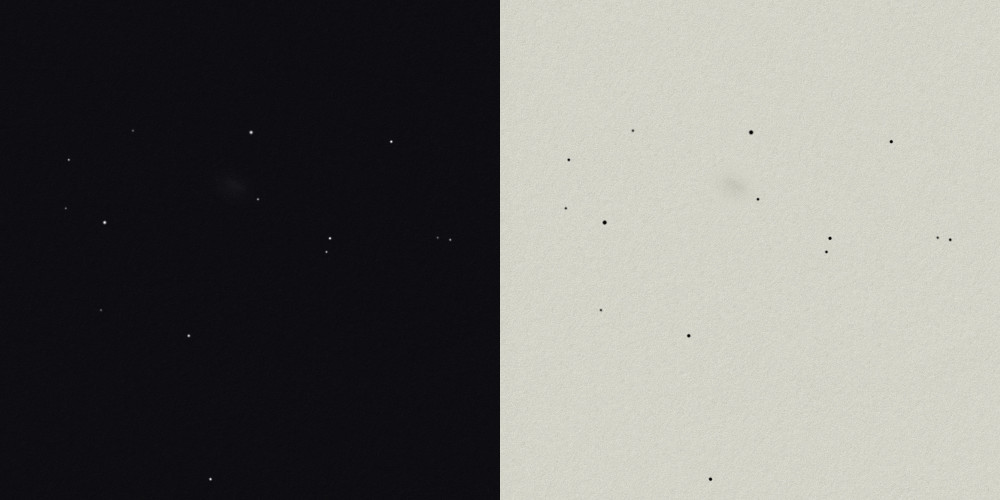
Rather dim and slightly oval shaped galaxy with a bar seen running through it. Only seen with AV. Resides in a rich star field.
Arp 292 – IC 575 and companions
IC 575: mag 14.0, size 1.7′ x 1.2′
MCG-1-25-57: mag 16.6, size 0.4′ x 0.2′
Challenge: NW and SE extensions with absorption features (N)
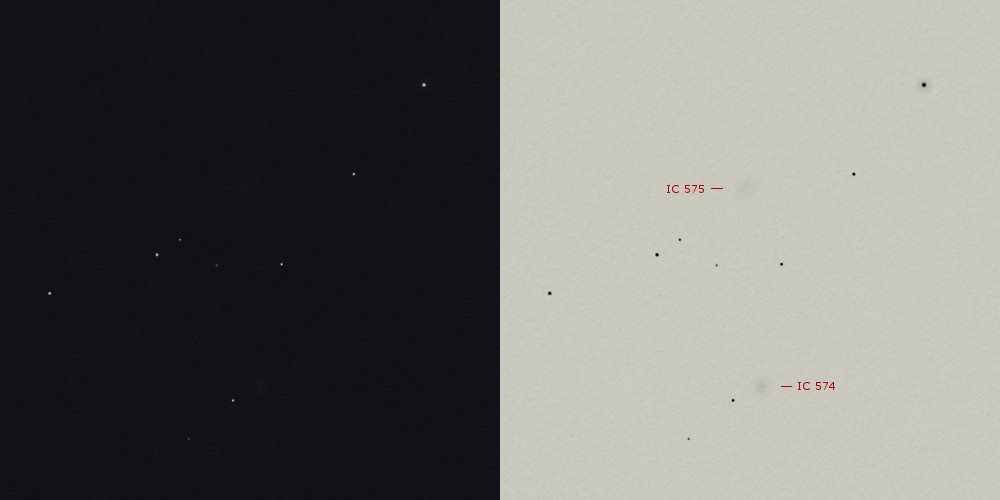
Shares the field with non-related IC 574, which is a bit brighter and appears perfectly round. IC 575 is slightly oval and the direction can just be seen. Needs AV to be spotted. The companion could not be detected because it’s too dim.
Arp 293 – NGC 6285 and NGC 6286
NGC 6285: mag 14.5, size 0.9′ x 0.5′
NGC 6286: mag 13.3, size 1.5′ x 1.4′
Challenge: Faint arc SE of NGC 6286 (N)
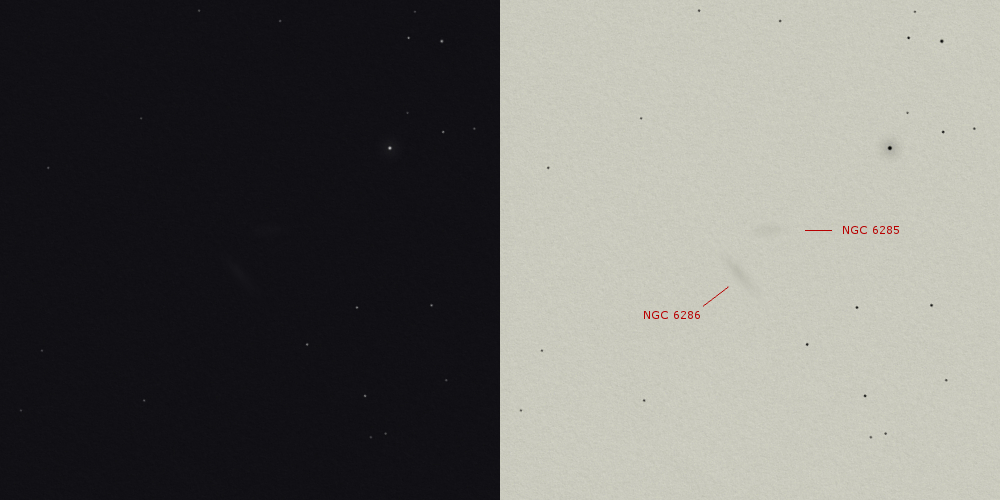
A weak duo, but they can just be seen with DV. NGC 6286 is the brightest and largest of the two. They seem to be pointing to a common center of gravity and reside in a rich star field. The faint arc is not seen.
Long filiments (Arps 294 – 297)
Arp 294 – NGC 3786 and NGC 3788
NGC 3786: mag 13.5, size 2.2′ x 1.3′
NGC 3788: mag 13.5, size 2.1′ x 0.7′
Challenge: N filament off NGC 3788, ring around 3786 (N)
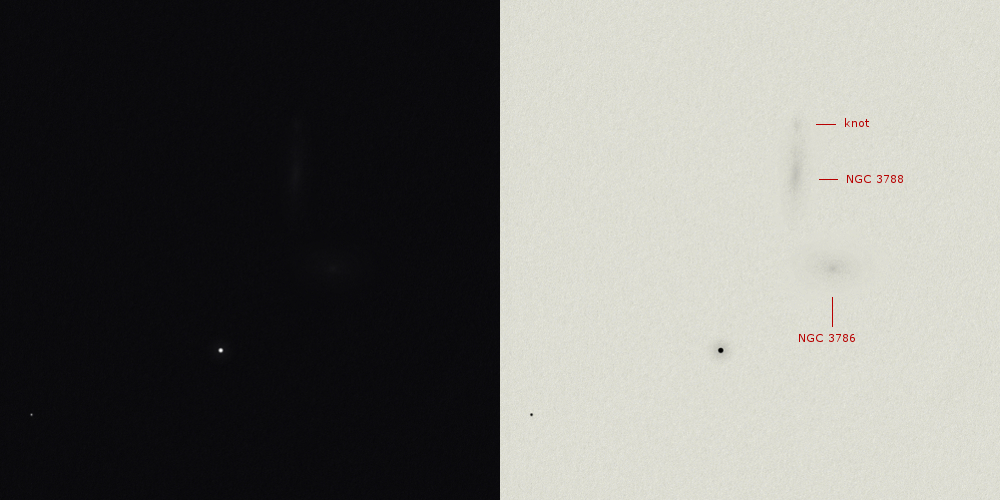
Nice pair, seen separated from each other without any influence visible. NGC 3788 is the brightest of the two and almost needle-like with a stretched core. At the N tip a brighter spot can be seen. NGC 3786 is somewhat dimmer, but can still be seen with DV. It clearly posessed a stellar core and with AV it appears quite large.
Arp 295 – MCG-1-60-21 and -22 and companions
MCG-1-60-21: mag 14.5, size 1.4′ x 0.1′
MCG-1-60-22: mag 14.6, size 0.9′ x 0.5′
MRK 933: mag 13.3, size 0.4′
LEDA 3083323: mag 14.7, size 0.5′ x 0.2′
IC 1505: mag 14.7, size 0.4′
Challenge: Both tails, all named galaxies, and absorption structure in -21 (N)
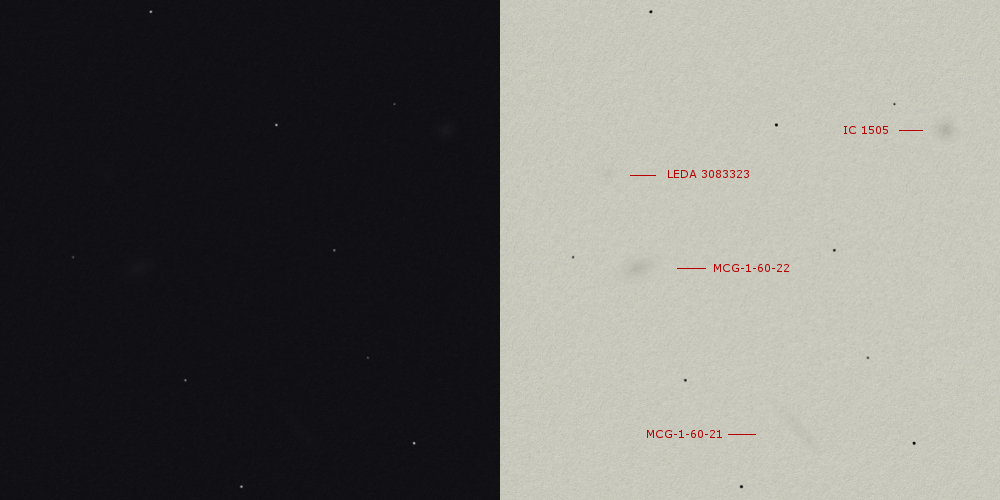
Nice, but dim group of galaxies in a rich starfield. The brightest member (but not part of the Arp) is IC 1505. This one is bright, seen with DV, round and uniformly brightened. Somewhat dimmer is MCG1-6-22, but also this one can be seen with DV. it is slightly oval and uniformly brightened as well. MCG-1-60-21 is seen with AV as a long streak of light. Close to it, LEDA 3083323 is seen with effort and can’t be held continuously with AV.
Arp 296 – PGC 35345 and companion
mag 15.7, size 0.5′ x 0.5′
Challenge: Full extent of the filament between galaxies (N)
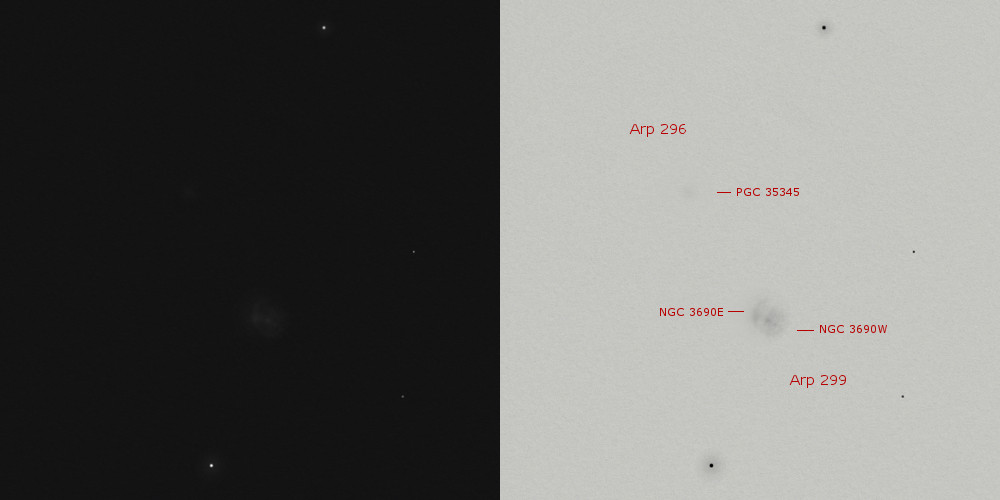
In the same field as Arp 299. PGC 35345 can only be seen with difficulty with AV as a tiny speck of light. Very difficult!
Arp 297 – NGC 5752 through NGC 5755
NGC 5752: mag 15.3, size 0.8′ x 0.4′
NGC 5753: mag 15.9, size 0.6′ x 0.5′
NGC 5754: mag 14.5, size 2.0′ x 1.8′
NGC 5755: mag 16.2, size 1.3′ x 1.0′
Challenge: Wide spirals of 5754 and loop of 5755 (N)

Final object of the night (4:30) before moisture issues worsen. Perhaps because of that (or fatigue), NGC 5753 was missed. NGC 5754 is largest and brightest, visible with DV and with a stellar core zone. NGC 5752 is close by and is seen with AV as most difficult one of the group. NGC 5755 further north is seen with AV a bit more easy.
Double galaxies (Arps 298 – 310)
Arp 298 – NGC 7469 and IC 5283
NGC 7469: mag 12.3; size 1.5′ x 1.1′
IC 5283: mag 14.8; size 0.8′ x 0.4′
Challenge: Wide spiral structure and asymmetry in companion (N)
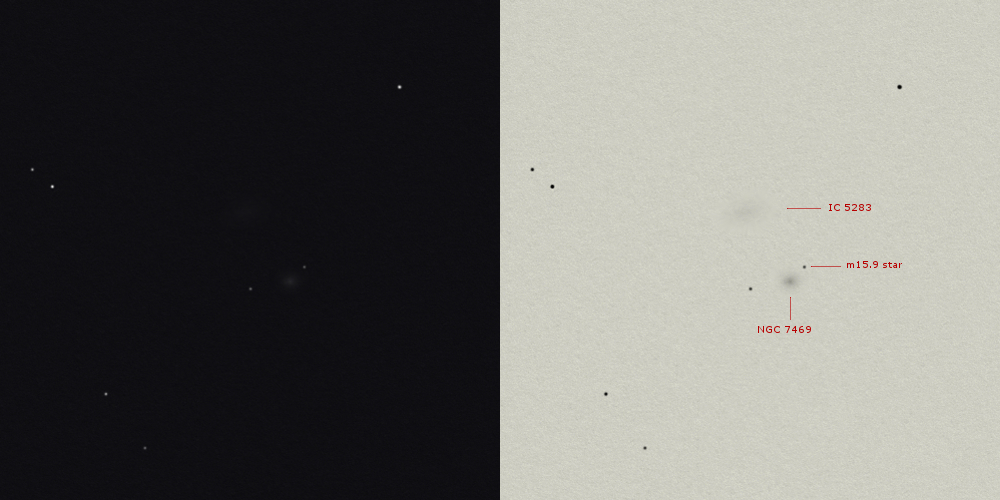
Two galaxies of which the very small NGC 7469 is brightest. The core is slightly oval shaped and almost looks like a planetary nebula. IC 5283 is harder and can only be seen with AV, but the shape is visible. Close to NGC 7469 are two stars, of which the dimmest is m15.9
Arp 299 – NGC 3690 group
VV 18a: mag 12.0, size 2.0′ x 1.5′
VV 18b: mag 11.8, size 1.2′ x 1.0′
VV 18c: mag 16.0, size 0.2′
Challenge: Knots, plumes around nucleus, and the big tails (N)
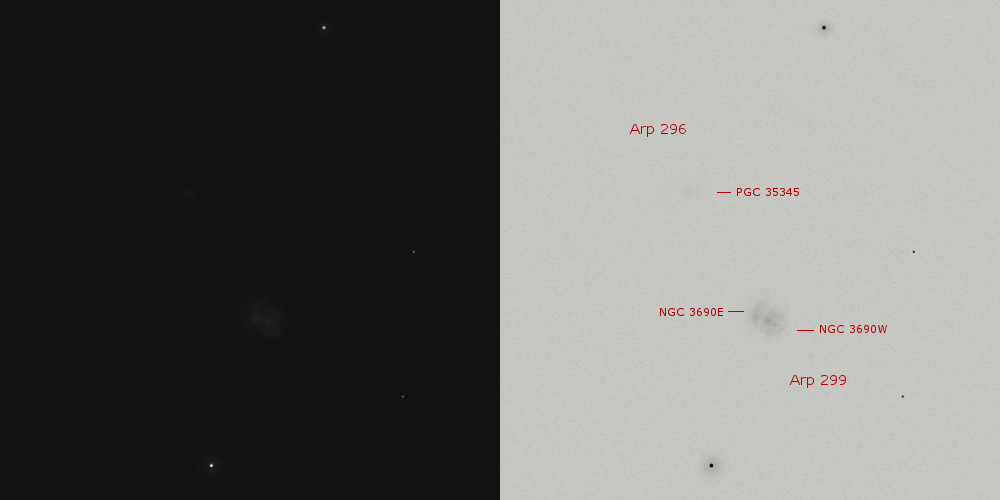
In the same field as Arp 296. NGC 3690 is split in a W and E side by a dark lane, both have a brighter core zone. 3690E is dimmest and has a bent shape towards W. 3690W is brightest and appears to have a second (small and dim) core to the W side. The shape is somewhat triangular. A beautiful galaxy, but unfortunately IC 694 was missed.
Arp 300 – UGC 5028 and UGC 5029
UGC 5028: mag 14.3, size 0.7′ x 0.4′
UGC 5029: mag 13.4, size 1.6′ x 1.0′
Challenge: The asymetrical structure in both galaxies (N)

Two dim galaxies close to each other, but not touching. UGC 5028 can be seen with DV and is slighty oval shaped. UGC 5029 has more or less the same shape, but slightly different angle and can only be seen with AV. Around the two galaxies there appears to be a large “question mark” of dim stars.
Arp 301 – UGC 6204 and UGC 6207
UGC 6204: mag 14.8, size 0.8′ x 0.5′
UGC 6207: mag 15, size 1.4′ x 0.2′
Challenge: Faint spiral arm with knot on SE part of 6204 (N)
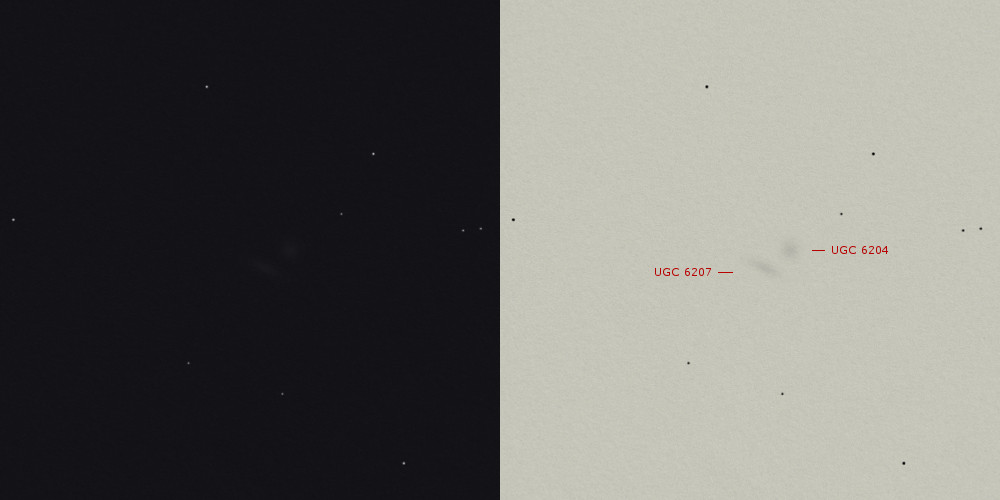
Both galaxies seen with DV. UGC 6204 appears round with some central brightening and is seen separated from UGC 6207. The latter galaxy is more needle-shaped and about as bright as its companion.
Arp 302 – UGC 9618
MCG+4-35-18: mag 15.3, size 0.6′
MCG+4-35-19: mag 14.6, size 0.9′ x 0.3′
Challenge: Spiral structure in MCG+4-35-18 (N)
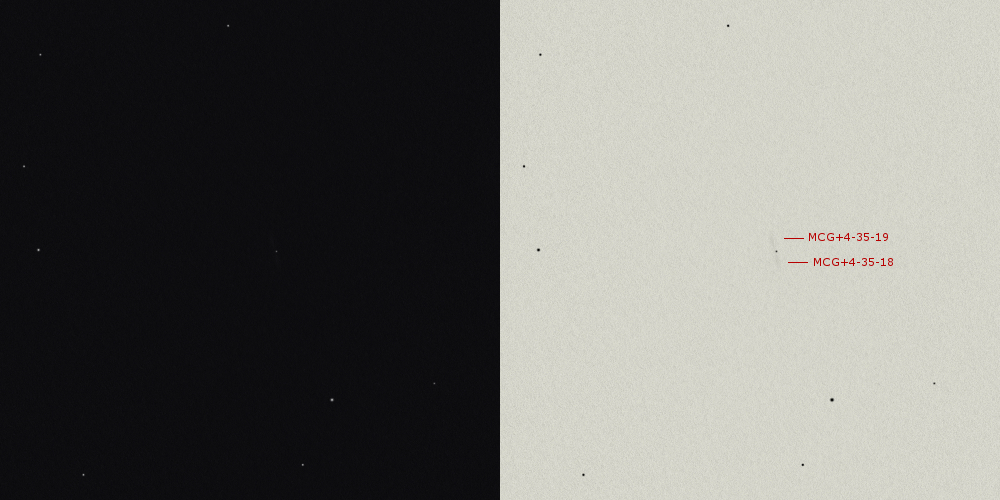
The exclamation mark nebula. Seen as a line through a dim star. With high power however two galaxies can be seen on both sides of the star, each with some central brightening. Only seen with AV, but the “needle” shape is recognized.
Arp 303 – IC 563 and IC 564
IC 563: mag 14.7, size 1.0′ x 0.4′
IC 564: mag 14.0, size 1.9′ x 0.5′
Challenge: IC 563 N arm and W wisp. IC 564 knotty core and ENE wisp (N)
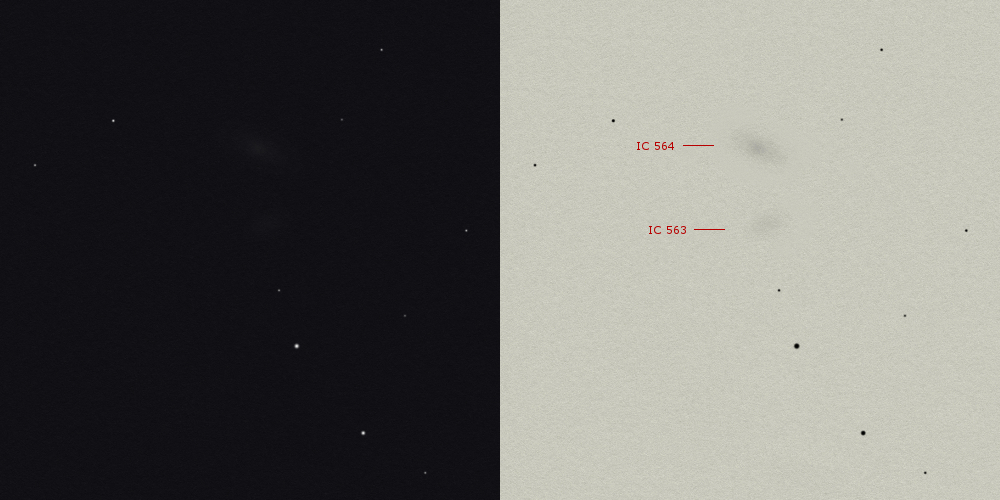
Easy and bright couple. IC 564 is het brightest and largest of the two, oval shaped with a clear core zone and this galaxy can even be seen with DV. IC 563 is a bit dimmer and smaller, but is easily picked up with AV, slightly oval shaped and without any brightening towards the center. The two galaxies are more or less in line with a well visible star chain.
Arp 305 – NGC 4016 and NGC 4017
NGC 4016: mag 13.8, size 1.5′ x 0.8′
NGC 4017: mag 13.0, size 0.3′ x 0.2′
Challenge: Weak filament between galaxies; loops in 4016 (N)
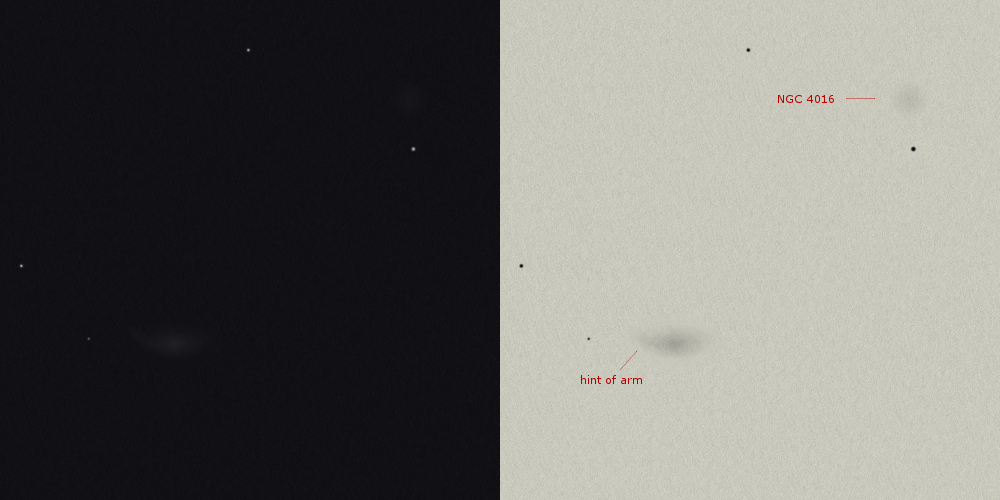
Nice duo with NGC 4016 as a dim and round galaxy, almost only visible with AV, but with a somewhat brighter core. NGC 4017 is a quite large, oval glow with an apparent bean shape. Best seen with AV, but brighter than NGC 4016.
Arp 306 – UGC 1102 and UGC 1105
UGC 1102: mag 14.3, size 1.3′ x 1.1′
UGC 1105: mag 17.0, size
Challenge: Lumps E and S in UGC 1102 (N)
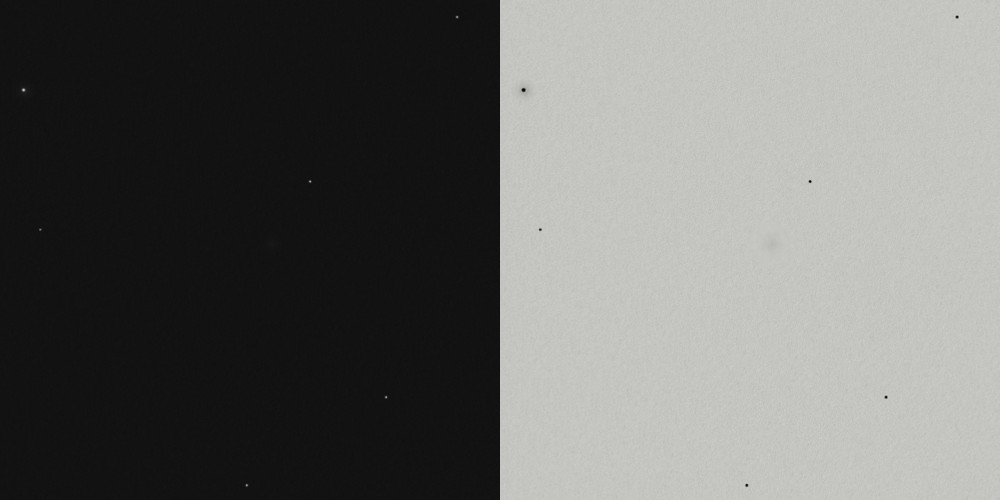
Seen as a dim smear of light, hard with AV. A detailed chart is needed to find the galaxy; a small, round cloud in a field with not many stars. The companion (UGC 1105) could not be spotted.
Arp 307 – NGC 2872 and NGC 2874
NGC 2872: mag 12.9, size 2.1′ x 1.8′
NGC 2873: mag 15.3, size 0.6′ x 0.2′
NGC 2874: mag 13.4, size 2.4′ x 0.7′
Challenge: Spiral arm in NGC 2874 (P)
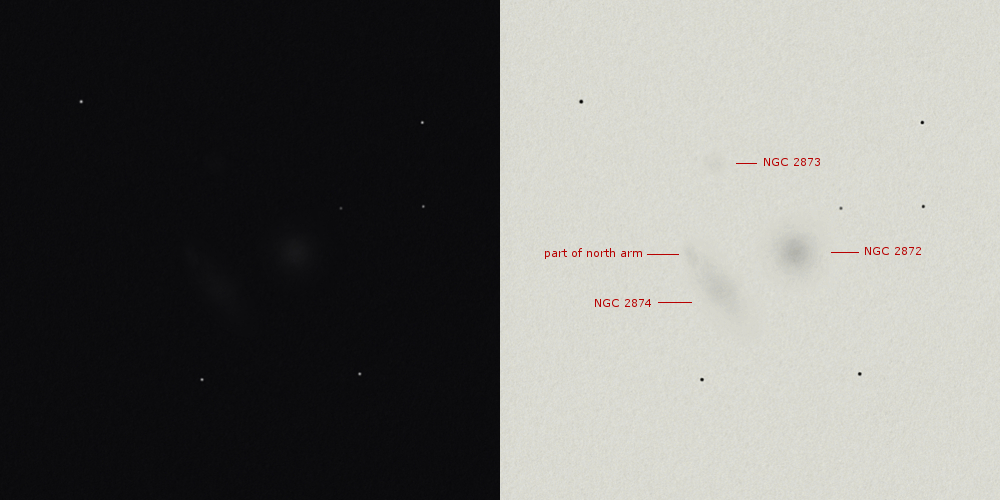
This one consists of main galaxies NGC 2872 and NGC 2874, where the first is the brightest and round with a bright core. NGC 2874 is supposed to show a spiral arm, but I only see a part of it at the end at the N-E tip. Close by, NGC 2873 can be seen with effort as a dim stain.
Arp 308 – NGC 545 and NGC 547
NGC 545: mag 12.2, size 2.4′ x 1.6′
NGC 547: mag 13.2, size 1.3′
Challenge: Large extent of out halo (N)
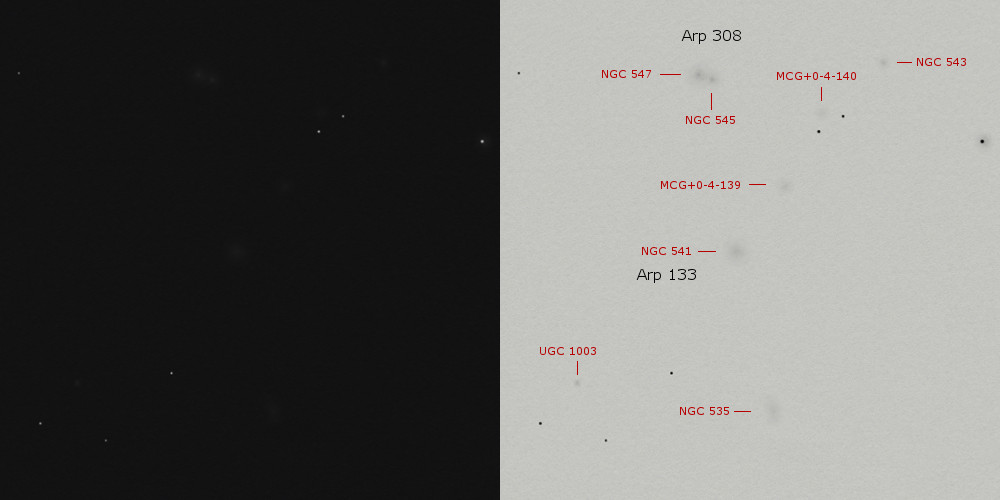
This is a beautiful field where many galaxies can be discerned. Besides, it’s always nice to see to Arps in one view. One galaxy was sketched as a star, but appeared to be UGC 1003 when checking afterwards. So in total 8 galaxies were observed in a FOV of only 16′. Very nice.
Arp 309 – NGC 942 and NGC 943
NGC 942: mag 14.9, size 0.4′ x 0.25′
NGC 943: mag 14.0, size 0.4′ x 0.25′
Challenge: Absorption structure to NE of 943 (N)
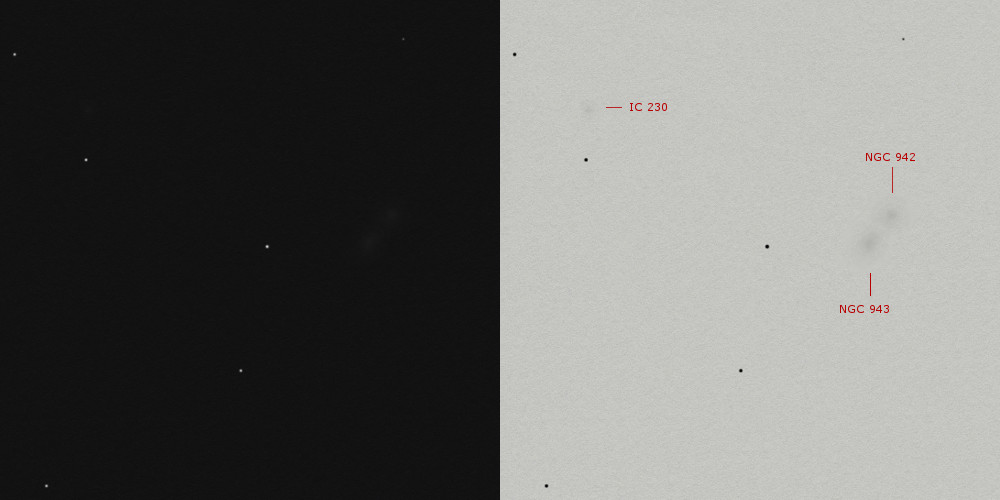
This is a bright couple of two galaxies with the same brightness. With AV another small galaxy is noted in the same field (IC 230). NGC 942 has a bit more stellar core, while NGC 943 is more oval shaped than its neighbor. Both are easily seen with DV.
Arp 310 – IC 1259, VV101
IC 1259 (VV 101a): mag 15; size 0.8′ x 0.4′
IC 1259-1 (VV 101b): mag 15; size 0.3′ x 0.3′
Challenge: Full extent of material enveloping both galaxies (P)
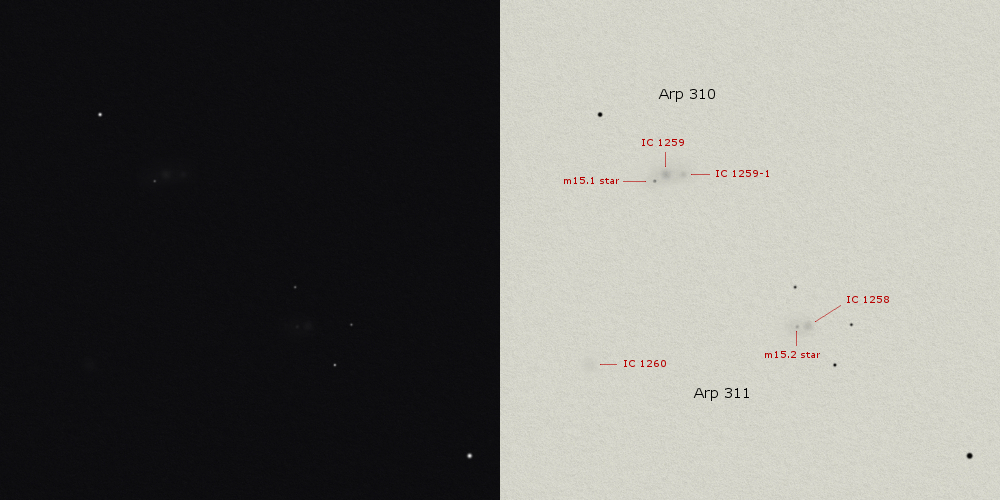
Arp 310 is part of Arp 311 and consists of IC 1259 and the dimmer IC 1259-1 (VV 101b) right against it. On the other side a dim m15 star is visible. These 3 components are confined in just 30 arc seconds of space, so increasing magnification is key. This small group is the brightest of all objects in view.
Groups of galaxies (Arps 311 – 321)
Arp 311 – IC 1258 through IC 1260
IC 1258: mag 14.3; size 1.0′ x 0.8′
IC 1260: mag 15.7; size 0.6′
Challenge: Faint bridge between the Arp 310 pair and IC 1258 (N)

Arp 310 and Arp 311 are overlapping Arps and are in the same field of view, even at 362x. At the SW of the field IC 1258 is seen as a weak knot with (also here) right against it a dim m15 star that appears a bit fluffy. this galaxy can be seen with DV, but it’s less bright than IC 1259. To the E the dimmest and smallest galaxy can be glimpsed: IC 1260. This one is almost stellar. Nice group!
Arp 312 – MCG+8-31-1 through -6
MCG+8-31-4: mag 16.0, size 1.0′ x 0.8′
MCG+8-31-5: mag 15.4, size 0.4′
MCG+8-31-6: mag 15.7, size 0.3′
Challenge: Detect bridge between closer pair, and faint plumes from ends of pair (N)
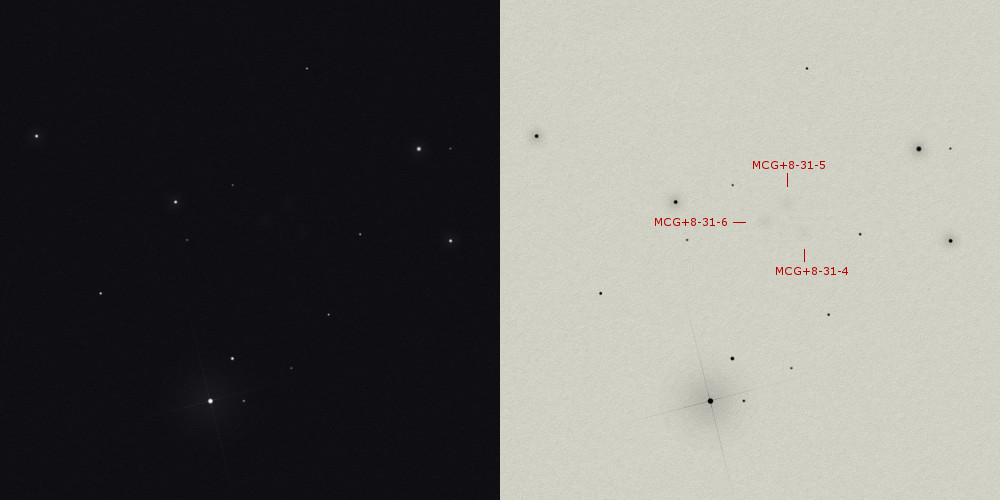
Nice group of three galaxies, arranged in a triangle. The northern two are closest to each other and also the largest and brightest; they can both be seen with AV. MCG+8-31-4 is quite difficult, but can be managed as well in the end. These galaxies are tiny and it requires high power to separate them in a nice way and also to keep a very bright star just outside the FOV. The rest of the star field looks beautiful too.
Arp 313 – NGC 3991/3994/3995
NGC 3991: mag 13.5, size 1.4′ x 0.4′
NGC 3994: mag 13.3, size 1.0′ x 0.6′
NGC 3995: mag 12.7, size 2.8′ x 1.1′
Challenge: String of knots in 3995, lumps in 3991 (P)
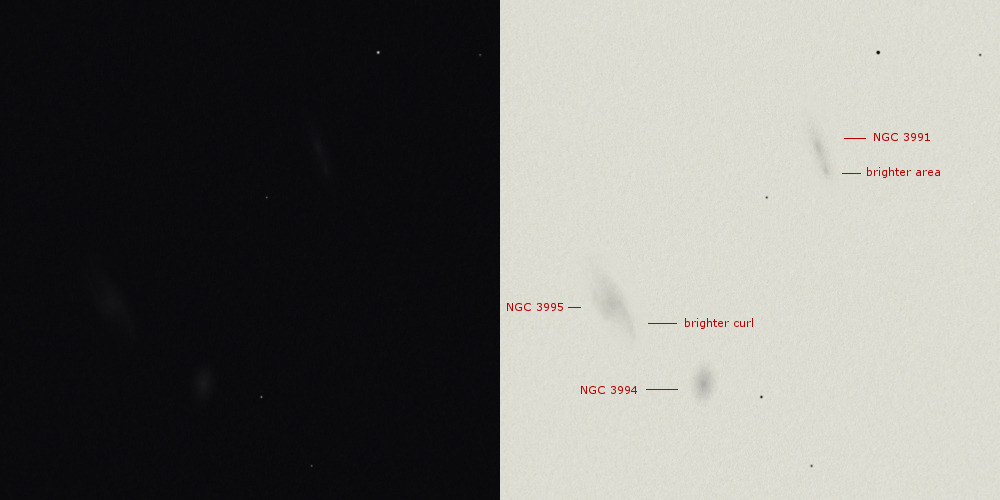
Very nice group of three galaxies with different appearance. NGC 3991 is the dimmest, but easily seen with DV. It has a needle shape and a brighter spot on the S tip, only a bit dimmer than the (off center) core. NGC 3994 is the smallest of the three, but it appears brightest. The shape is oval. NGC 3995 is the largest and shows a hint of an S-shape. It looks like a spiral arm is escaping to the S, but the individual knots of the string can’t be seen. The W side has a sharper edge, while the E side shows a bit of a bulge.
Arp 314 – MCG-1-58-9 through -11 Galaxy group
MCG-1-58-9: mag 13.7, size 1.1′ x 0.9′
MCG-1-58-10: mag 13.8, size 1.3′ x 1.1′
MCG-1-58-11: mag 16.0, size 1.1′ x 0.9′
Challenge: Extremely faint rings and tails (N)
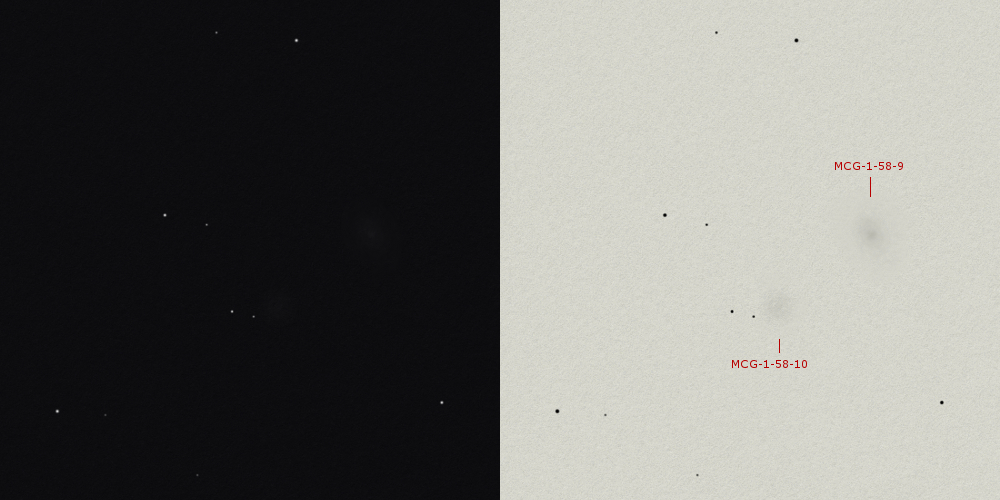
MCG-1-58-9 is pretty bright and seen directly as a large, oval cloud with some brightening towards the core. MCG-1-58-10 can be seen directly too (just). The brightness is more evenly distributed accross this galaxy and it appears round. Close to two stars. The components were not seen.
Arp 315 – NGC 2830 through NGC 2832 Galaxy group
NGC 2830: mag 15.3, size 1.3′ x 0.3′
NGC 2831: mag 14.7, size 1.4′
NGC 2832: mag 12.3, size 2.3′ x 1.9′
Challenge: Separate 2831 and 2832 (Y)

Five galaxies in one field of view, of which NGC 2825 and NGC 2834 are out of the Arp group. NGC 2830 is hard to see with AV, but the needle shape and PA can be observed. NGC 2831 is mainly visible with AV. it’s dim, small and has no obvious core area. it’s seen loose from NGC 2832. The latter is easily seen with a pretty bright core and soft halo around it. This is a nice and compact group.
Arp 316 – NGC 3193 group in Hickson 44 Galaxy group
NGC 3187: mag 13.9, size 3.0′ x 1.3′
NGC 3190: mag 12.1, size 4.4′ x 1.5′
NGC 3193: mag 11.8, size 3.0′ x 2.7′
Challenge: Spirals of NGC 3187 and SW companion. Dust lane in NGC 3190 (N)
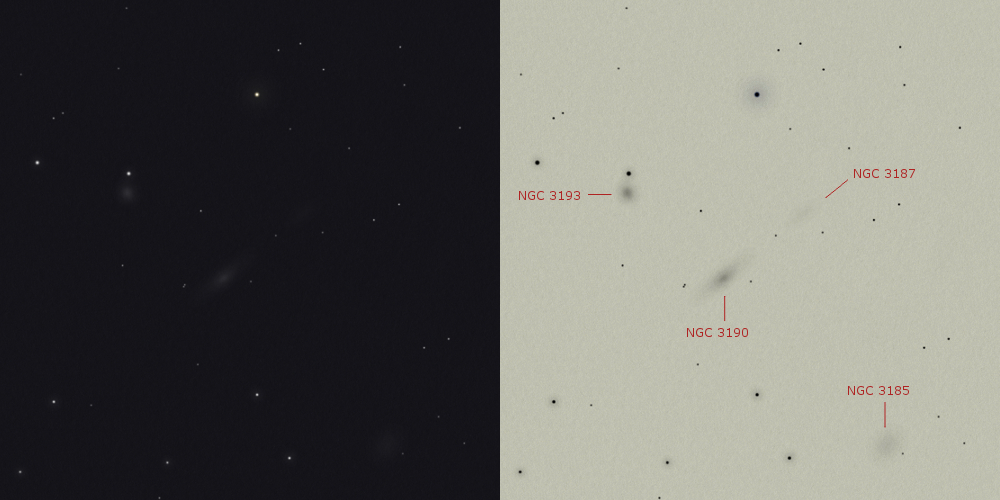
Very nice group of three galaxies in the neck of Leo. I choose a low magnification to nicely frame the fourth Hickson galaxy too. 3193 is very bright, round and with a relatively large core area close to a brighter star. 3190 is stretched and the slightly oval centre is a bit brighter. It is about as eyecatching as 3193. That can’t be said of 3187, which is only visible with AV. It has a thick needle shape too, pointing in exactly the same direction as 3190. Lastly, at some distance 3185 is seen as an almost round stain of nebulosity with a hardly brighter core. It can be seen with DV. The four galaxies reside in a nice starfield with big differences in magnitude.
Arp 317 – The Leo Triplet; M65, M66 and NGC 3628
M65: mag 10.3, size 9.8′ x 2.9′
M66: mag 9.7, size 9.1′ x 4.2′
NGC 3628: mag 10.3, size 14.8′ x 3.0′
Challenge: M66 asymetry, NGC 3628 dust lane, quasars and chain of optical objects (P)
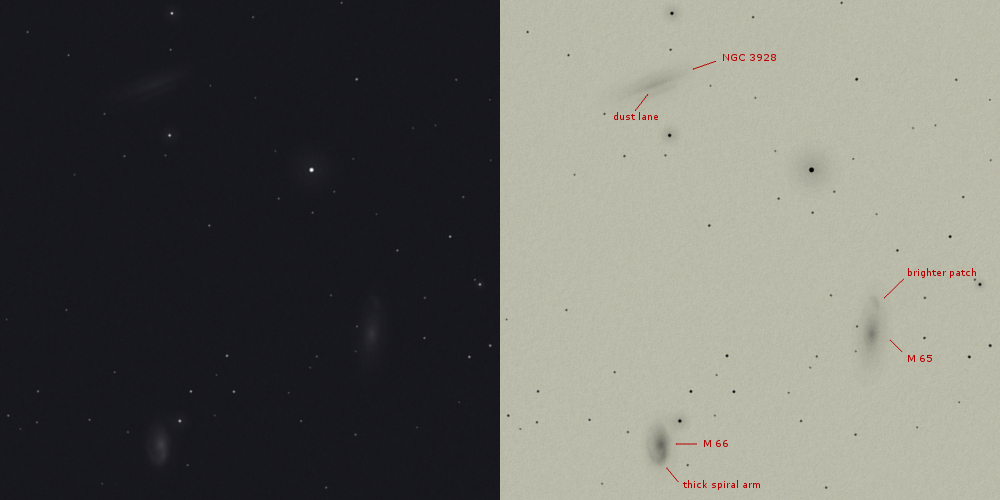
Even at low magnification (to nicely frame the three galaxies) some details can be seen like the dustlane in NGC 3628, an arm curling from S to E on M66 and a brighter patch in M65 on the N side. The difference in brightness of the three galaxies can be noticed while all of them can be seen with DV. This is a magnificent sight at low power.
Arp 318 – NGC 833/835/838/839, Hickson 16
NGC 833: mag 12.7, size 1.8′ x 0.7′
NGC 835: mag 12.1, size 1.3′ x 1.1′
NGC 838: mag 13.0, size 1.2′ x 0.9′
NGC 839: mag 13.1, size 1.6′ x 0.7′
Challenge: Tail from NGC 835 toward NGC 838 (N)
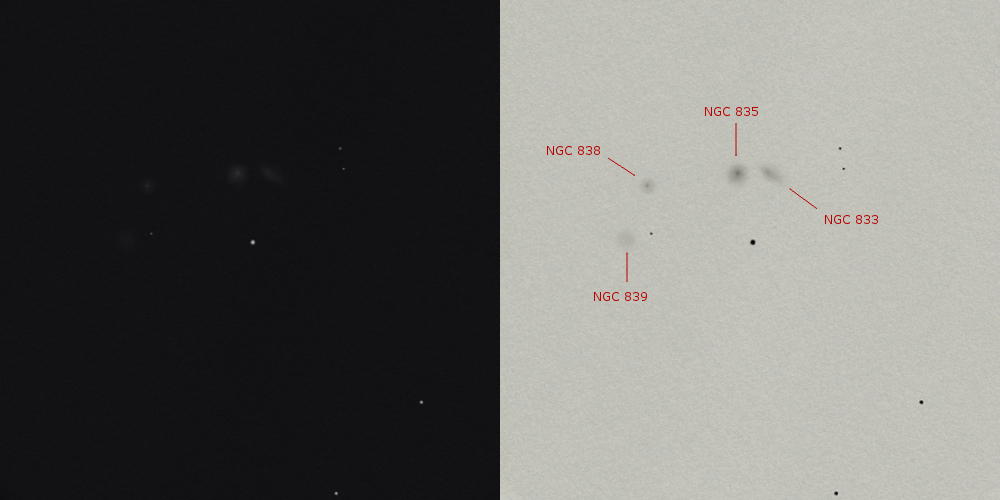
All four components are seen, but not the streamers. NGC 833 shows a bit of an ellipse and is not noticeably brighter in the center. NGC 835 is the most distinct member one of the group, it’s round with a bright core. NGC 838 is smaller en dimmer, but the stellar core is clearly visible. NGC 839 is a small and round glow without any central brightening, with AV it swells a bit more.
Arp 319 – NGC 7317-7320, Stephan’s Quintet, Hickson 92 Galaxy group
NGC 7317: mag 13.6, size 0.8′ x 0.7′
NGC 7318A: mag 14.3, size 0.8′ x 0.6′
NGC 7318B: mag 13.9, size 1.4′ x 0.9′
NGC 7320: mag 13.2, size 2.3′ x 1.1′
NGC 7319: mag 13.1, size 1.5′ x 1.1′
NGC 7320C: mag 16.7, size 0.6′ x 0.5′
Challenge: SE arm of NGC 7319, counter-rotating arms in NGC 7318A, and B, ring structure in NGC 7320C and faint tail to E of NGC 7320 (N)
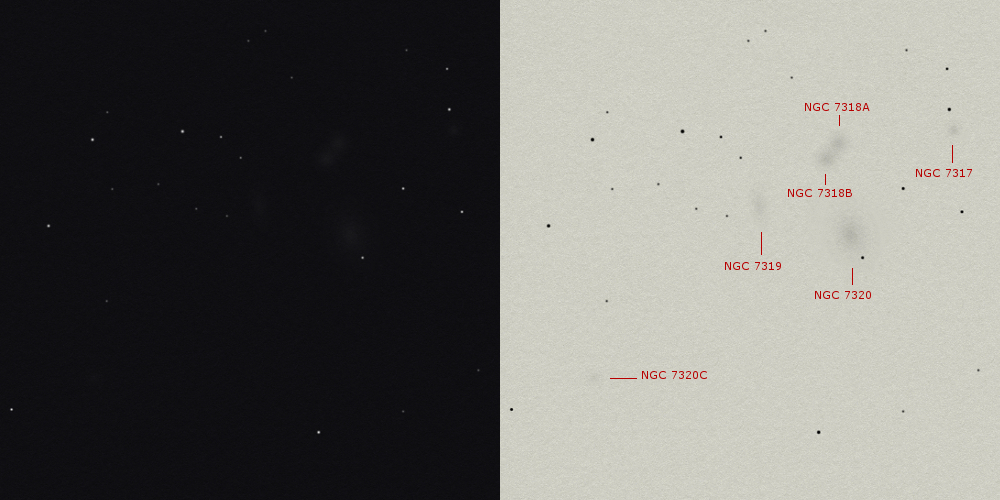
Very satisfying group of galaxies that can be seen without much effort. It does take a higher magnification though to split NGC 7318. NGC 7320 is the largest and brightest of the group, while NGC 7317 is very small and looks like a fluffy star. NGC 7319 is also dim, but the length and direction of the galaxy can be seen. NGC 7320C, which is not a member of either the Arp or the Hickson group, is very difficult to see and can only be seen blinking from time to time and then only under transparent sky conditions.
Arp 320- NGC 3753 group, Hickson 57 (Copeland’s Septet)
NGC 3745: mag 16.2, size 0.4′ x 0.2′
NGC 3746: mag 15.0, size 1.1′ x 0.5′
NGC 3748: mag 15.8, size 0.7′ x 0.4′
NGC 3750: mag 14.9, size 0.8′ x 0.7′
NGC 3751: mag 15.2, size 0.5′ x 0.2′
NGC 3753: 14.5, size 1.7′ x 0.5′
NGC 3754: mag 15.0, size 0.4′ x 0.3′
PGC 36010: mag 17.4, size 0.3′ x 0.2′
Challenge: 8 galaxies, plumes off 3753, ring around 3746 (N)
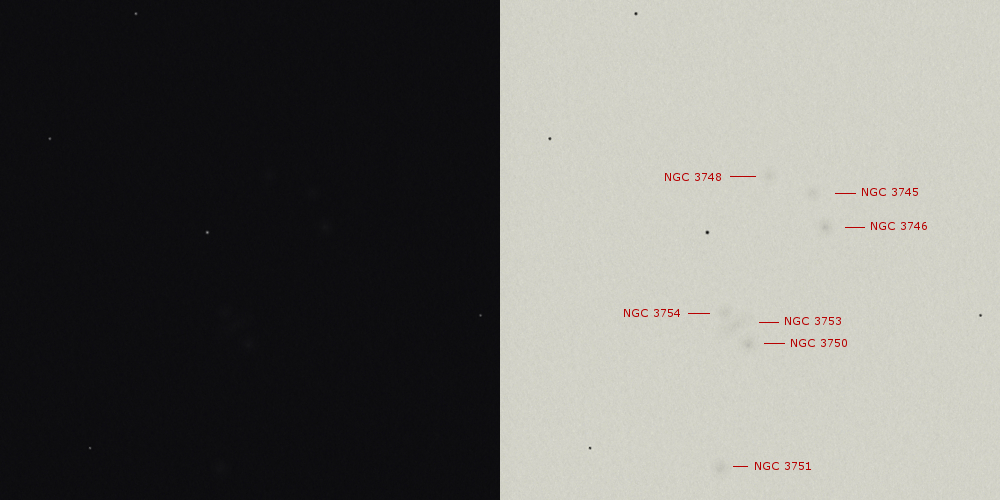
A beautiful group, but very dim and high magnification is required to see the galaxies apart from each other.
A) NGC 3753; largest and the only one seen with an oblong shape
B) NGC 3746; pretty bright and small
C) NGC 3750; pretty bright, round and small, close to 3753
D) NGC 3754; round fuzz, very close to 3753, but separation can be seen
E) NGC 3748; only with AV as a small and round fuzz
F) NGC 3751; only with AV and very dim, small and round
G) NGC 3745; dimmest, only seen with AV most of the time
H) PGC 36010 was not seen
Arp 321 – Hickson 40
A) MCG-1-25-9: mag 13.8, size 1.3′ x 1.0′
B) MCG-1-25-10: mag 15.0, size 1.1′ x 0.7′
C) MCG-1-25-8: mag 15.7, size 1.1′ x 0.3′
D) MCG-1-25-12: mag 15.0, size 0.9′ x 0.4′
E) MCG-1-25-11: mag 17.4, size 0.7′ x 0.3′
Challenge: Detect absorption lane between 40B to 40C (N)
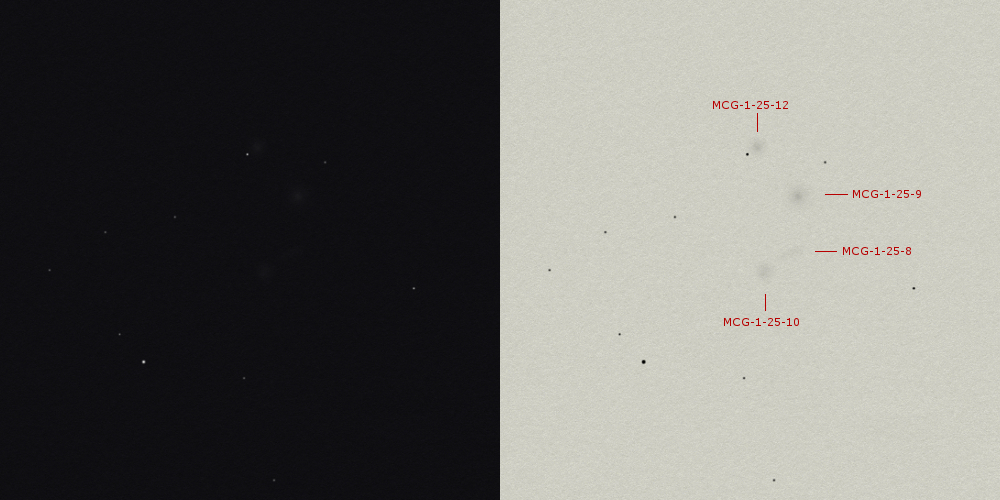
Very nice group of MCG galaxies where 4 of 5 members could be seen. MCG-1-25-9 (A) is the brightest and largest and could be seen with DV with some central brightening. MCG-1-25-10 (B) is only seen with AV as a round and smooth dot. MCG-1-25-8 (C) took some effort, but was seen as elongated with AV and MCG-1-25-12 (D) is positioned right next to a star and could just be seen with DV as small and roundish. Unfortunately, MCG-1-25-11 was out of reach.
Chains of galaxies (Arps 322 – 332)
Arp 322 – UGC 6527 chain in Hickson 56
UGC 6527 (PGC 35631): mag 14.7, size 1.1′ x 0.6′
UGC 6527A: mag 15.8, size 0.7′ x 0.4′
UGC 6527B: mag 16.8, size 0.4′ x 0.3′
PGC 35609: mag 16.5, size 0.4′ x 0.3′
Challenge: Four separate Hickson components in the Arp field; Wide spirals in Hickson 56C (N)
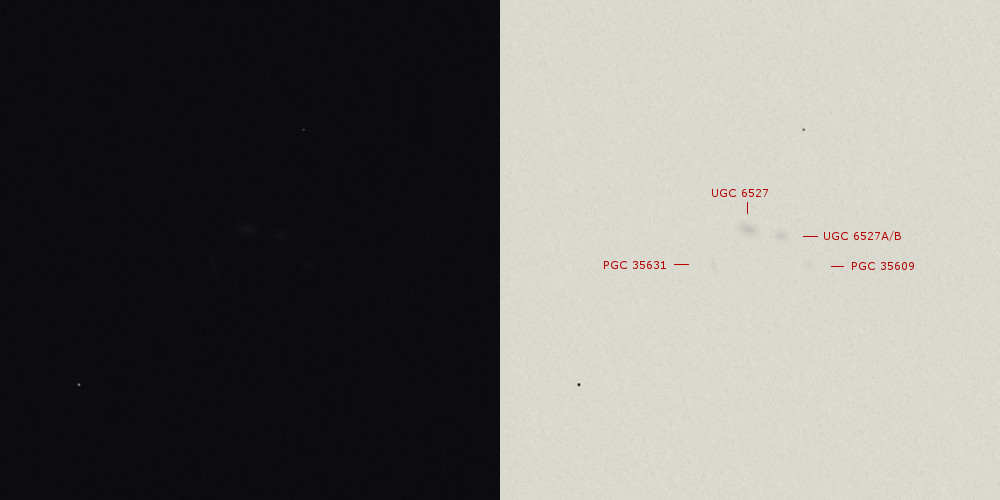
Nice, but very tough group near NGC 3718. Only one galaxy is seen with DV: UGC 6527; small and oval shaped. It points in the direction of two galaxies that are so close to each other, that I can’t separate them in the 16″, not even at this high power. These are UGC 6527A and UGC 6527B. Much tougher and just barely visible with AV are PGC 35609 en PGC 35631. They blink up so infrequently that a positive observation is doubtfull in the least. Reconfirmation with a larger scope is needed.
Arp 323 – NGC 7783 chain, Hickson 98 Galaxy chain
NGC 7783: mag 14.0; size 1.3′ x 0.7′
NGC 7783B: mag 15.0; size 0.4′ x 0.3′
NGC 7783C: mag 16.2; size 0.3′ x 0.2′
NGC 7783D: mag 16.9; size 0.3′ x 0.3′
Challenge: Distinguish all Hickson components (N)

NGC 7783 is the brightest member, seen as a clear knot at the N side of a curved, nebulous glow. At the S side NGC 7783B is seen as a somewhat dimmer and smaller knot. Betweetn these two galaxies a dim m14.9 is visible. Further S and fully separated from the above mentioned nebulosity a very dim star and NGC 7783C are seen loose from each other. The galaxy is very hard to discern with averted vision. A bright m10 star nearby disturbs a bit and (partially) prevents the final member NGC 7783D from being seen, but perhaps it’s just too dim.
Arp 324 – UGC 10143 chain
VV 159a: mag 14.2, size 1.7′ x 1.0′
VV 159b: mag 15.6, size 0.8′ x 0.7′
VV 159c: mag 15.2, size 0.8′ x 0.5′
VV 159d: mag 16, pair of sphericals separated by 6″
VV 159f: mag 15.5, size 0.5′ x 0.1′
Challenge: Faint bridging between the three large galaxies, and separation of the two galaxies in 159d (N)
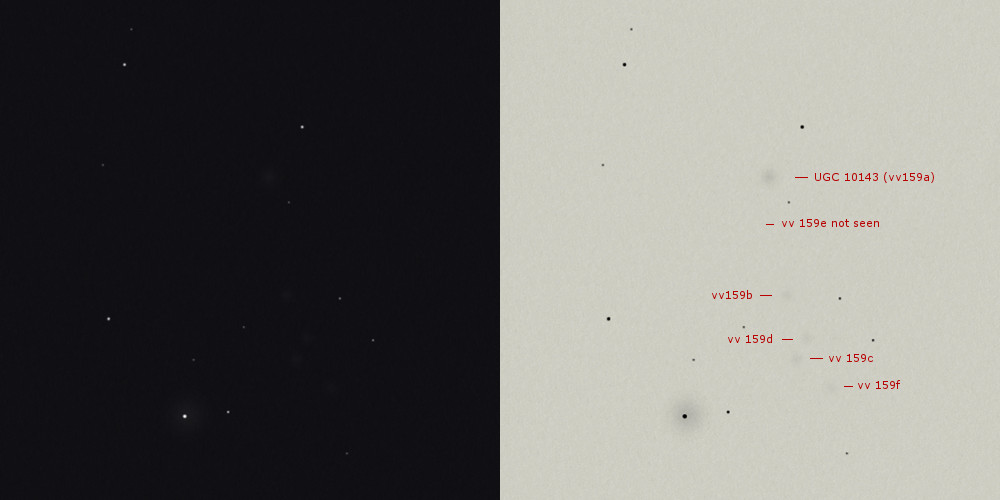
Very dim group of six galaxies, of which five were seen (three difficult and one very difficult). VV 159a is UGC 10143 and is the brightest and largest one, seen with AV, round. A bit south are four galaxies that require a bit more effort, especially VV 159f which is only intermittendly observed. VV 159d resides against a m14.5 star, the combined light can be seen, but not separated. VV 159e was missed completely. This Arp group is part of the larger Abell Galaxy Cluster 2147.
Arp 325 – MCG-4-52-14 galaxy chain
mag 14.5, components between 16 and 19
Challenge: Overlapping halos, or bridges, between adjacent galaxies (N)
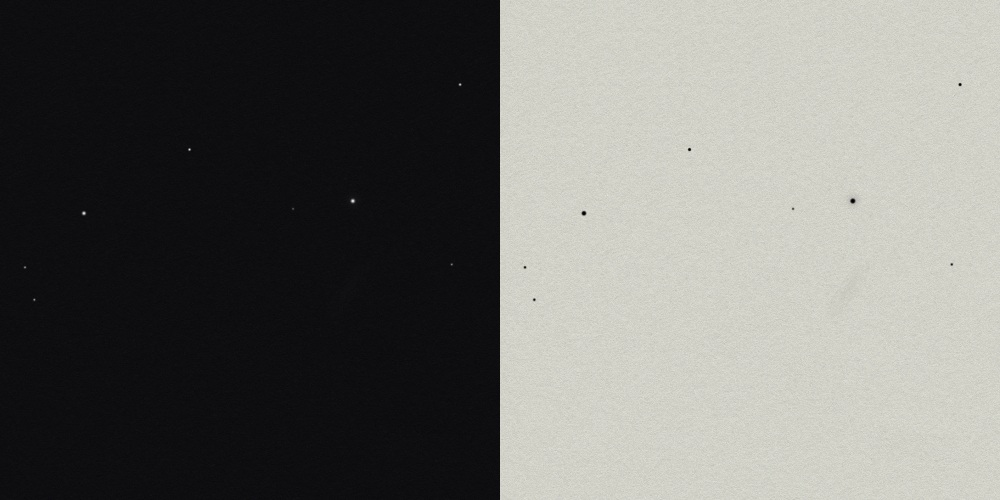
Very dim. Missed on the first try, so during the second try a detailed map was used. It was needed to see the extremely dim streak of light with AV, but could not be held continuously. Not a single component was seen, but it needs to be mentioned that the transparancy was not very good.
Arp 326 – UGC 8610 and UGC 8613 galaxy chain
UGC 8610: mag 15.4, size 1.2′ x 0.4′
UGC 8613: mag 15.3, size 1.4′ x 0.6′
MCG+1-35-19: mag 15.3, size 0.6′ x 0.4′
LEDA 214126: mag 17.1, size 0.5′ x 0.2′
MAPS-NGP O_559_0677185: mag 17.4, size 0.4′ x 0.3′
MAPS-NGP O_559_0792305: mag 18.0, size 0.2′
MAPS-NGP O_559_0677872: mag 18.0, size 0.2′
Challenge: Seven named galaxies and the ring around MCG+1-35-19 (P)
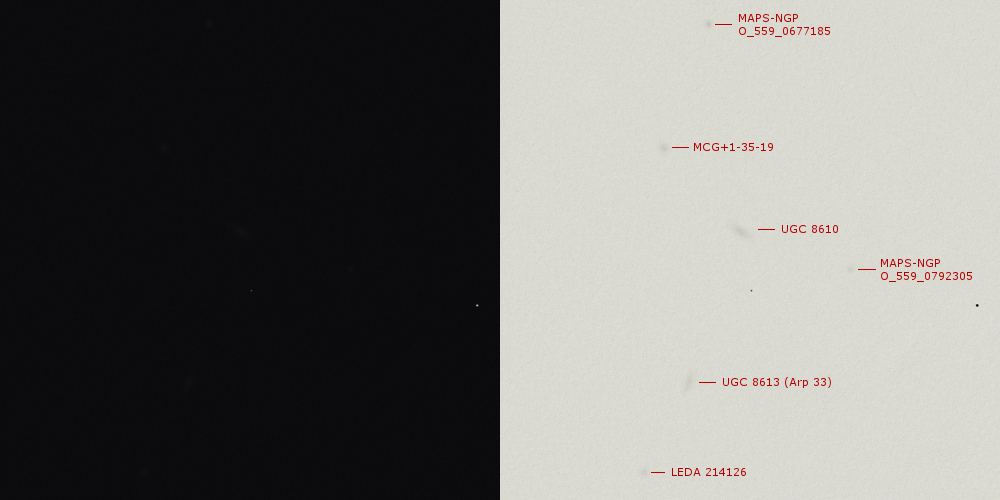
Arp 326 consists of 7 galaxies, of which I could see 6. The two dimmest in this chain are mag 18, but I was able to locate them despite of that (with a lot of effort). the brightest member of the chain has its own designation: Arp 33, but the integral sign shape of UGC 8613 was invisible, it was only seen elongated. UGC 8610 was seen elongated too.
Arp 328 – Hickson 72
72A) MCG+3-38-17: mag 16.1, size 0.5′ x 0.1′
72B) MCG+3-38-21: mag 16.1, size 0.5′ x 0.2′
72C) MCG+3-38-22: mag 16.1, size 0.6′ x 0.2′
72D) MCG+3-38-20: mag 16.0, size 0.2′
Challenge: All seven members, structure in 72B and 72E (N)

Group of four galaxies in a line, seen individually. All galaxies have the same brightness, although the two in the center are smaller and nearly touching. With AV they can be seen separate in a shared folder of nebulosity. Only four of the seven galaxies in total can be seen, but it takes effort.
Arp 329 – UGC 6514, Hickson 55
PGC 35575: mag 15.9, size 0.4′
PGC 35572: mag 16.4, size 0.3′ x 0.2′
PGC 35573: mag 17.0, size 0.6′ x 0.4′
PGC 35574: mag 17.2, size 0.3′ x 0.2′
PGC 35576: mag 18.5, size 0.2′
Challenge: Separate the five galaxies (P)
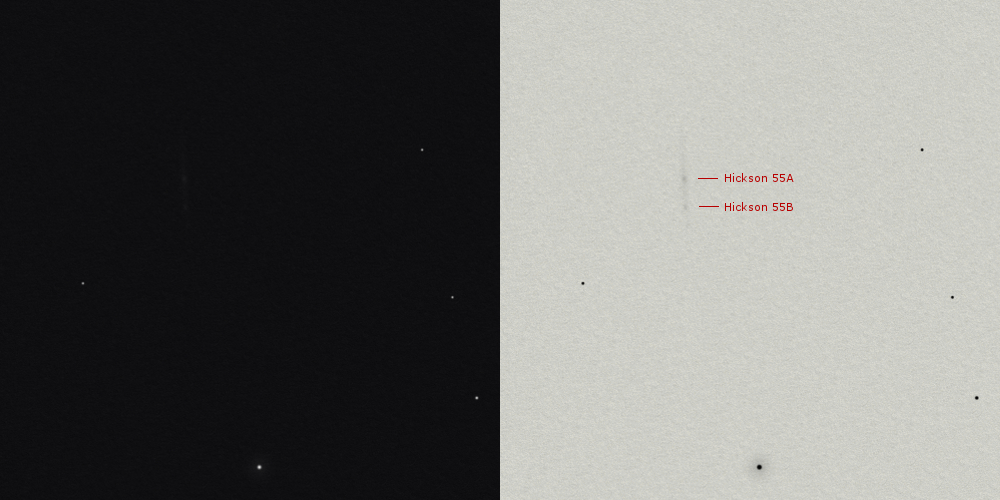
Very challenging observation. First impression is a long, but small and dim line. The first galaxy that can be seen individually is the one in the center and after a while a second one at the southern tip is suspected.
Arp 330 – MCG+9-27-91 through -96
MCG+9-27-91: mag 14.8, size 0.3′ x 0.2′
MCG+9-27-92: mag 16, size 0.3′
MCG+9-27-93: mag 19, size 0.1′
MCG+9-27-94: mag 15.6, size 0.3′
MCG+9-27-95: mag 17, size 0.3′ x 0.2′
MCG+9-27-96: mag 17, size 0.2′
Challenge: Detect 10 galaxies and structure in -92 (N)

Chain of dim to very dim galaxies. Four of five possible galaxies are seen, of which one very difficult. MCG +09-27-094 is the most obvious and almost seen with DV. After that, MCG +09-27-091 mostly stands out. In between these two, MCG +09-27-092 is located and this one is hard to see with AV. MCG +09-27-096 only blinks up now and then, but could still be confirmed. It’s supposedly a m17 galaxy, but I think m16 would be more appropriate. MCG +09-27-095 (also m17) was just out of reach and MCG +09-27-093 is a complete no-go at m19. Nice chain.
Arp 331 – NGC 379 – 388, Pisces Cloud Galaxy chain
NGC 373: mag 16.6, size 0.4′
NGC 375: mag 15.7 size 1.4′
NGC 379: mag 13.9, size 1.4′ x 0.8′
NGC 380: mag 13.6, size 1.4′ x 1.2′
NGC 382: mag 14.2, size 0.7′
NGC 383: mag 13.4, size 1.6′ x 1.4′
NGC 384: mag 14.0, size 1.1′ x 0.9′
NGC 385: mag 13.9, size 1.1′ x 1.0′
NGC 386: mag 15.4, size 0.9′ x 0.8′
NGC 387: mag 17.2, size 0.4′
NGC 388: mag 15.4, size 0.9′ x 0.8′
UGC 679: mag 16.6, size 1.0′ x 0.3′
Challenge: All twelve galaxies in Arp’s field (P)
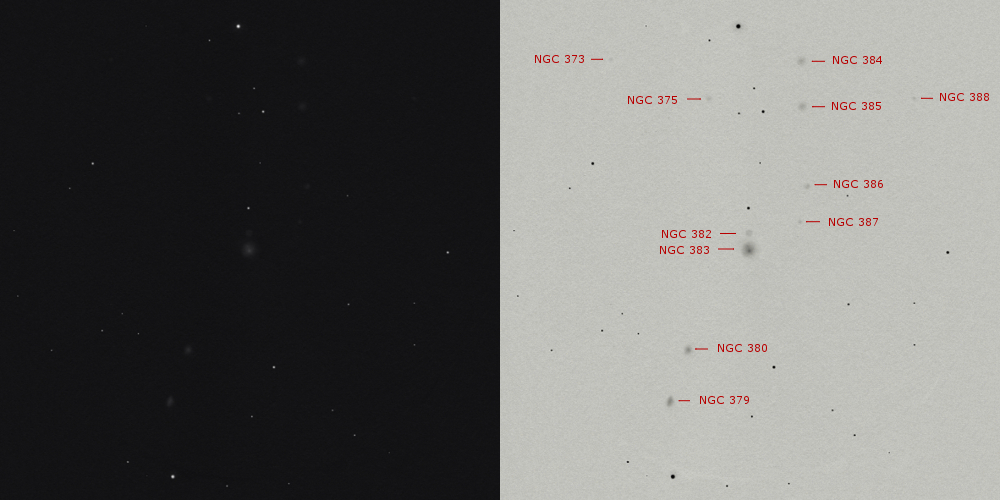
In total, 11 galaxies were seen in a field of 23 arc minutes. Most prominent is NGC 383 in the center of the chain. It’s the brightest and largest member of the group. Very close to it is NGC 382, somewhat dimmer and smaller. NGC 380 and NGC 379 to the N are about the same in size and brightness. NGC 379 is the only member in the group that does not appear round, but is shaped like an ellips (2:1). On the S side, NGC 384 and NGC 385 mark the end of the chain. These galaxies are dimmer than the ones in the center and to the N. With some effort NGC 386 and NGC 375 are visible too as small and dim specks in the field. Finally, with a lot of effort and AV, NGC 373; NGC 387 and NGC 388 can be glimpsed as well as tiny specks of nebulosity. UGC 679 remains hidden.
Arp 332 – IC 1892 Galaxy chain
NGC 1228: mag 13.2, size 1.5′ x 0.9′
NGC 1229: mag 14.8, size 1.4’x 0.9′
NGC 1230: mag 15.4, size 0.6′ x 0.4′
MCG-4-8-29: mag 16.0, size 0.4′ x 0.2′
IC 1892: mag 13.8, size 1.9′
Challenge: All 10 named galaxies; asymmetrical structure in NGC 1229, two VV components of IC 1892 (N)
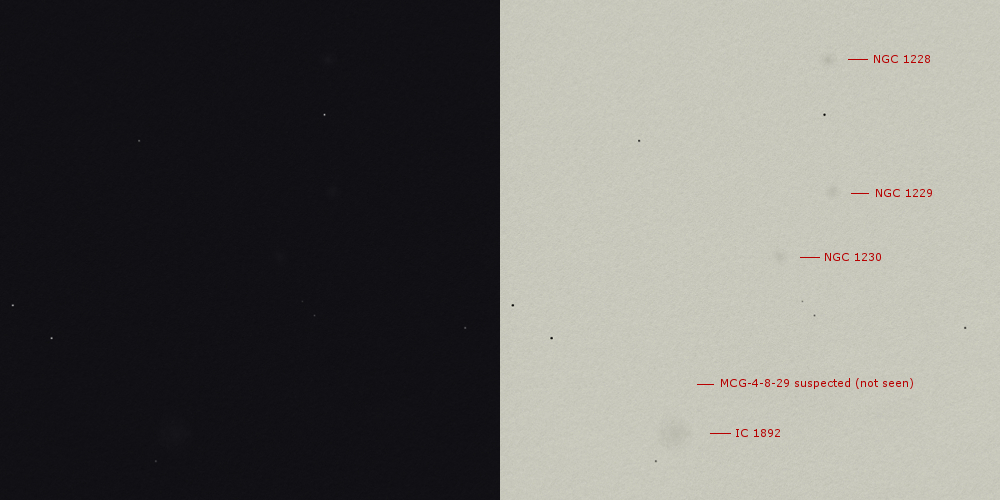
In this chain, four galaxies are (easily) visible with AV. NGC 1228 is the brightest member and it shows some centrel brightening. NGC 1229 is only a bit dimmer and small. NGC 1230 is yet again dimmer and also very small, but still can be seen very well with AV. IC 1892 is a large cloud and appears a bit mottled. The arm is not seen (probably because of the mediocre transparancy). The companion is suspected, but can’t be confirmed with certainty.
Miscellaneous (Arps 333 – 338)
Arp 333 – NGC 1024
mag 12.1; size 3.9′ x 1.4′
Challenge: Thin circular arms, star in SE superposed on whisp (N)
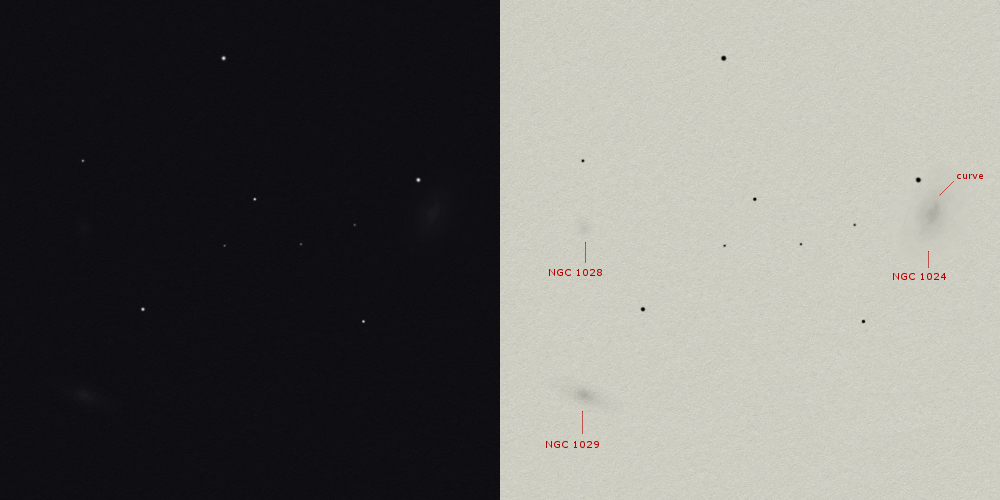
NGC 1024 is clearly seen as an oval shaped glow with some central brightening and slightly bent shape at the tips, which gives away the spiral structure. In a nice starfield there are two more galaxies: NGC 1029 is edge-on with a round core; NGC 1028 can only be seen with AV and with effort as a small, round dot. The superposed star was seen, but not the whisp.
Arp 334 – UGC 8498
mag 13.6, size 2.8′ x 1.0′
Challenge: Faint loop at N end; even fainter loop outside main loop at S end (N)
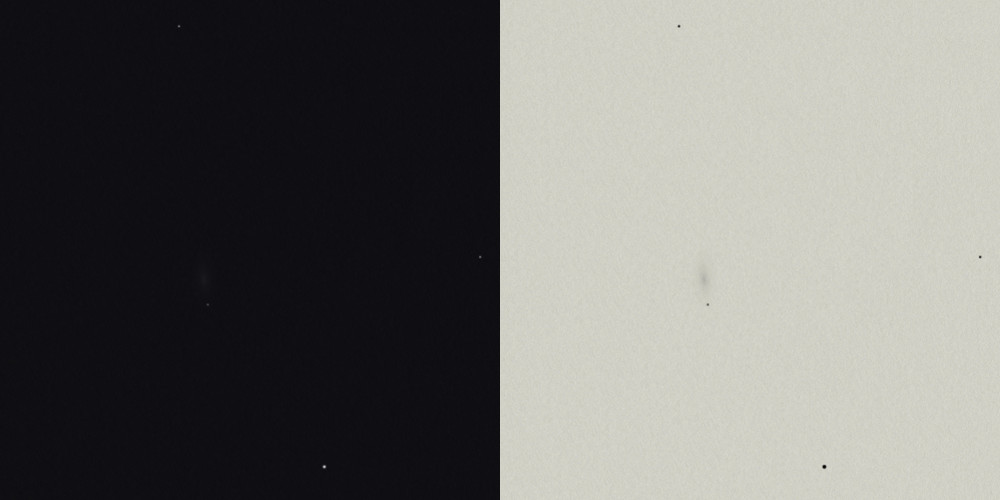
Pretty bright and with an elongated shape and brighter core zone, seen with DV. With AV, a dim star is seen at the S tip. No further details.
Arp 335 – NGC 3509
NGC 3509: mag 13.5, size 2.1′ x 1.0′
KPG 265A: mag 14.0, size 0.9′ x 0.3′
KPG 265B: size 1.3′ x 0.2′
Challenge: Full extent of large arm and nuclear structure (N)
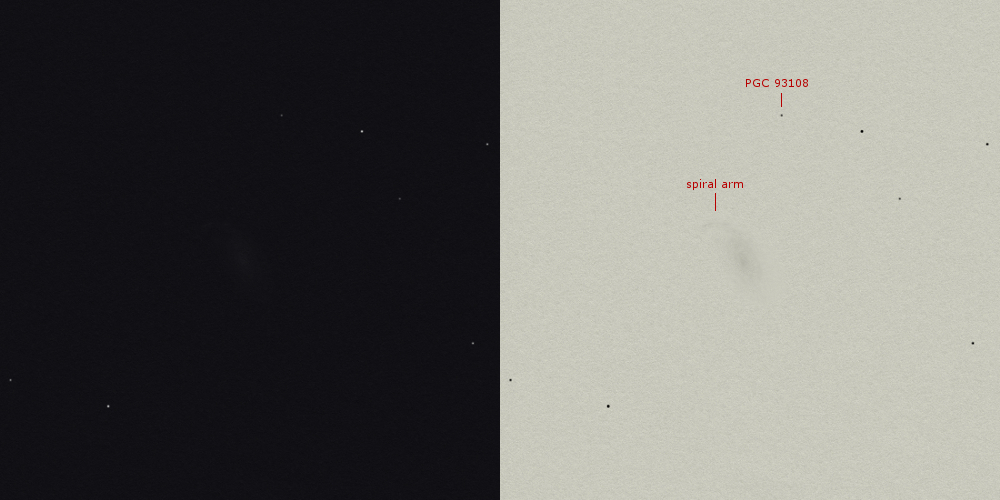
Oval shape with some central brightening, seen with DV. The (start of the) spiral arm is observed, but the appearance is very flimsy and less easy than was hoped/expected. Nearby m15.3 galaxy PGC 93108 was noted as a AV star.
Arp 336 – NGC 2685, The Helix Galaxy
mag 11.2, size 4.5′ x 2.4′
Challenge: Circumferential rings encircling cigar-shaped core (N)
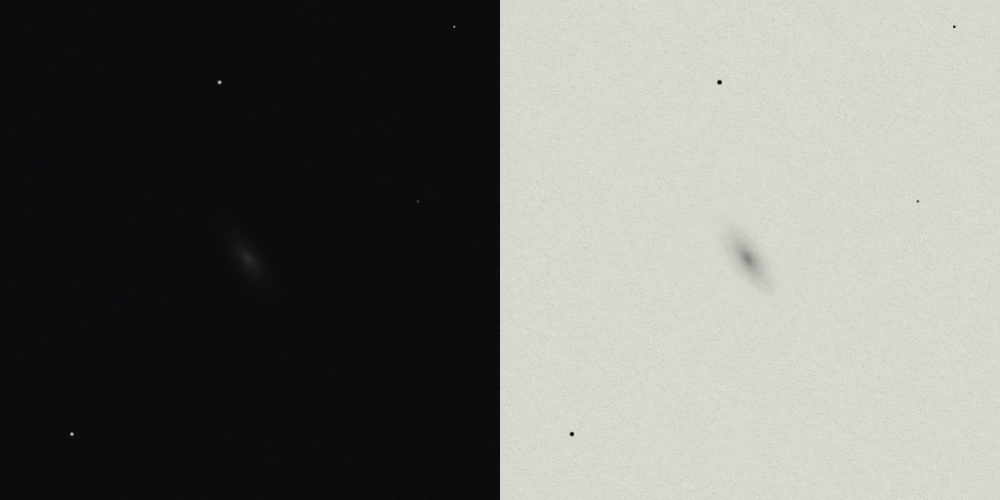
Very bright, cigar-shaped, but small galaxy with a bright core that is slightly stretched. The rings are not visible.
Arp 337 – M82 (NGC 3034)
mag 8.4, size 11.4′ x 4.3′
Challenge: The filaments projecting from the center (N)
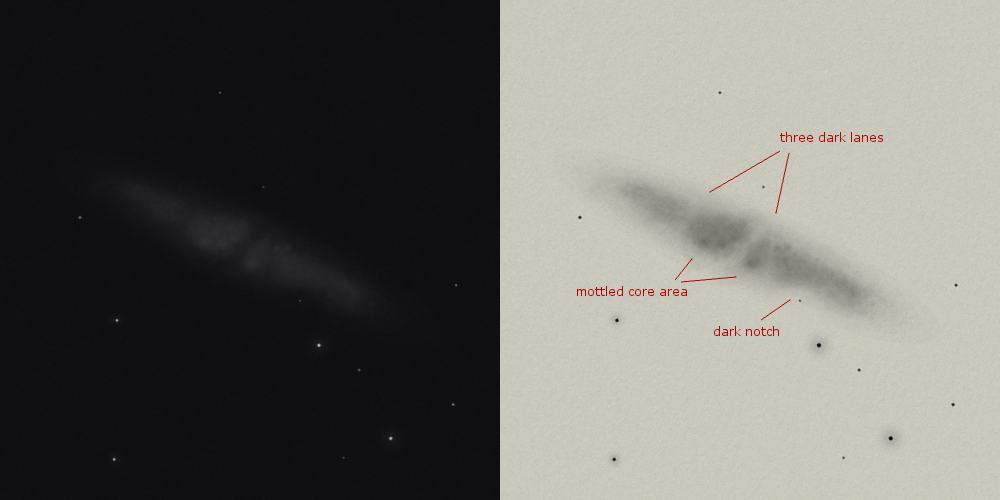
The “Cigar Galaxy“. Very bright and very large with many immediately visible details. Three dark lanes, of which one is very apparent, are seen perpendicular to the plane. Additionally, there is a dark “notch” just behind a mag 15 star. The core is split by the the thickest dark lane and has a very mottled appearance. Stunning!
Arp 338 – PGC 154807 and companion
PGC 154807: mag 15.8, size 0.6′, and multiple galaxy
PGC 1010862: mag 17.3, size 0.3′
PGC 3094767 (Bar in PGC 154807): mag 0.3′ x 0.1′
Challenge: Bar S of NE galaxy, asymmetry in SW galaxy (N)
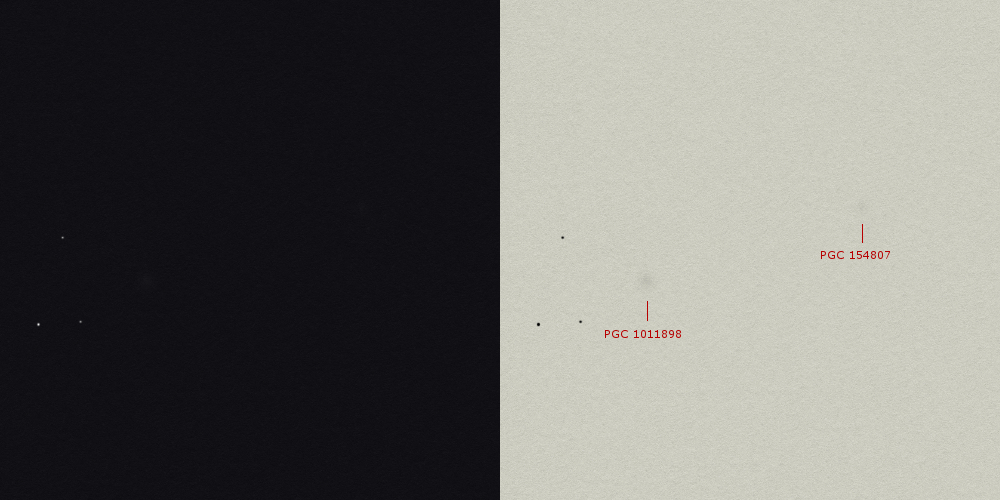
Extremely difficult Arp, only seen about 10% of the time. Bar and companion not seen or suspected. Neigbouring galaxy PGC 1011898 is easier and could be seen with AV, but also this one is very dim. A detailed star chart was needed to locate this Arp, so that the exact position is known. This final object in the Arp catalogue is perhaps the most difficult one of all!
